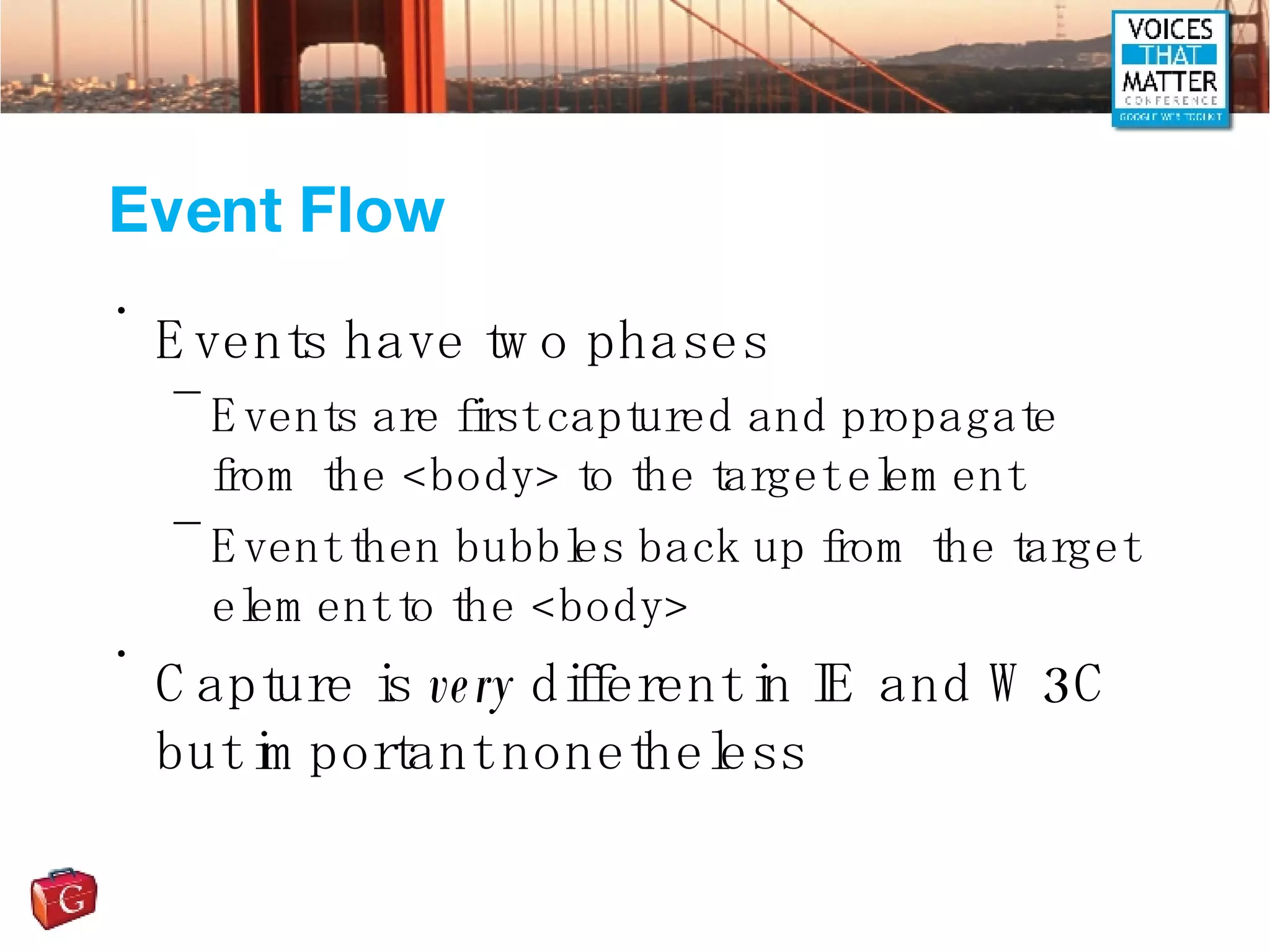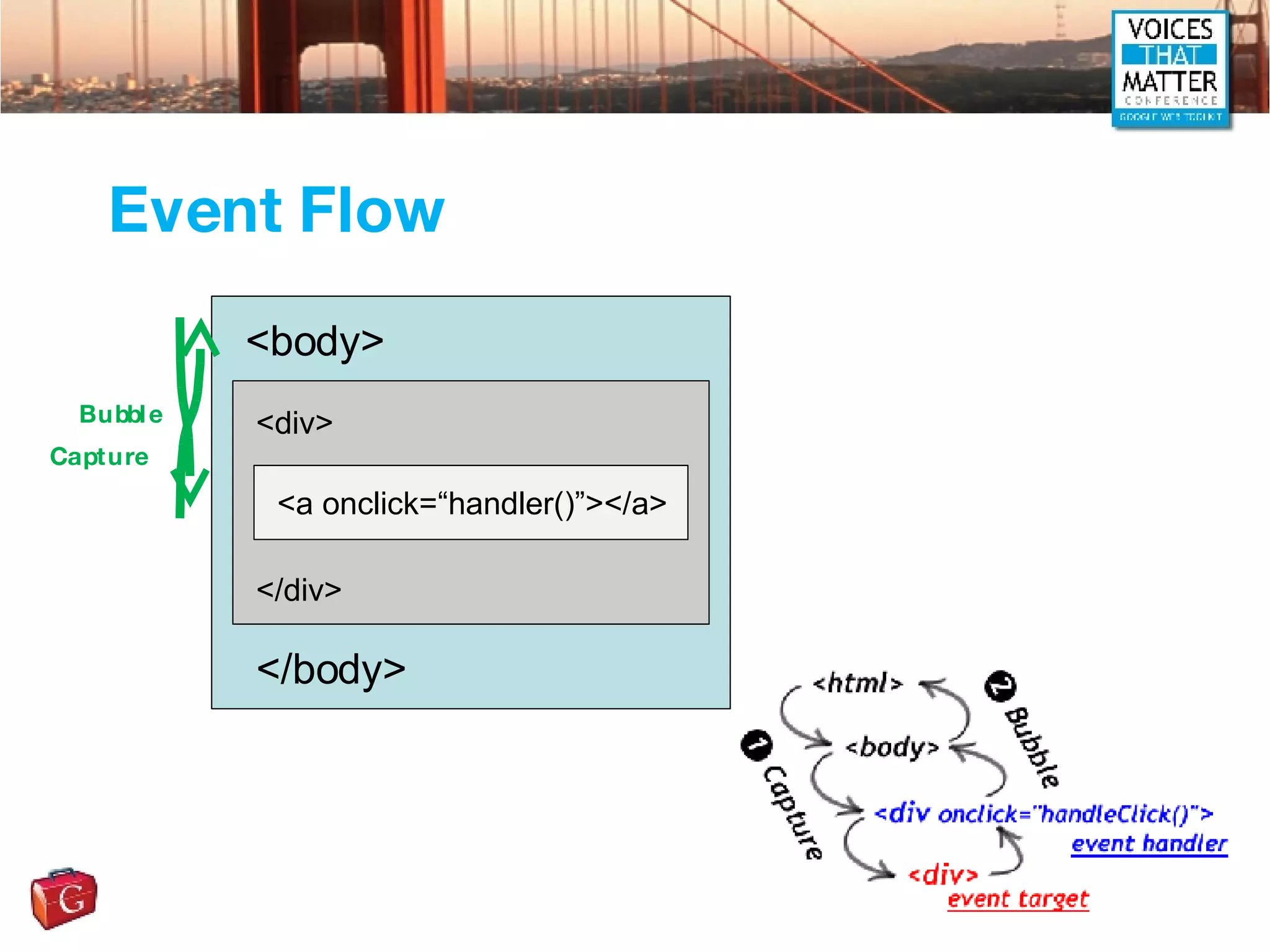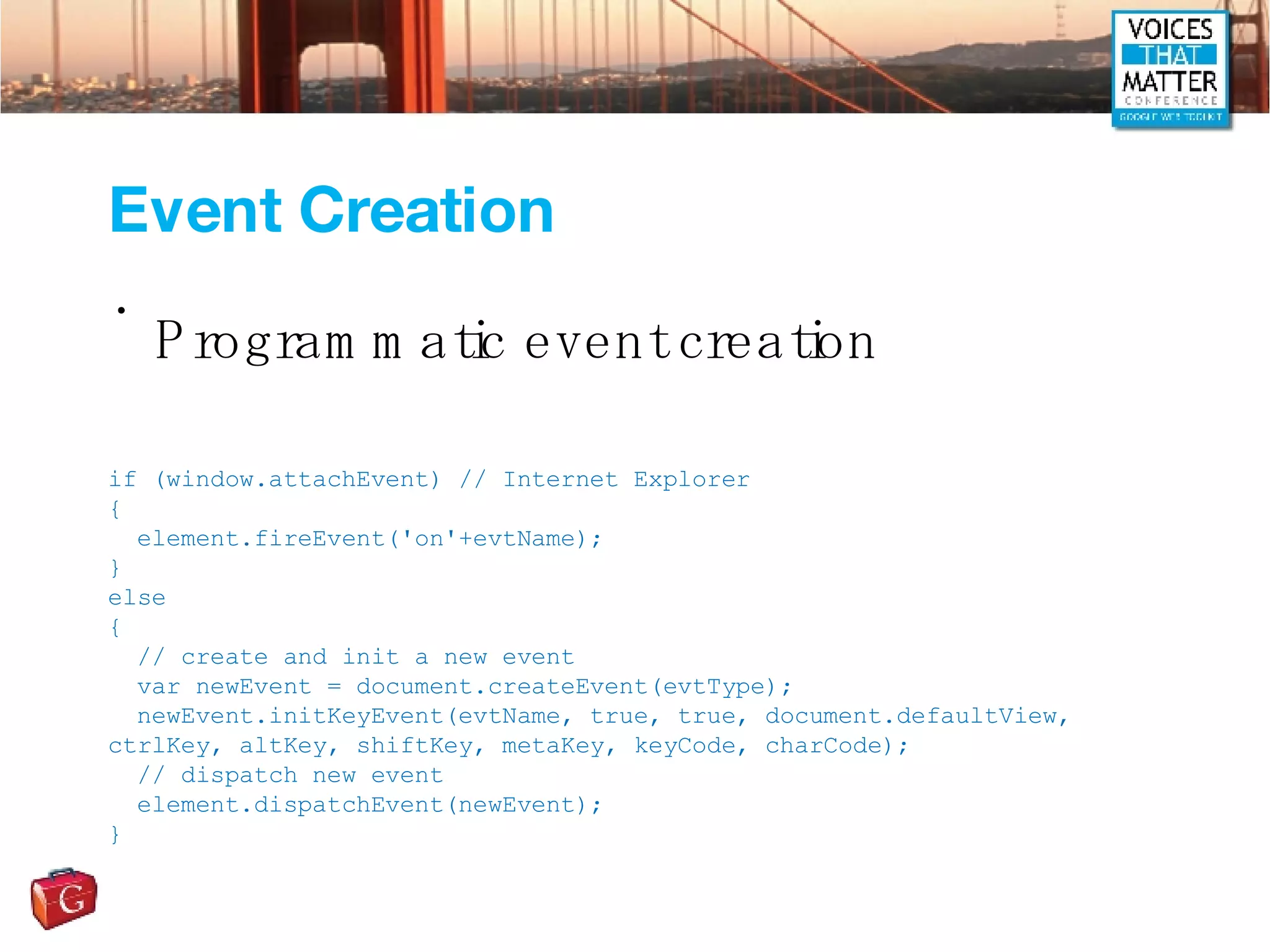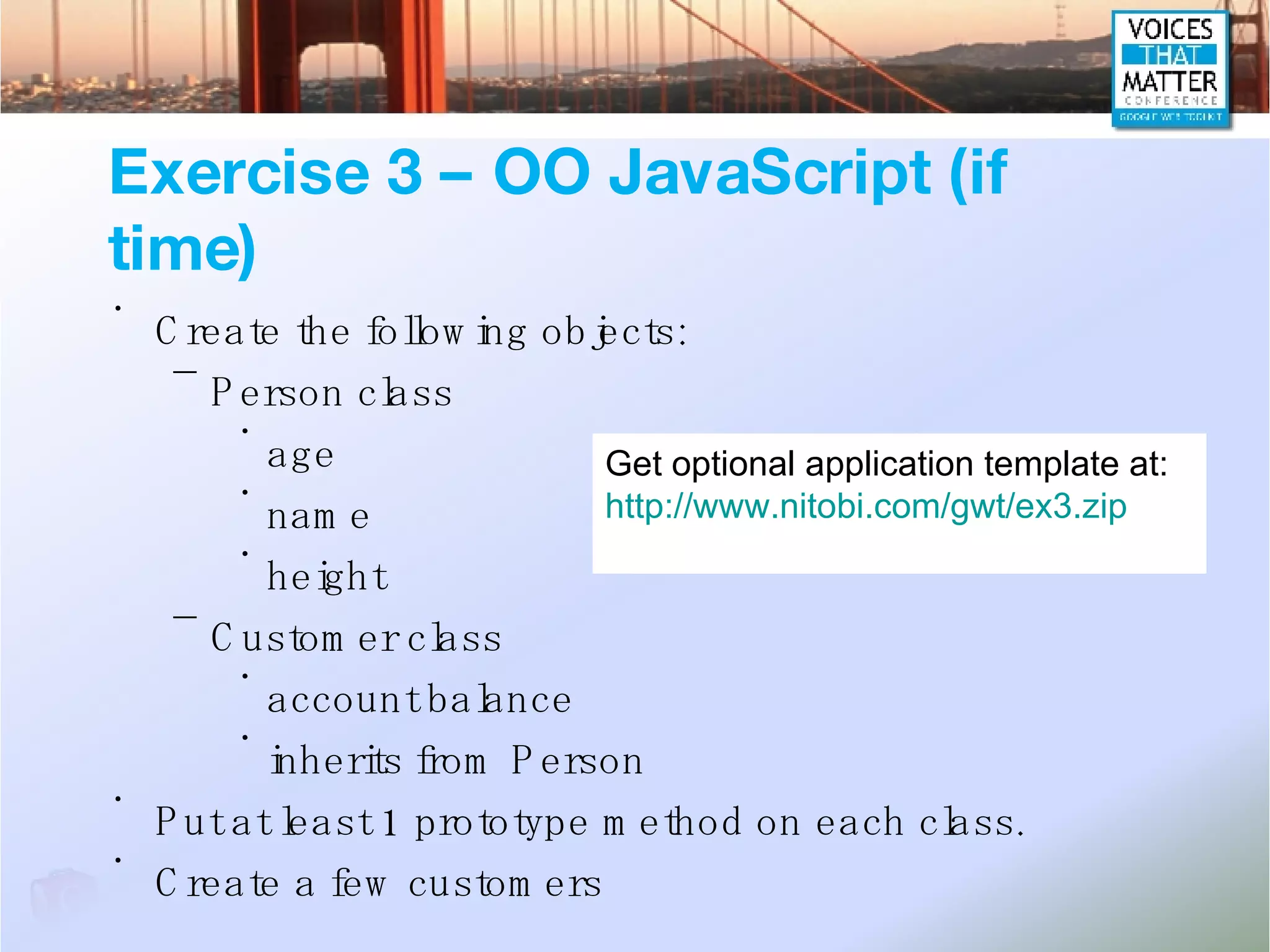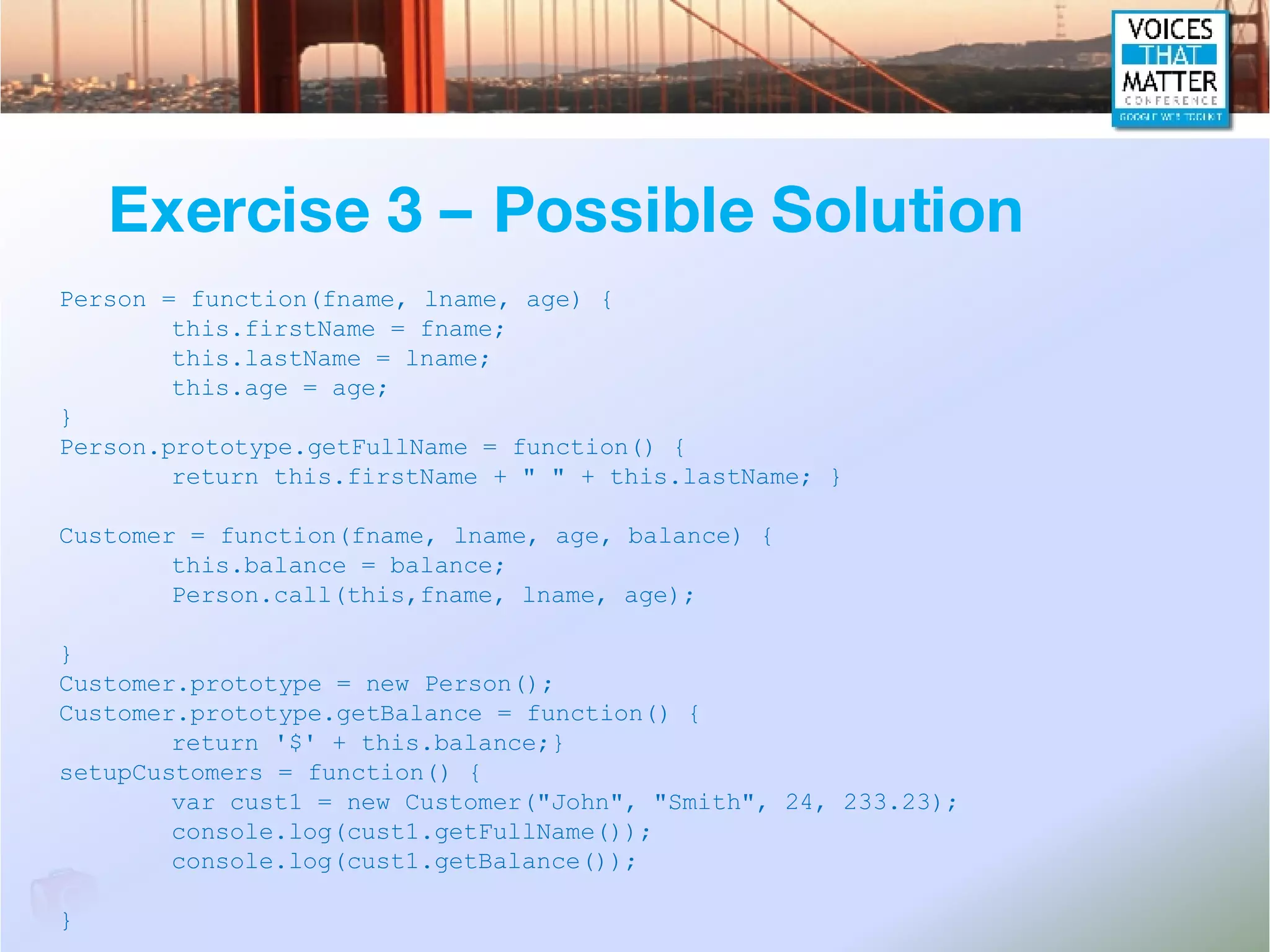This document provides a comprehensive overview of a JavaScript bootcamp led by Alexei White, covering various aspects of JavaScript, including its syntax, data types, object-oriented programming, and event handling. It also discusses practical coding exercises, debugging techniques, and the importance of understanding the client-server model in web development. Key topics include the basics of JavaScript, advanced features, AJAX, and tools for coding and debugging.
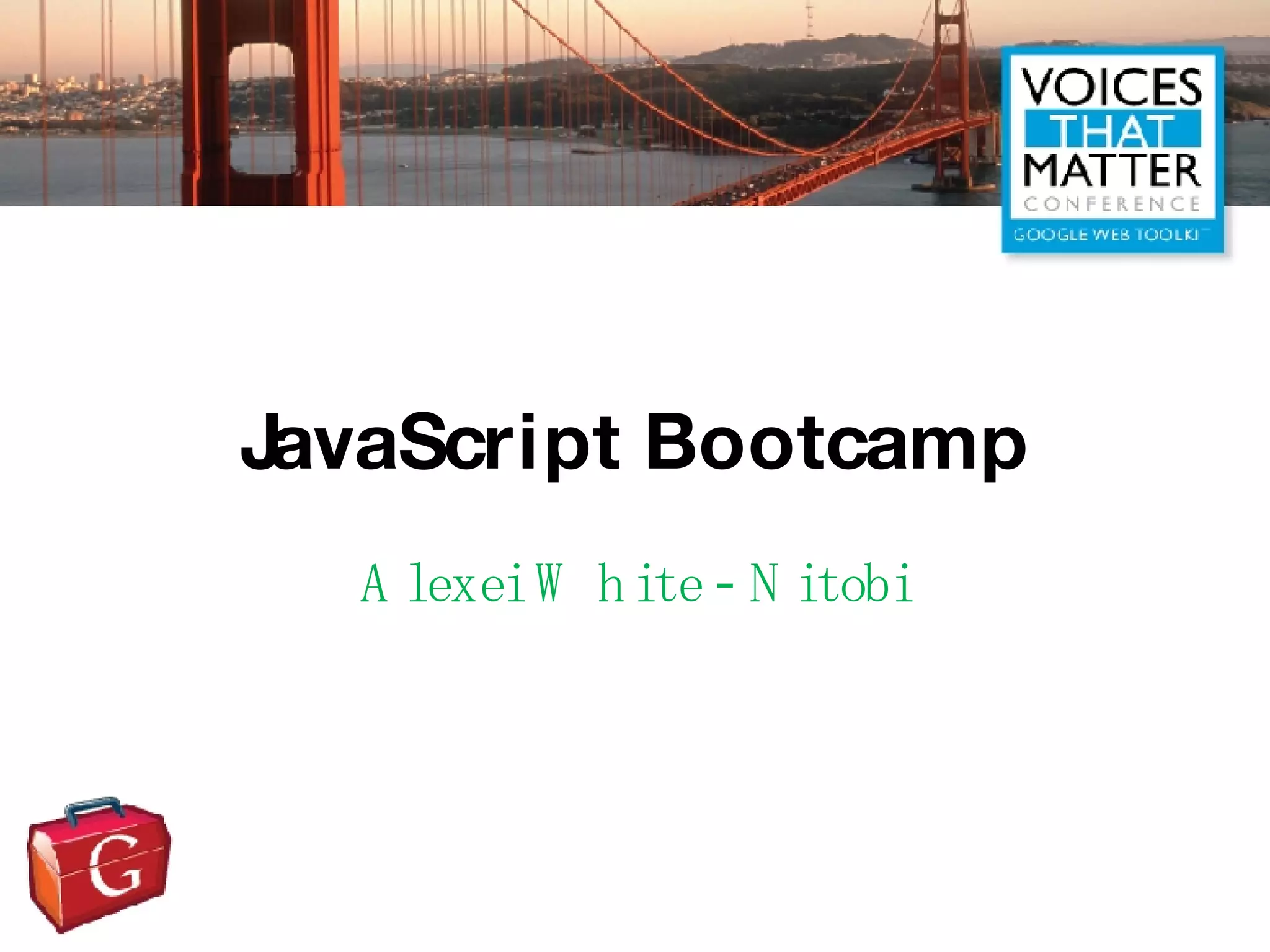


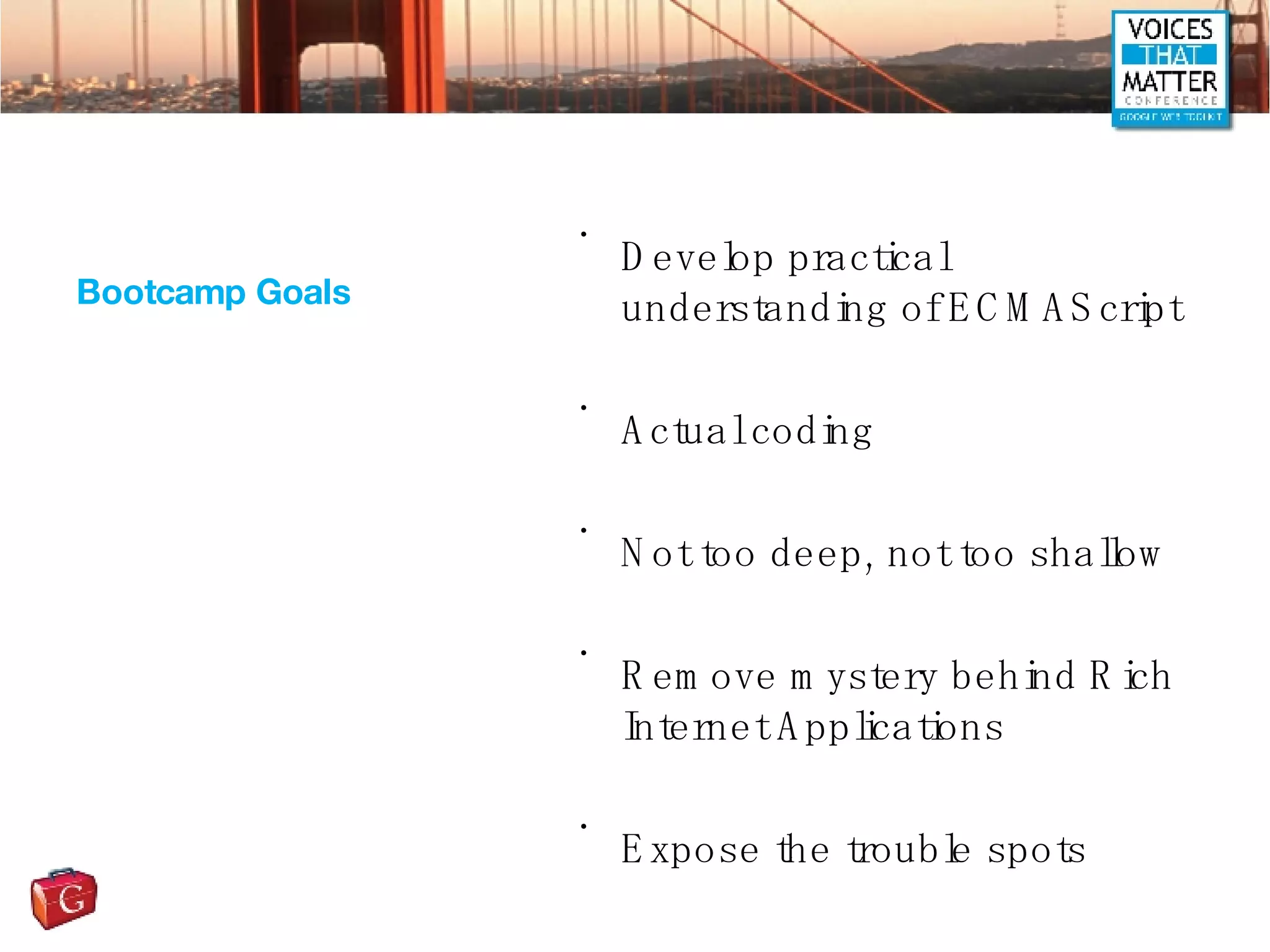
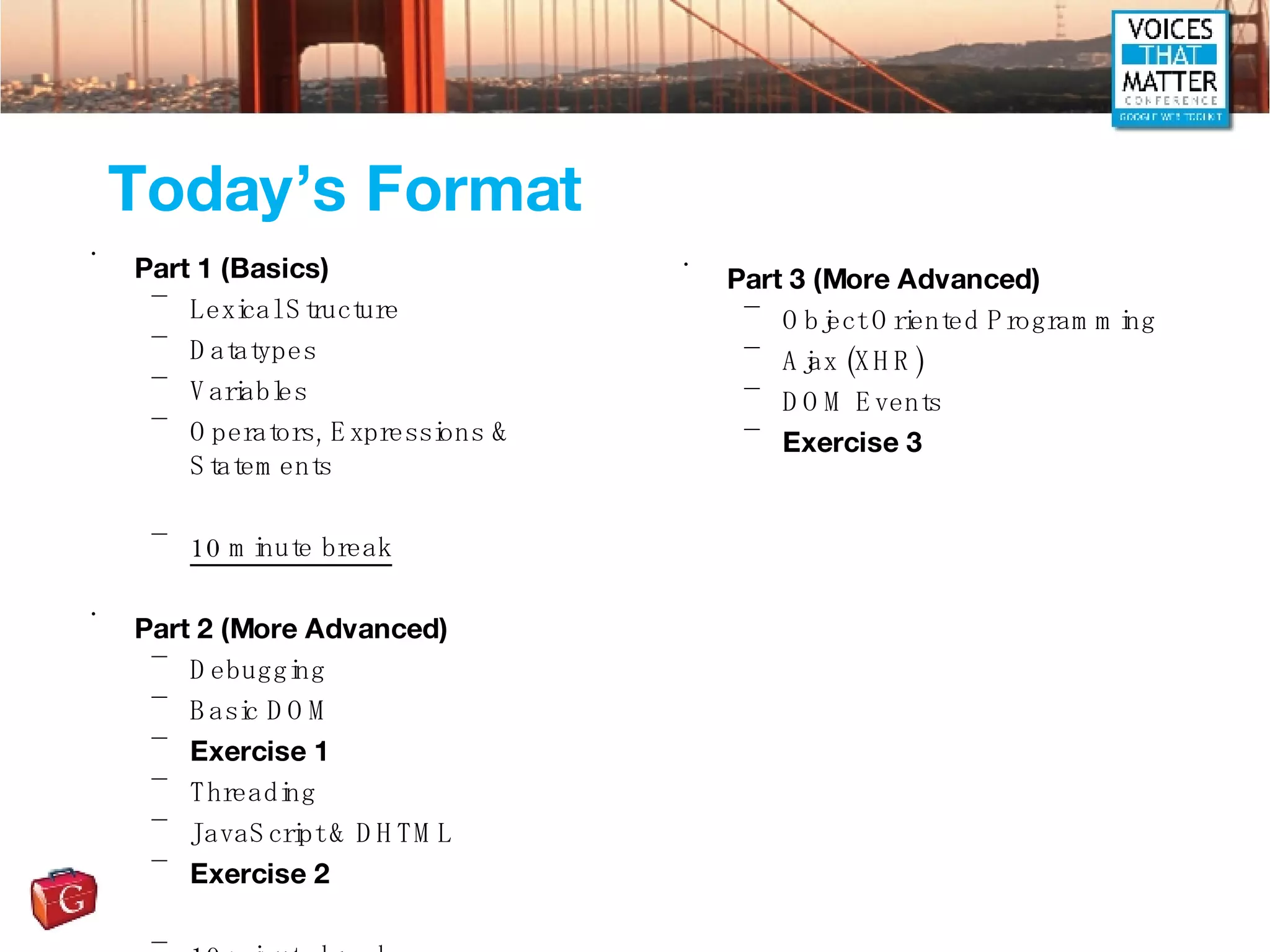
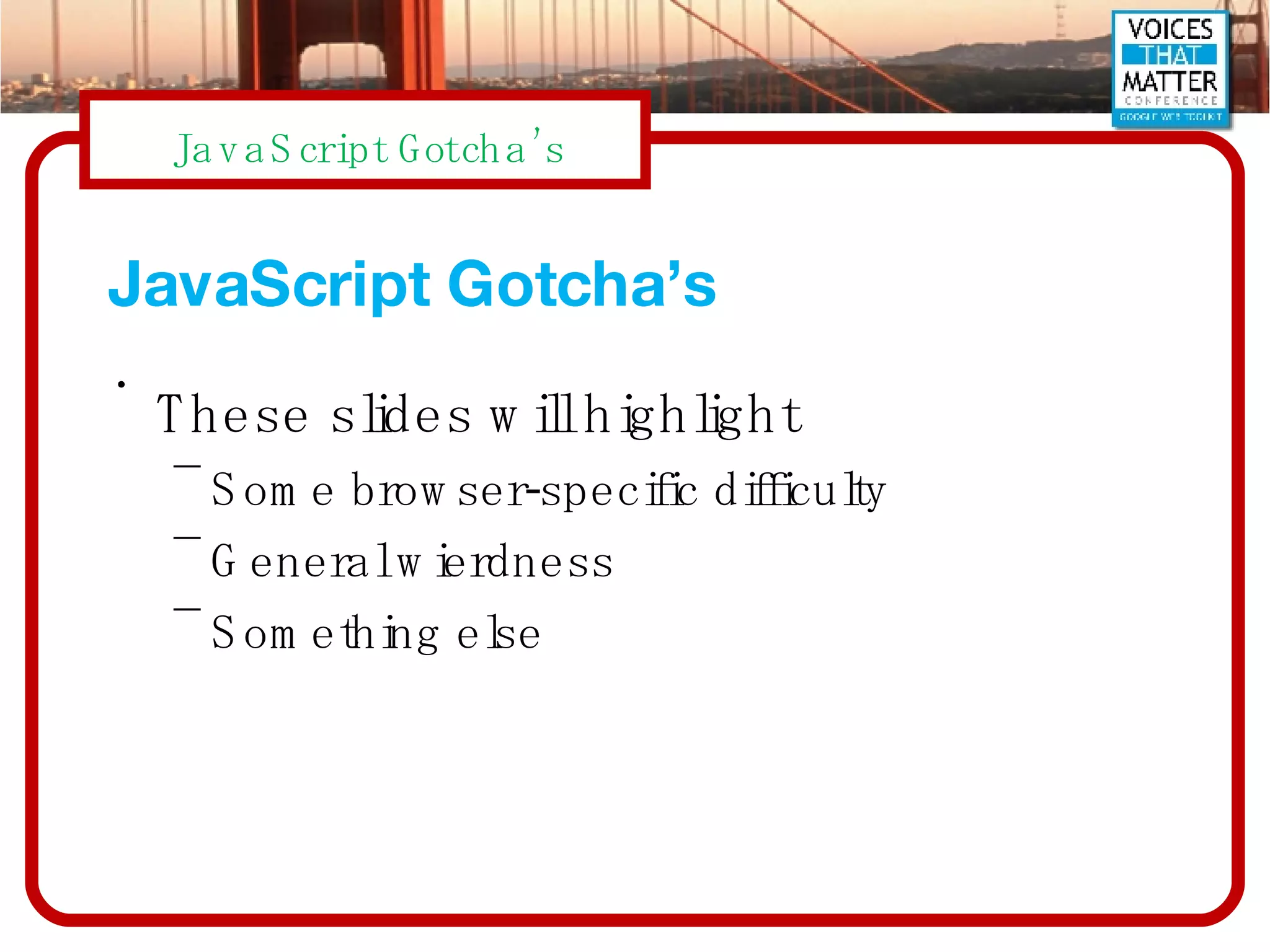
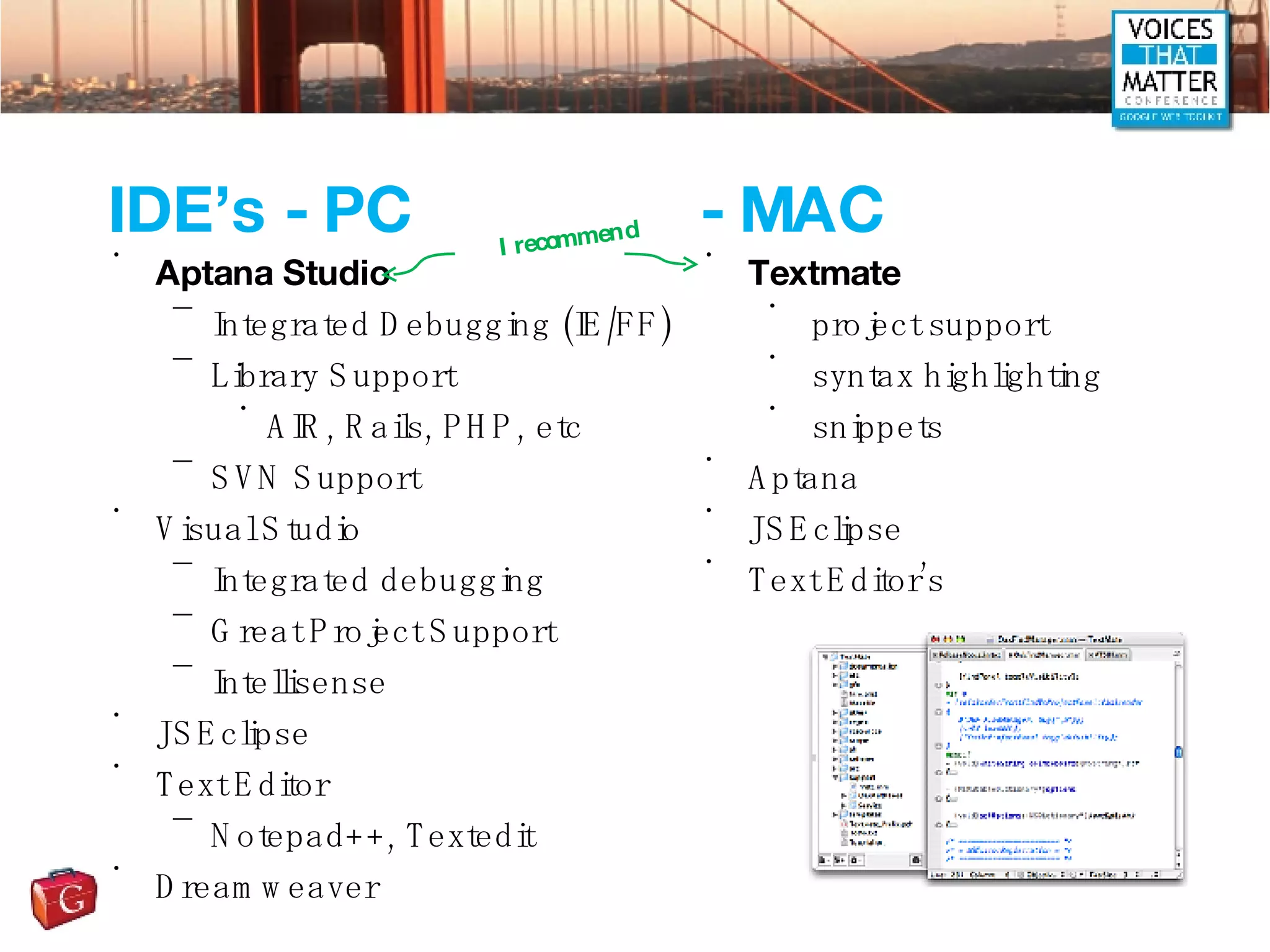

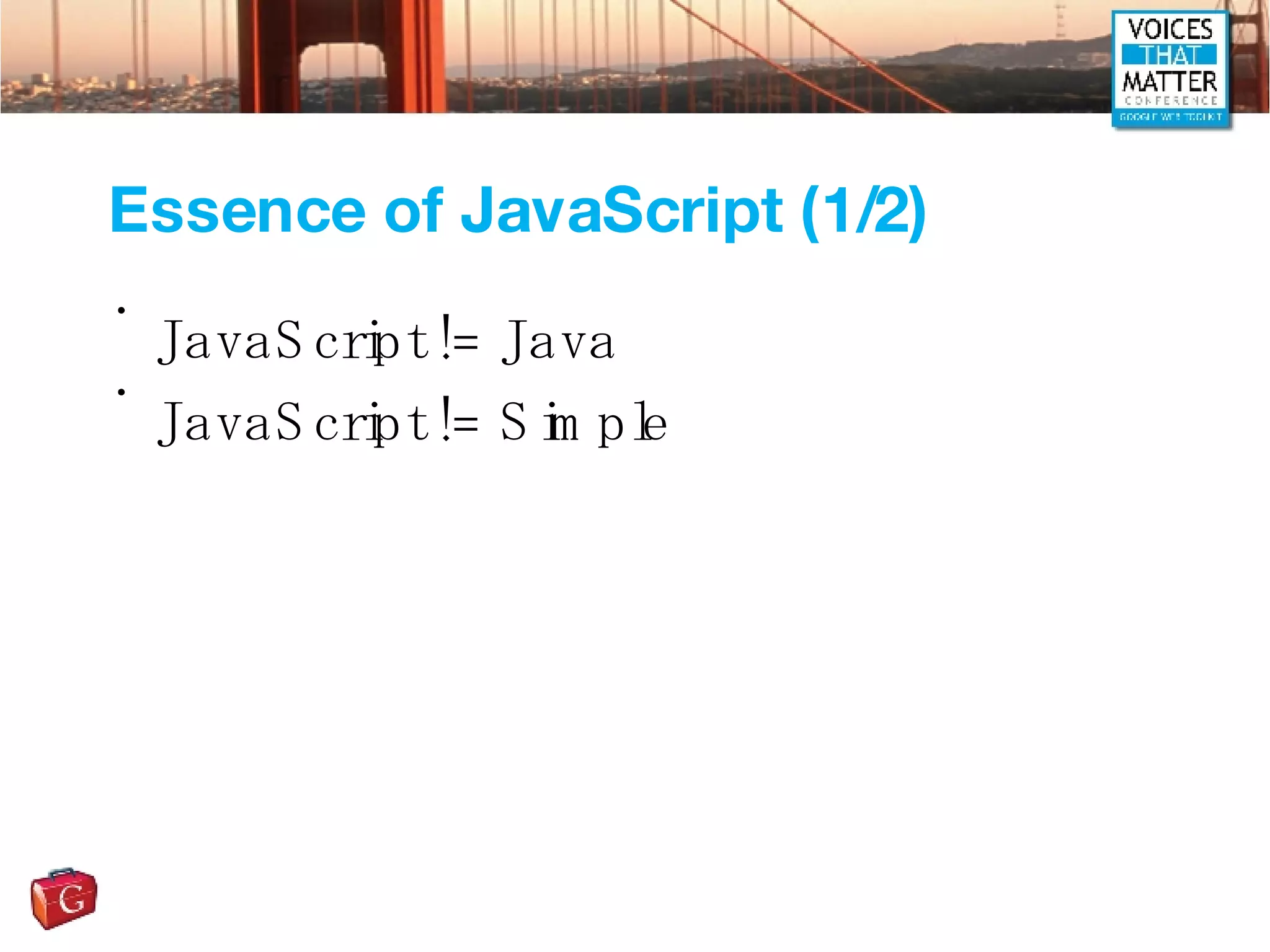
![Essence of JavaScript (2/2) ECMAScript Dynamic Client-side Prototype based Associative arrays Weakly typed Obj.x = 10; Obj[“x”] = 10;](https://image.slidesharecdn.com/ajax-and-javascript-bootcamp-1196879148400612-5/75/Ajax-and-JavaScript-Bootcamp-10-2048.jpg)
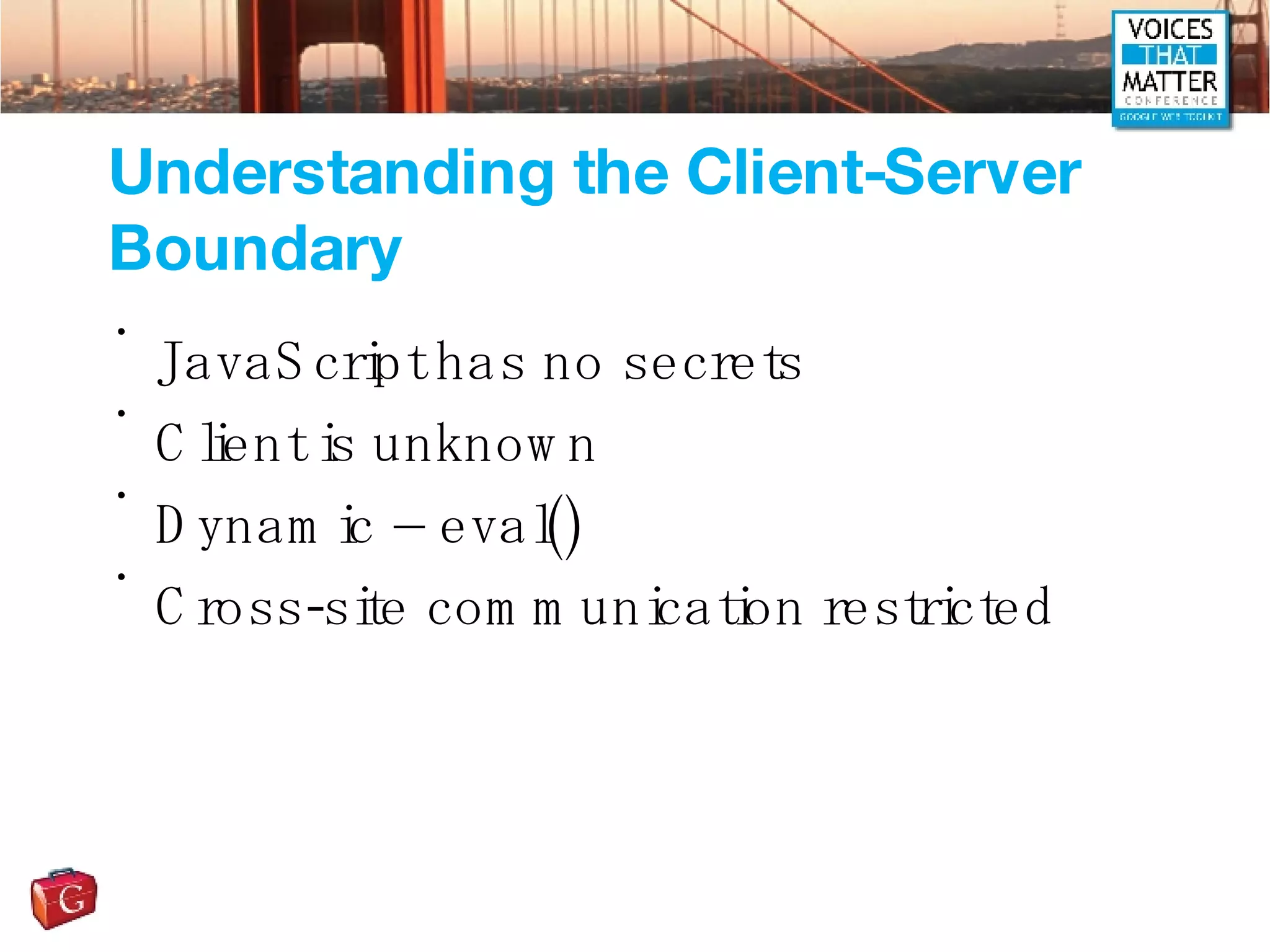
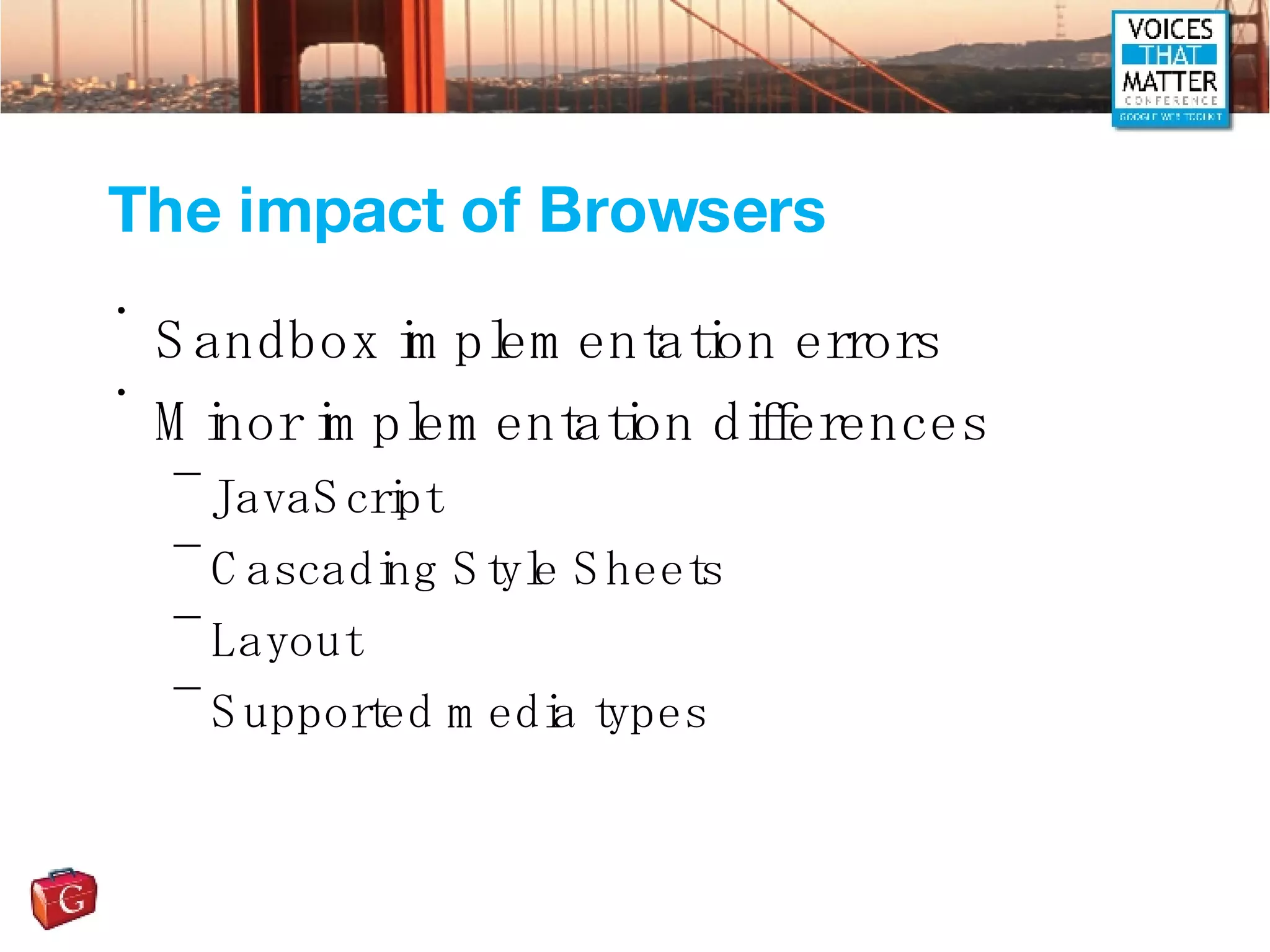
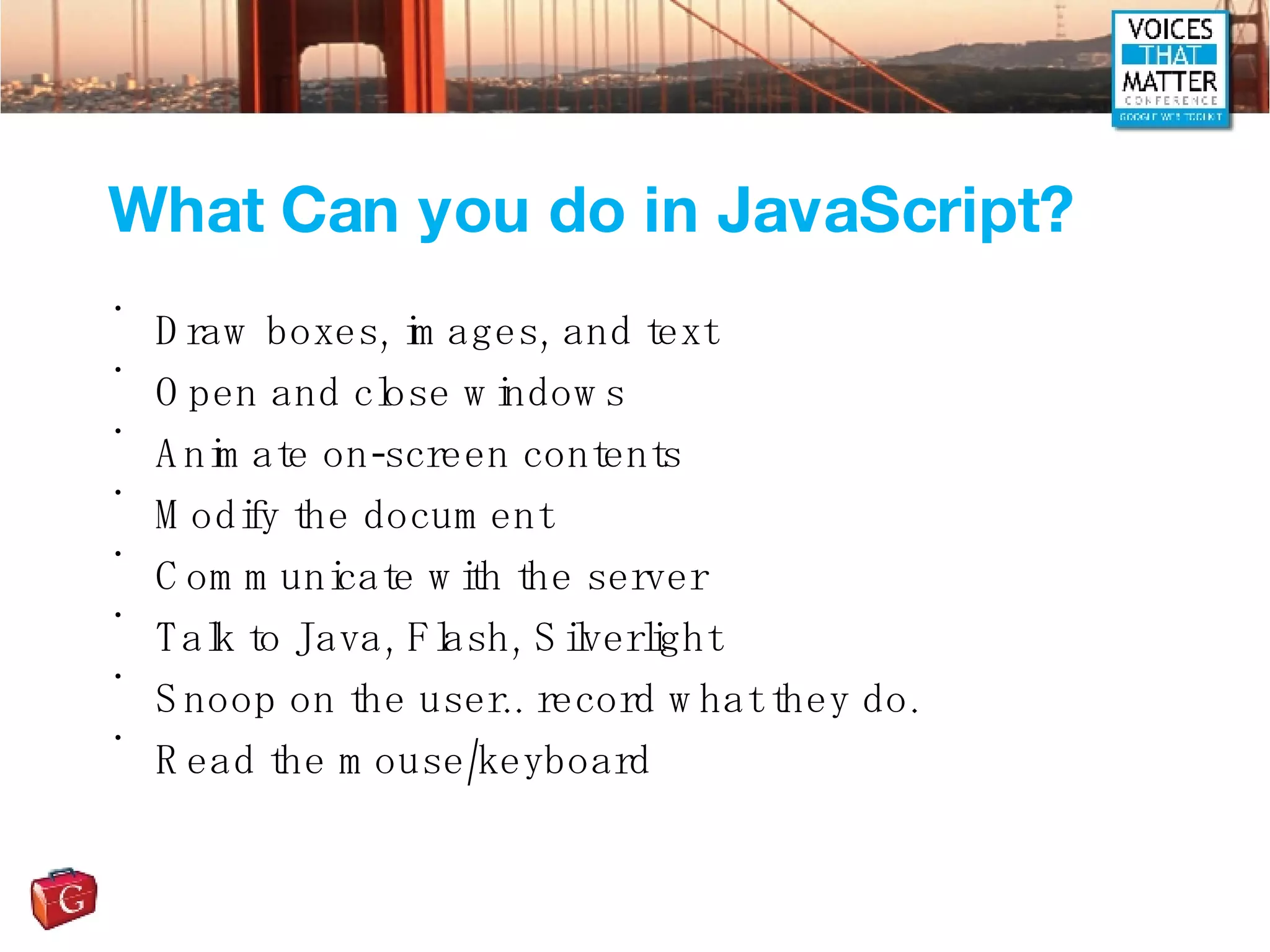
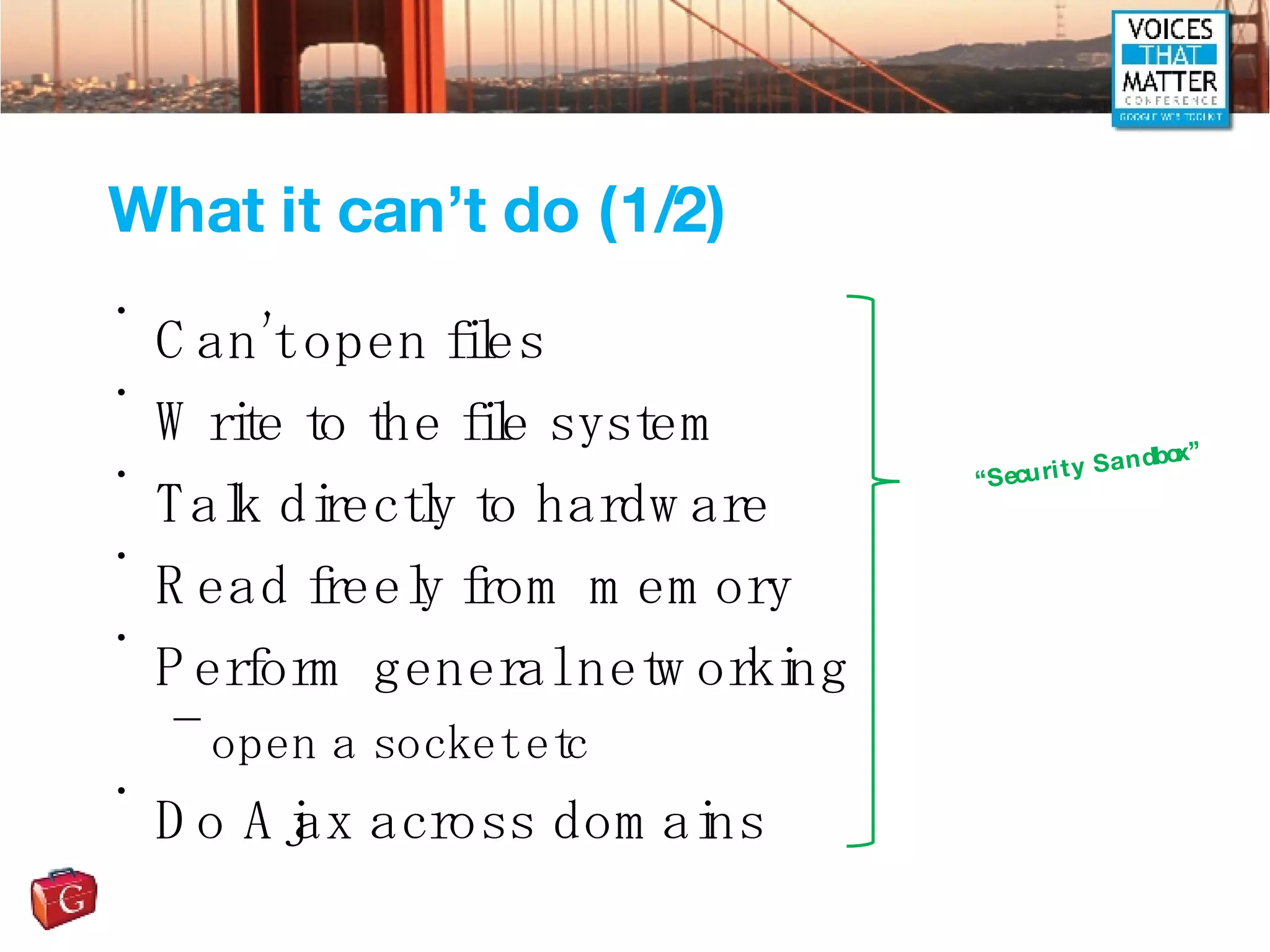
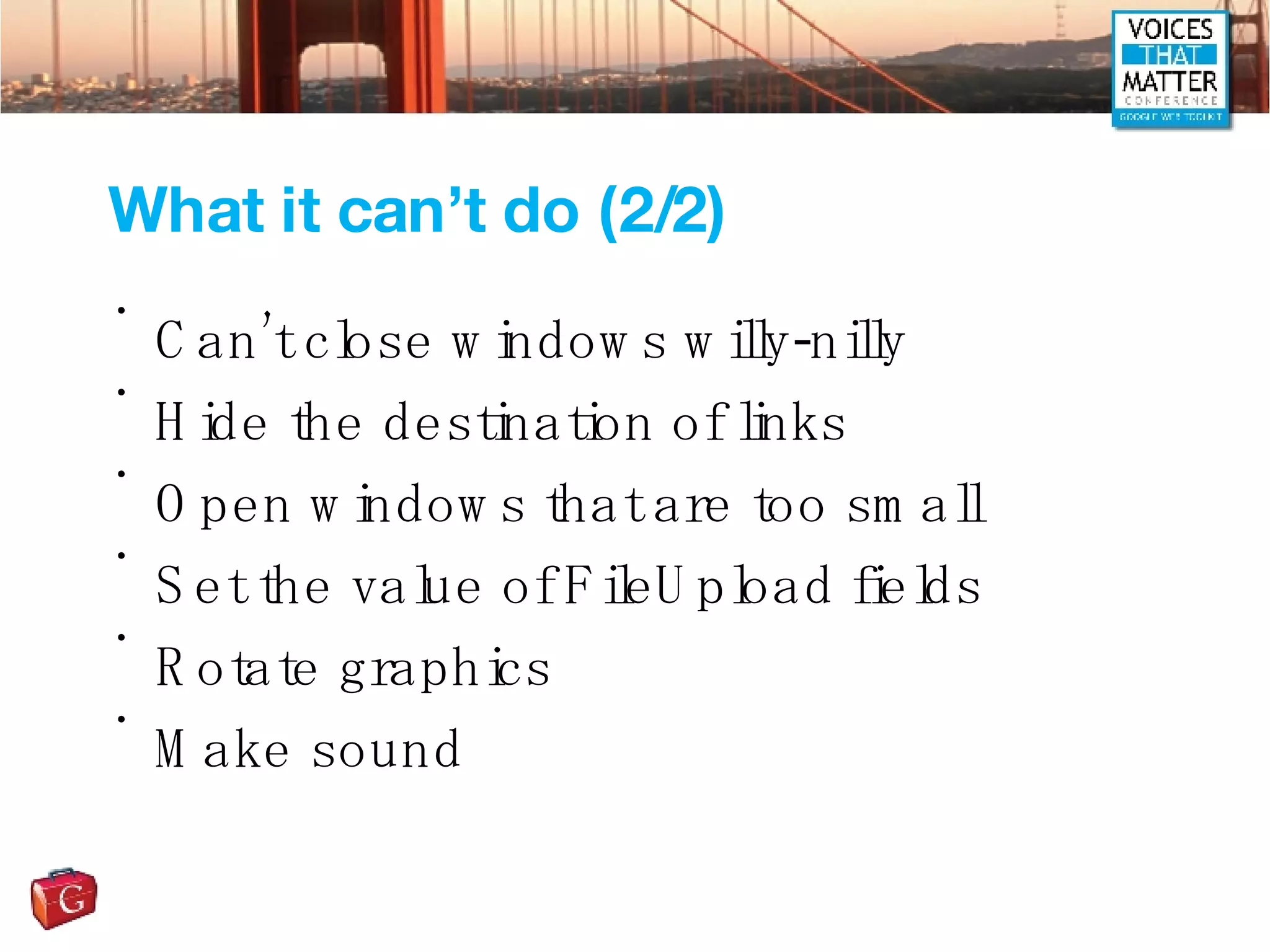
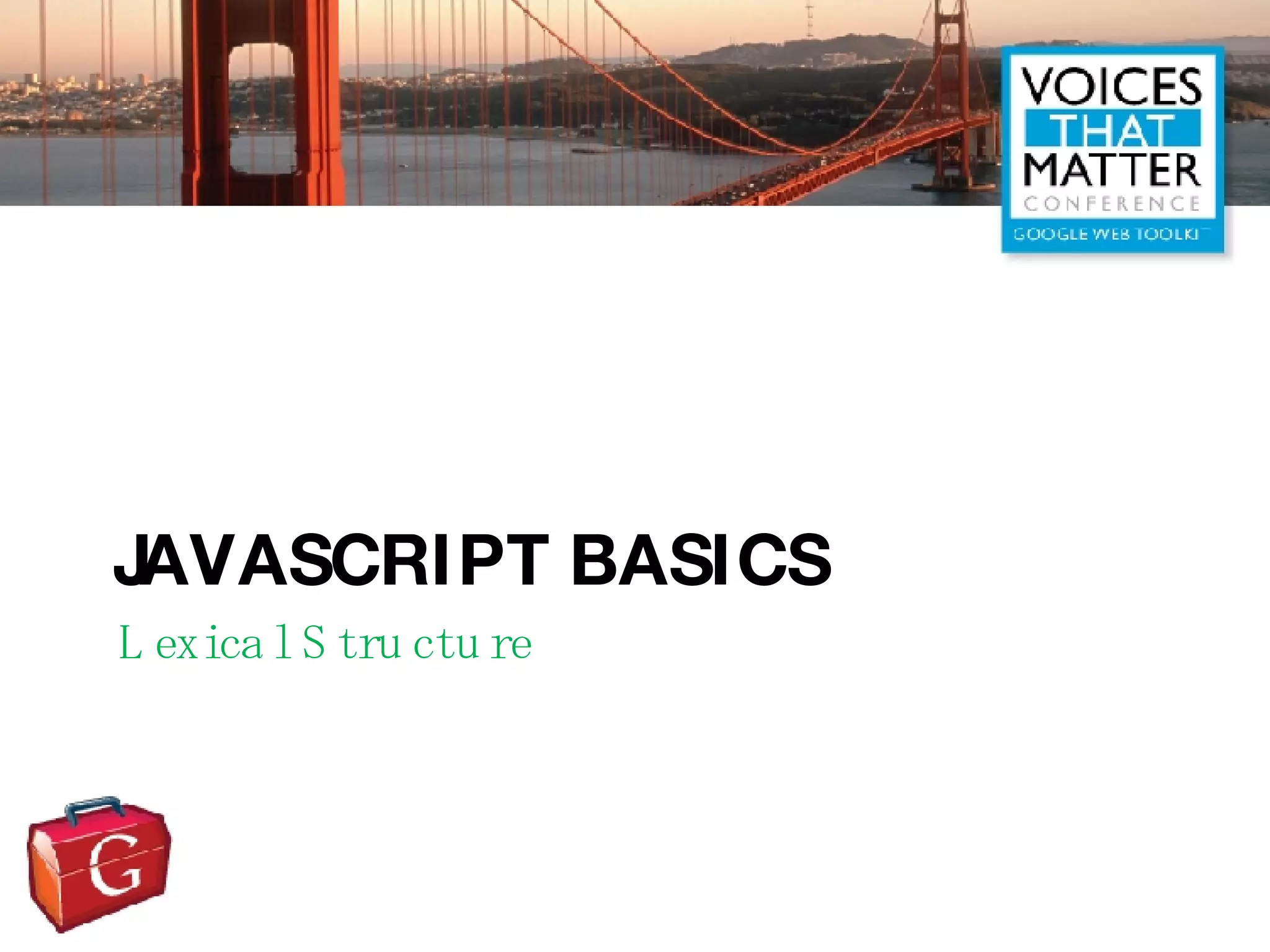
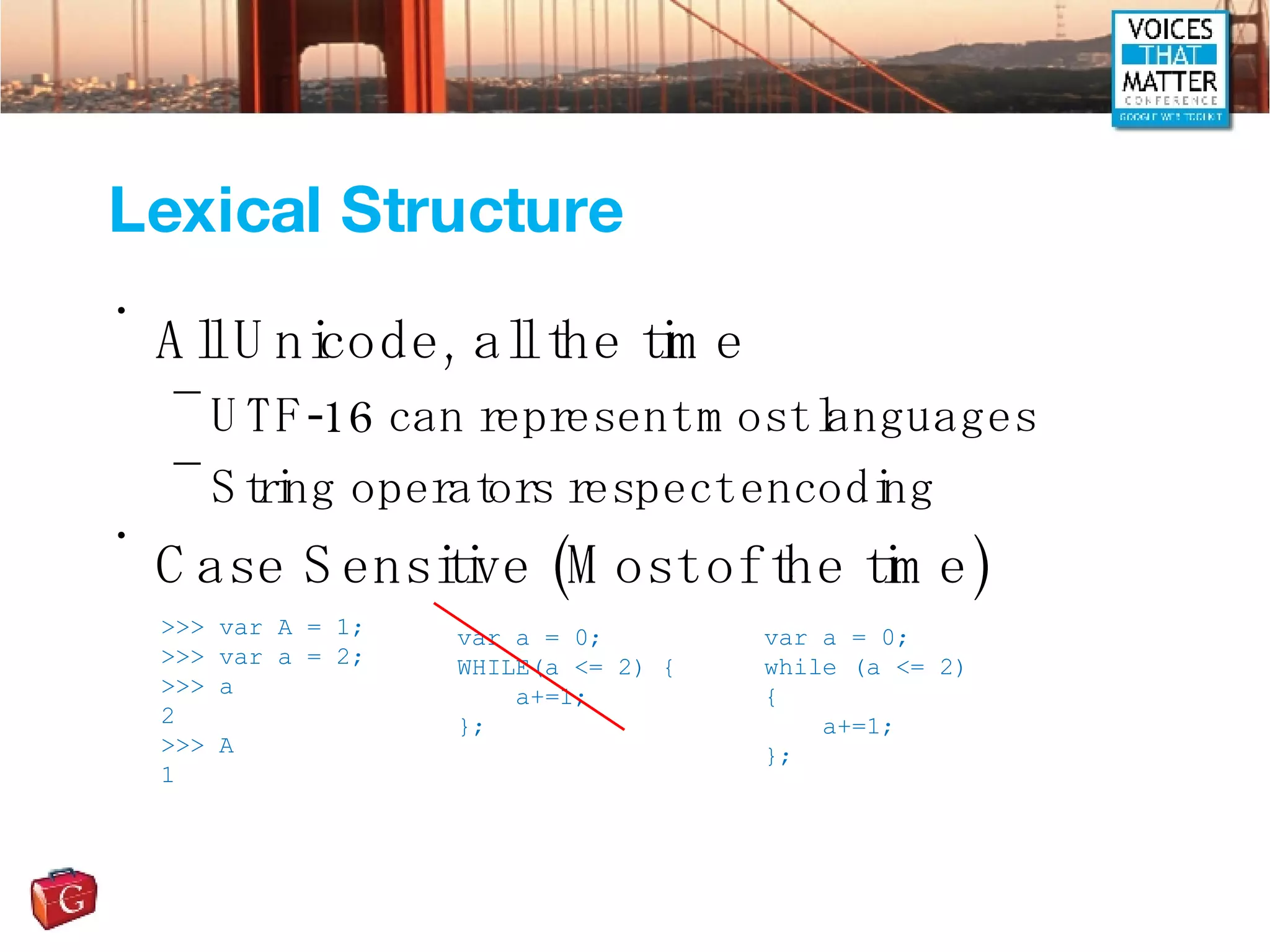
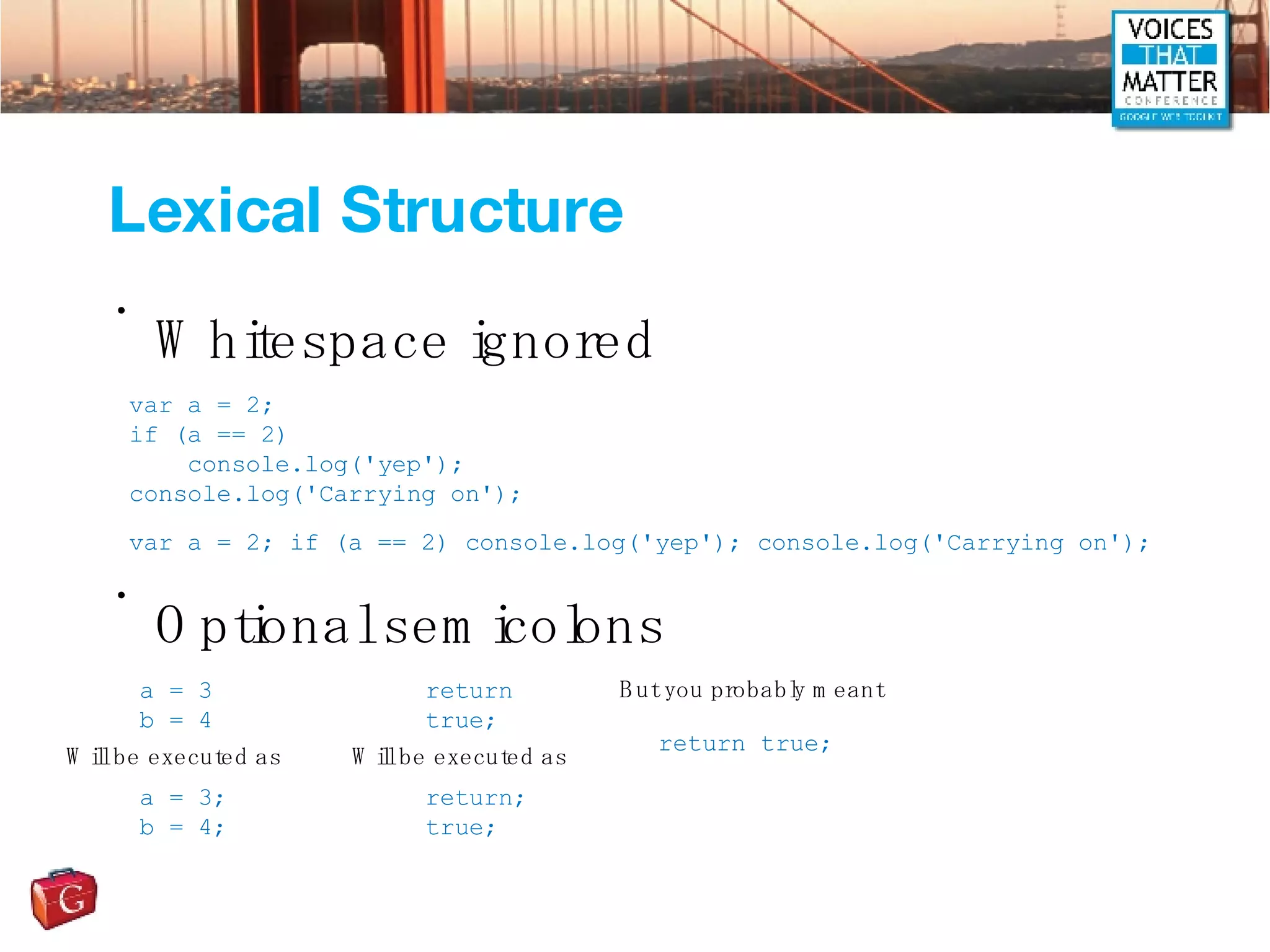
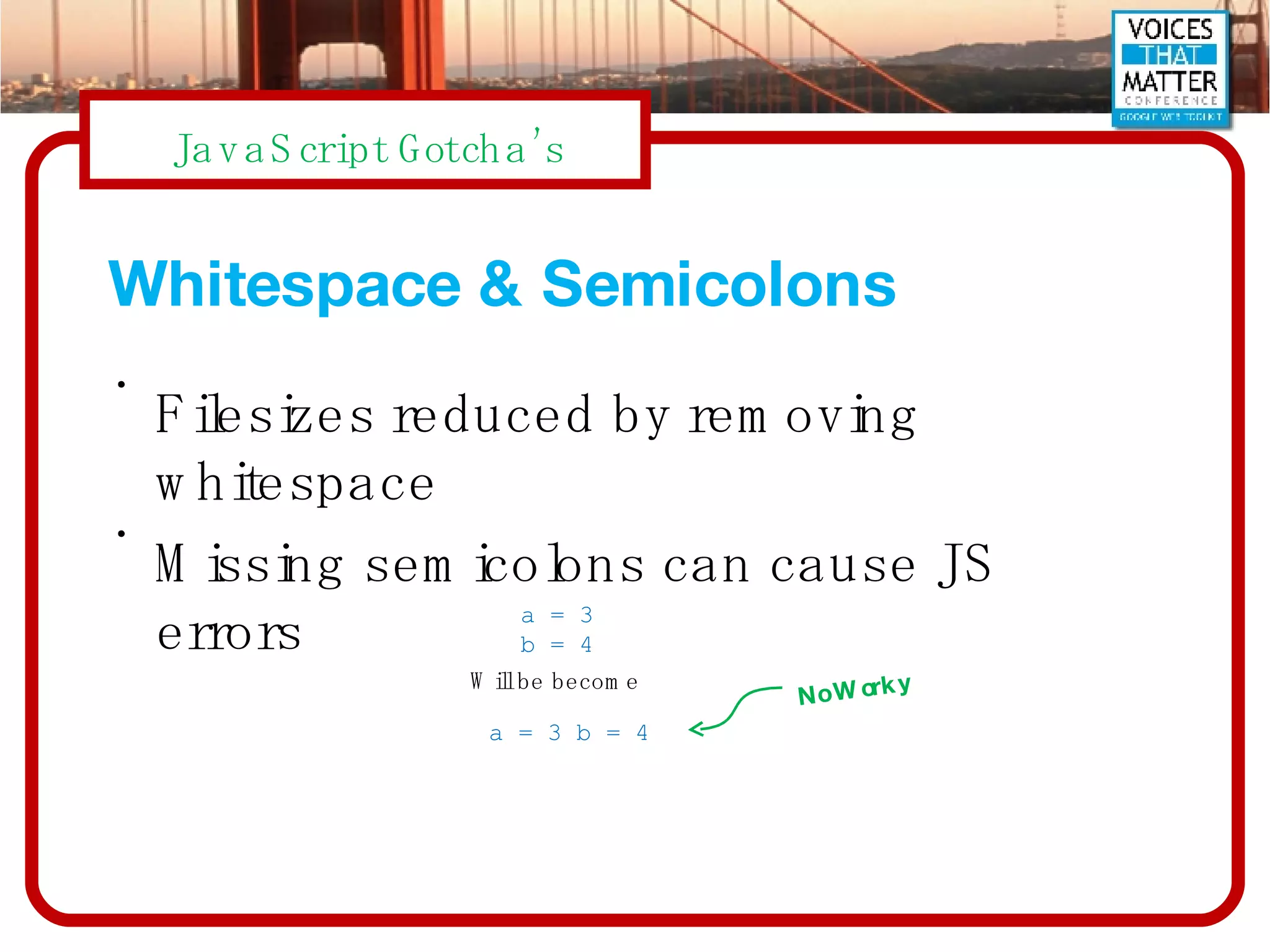
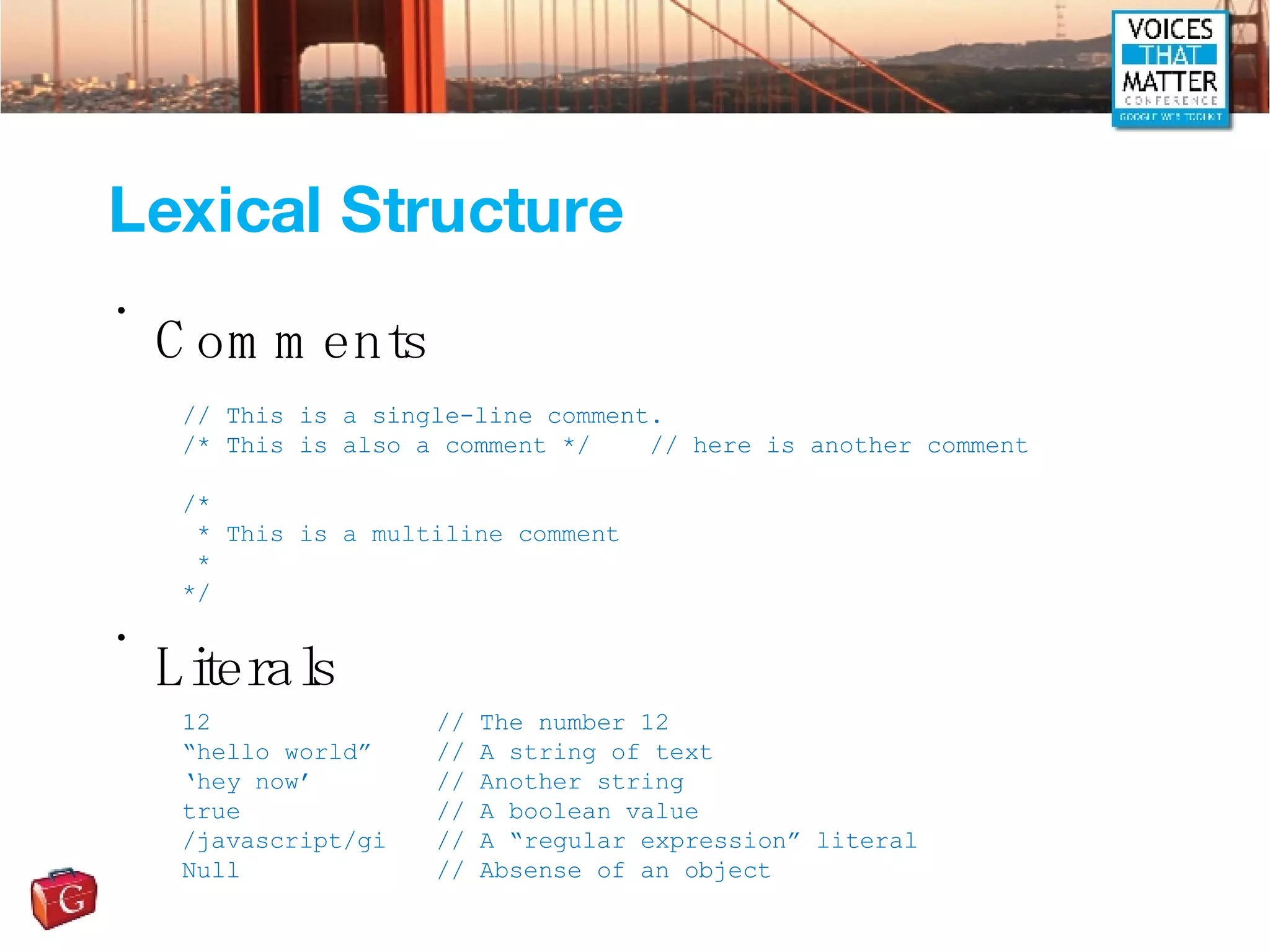
![Lexical Structure Object Literals Identifiers (Variables) { name: “Alexei”, weight: 160 } // An object initializer [23,345,12,341,2] // An array initializer [{a:2},{a:56,name:’Buck’},{c:65}] // An array of objects.. a my_variable_name v382 _something $ $fgj 34fg .vgf](https://image.slidesharecdn.com/ajax-and-javascript-bootcamp-1196879148400612-5/75/Ajax-and-JavaScript-Bootcamp-21-2048.jpg)
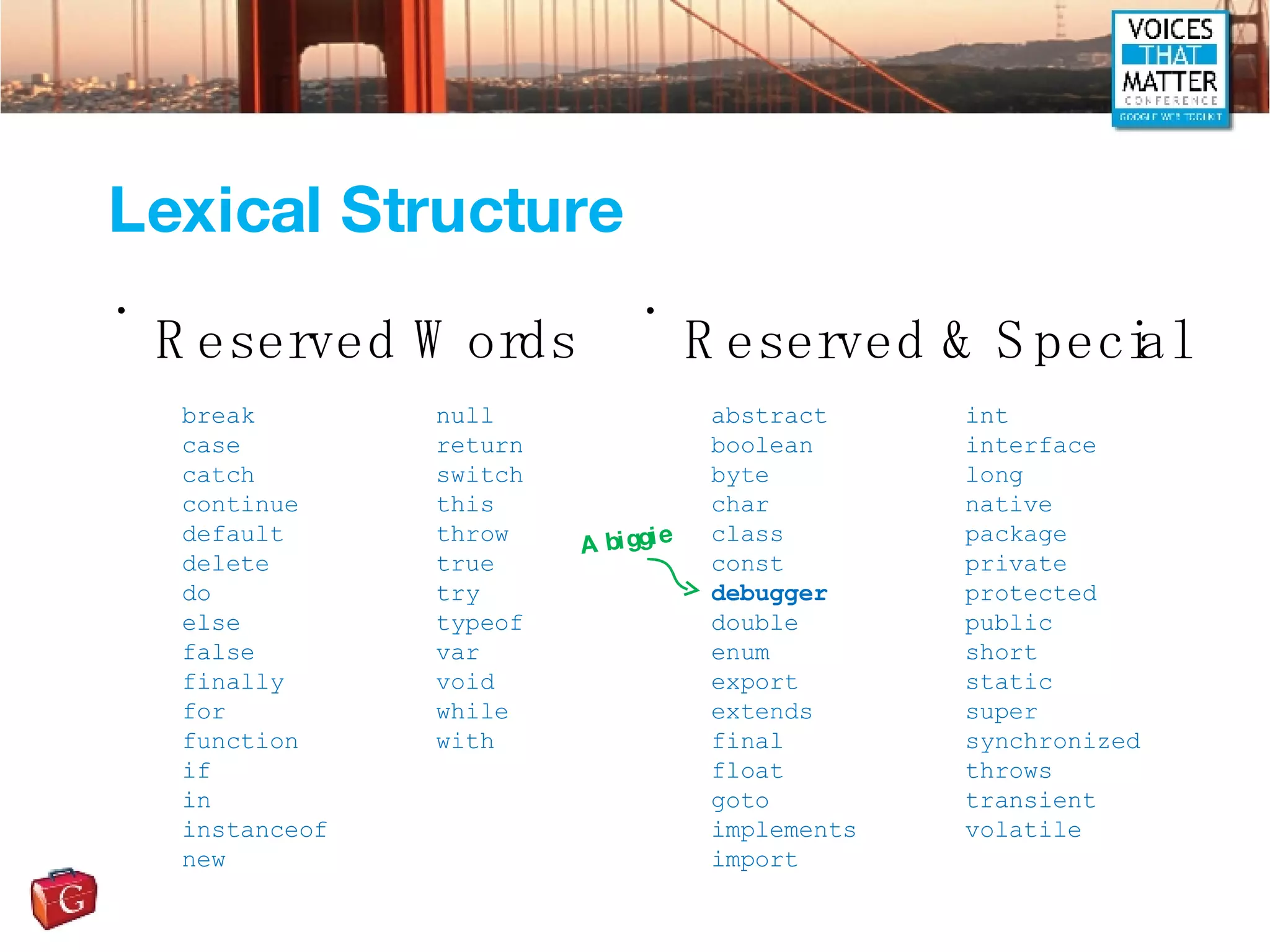
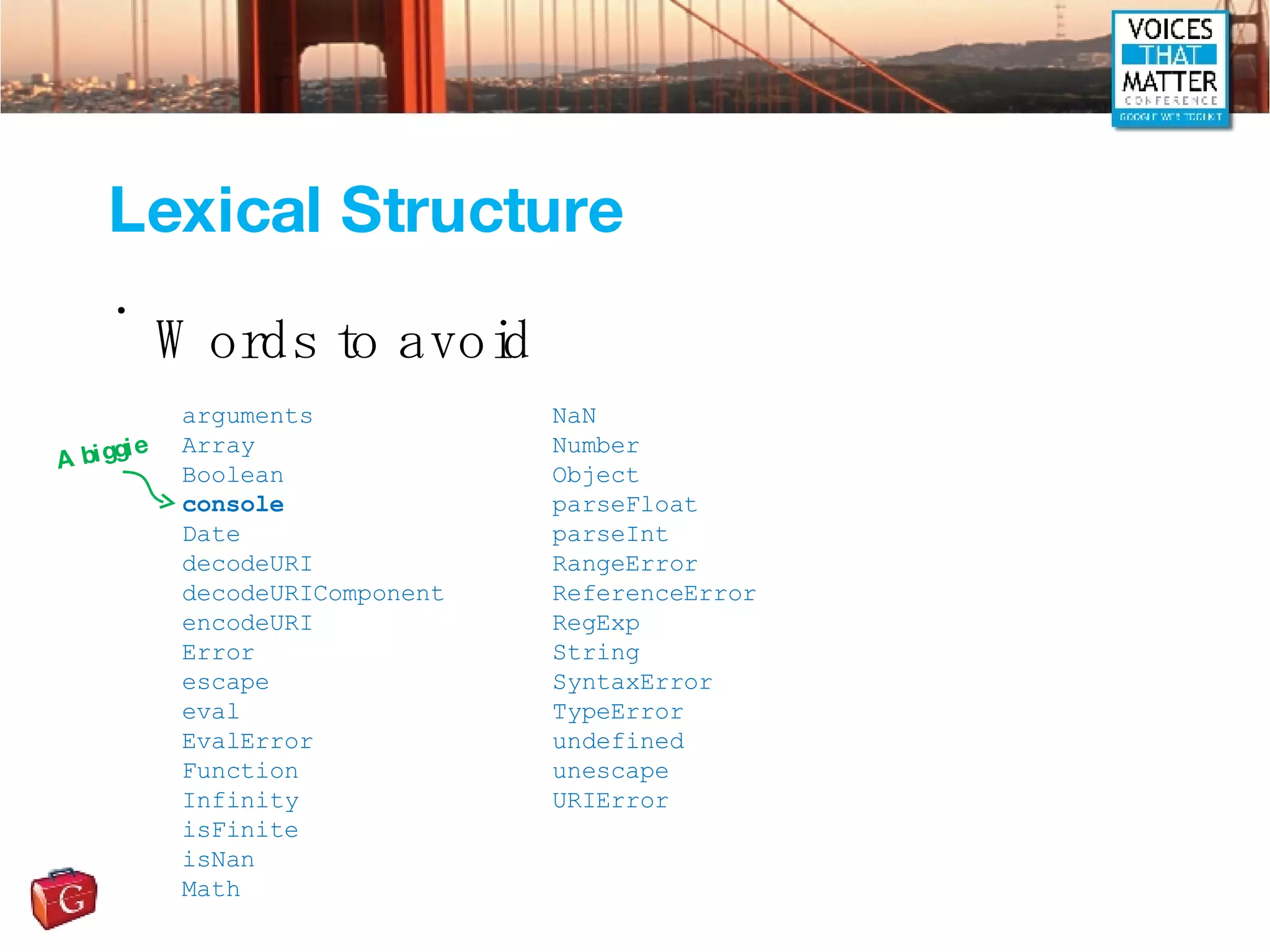
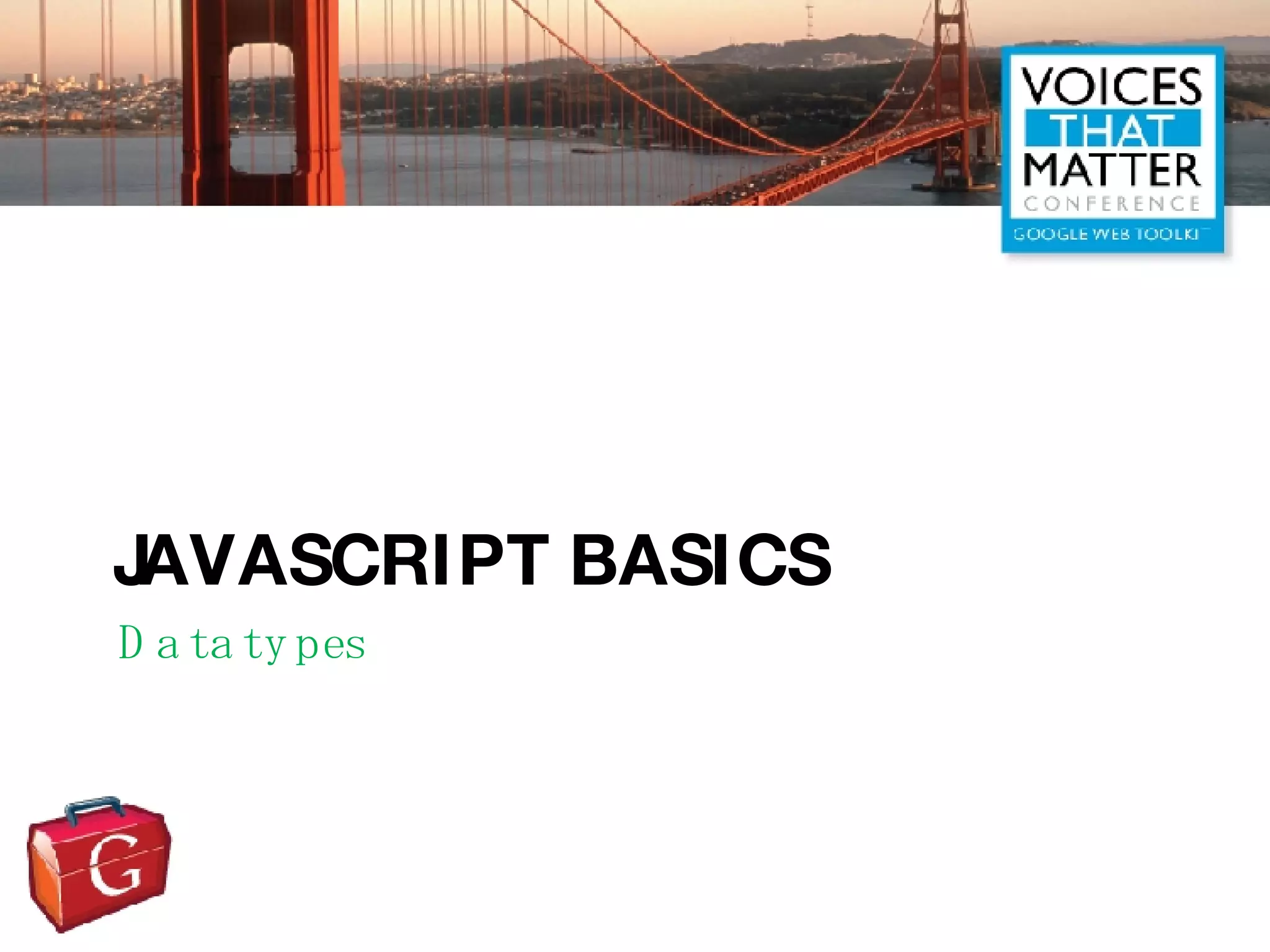
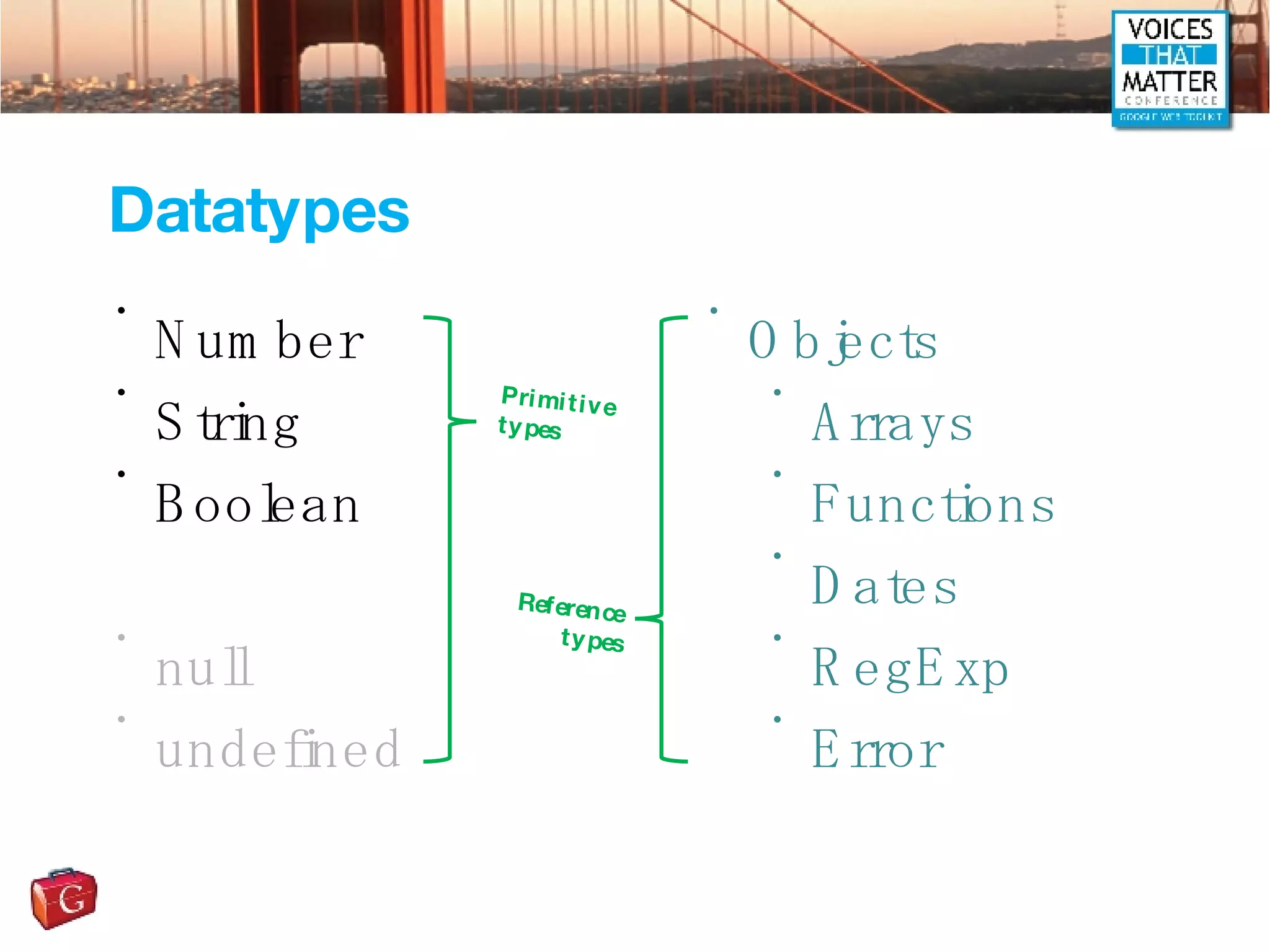
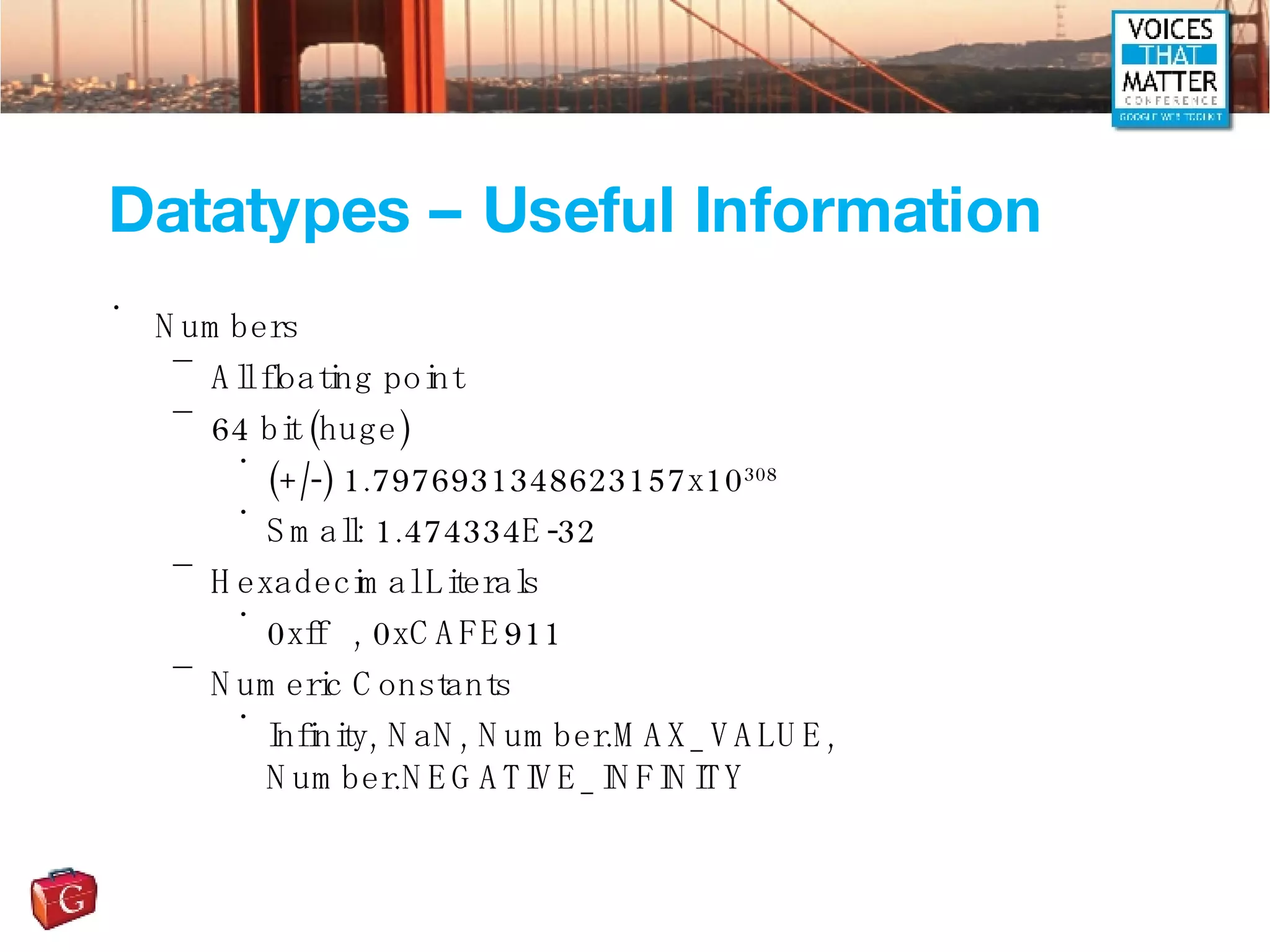
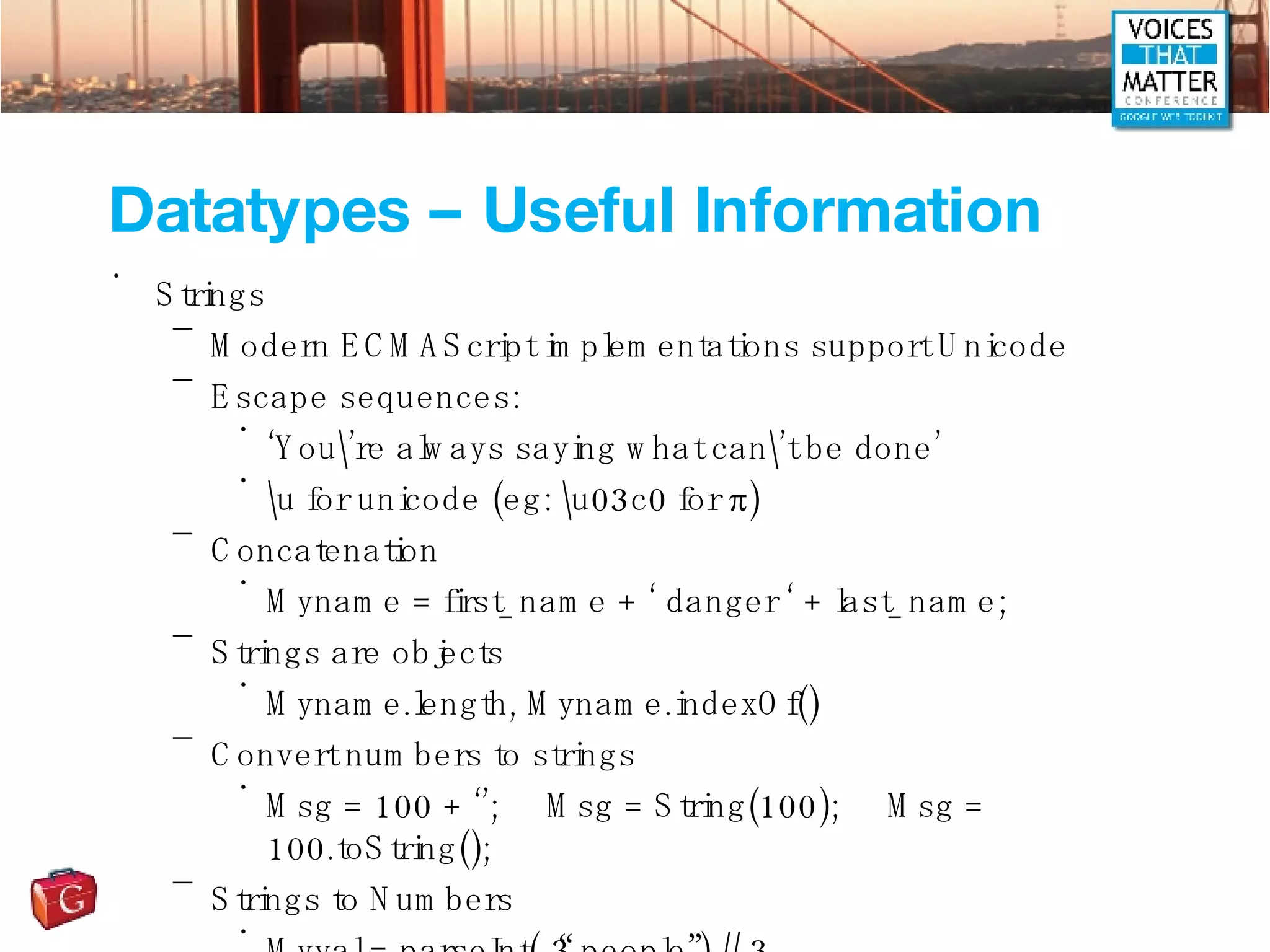
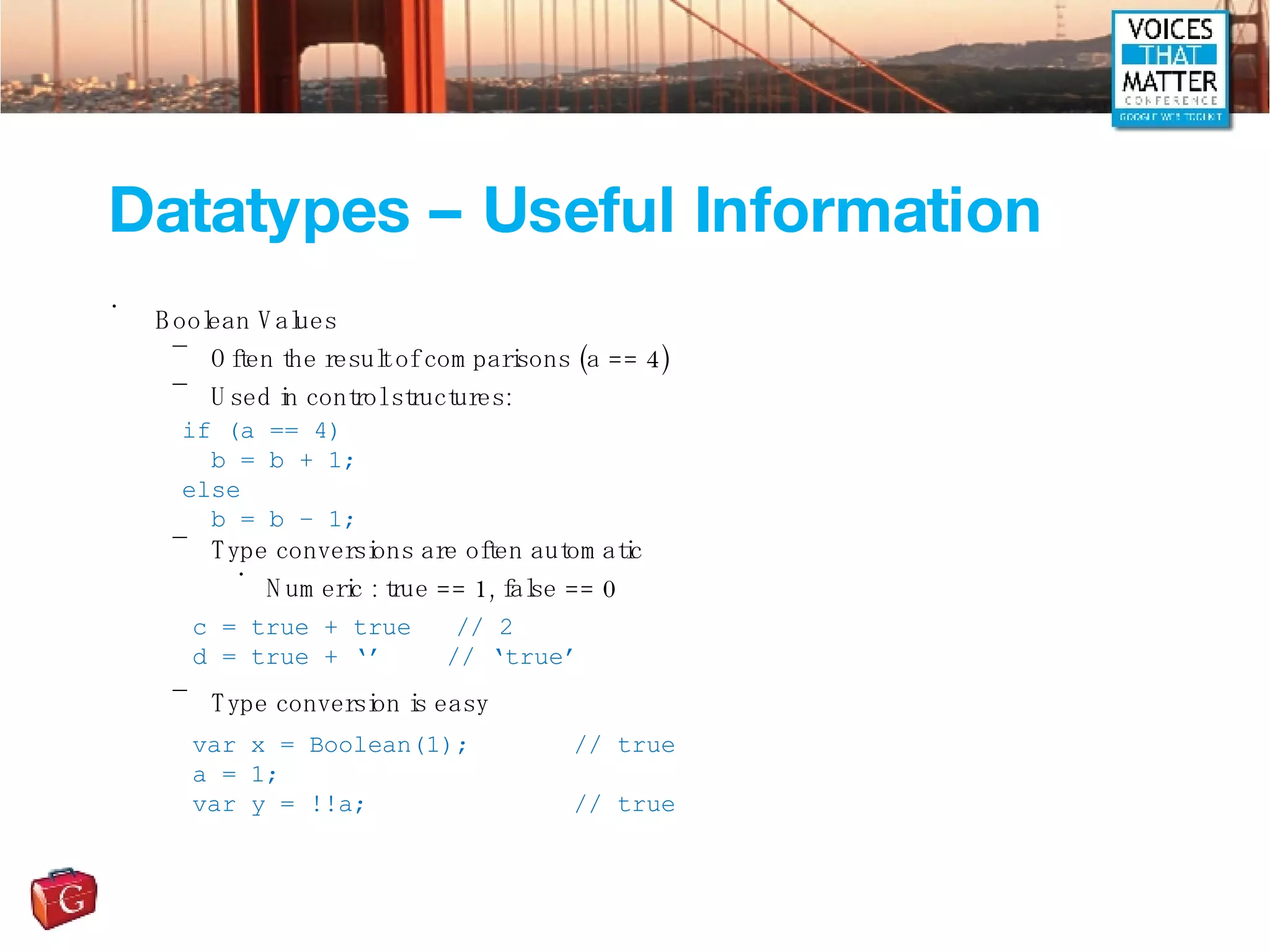
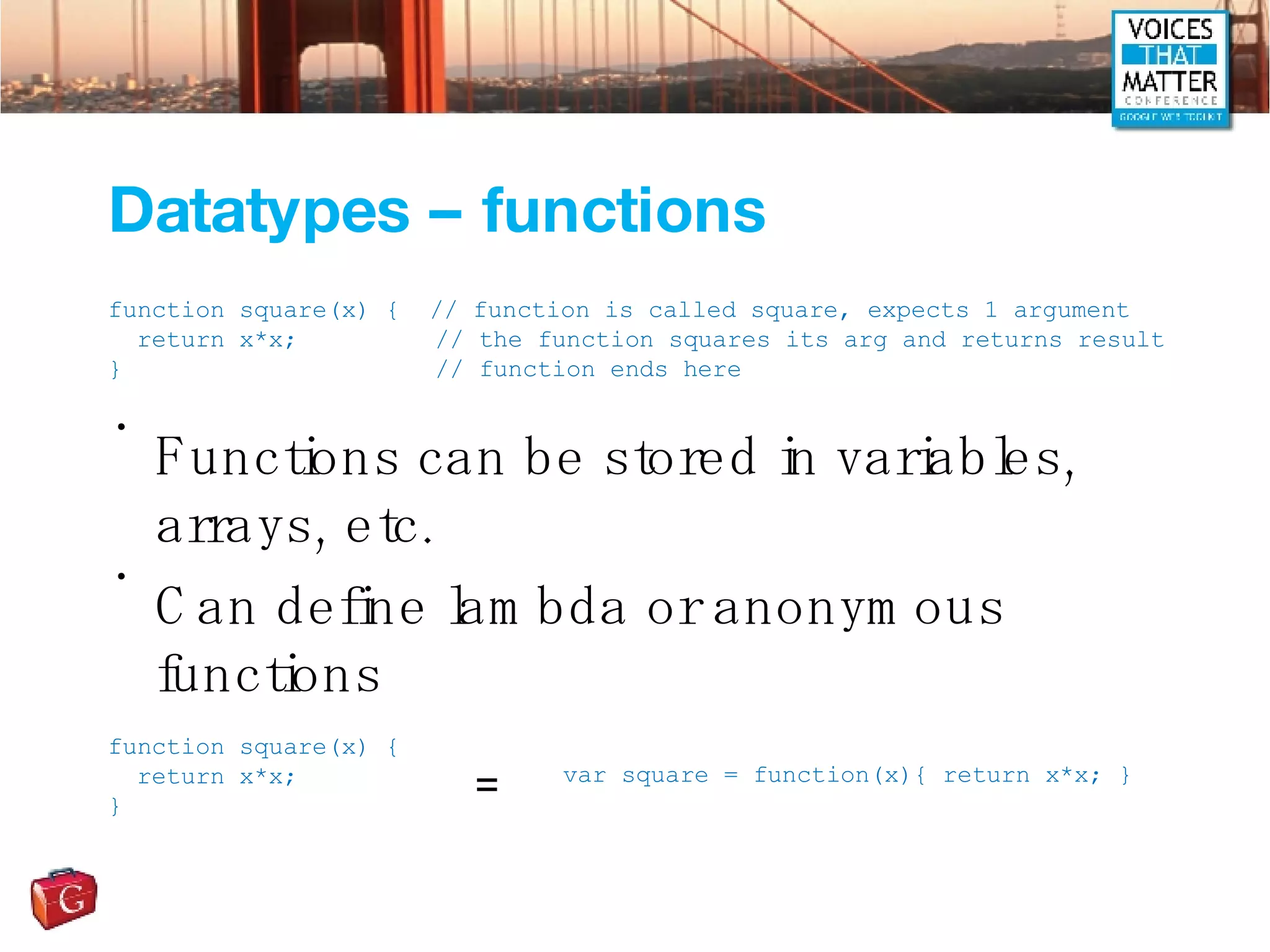
![Datatypes – objects JavaScript has built-in objects Objects are associative arrays Invoked using new keyword document.forms document.images window.innerWidth window.scrollY document.forms document.images document[“forms”] document[“images”] = var a = new Object(); var now = new Date(); var pattern = new RegExp( “\\sjava\\s ”, “i”) a.x = 1.1; a.y = 344;](https://image.slidesharecdn.com/ajax-and-javascript-bootcamp-1196879148400612-5/75/Ajax-and-JavaScript-Bootcamp-30-2048.jpg)
![Datatypes – objects Object literals Comma-separated list of name-value pairs AKA JSON (JavaScript Object Notation) var vertex = { x:3.2, y:13.2, z:64.3 }; var user = { "fullName": "John Smith", "address": { "streetAddress": "21 2nd Street", "city": "New York", "postalCode": 10021 }, "phoneNumbers": [ "212 732-1234", "646 123-4567" ] }](https://image.slidesharecdn.com/ajax-and-javascript-bootcamp-1196879148400612-5/75/Ajax-and-JavaScript-Bootcamp-31-2048.jpg)
![Datatypes – objects Object conversion: Does an object exist? Objects as strings if (myObj) { // Do something } a = {b:34,t:4} b = a + “” // “[object Object]”](https://image.slidesharecdn.com/ajax-and-javascript-bootcamp-1196879148400612-5/75/Ajax-and-JavaScript-Bootcamp-32-2048.jpg)
![Datatypes - arrays A collection of values, like an object Can contain any type of JS data var a = new Array(1.1, “something”, true, {x:43,y:34}); var b = new Array(); b[0] = 1.1; b[1] = “something”; b[2] = true; b[3] = {x:43,y:34}; var c = new Array(20);](https://image.slidesharecdn.com/ajax-and-javascript-bootcamp-1196879148400612-5/75/Ajax-and-JavaScript-Bootcamp-33-2048.jpg)
![Datatypes - arrays Array literals Sparse arrays Array length Searching var a = [1.2, “something”, true, {x:33,y:34}]; var a = [1,,,,5]; a.length var array = [2, 5, 9]; var index = array.indexOf(5); // index is 1 index = array.indexOf(7); // index is -1](https://image.slidesharecdn.com/ajax-and-javascript-bootcamp-1196879148400612-5/75/Ajax-and-JavaScript-Bootcamp-34-2048.jpg)
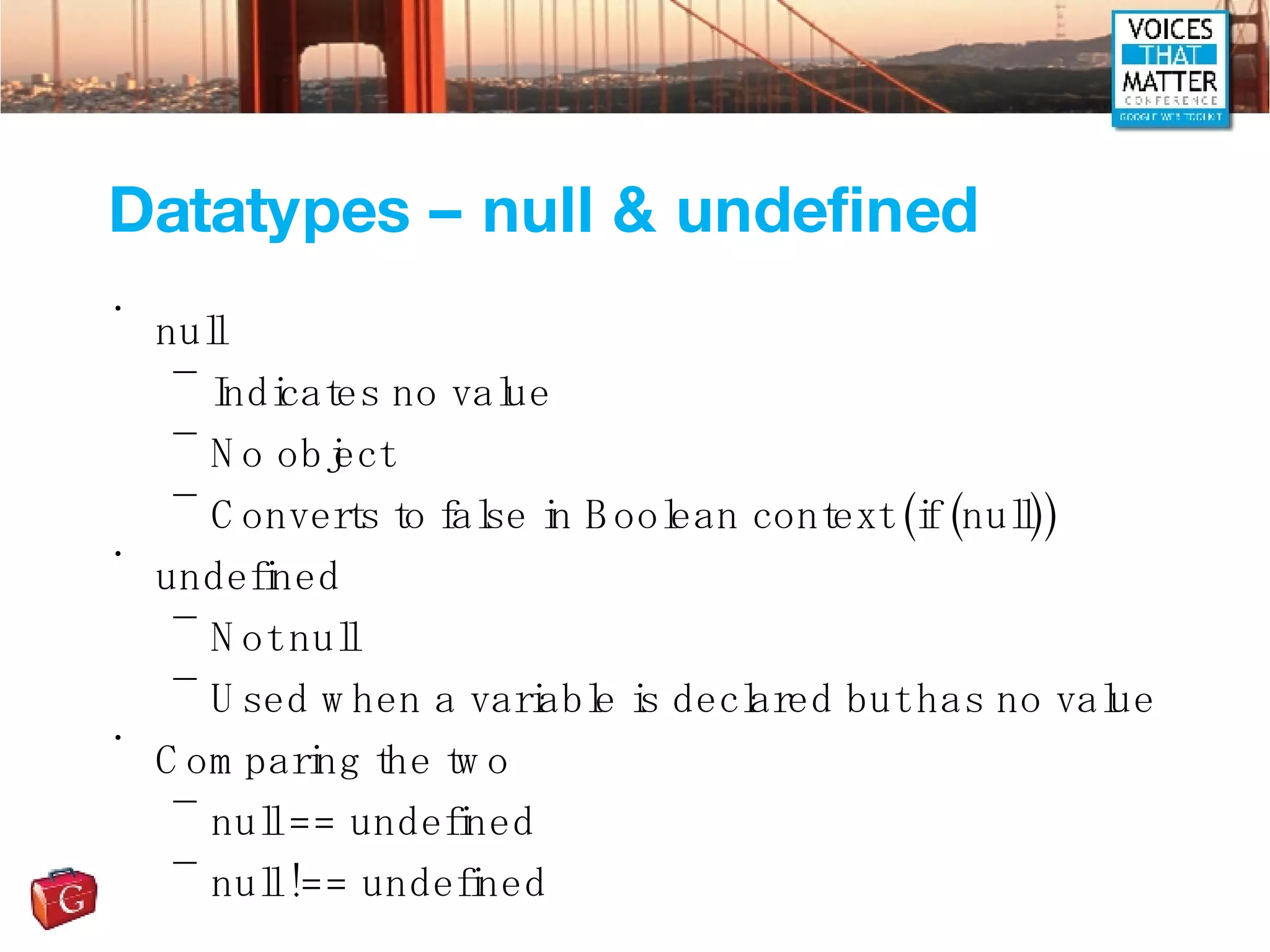
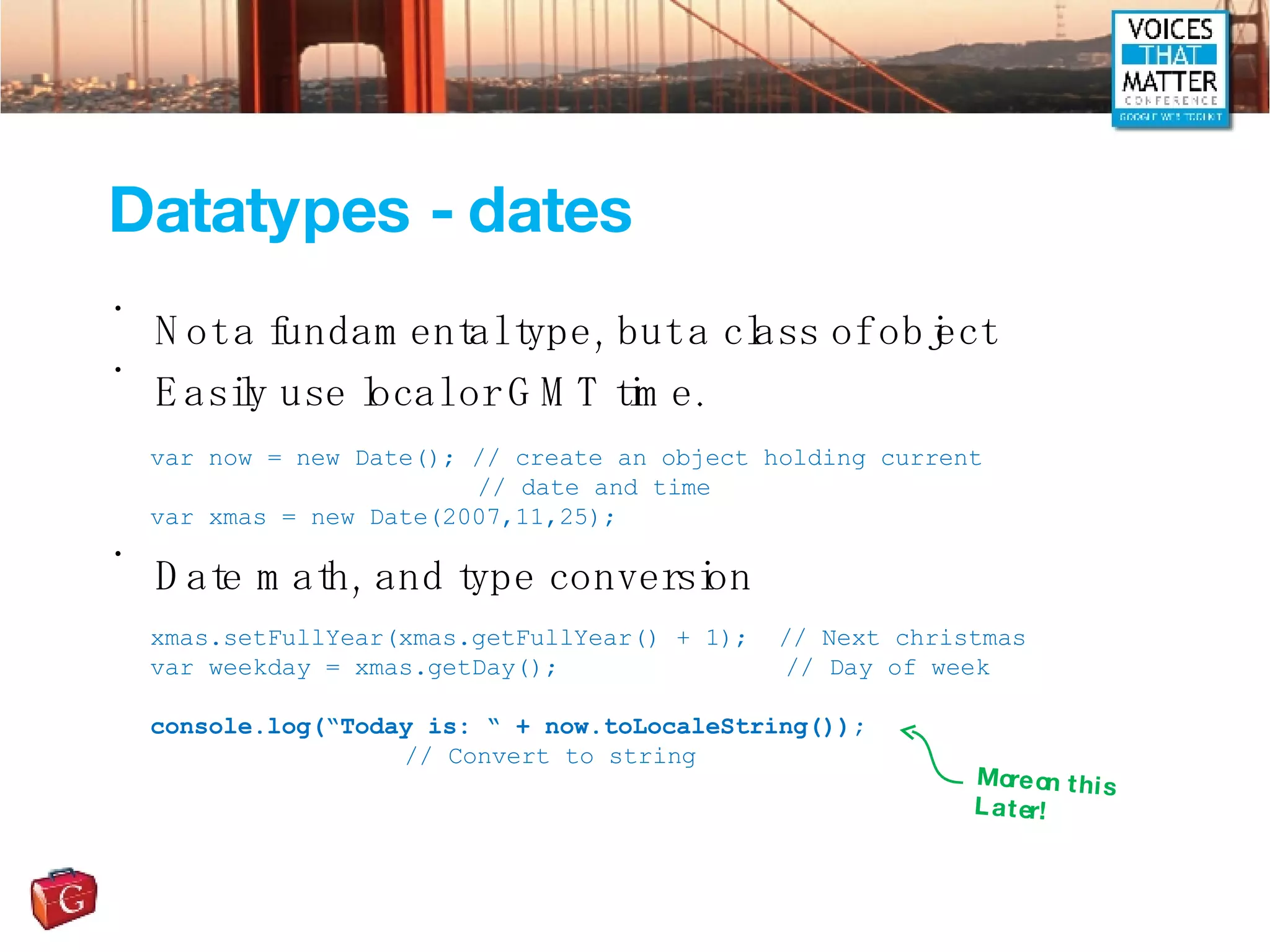
![Datatypes – regular expressions Pattern matching Search and replace Use the string method replace /^NITOBI/ /[1-9][0-9]*/ /\bnitobi\b/i Mystr.replace(/\bnitobi\b/I, “NITOBI”); // capitalize all instances // of NITOBI.](https://image.slidesharecdn.com/ajax-and-javascript-bootcamp-1196879148400612-5/75/Ajax-and-JavaScript-Bootcamp-37-2048.jpg)
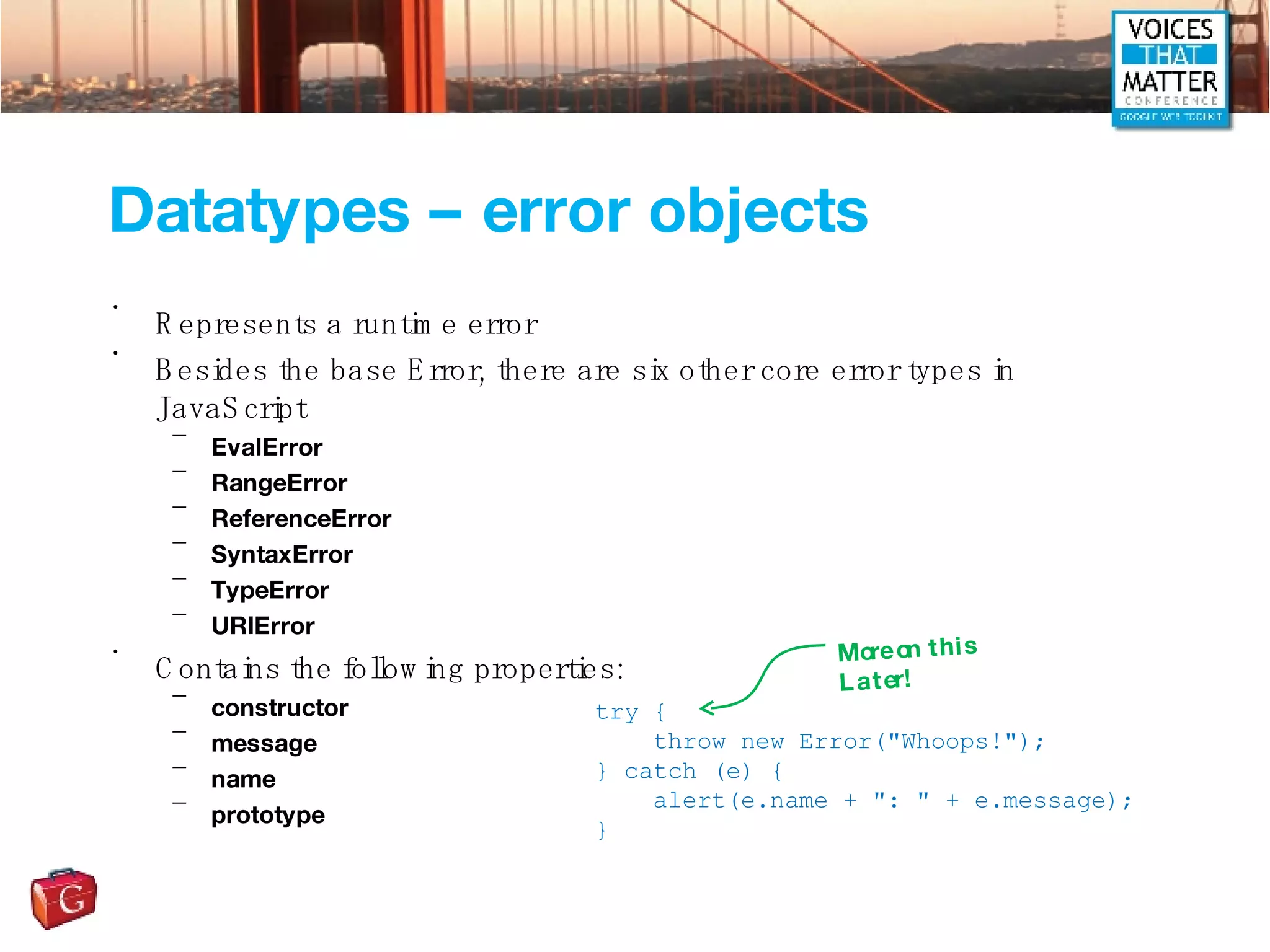
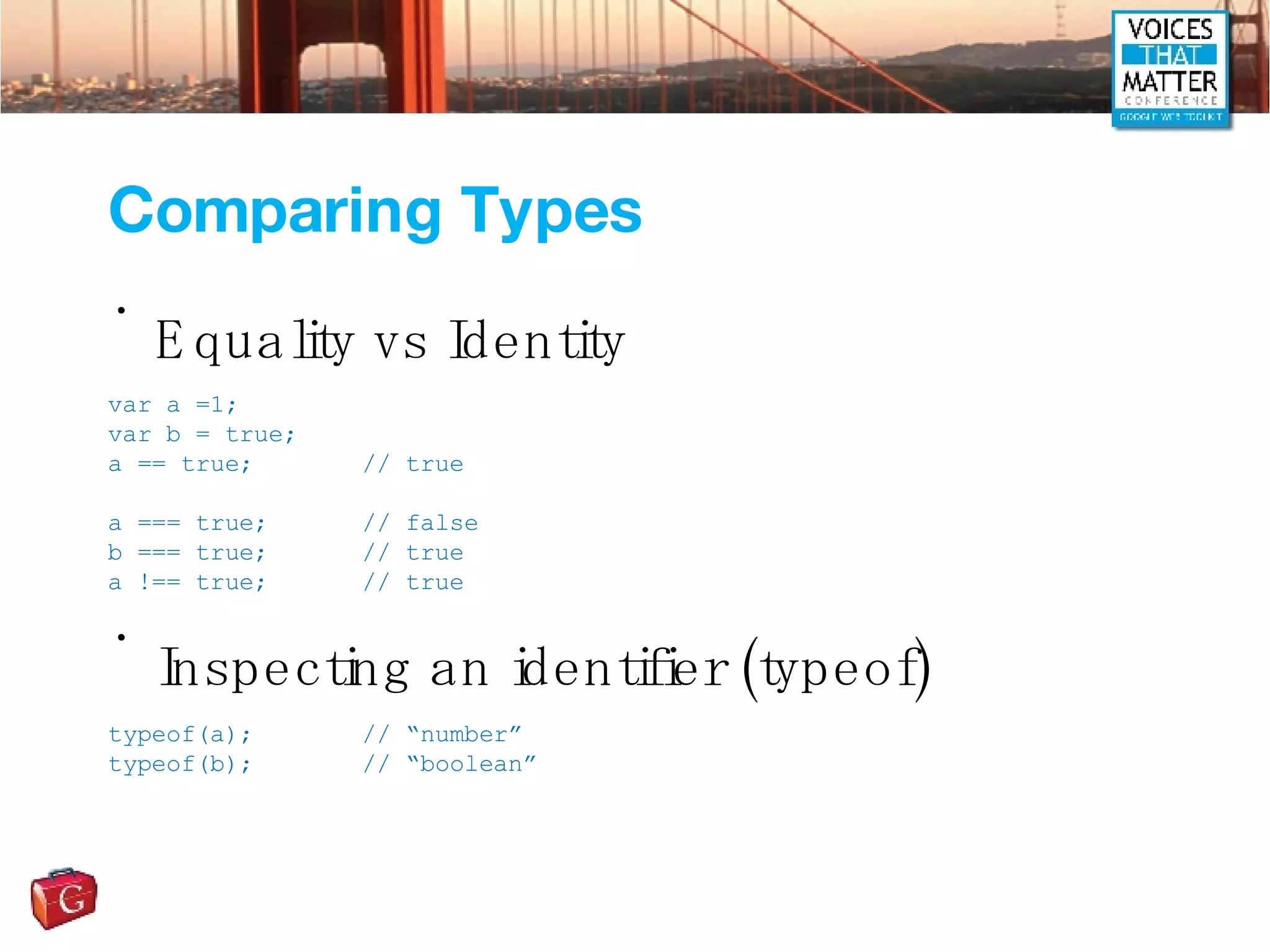
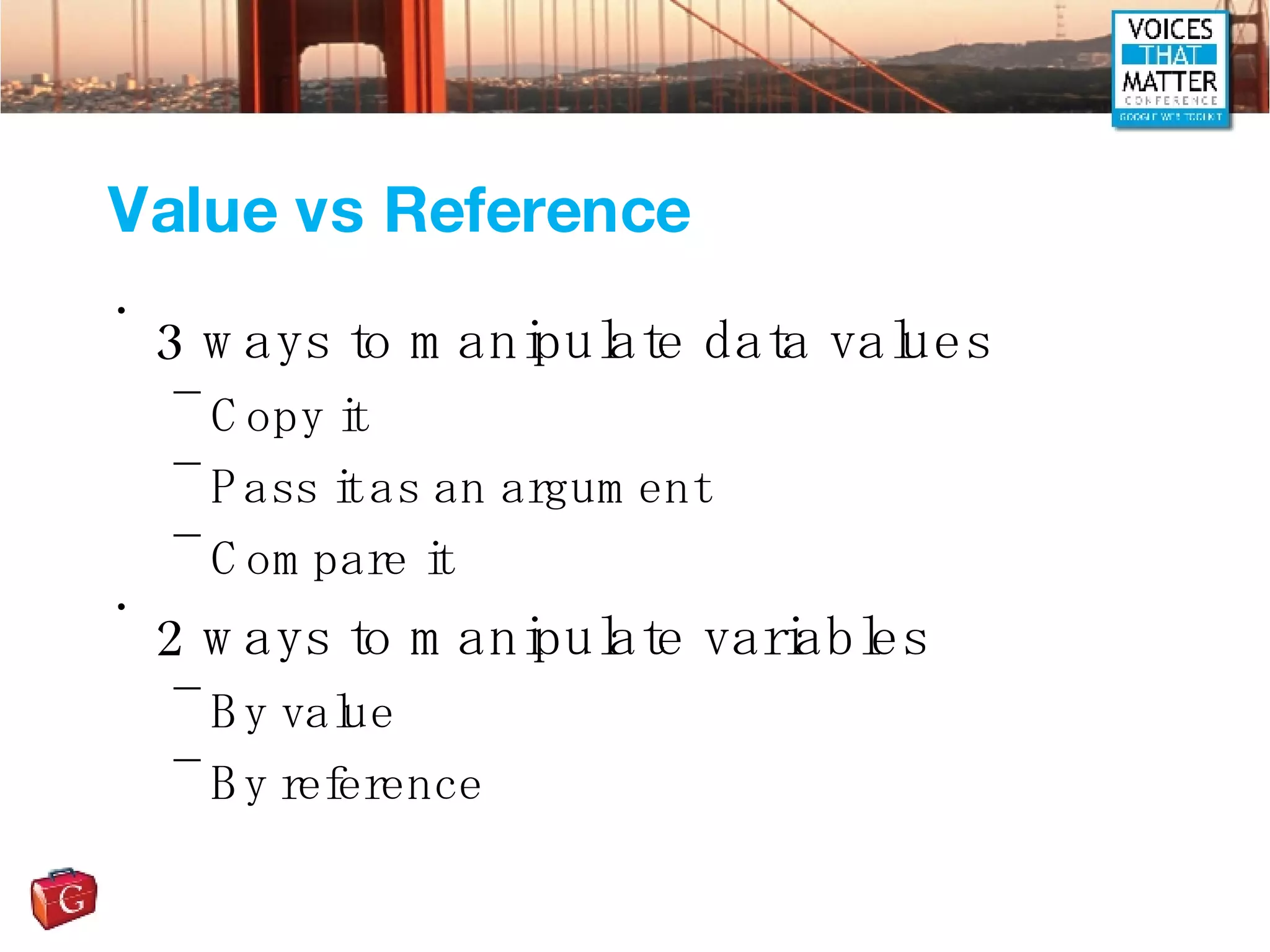
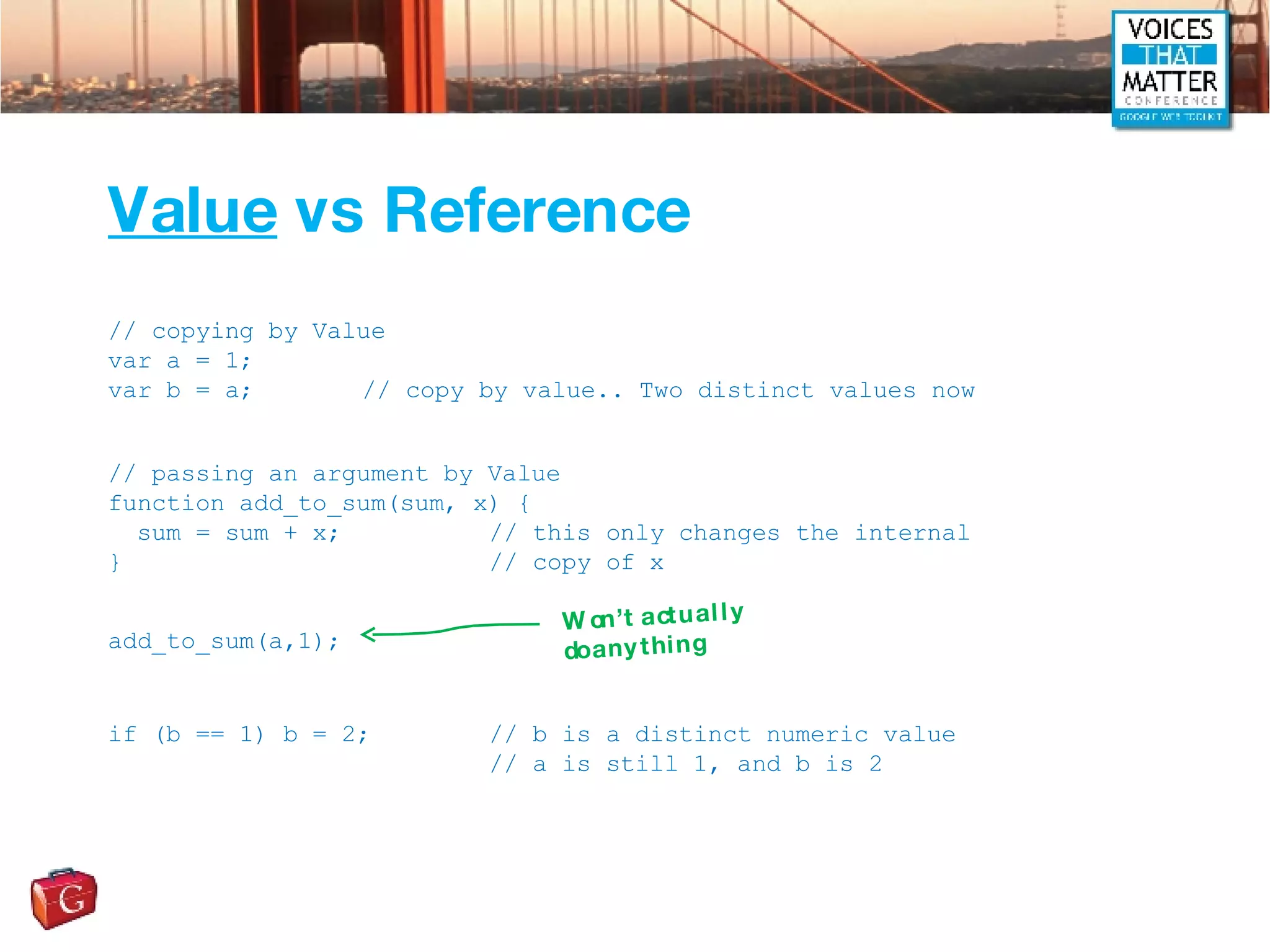
![Value vs Reference // copying by reference var xmas = new Date(2007, 11, 25); var gift_day = xmas; // both variables refer to the same object gift_day.setDate(26); // we’ve now changed both variables function add_to_sum(sum, x) { sum[0] = sum[0] + x; sum[1] = sum[1] + x; sum[2] = sum[1] + x; } (xmas == gift_day) // this is true still xmas.getDate(); // returns 26 not 25 var newdate1 = new Date(2007,10,10); var newdate2 = new Date(2007,10,10); (newdate1 == newdate2) // this is false Permanently changes ‘sum’ in global context Note: Strings are compared by value](https://image.slidesharecdn.com/ajax-and-javascript-bootcamp-1196879148400612-5/75/Ajax-and-JavaScript-Bootcamp-42-2048.jpg)
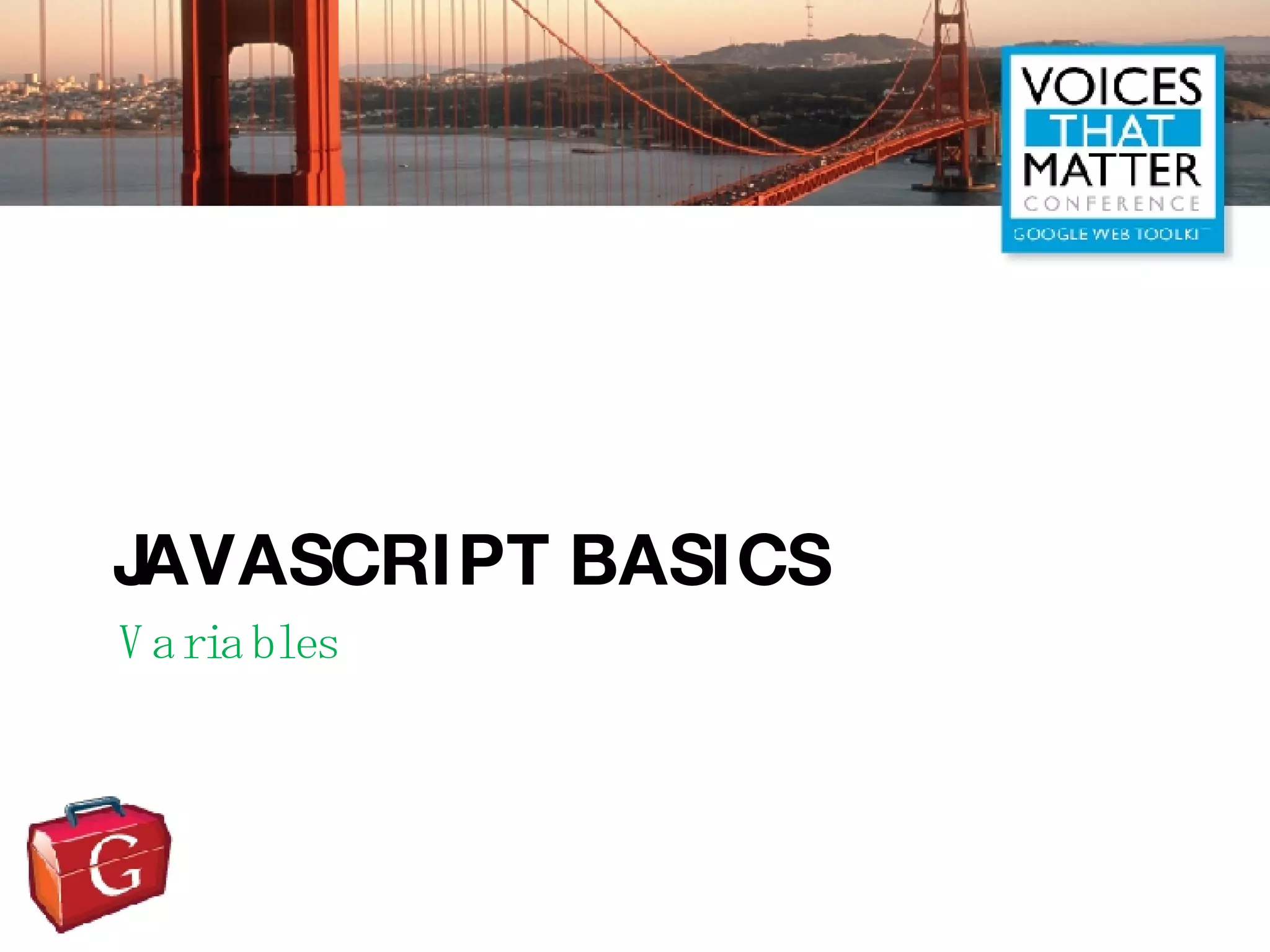
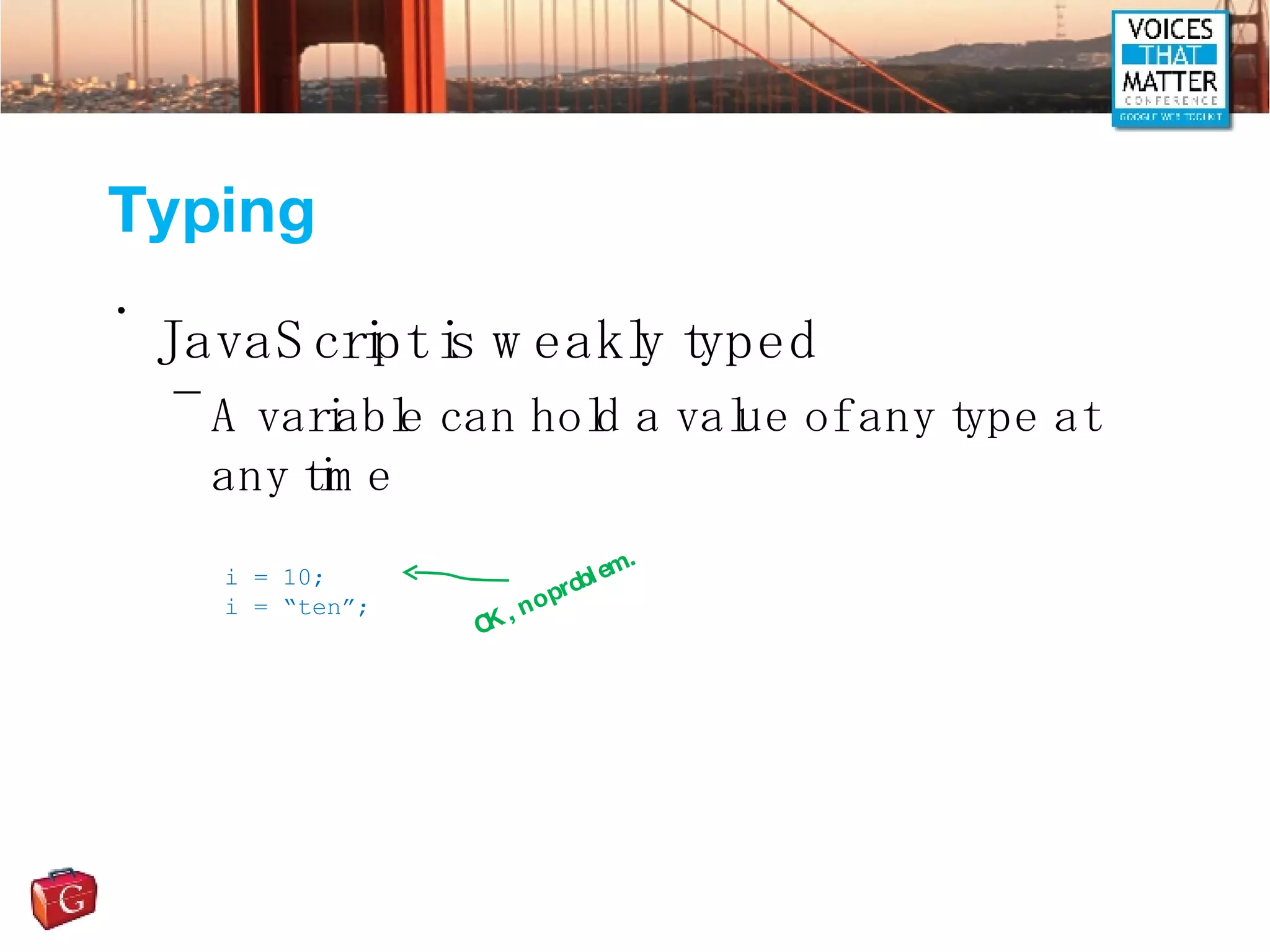
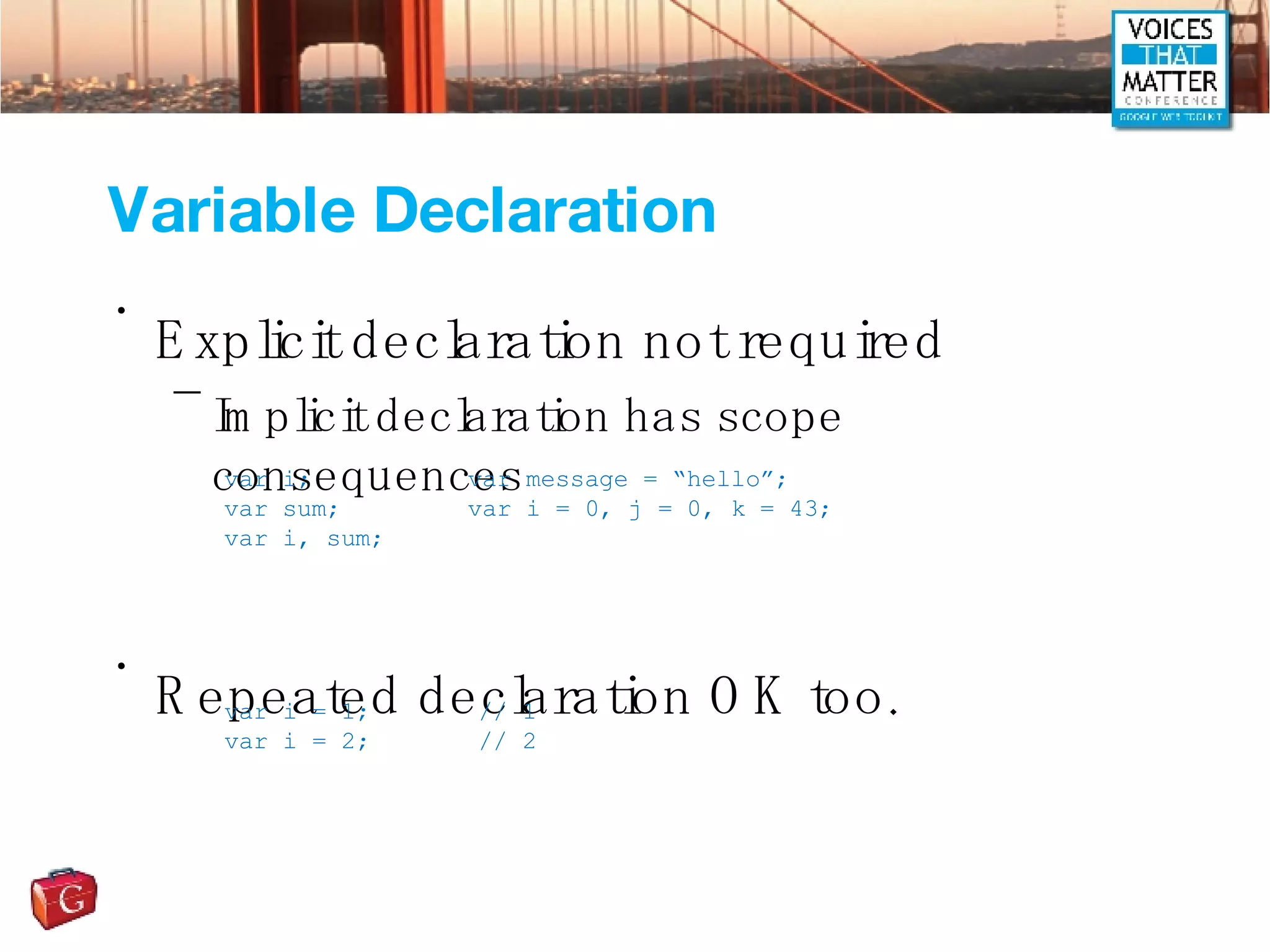
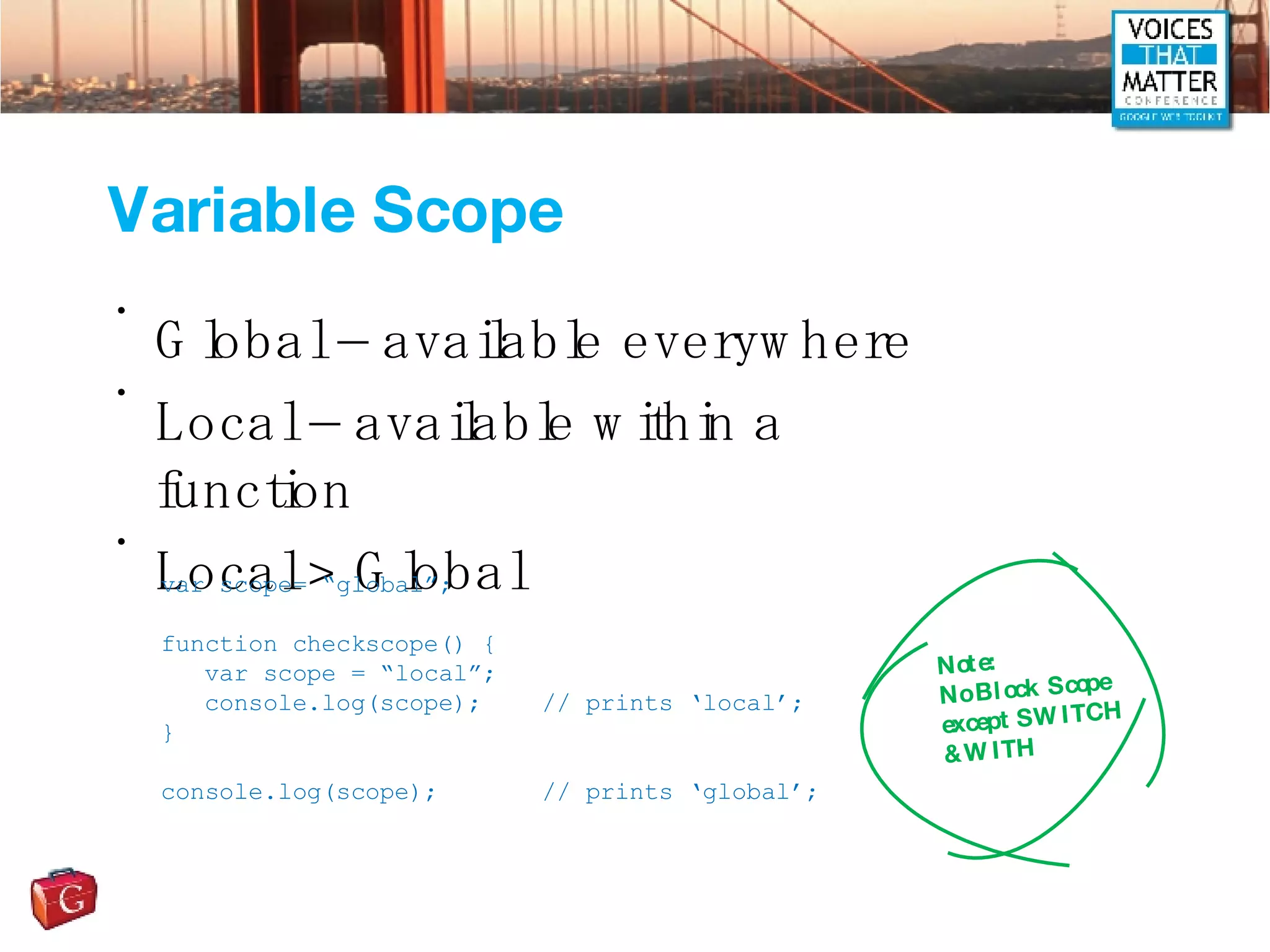
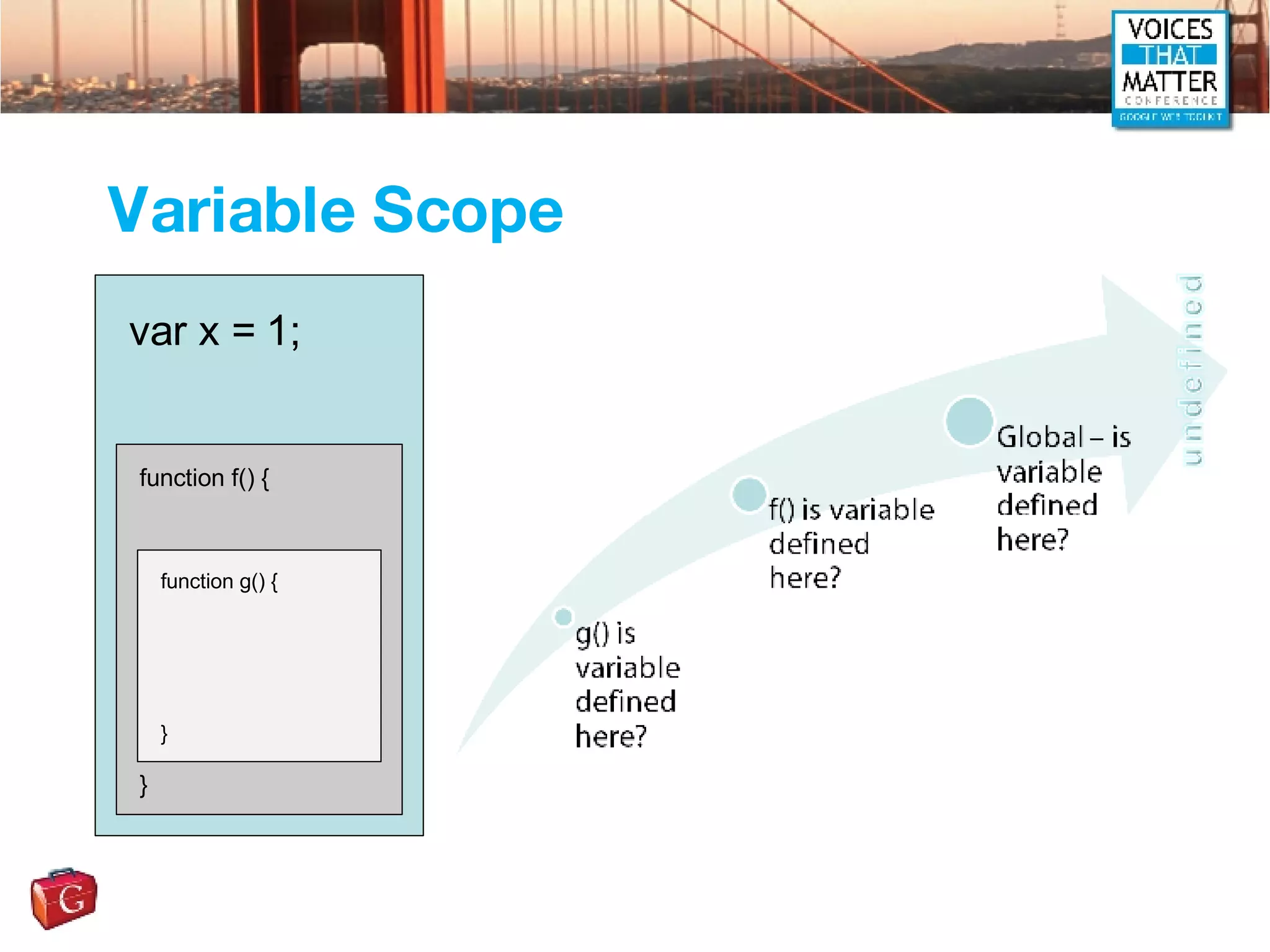
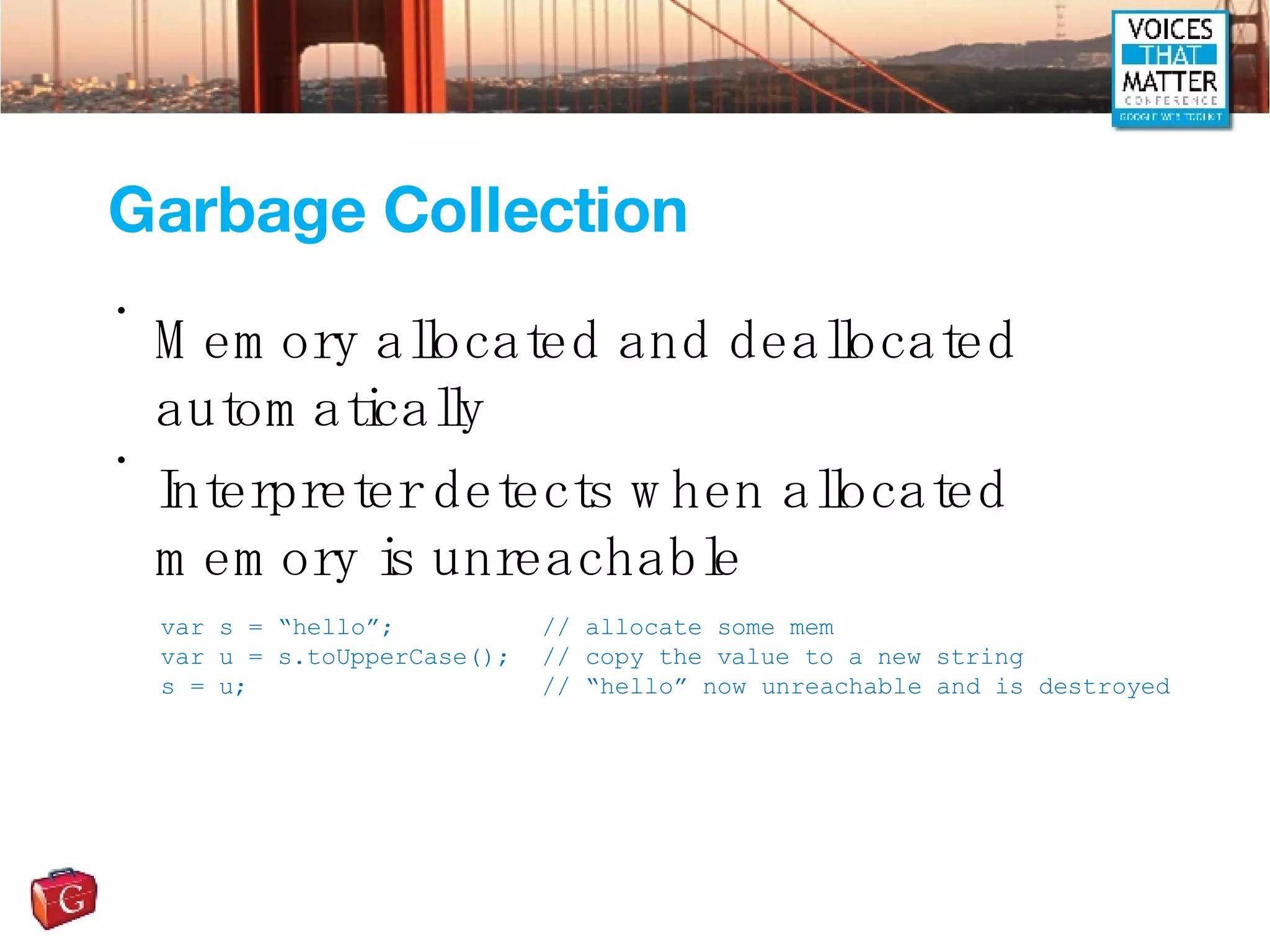
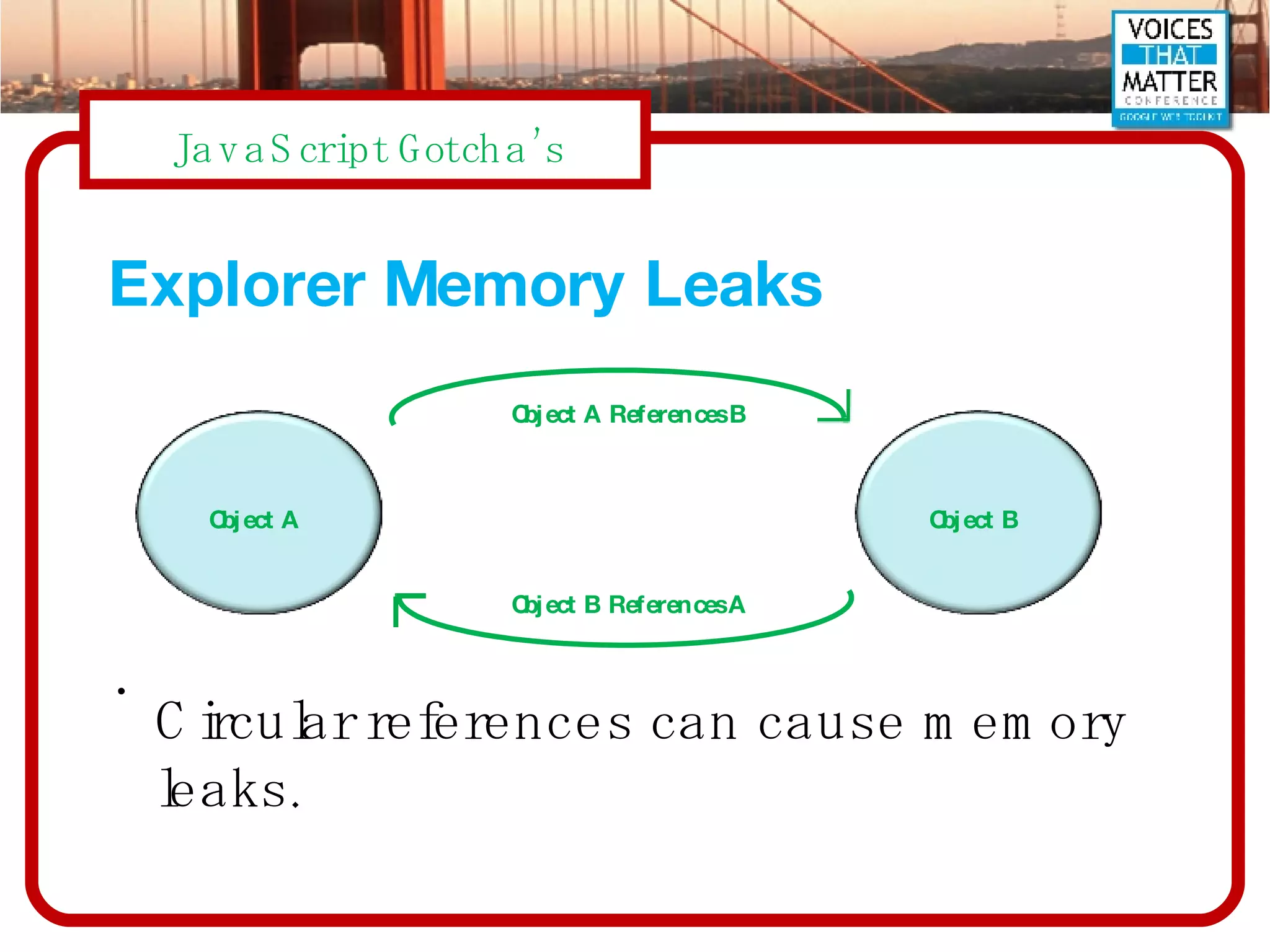
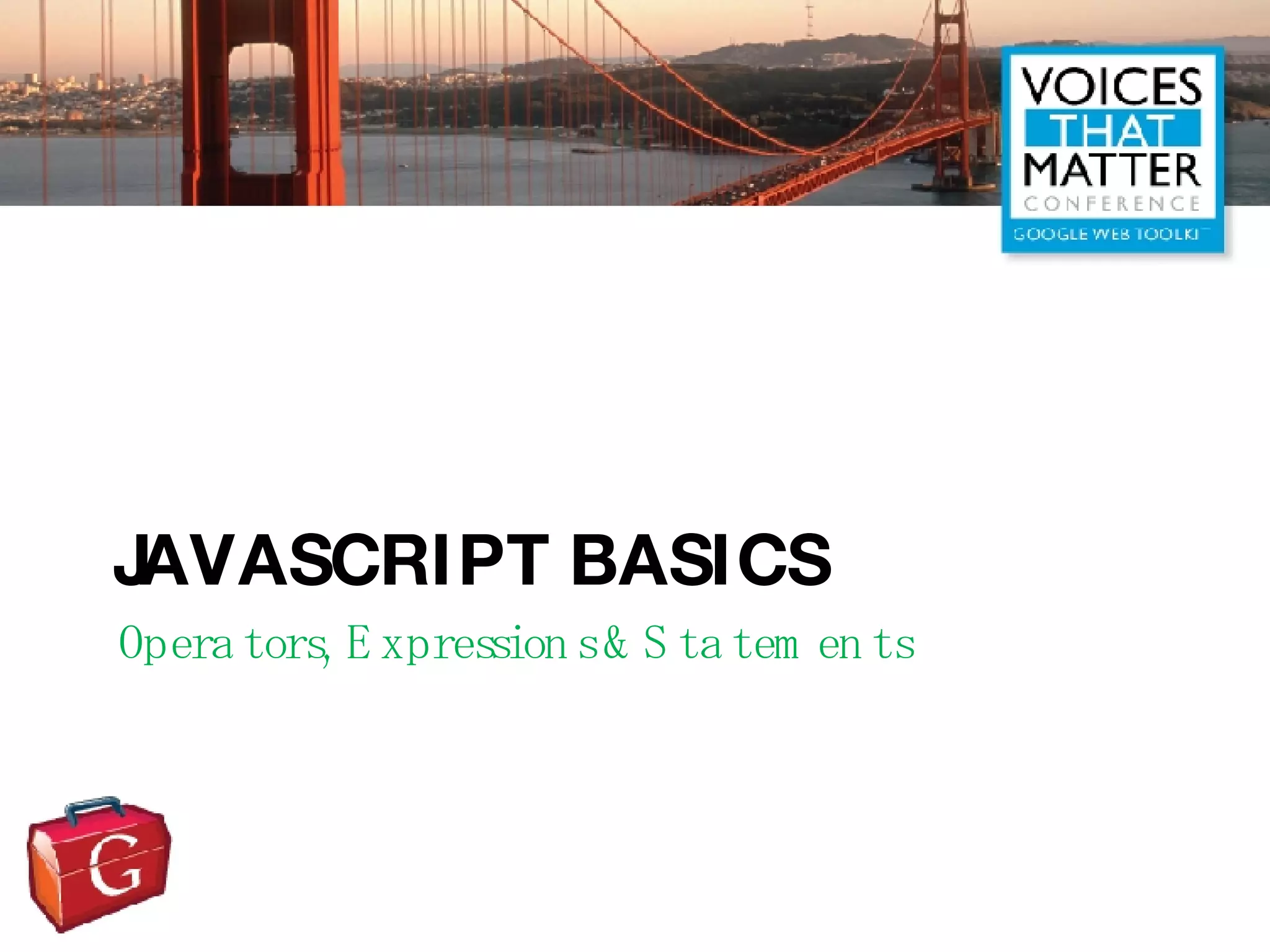
![Operators Operator Operand type(s) Operation performed . Object, identifier Property access [ ] Array, integer Array index ! Boolean Logical complement == Any Equality === Any Identity && Booleans Logical AND || Booleans Logical OR ?: Booleans, any, any Conditional operator , Any Multiple evaluation](https://image.slidesharecdn.com/ajax-and-javascript-bootcamp-1196879148400612-5/75/Ajax-and-JavaScript-Bootcamp-51-2048.jpg)
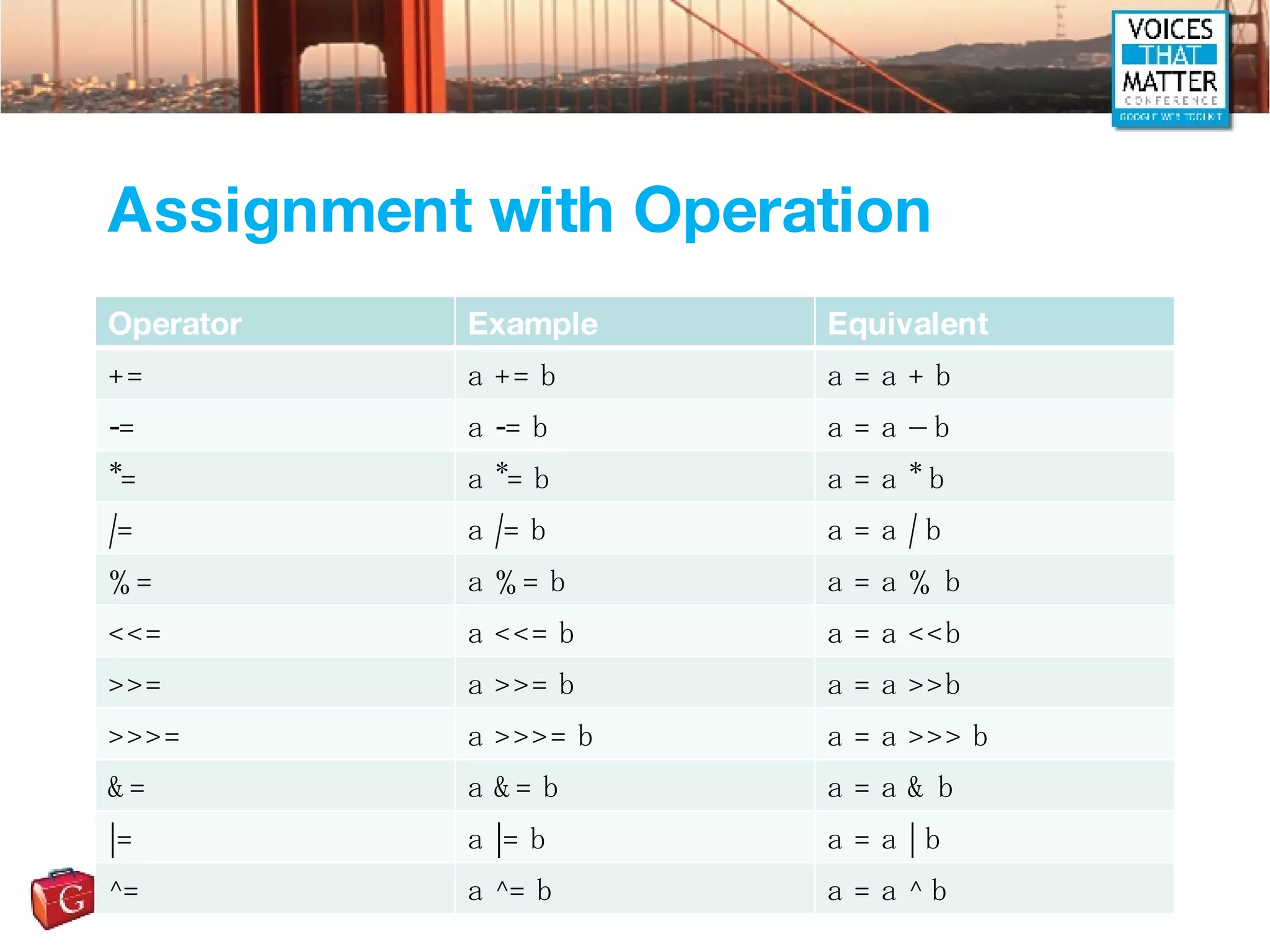
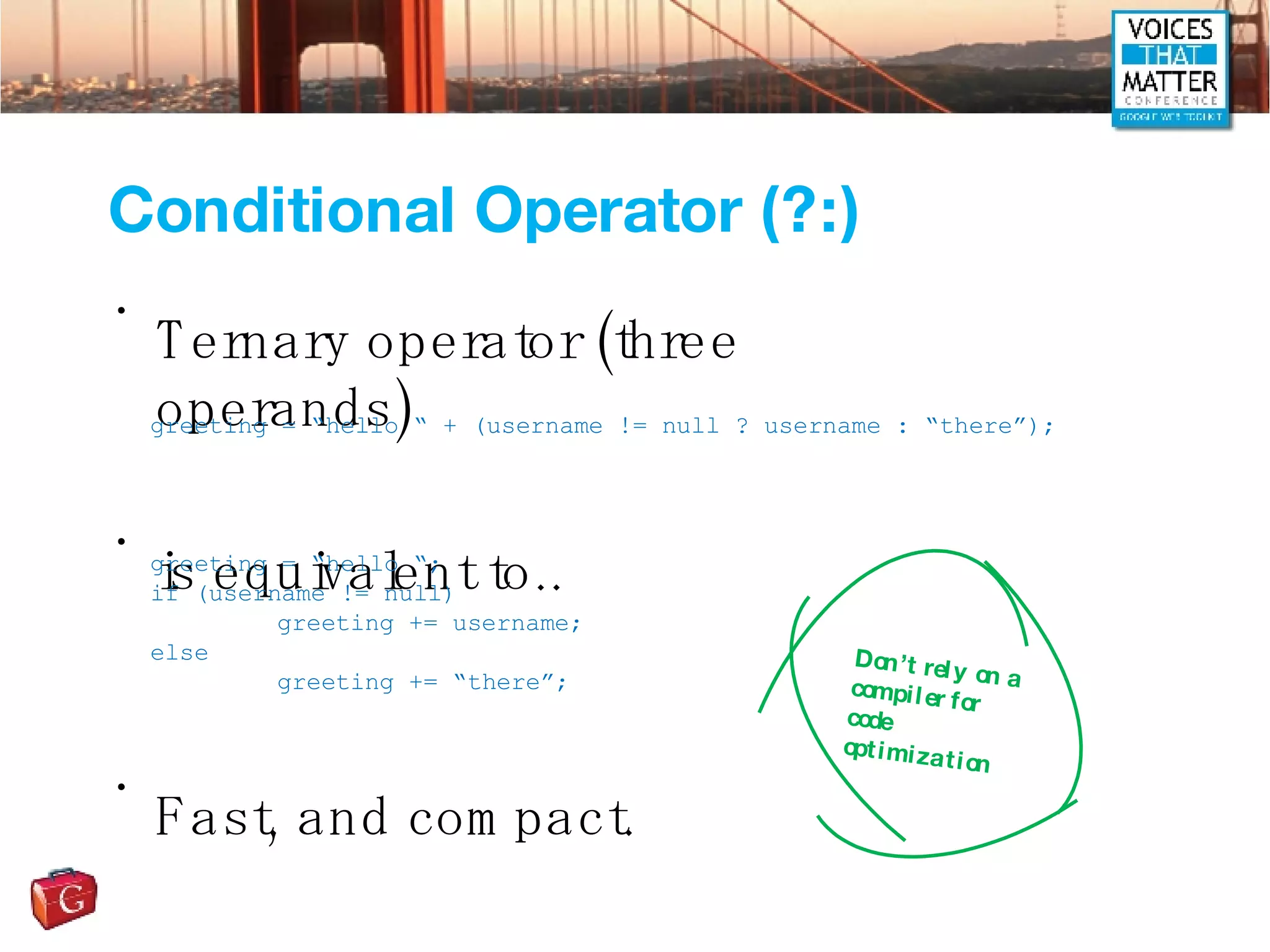
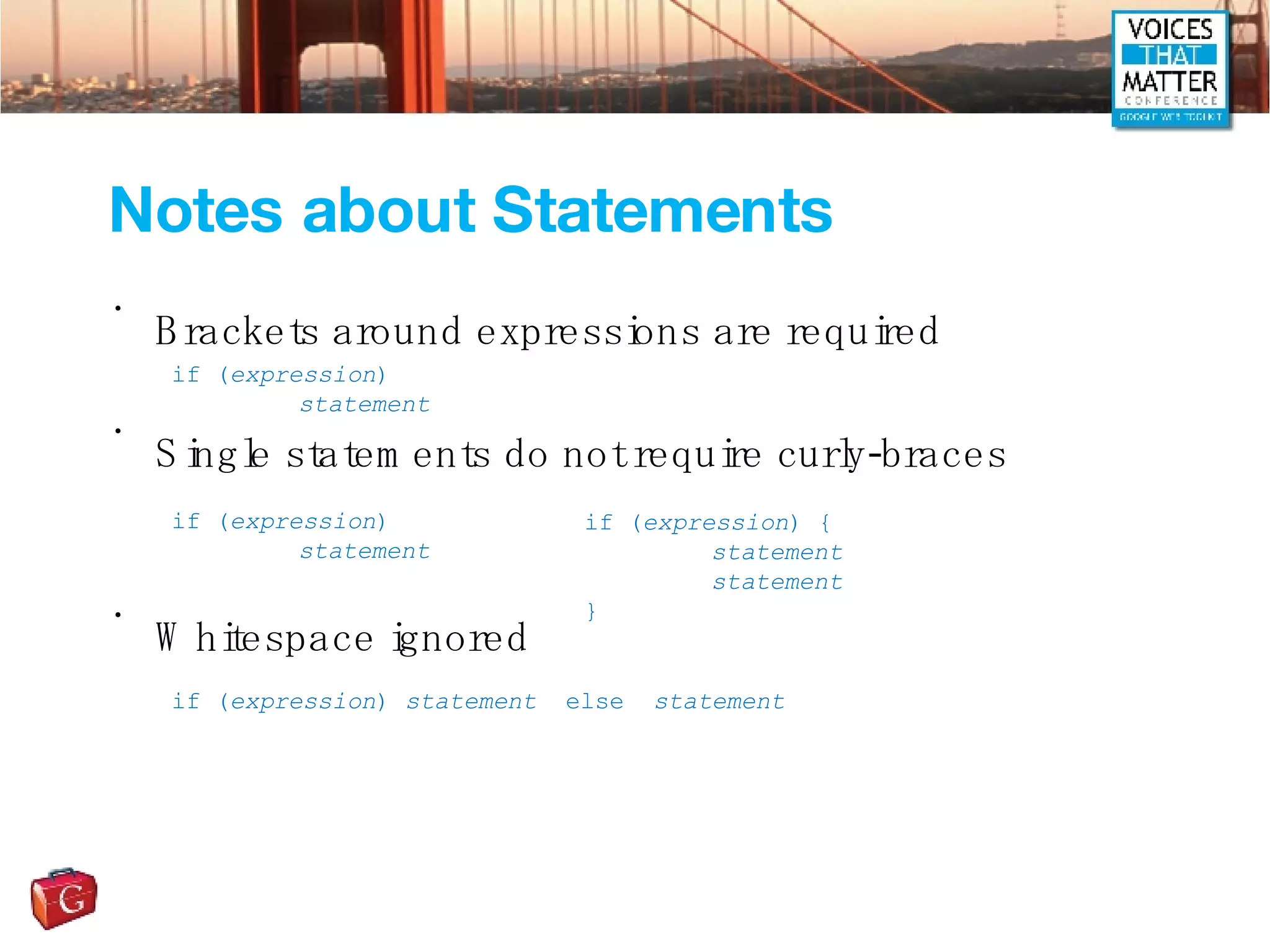
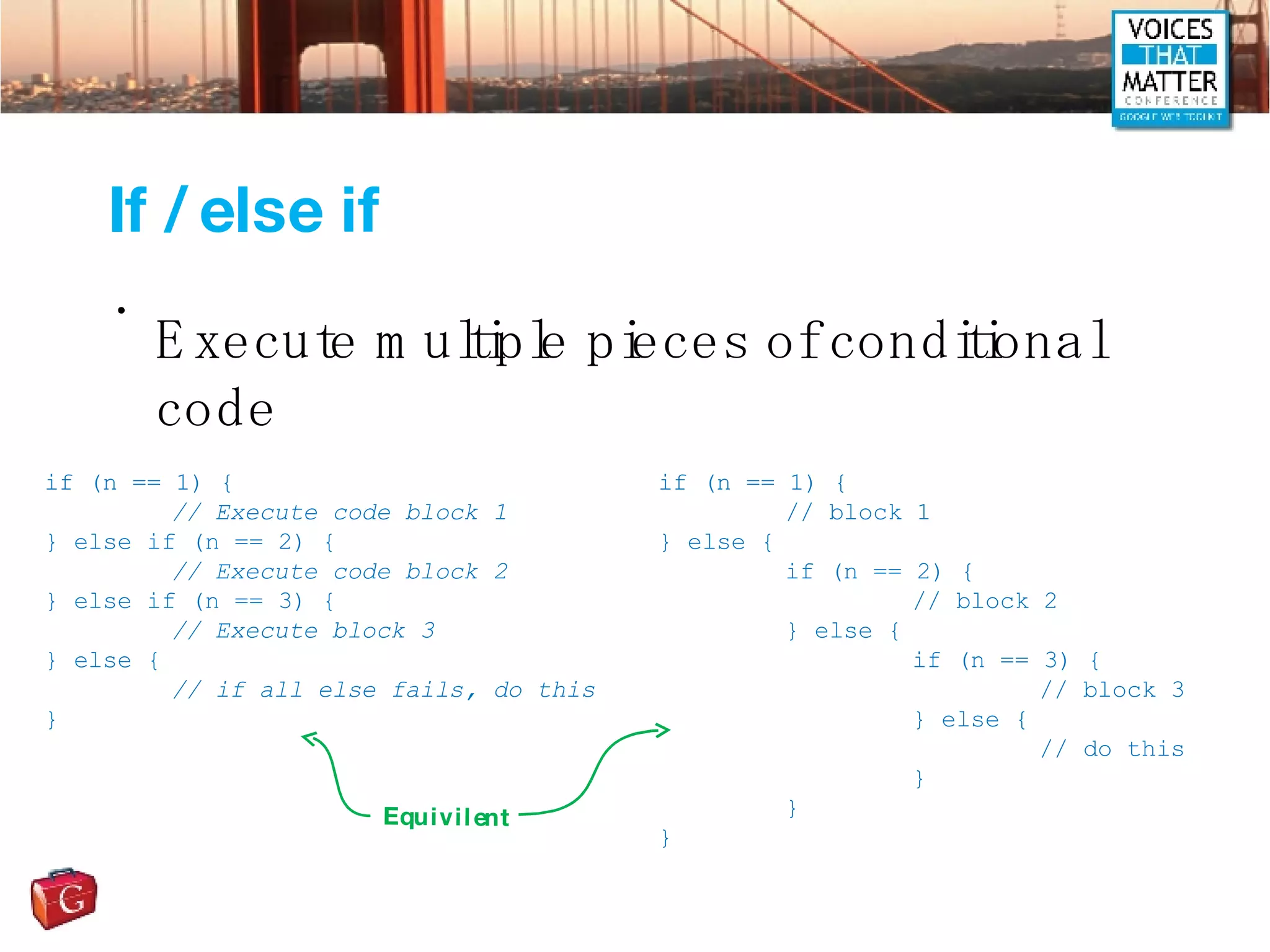
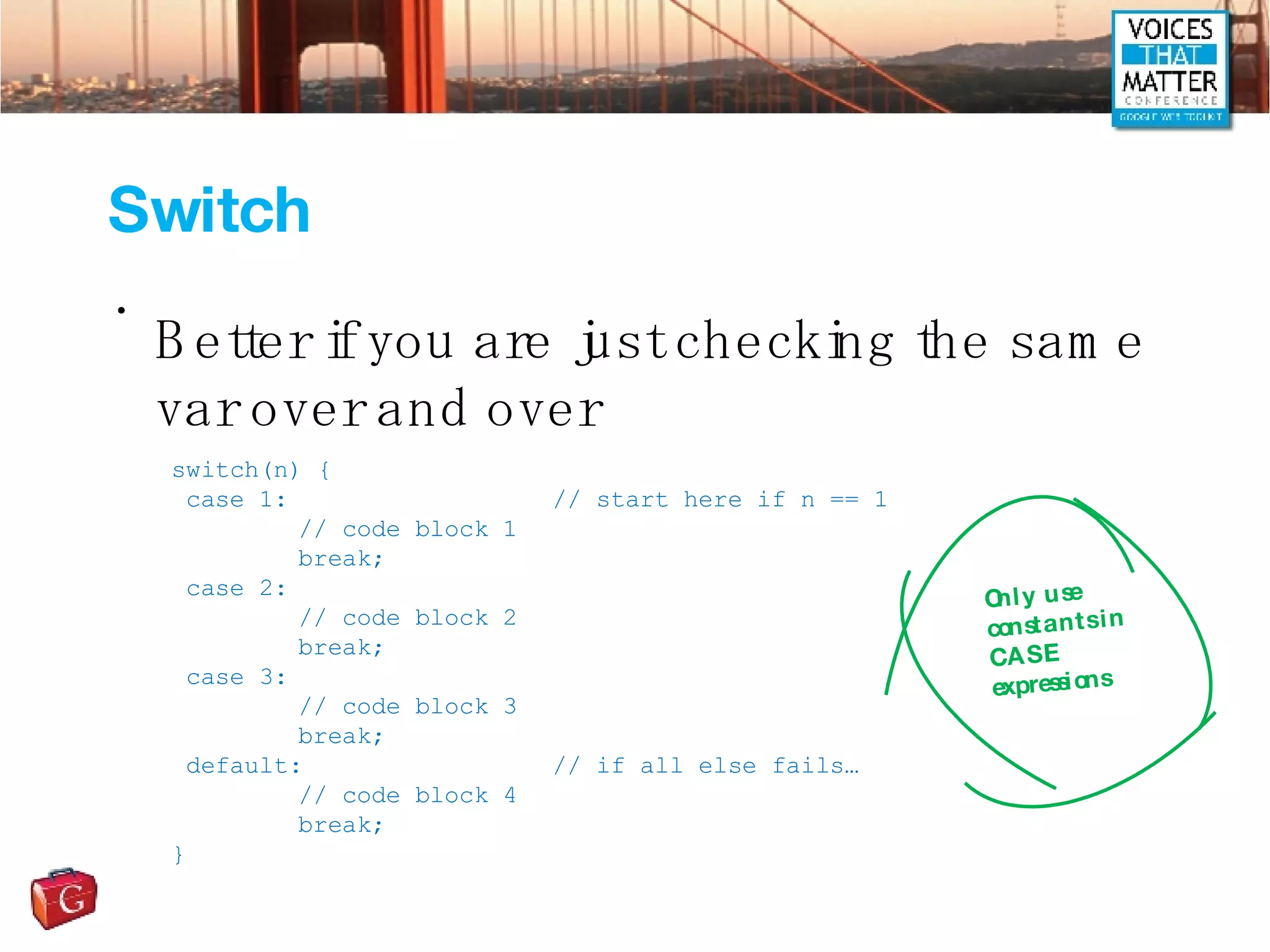
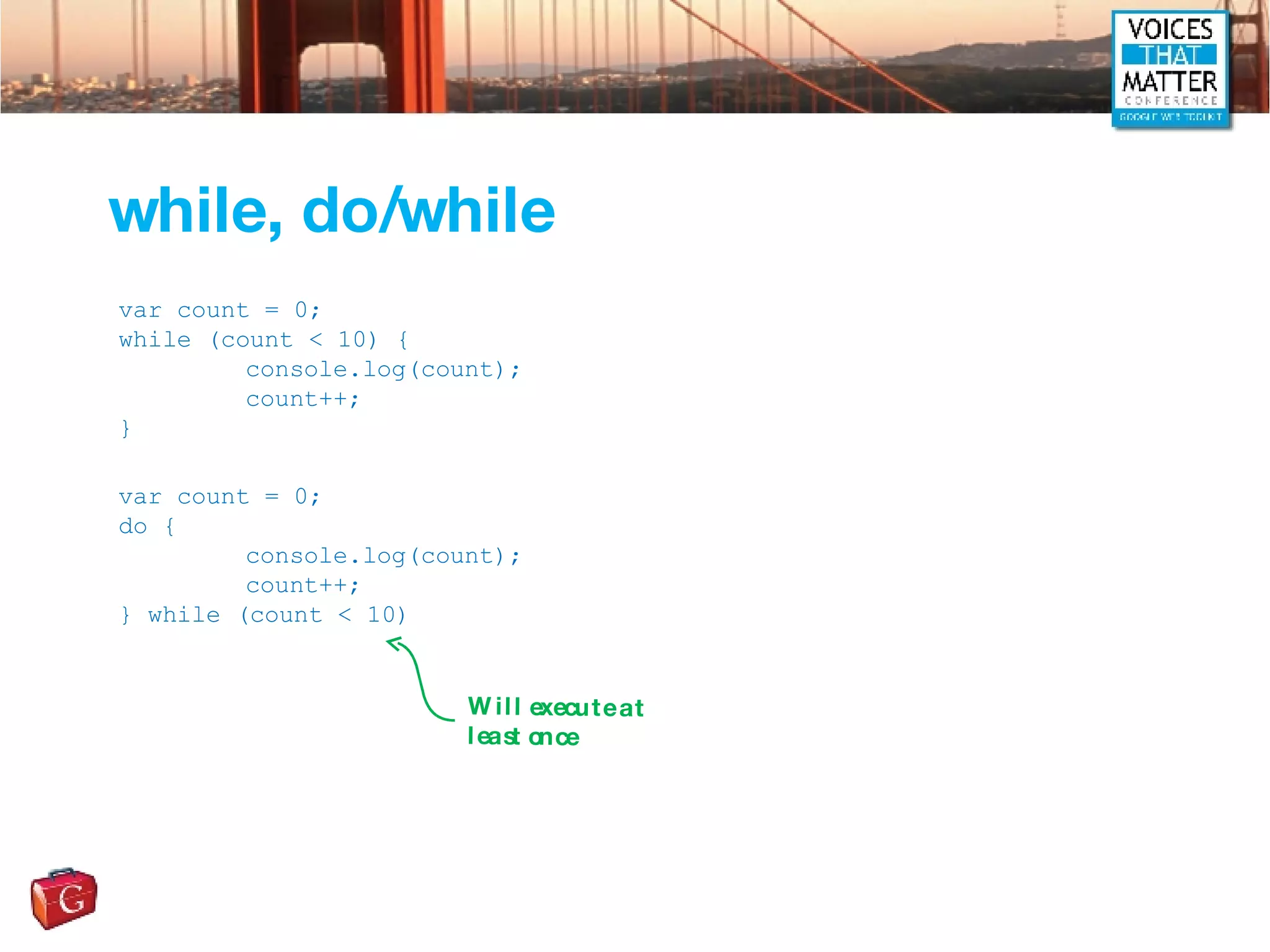
![for for( initialize ; test ; increment ) statement for (var count = 0; count < 10; count++) console.log(count); for( variable in object ) statement var o = {x:1, y:2, z:3} var a = new Array(); var I = 0; for(a[i++] in o) {} Curly braces {} are not required if just one statement Copies the object “o” to the array “a” Not all properties are enumerable!](https://image.slidesharecdn.com/ajax-and-javascript-bootcamp-1196879148400612-5/75/Ajax-and-JavaScript-Bootcamp-58-2048.jpg)
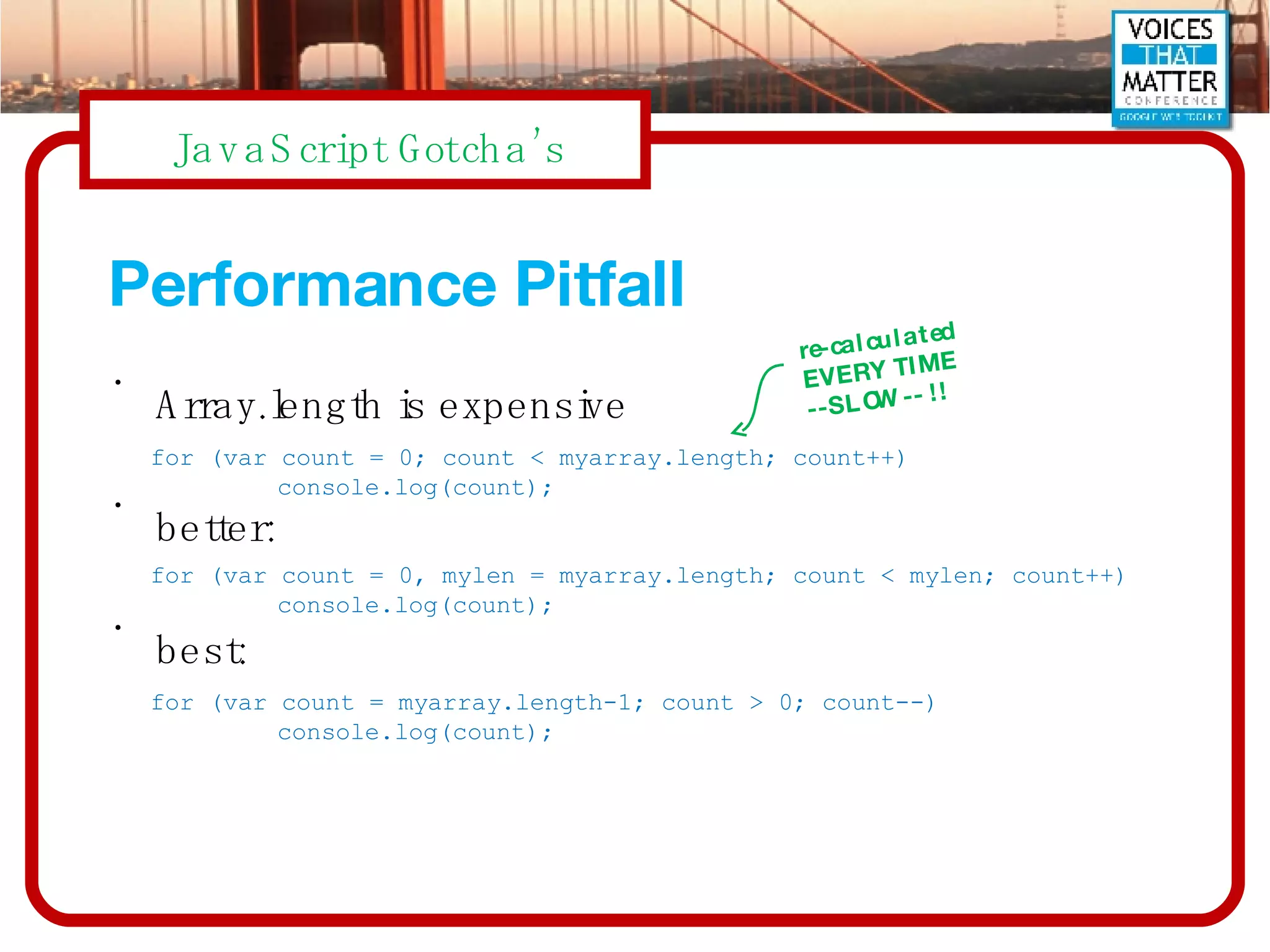
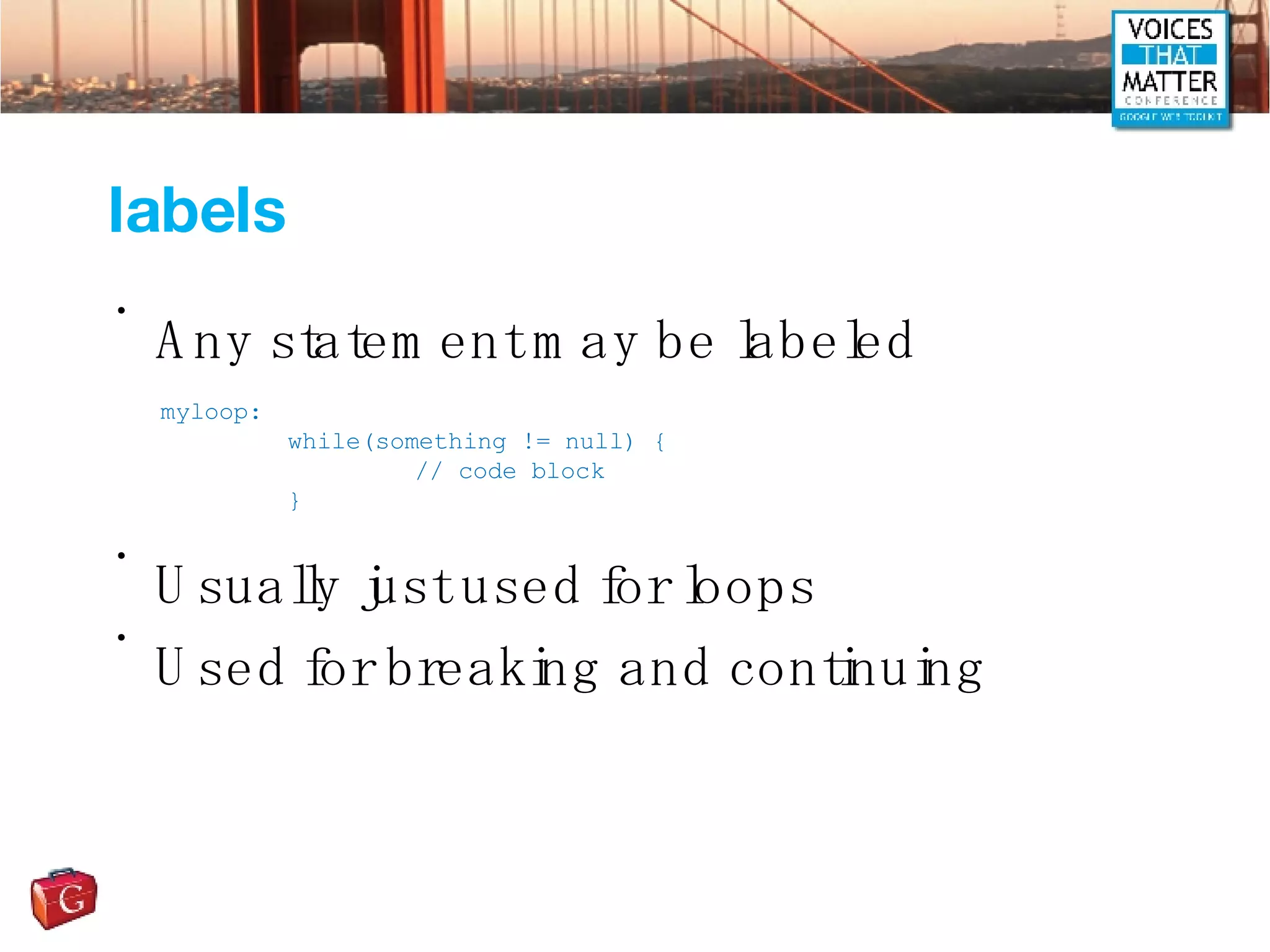
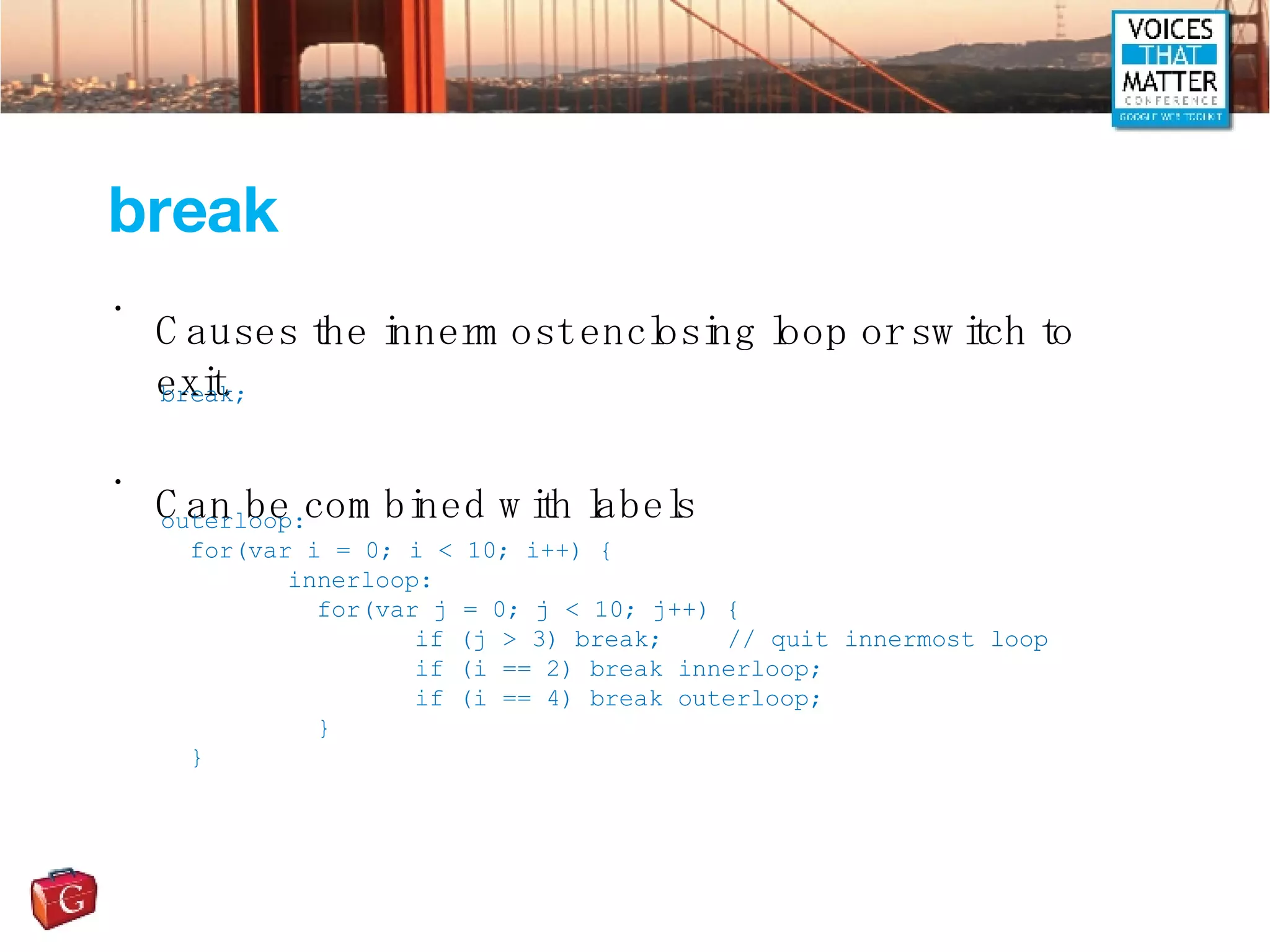
![continue Like break.. but just skips to the next iteration of the current loop Can be used with labels for(i = 0; i < data.length; i++) { if (data[i] == null) continue; total += data[i]; }](https://image.slidesharecdn.com/ajax-and-javascript-bootcamp-1196879148400612-5/75/Ajax-and-JavaScript-Bootcamp-62-2048.jpg)
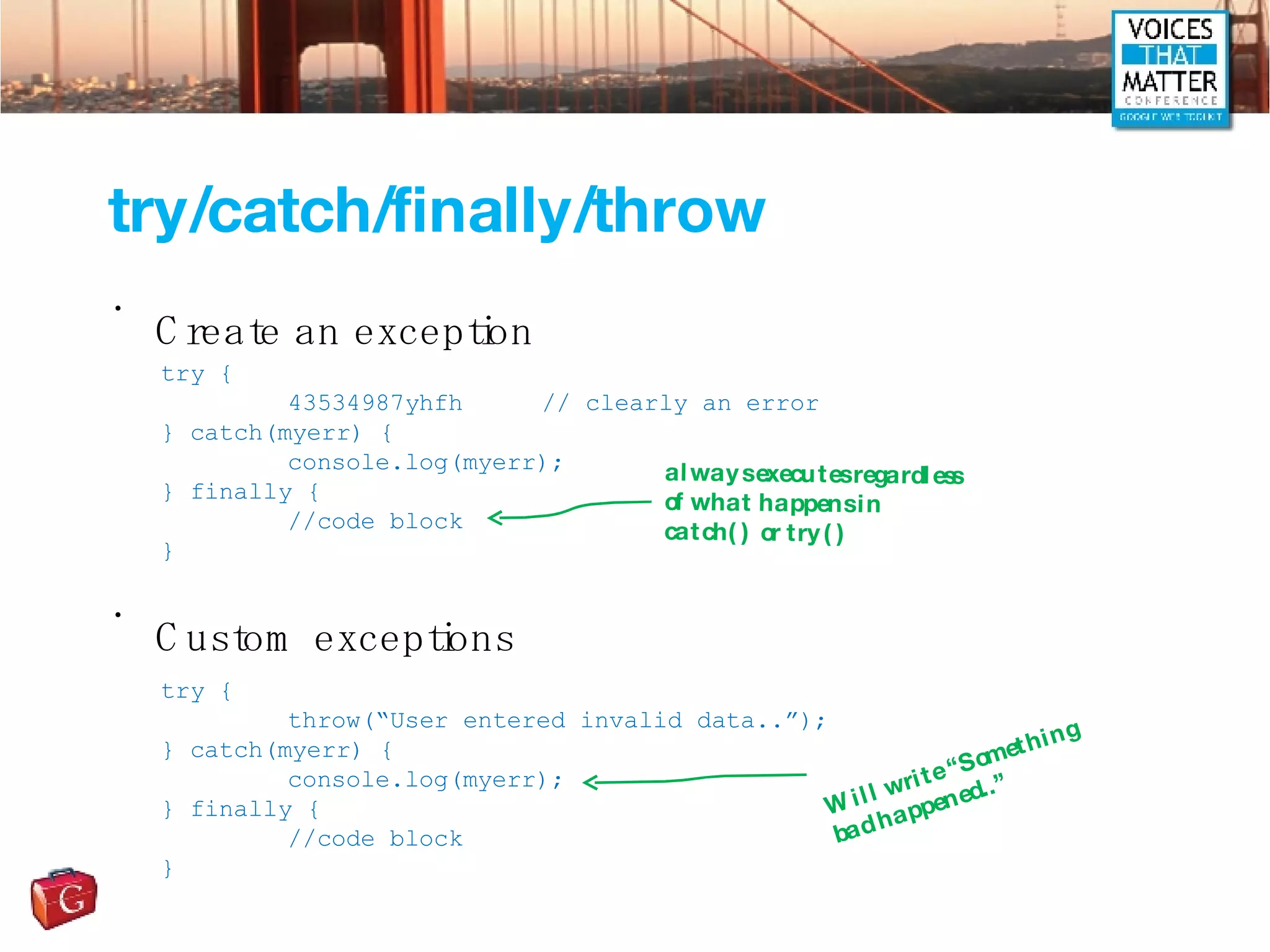
![with Code block that modifies the scope chain Generally avoided. slow some unexpected behaviors (with init’d vars) with(frames[1].document.forms[0]) { // access form elements directly here. eg: name.value = “something”; address.value = “someplace”; email.value = “me@home.com”; }](https://image.slidesharecdn.com/ajax-and-javascript-bootcamp-1196879148400612-5/75/Ajax-and-JavaScript-Bootcamp-64-2048.jpg)
![; (empty) Has no effect.. but can be useful. var o = {x:1, y:2, z:3} var a = new Array(); var I = 0; for(a[i++] in o) ;](https://image.slidesharecdn.com/ajax-and-javascript-bootcamp-1196879148400612-5/75/Ajax-and-JavaScript-Bootcamp-65-2048.jpg)

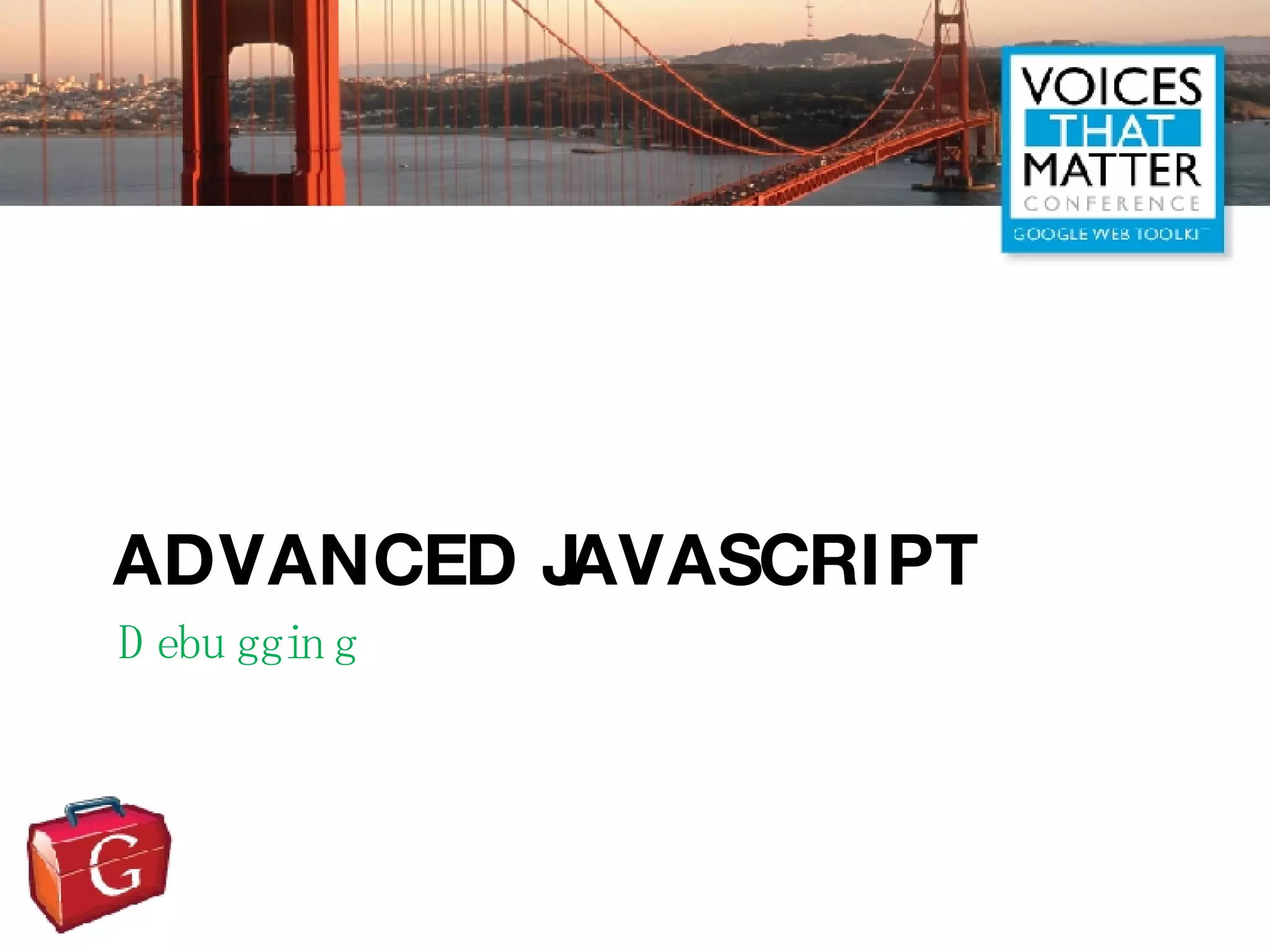
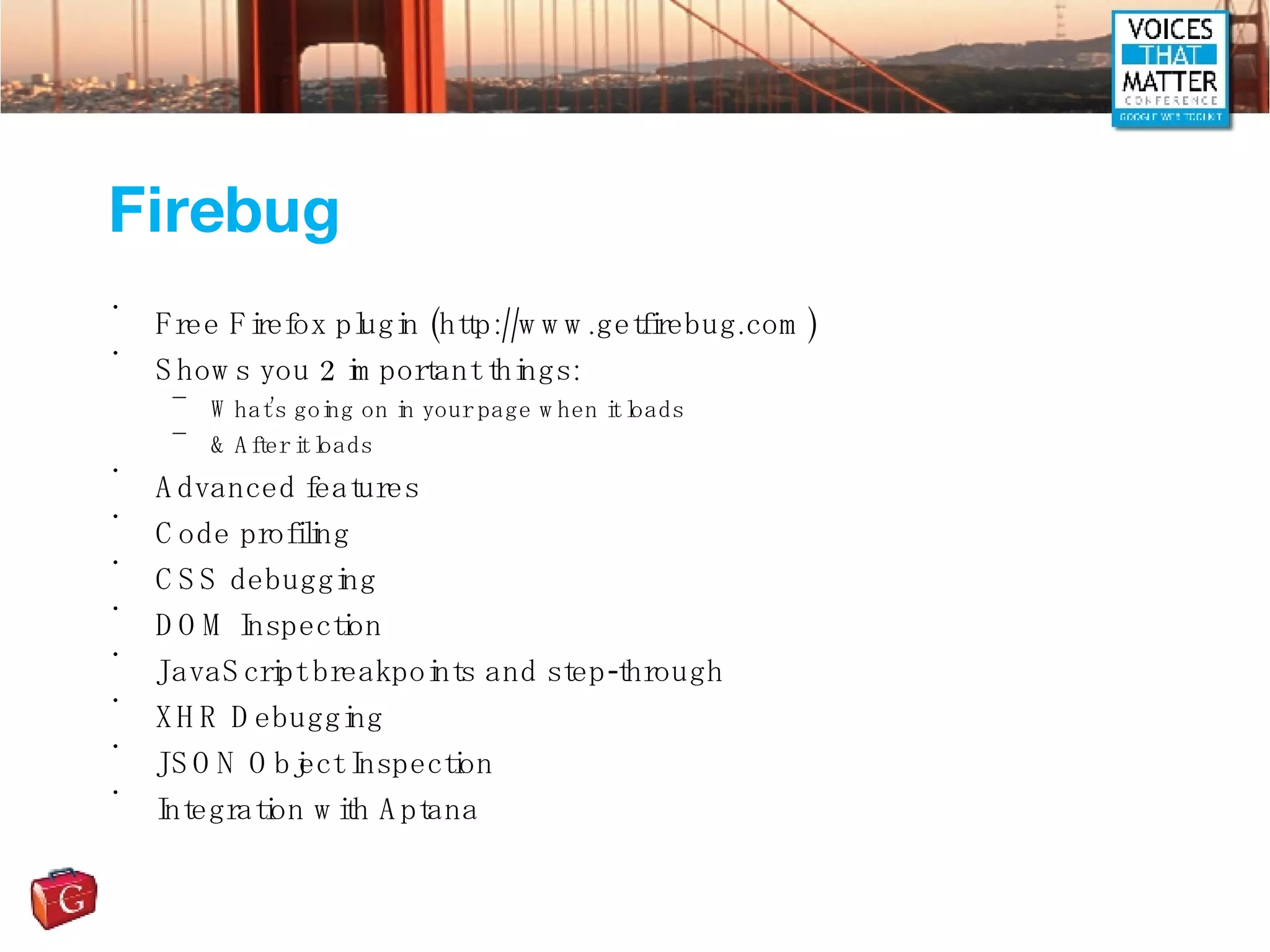
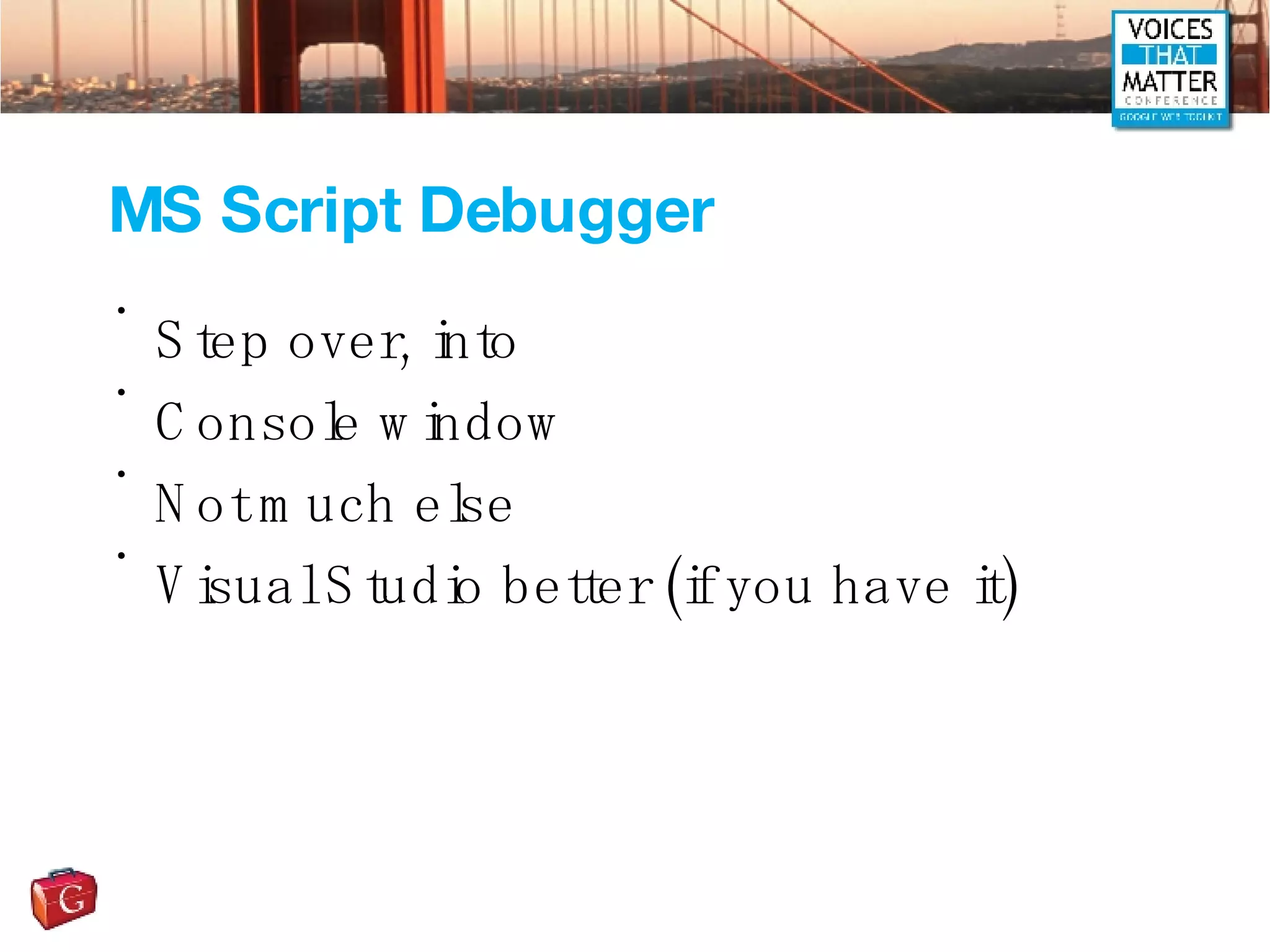
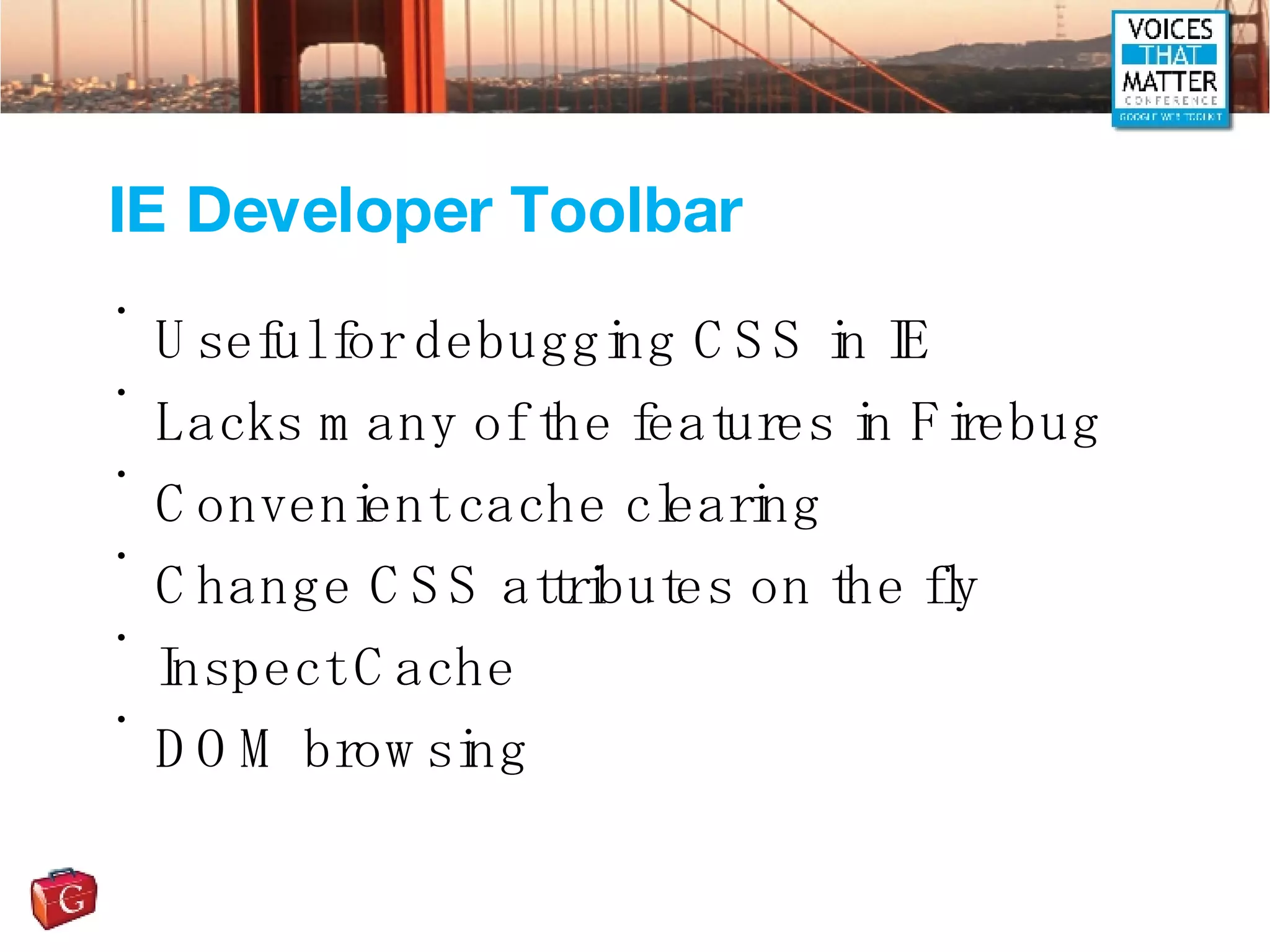
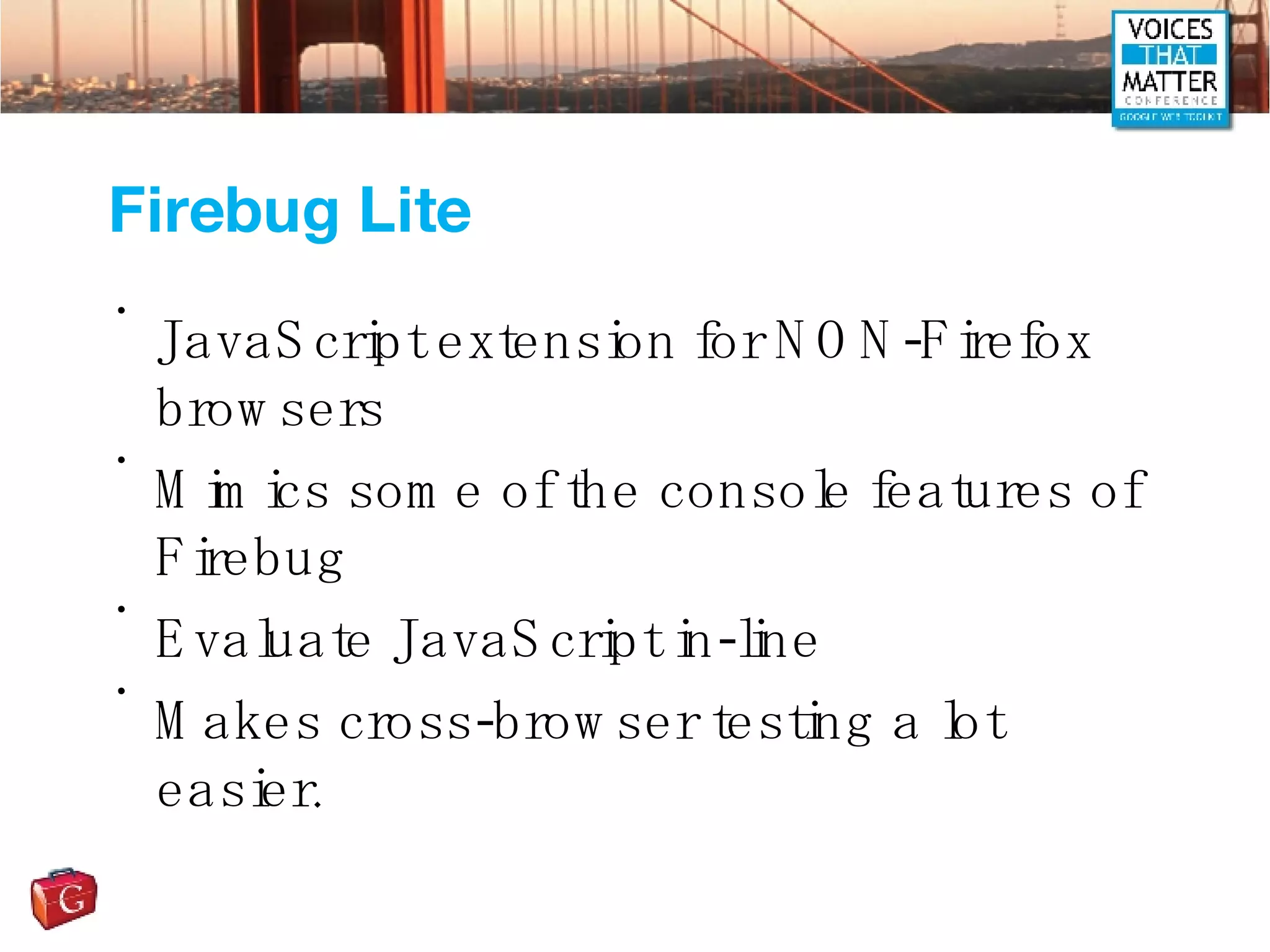
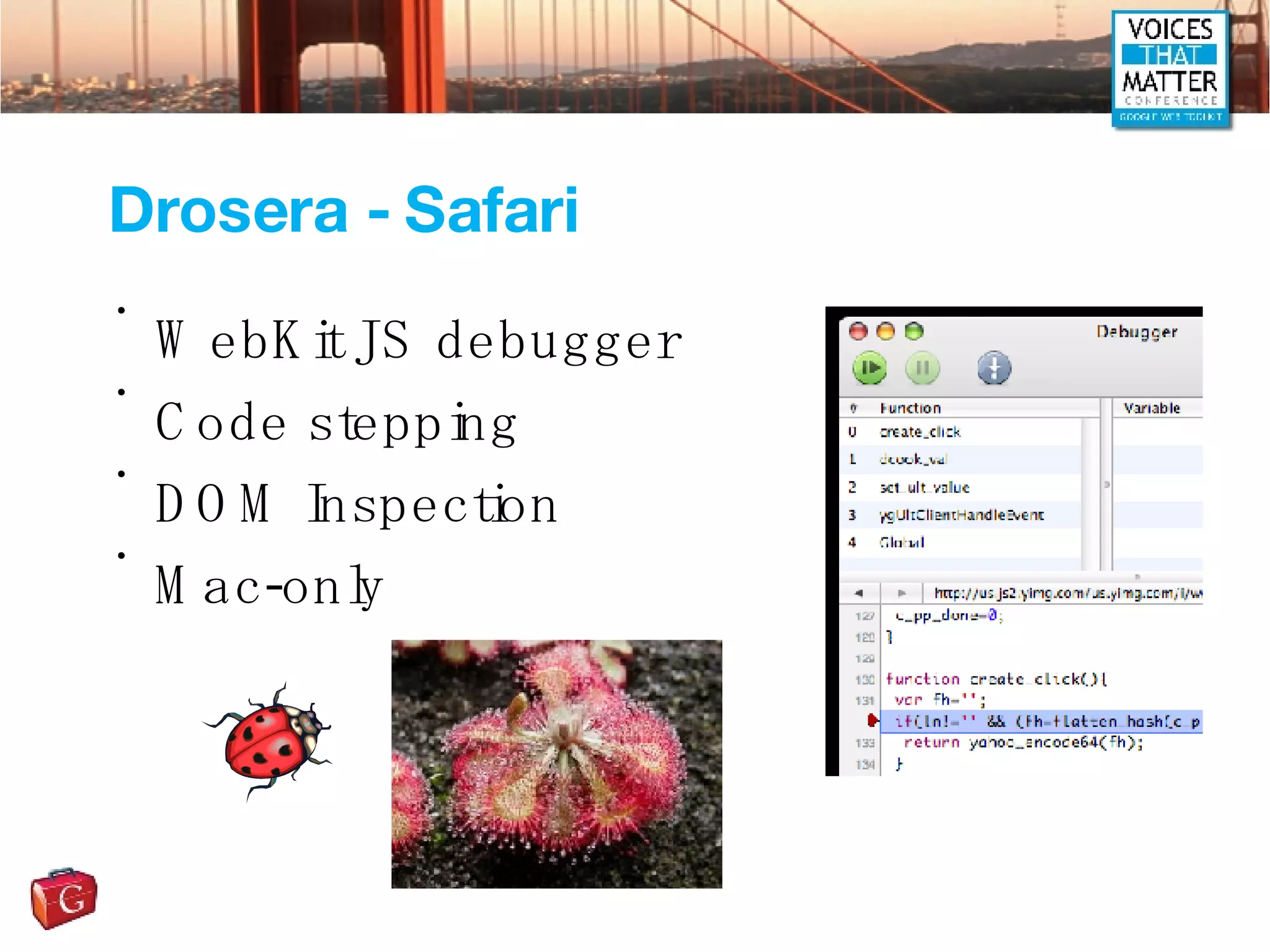
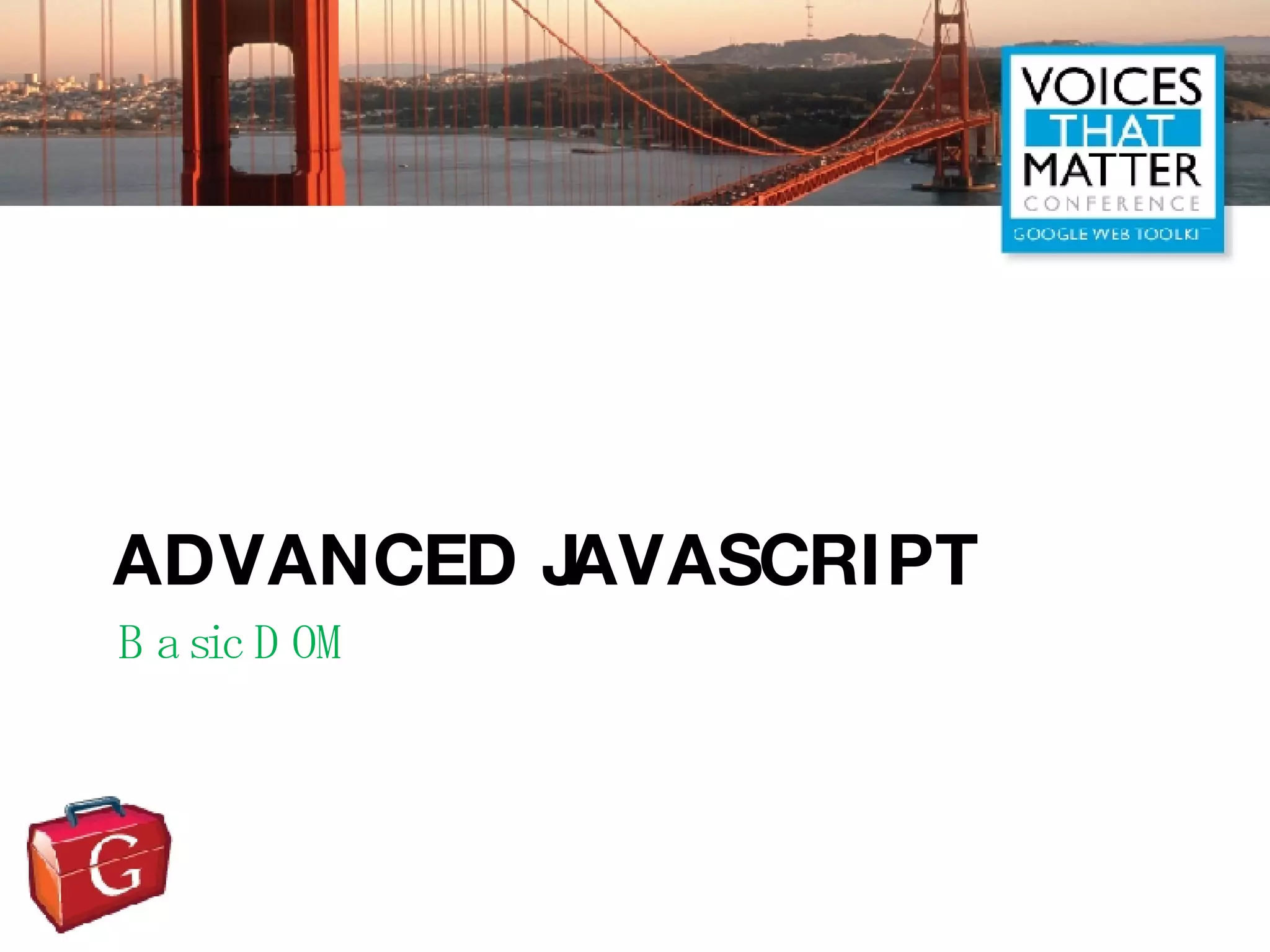
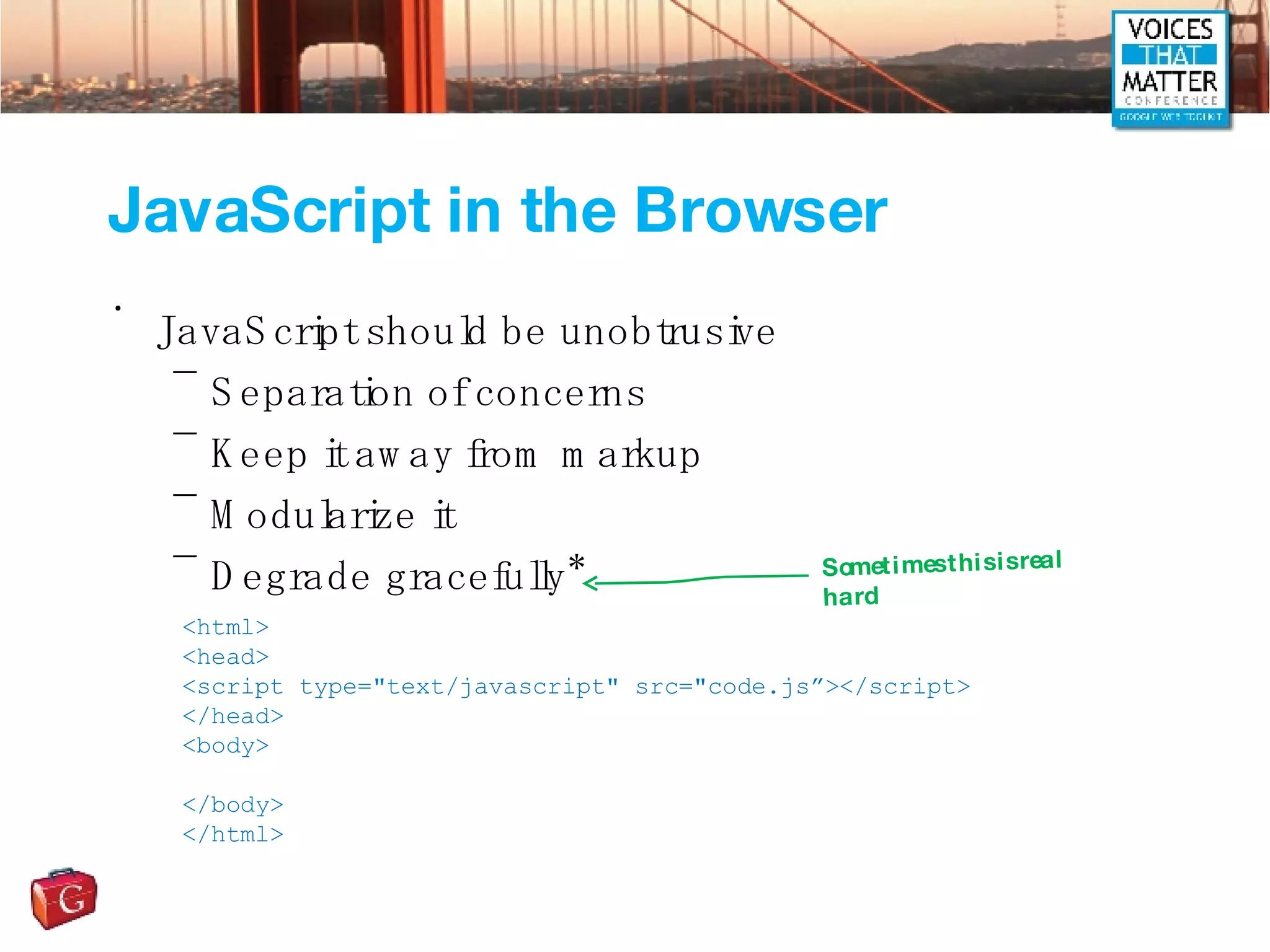
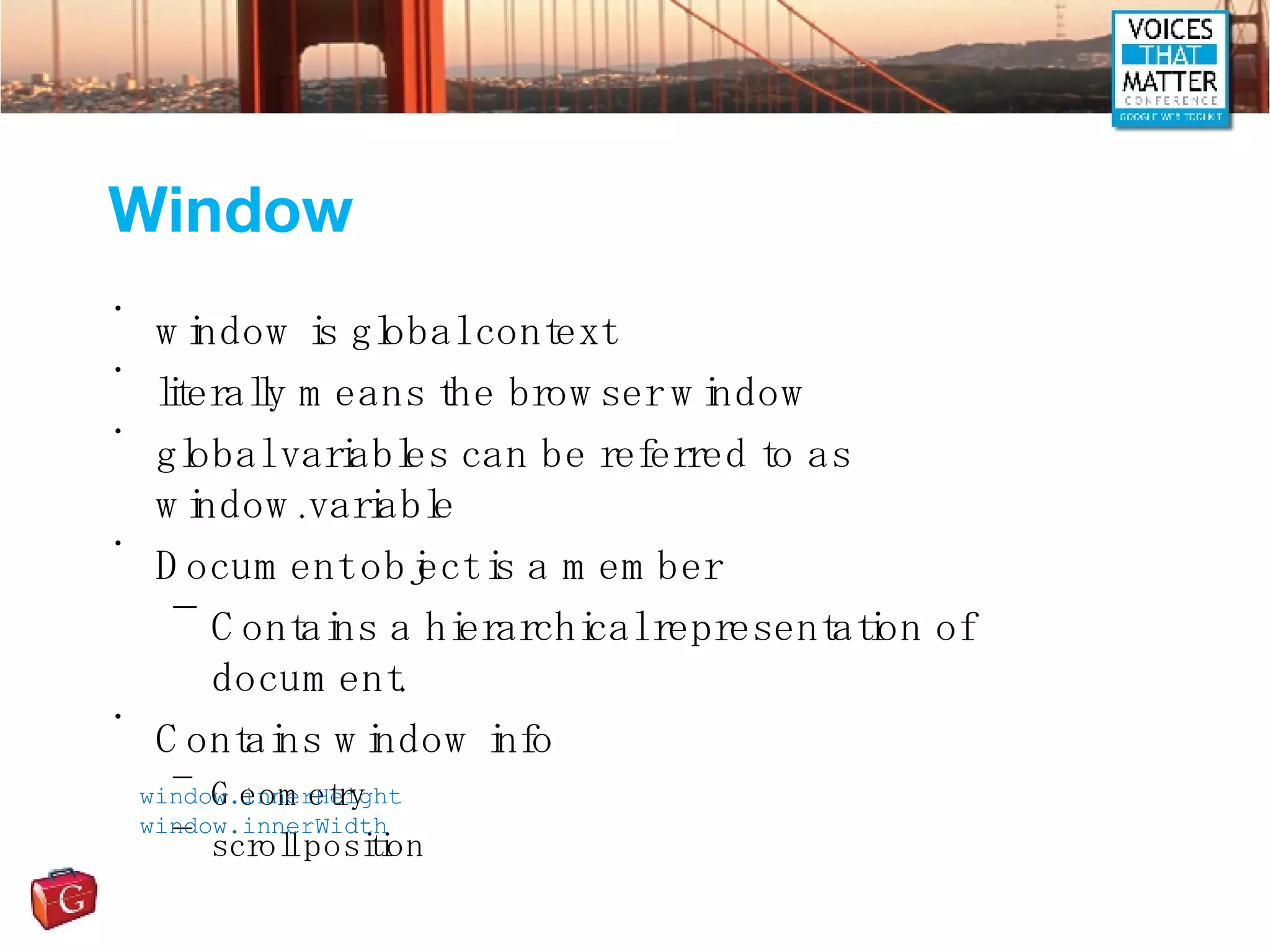
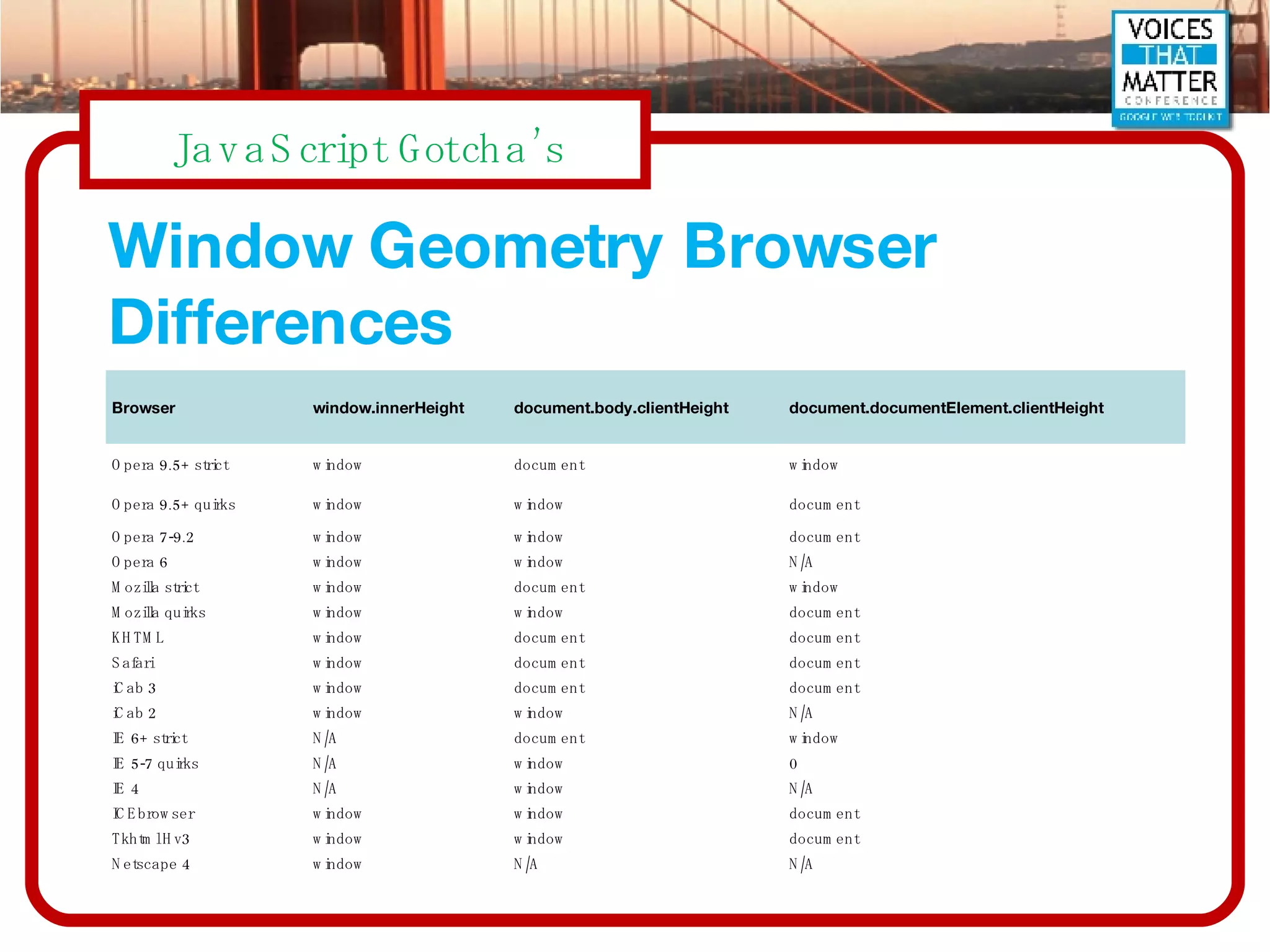
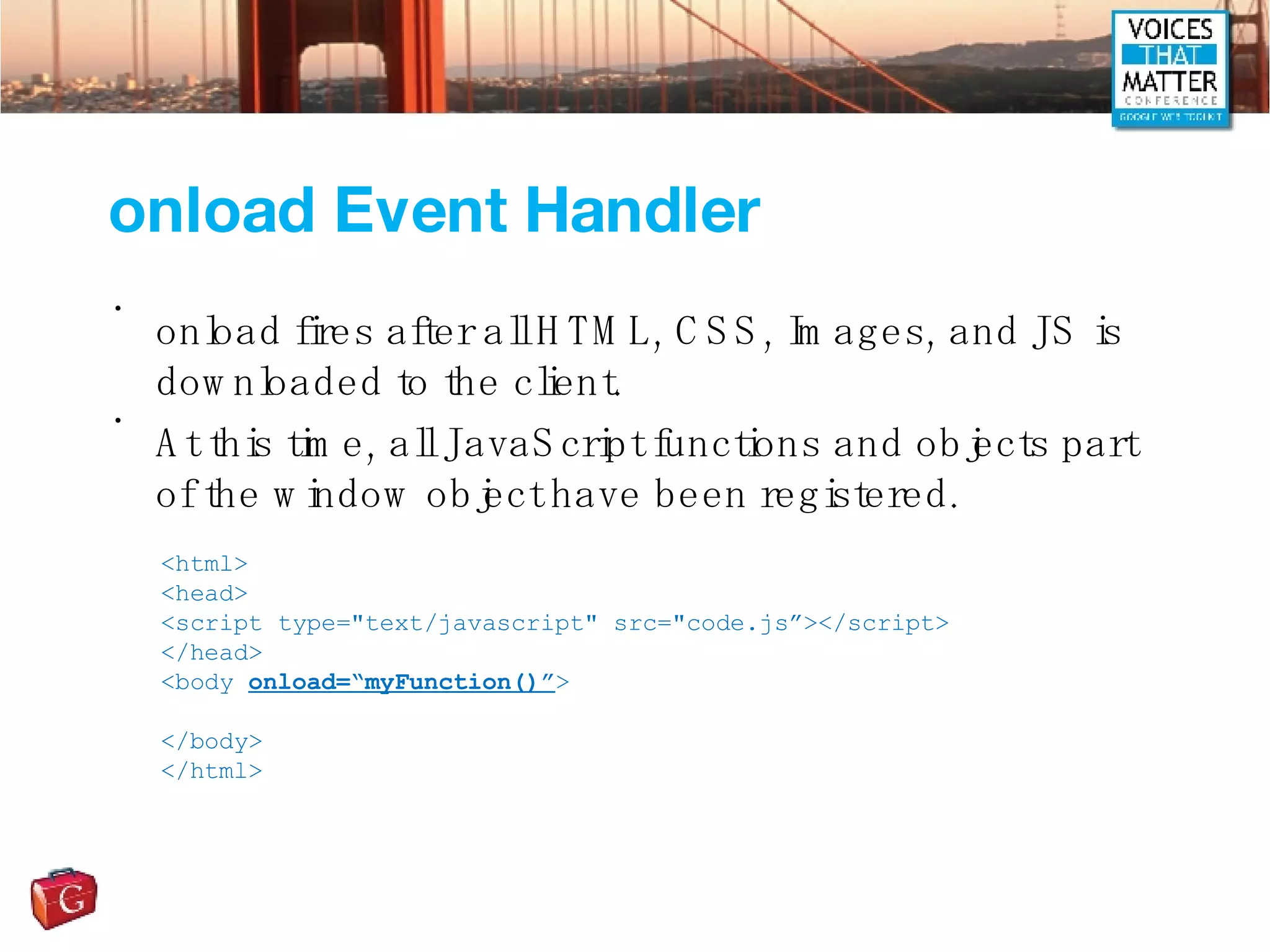
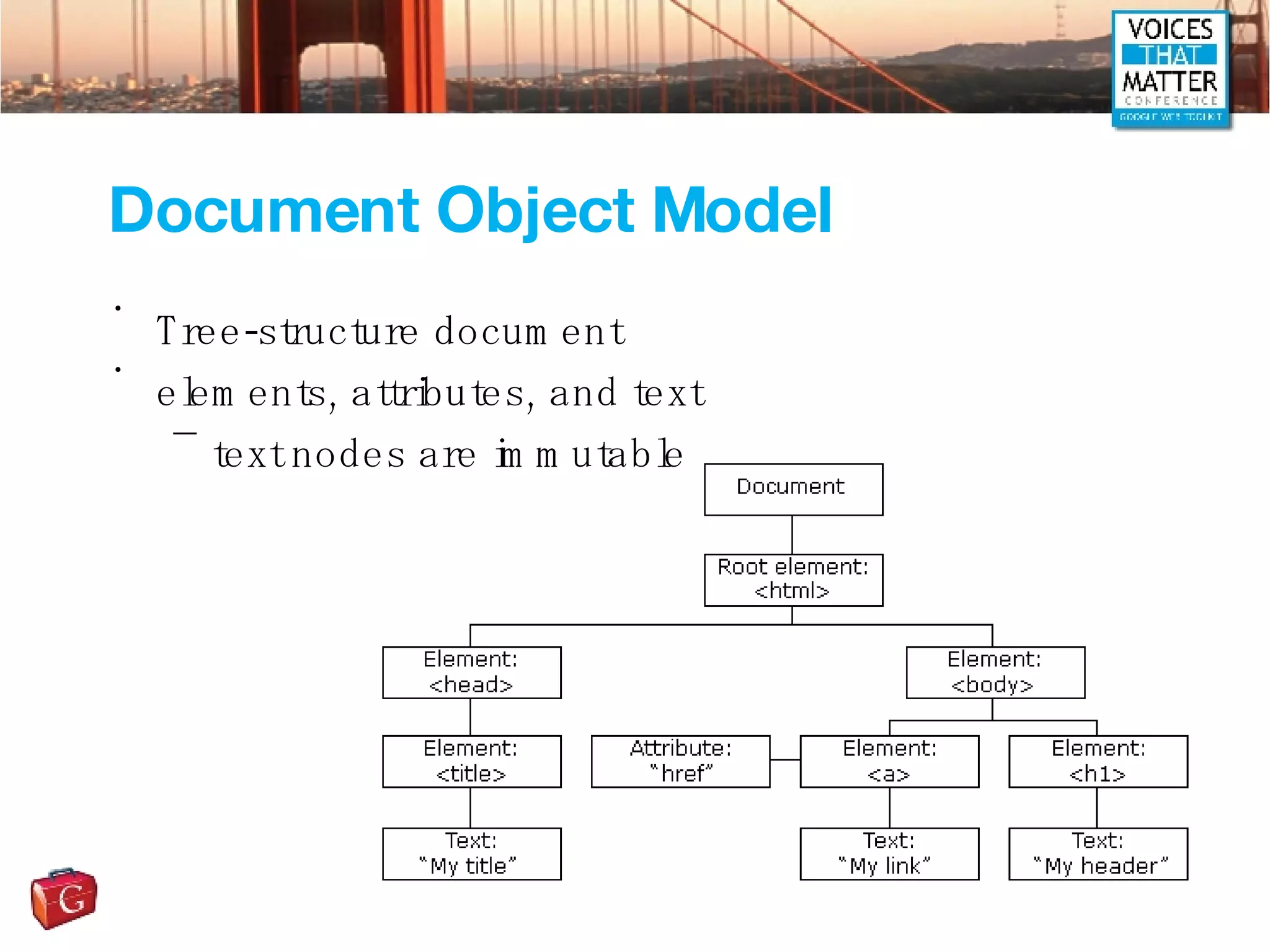
![Form Objects, fields, etc Forms are held in a collection Elements accessible as an array or an object var myForm = document.forms["customerForm"]; myForm = document.customerForm; for (var i = 0, j = myForm.length; i < j; i++) console.log(myForm[i].value); console.log(myForm.myname.value);](https://image.slidesharecdn.com/ajax-and-javascript-bootcamp-1196879148400612-5/75/Ajax-and-JavaScript-Bootcamp-79-2048.jpg)
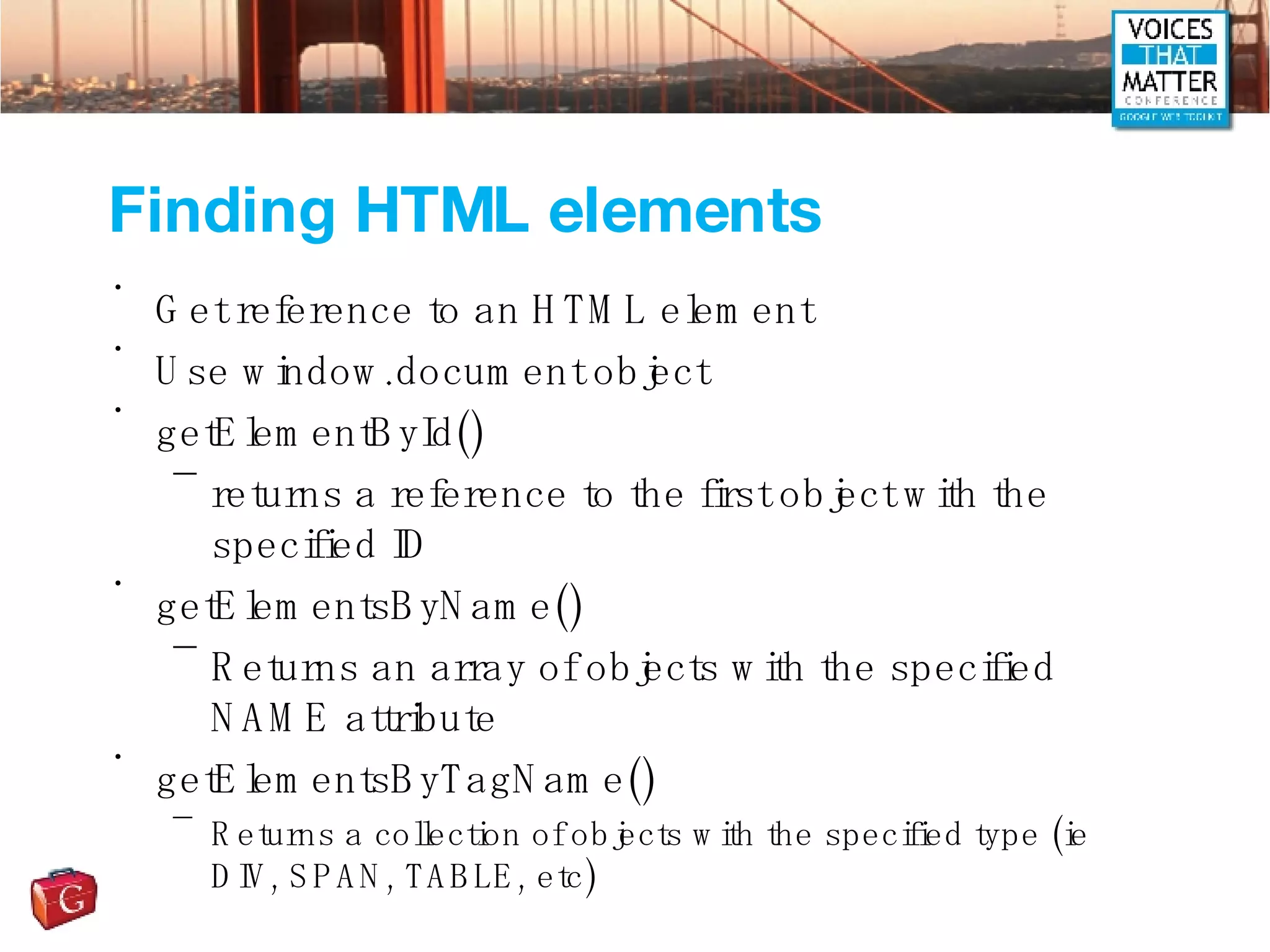
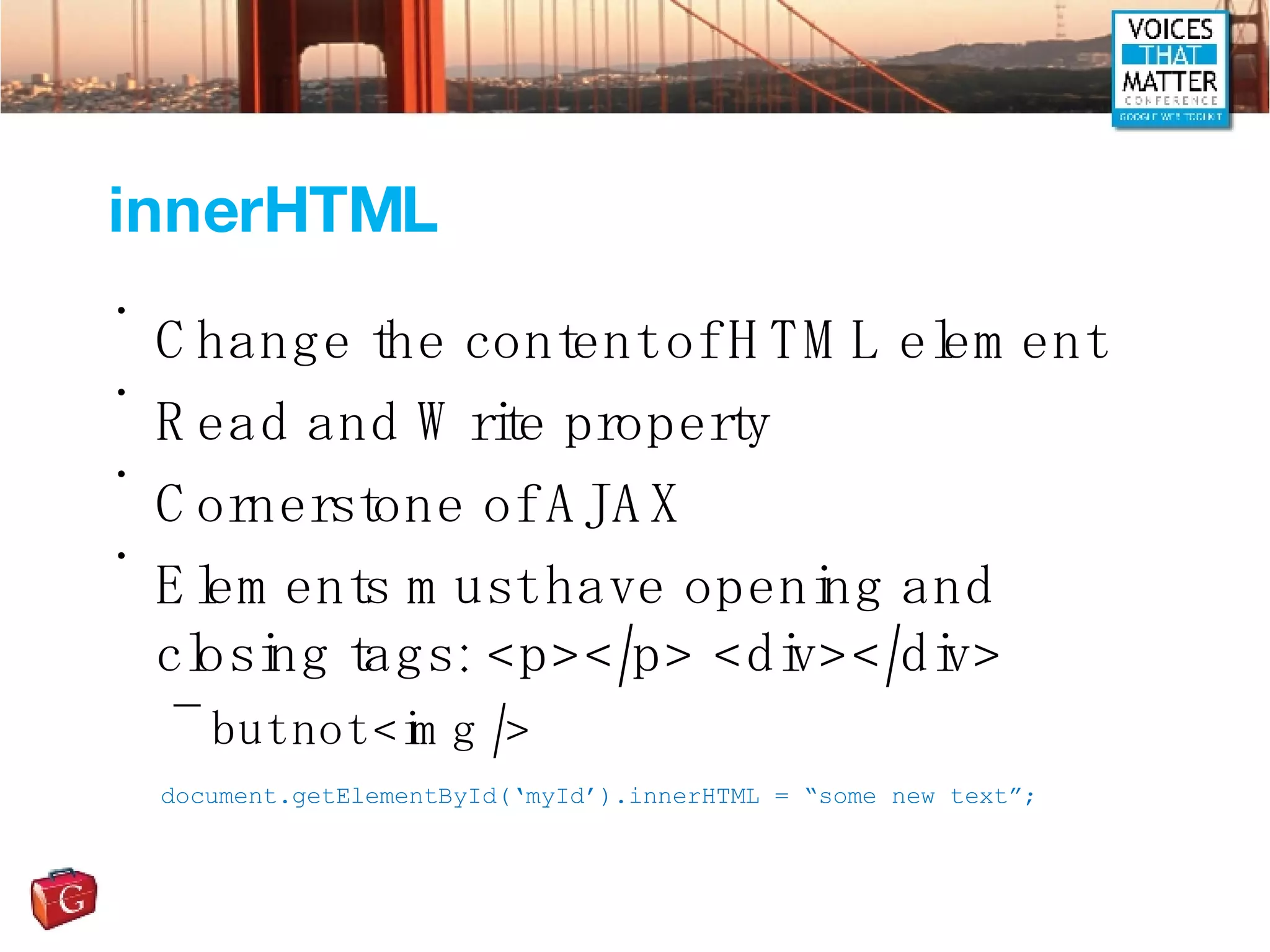
![setAttribute Apply HTML attributes with JavaScript object.setAttribute(sName, vValue [, iFlags]) var myEl = document.getElementById('info_area'); myEl.setAttribute("class", "hoverClass");](https://image.slidesharecdn.com/ajax-and-javascript-bootcamp-1196879148400612-5/75/Ajax-and-JavaScript-Bootcamp-82-2048.jpg)
![createElement / appendChild Allow you to insert HTML into the DOM Faster than adding with innerHTML Text nodes are immutable var myDiv = document.createElement('div'); myDiv.setAttribute("class", "hoverClass2"); var body = document.getElementsByTagName('body')[0]; body.appendChild(myDiv);](https://image.slidesharecdn.com/ajax-and-javascript-bootcamp-1196879148400612-5/75/Ajax-and-JavaScript-Bootcamp-83-2048.jpg)
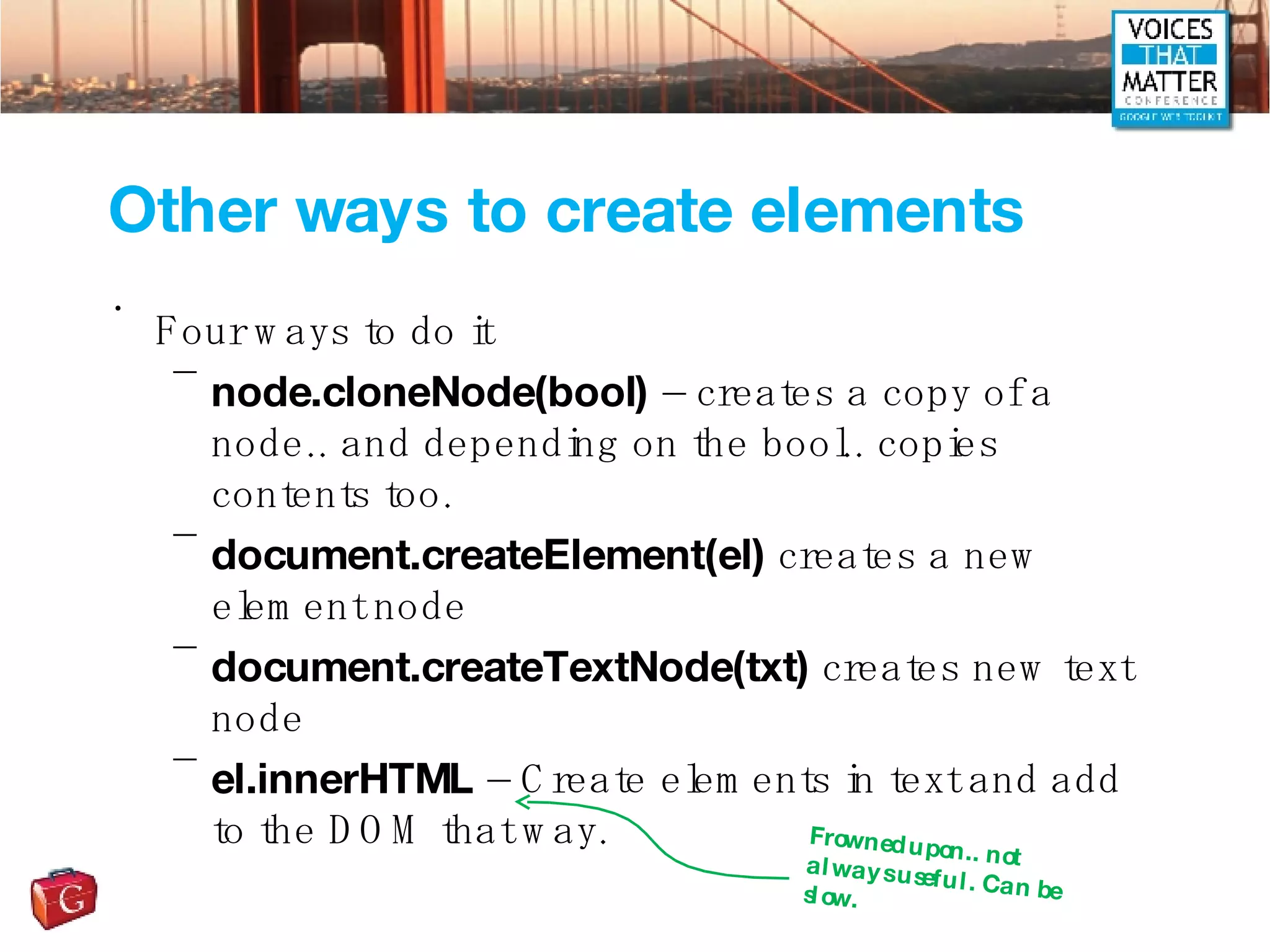
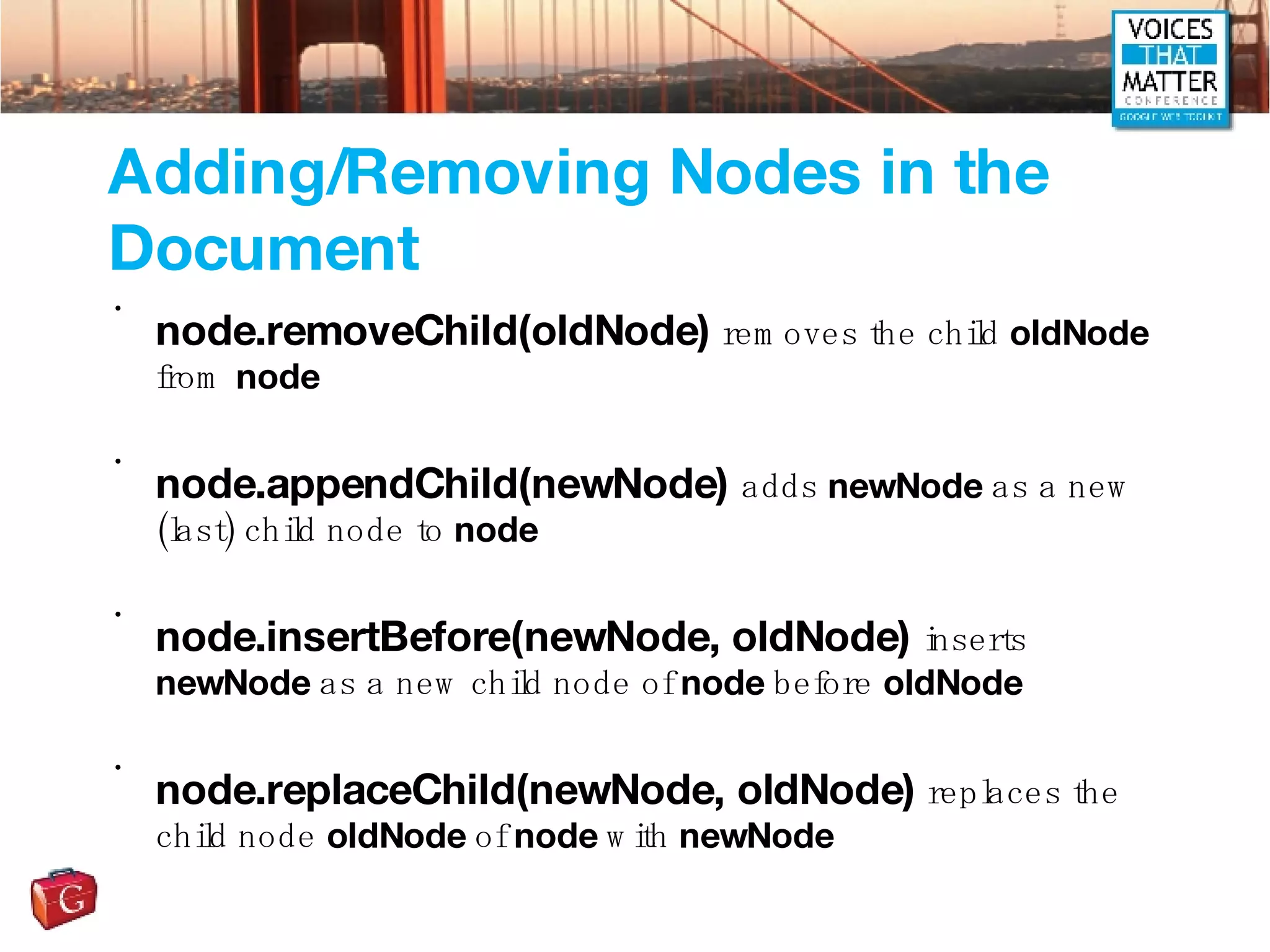
![DOM Navigation node.firstChild Get the first element of the child array same as childNodes[0] node.childNodes Returns collection of all nodes belonging to that node.. 1 st level only. node.parentNode Returns the element that this node belongs to node.nextSibling Returns the next sibling belonging to this elements parent node.previousSibling Returns the earlier sibling belonging to this elements parent chaining: myNode.childNodes[0].childNodes[2].parentNode.nextSibling.previousSibling;](https://image.slidesharecdn.com/ajax-and-javascript-bootcamp-1196879148400612-5/75/Ajax-and-JavaScript-Bootcamp-86-2048.jpg)
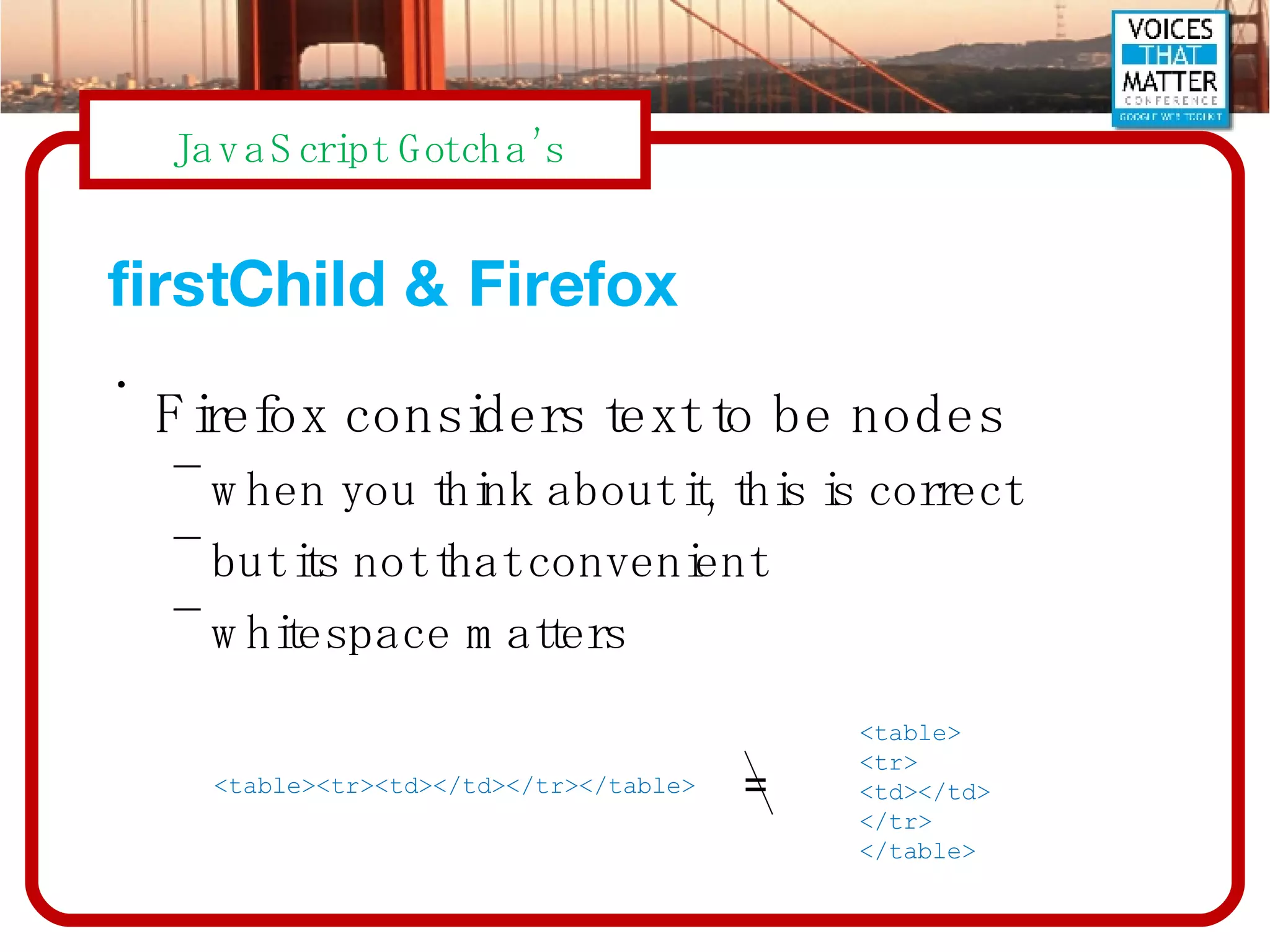
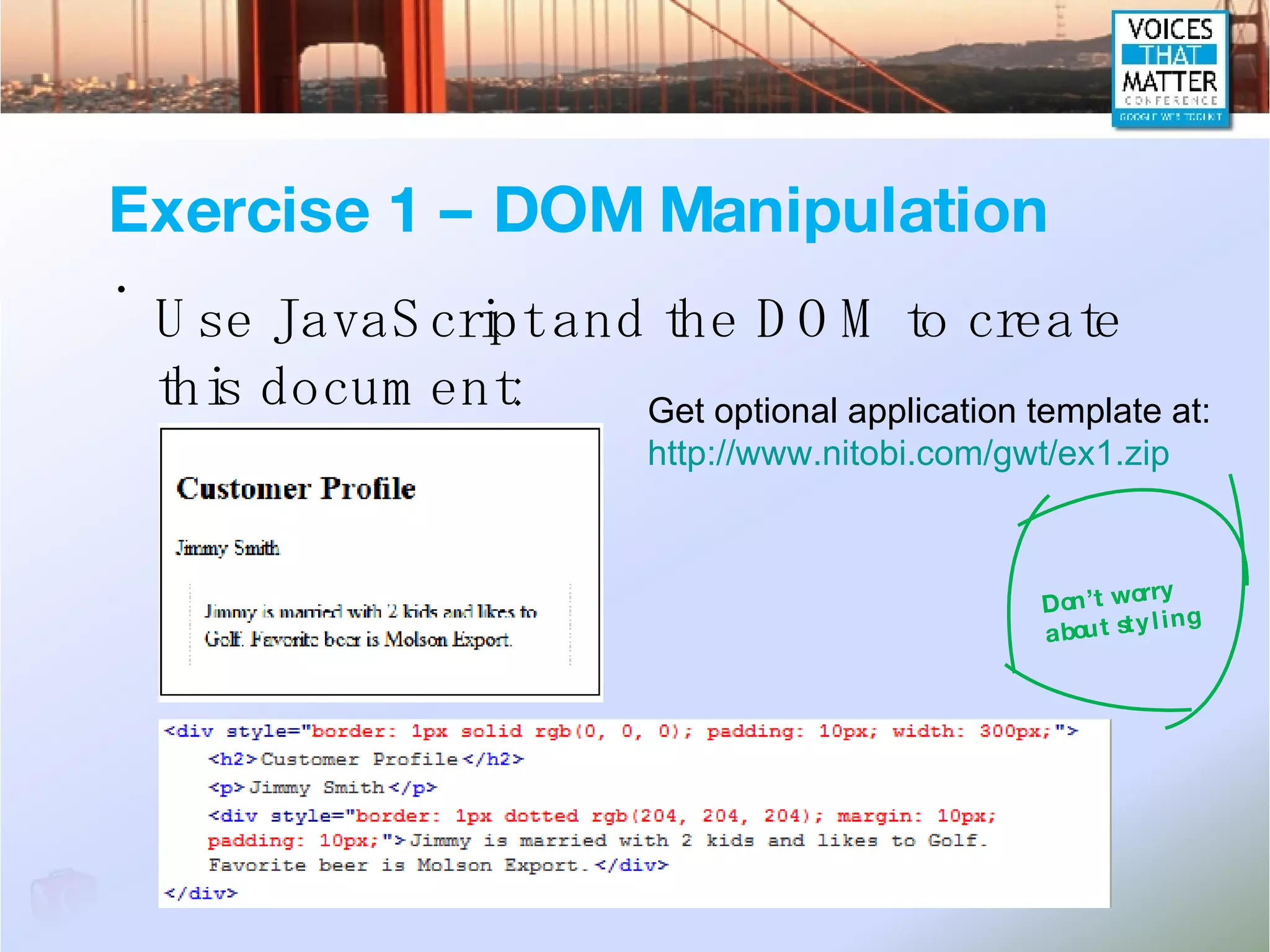
![Exercise 1 – Possible Solution InsertDOM = function() { var myDiv = document.createElement('div'); var myHeading = document.createElement('h2'); myHeading.innerHTML = "Customer Profile"; var myP1 = document.createElement('p'); myP1.innerHTML = "Jimmy Smith"; var myDiv2 = document.createElement('div'); myDiv2.innerHTML = "Jimmy is married with 2 kids and likes to Golf. Favorite beer is Molson Export."; // Here we asseble everything into one node myDiv.appendChild(myHeading); myDiv.appendChild(myP1); myDiv.appendChild(myDiv2); var body = document.getElementsByTagName('body')[0]; body.appendChild(myDiv); }](https://image.slidesharecdn.com/ajax-and-javascript-bootcamp-1196879148400612-5/75/Ajax-and-JavaScript-Bootcamp-89-2048.jpg)
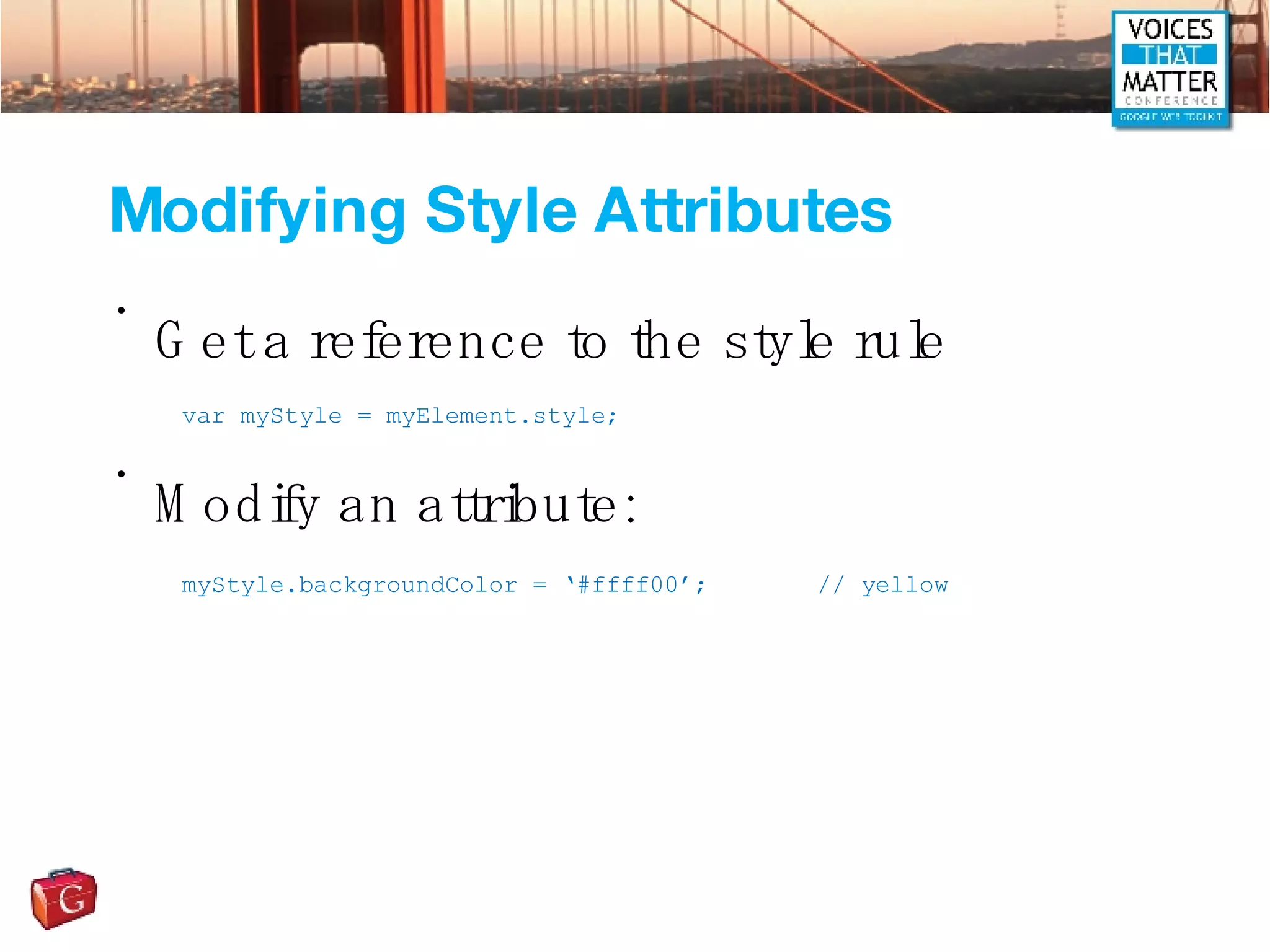
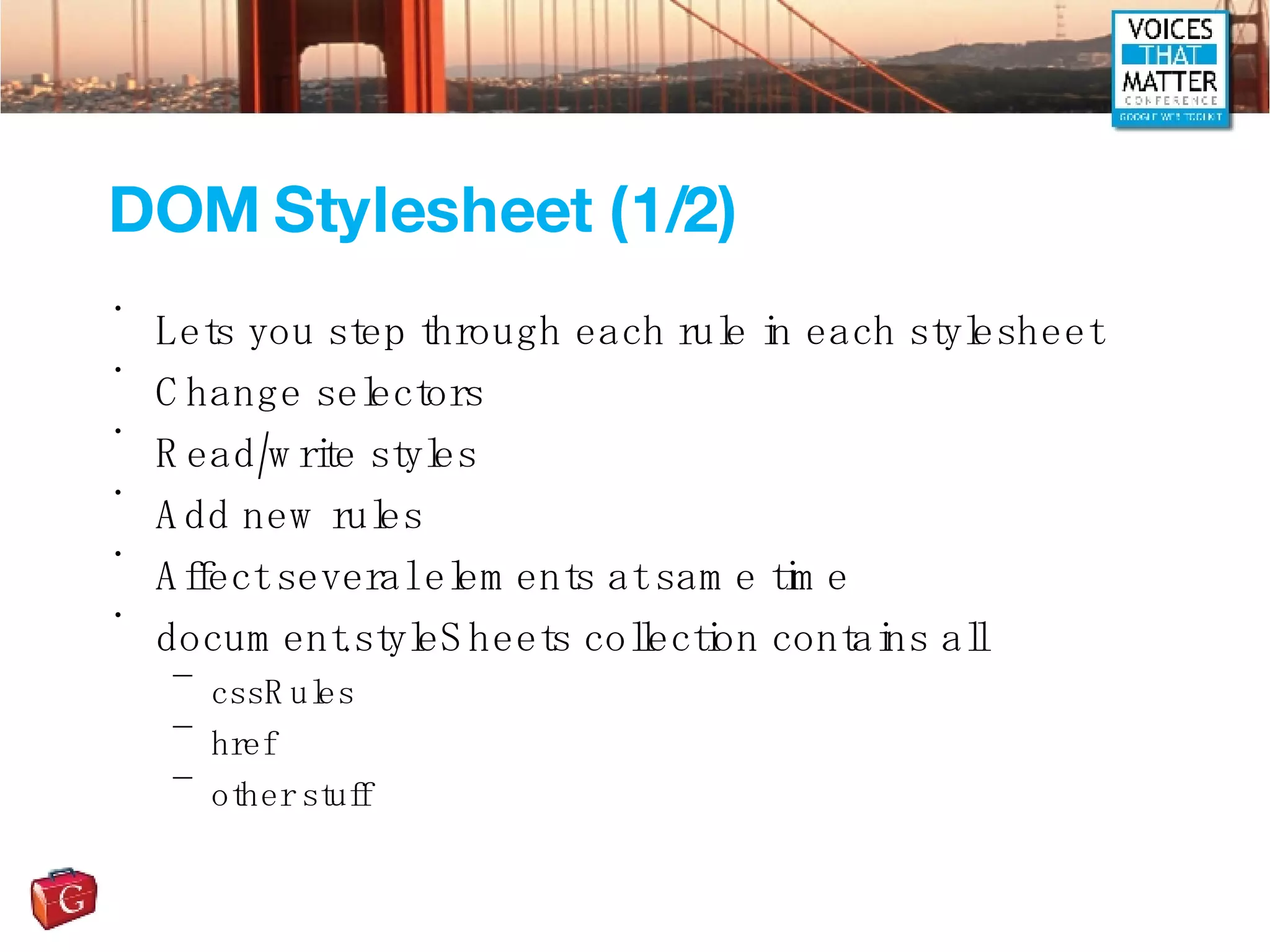
![DOM Stylesheet (2/2) To find and change a class loop through all stylesheets look at the selectorText modify your style when you’ve found it if (myRules[k].selectorText == '.specialDiv') { myRules[k].style.position = 'absolute'; myRules[k].style.top = '100px'; myRules[k].style.left = '100px'; }](https://image.slidesharecdn.com/ajax-and-javascript-bootcamp-1196879148400612-5/75/Ajax-and-JavaScript-Bootcamp-92-2048.jpg)
![Cross Browser Alert! In FF/Safari you look for cssRules In IE you look for rules var myRules = (mySheets[i].rules || mySheets[i].cssRules);](https://image.slidesharecdn.com/ajax-and-javascript-bootcamp-1196879148400612-5/75/Ajax-and-JavaScript-Bootcamp-93-2048.jpg)

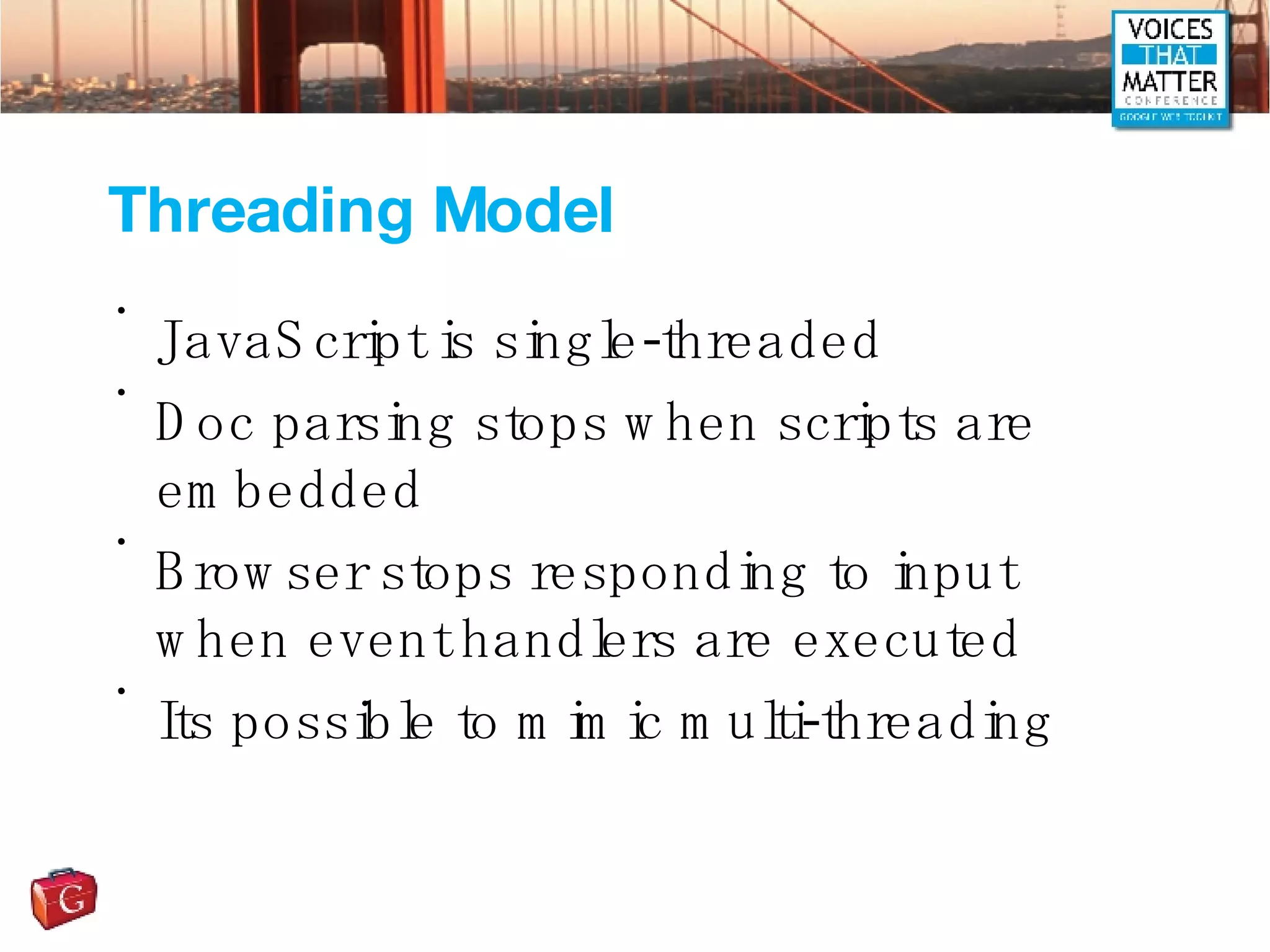
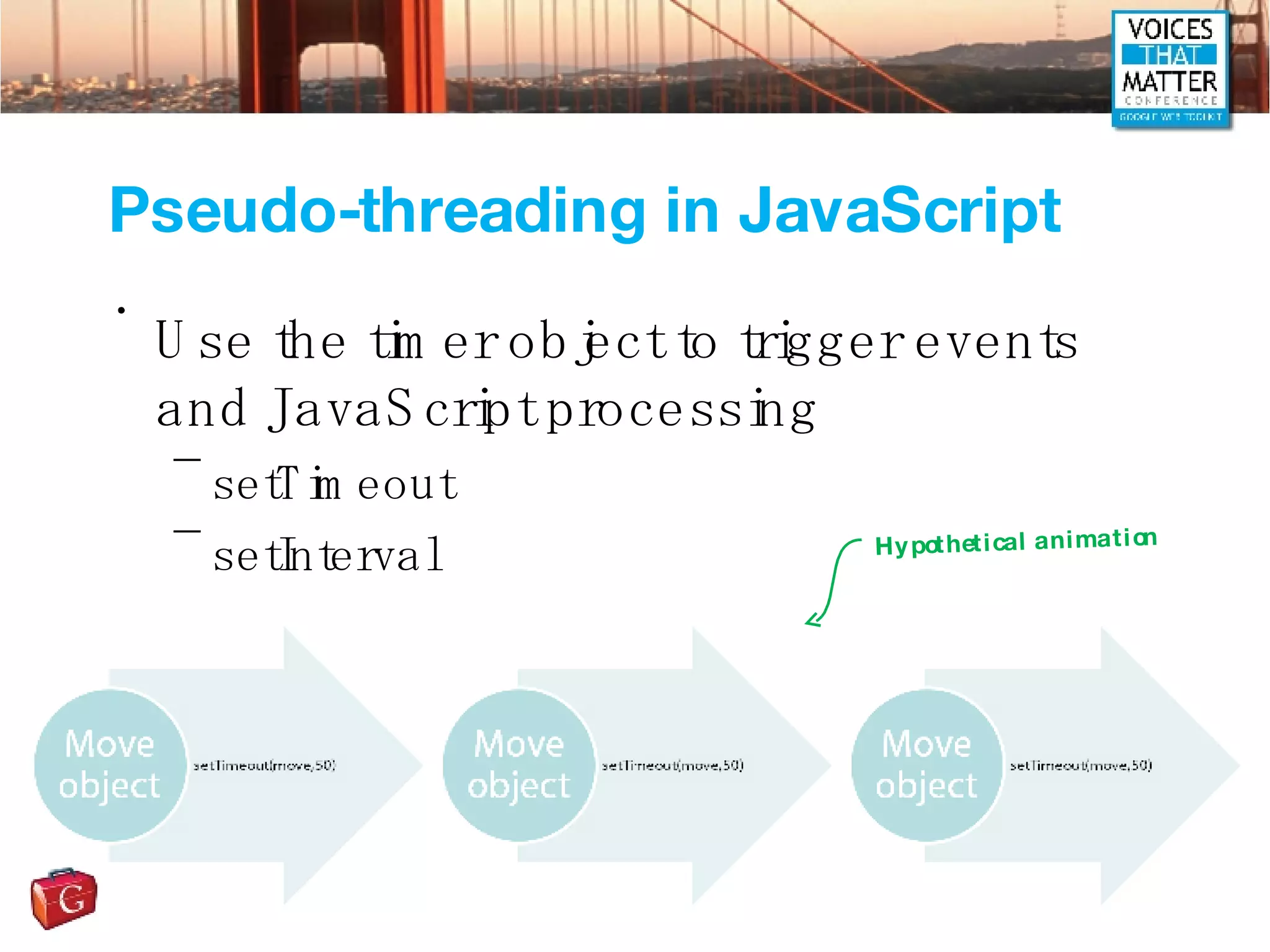
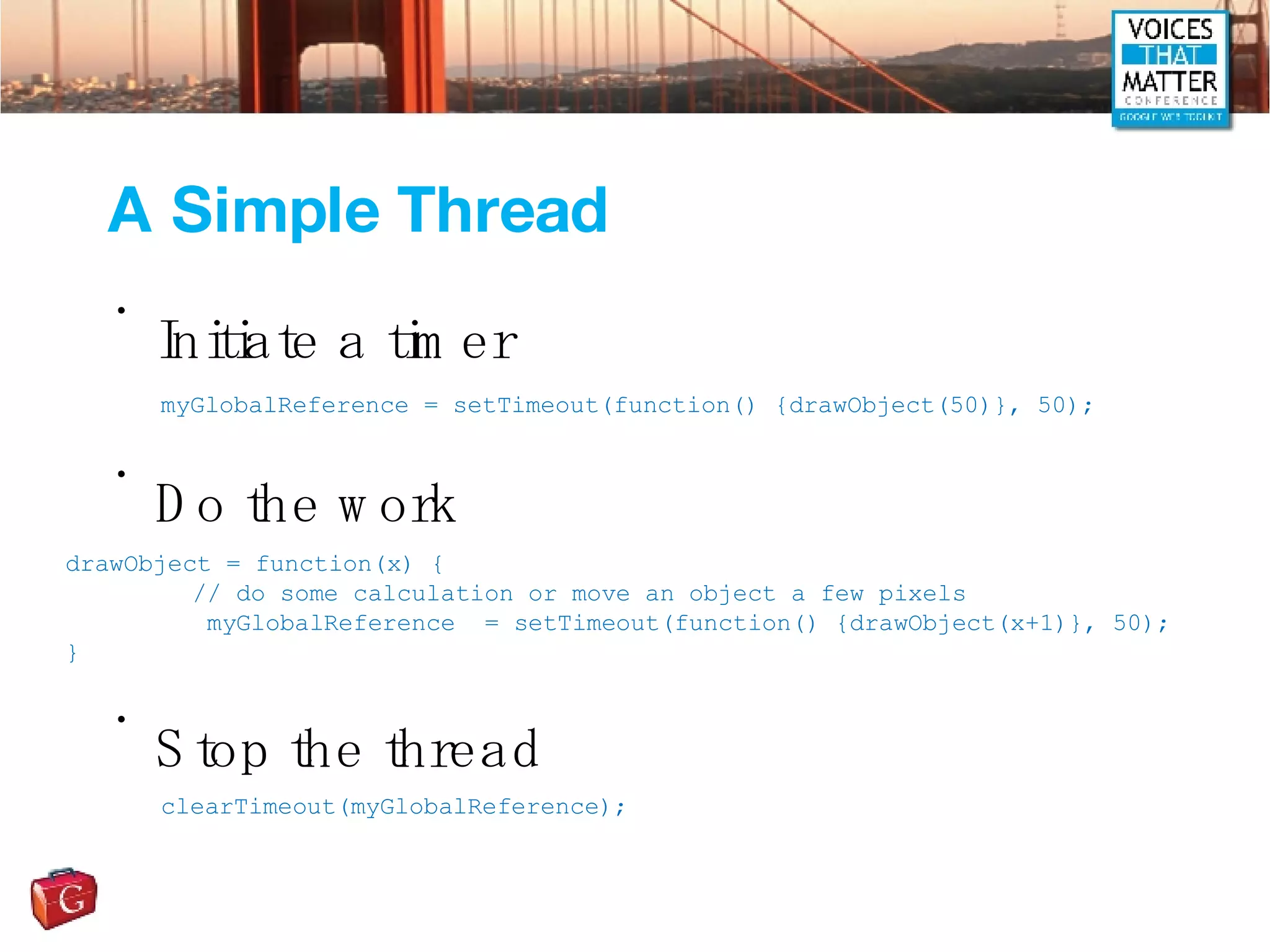

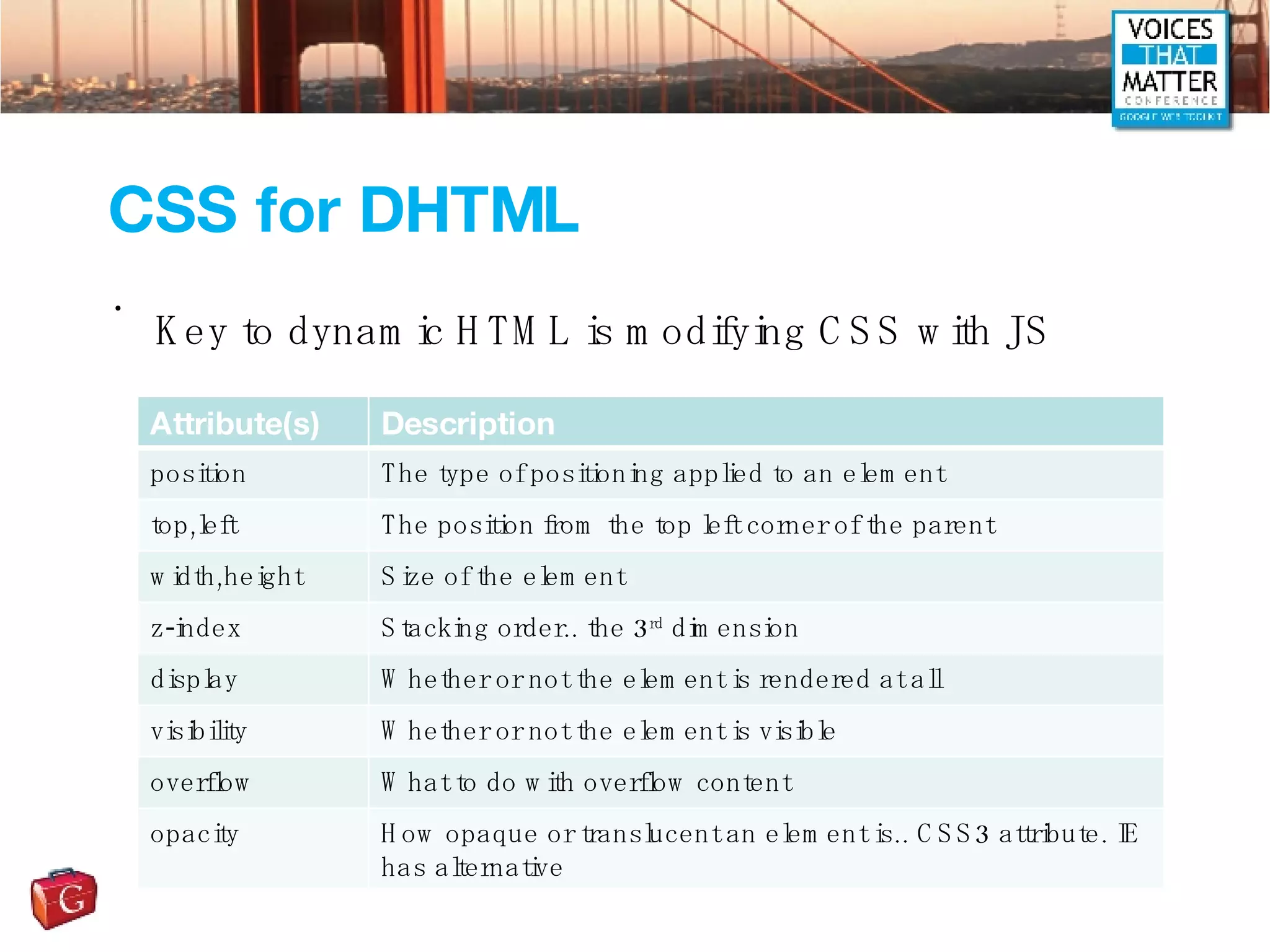
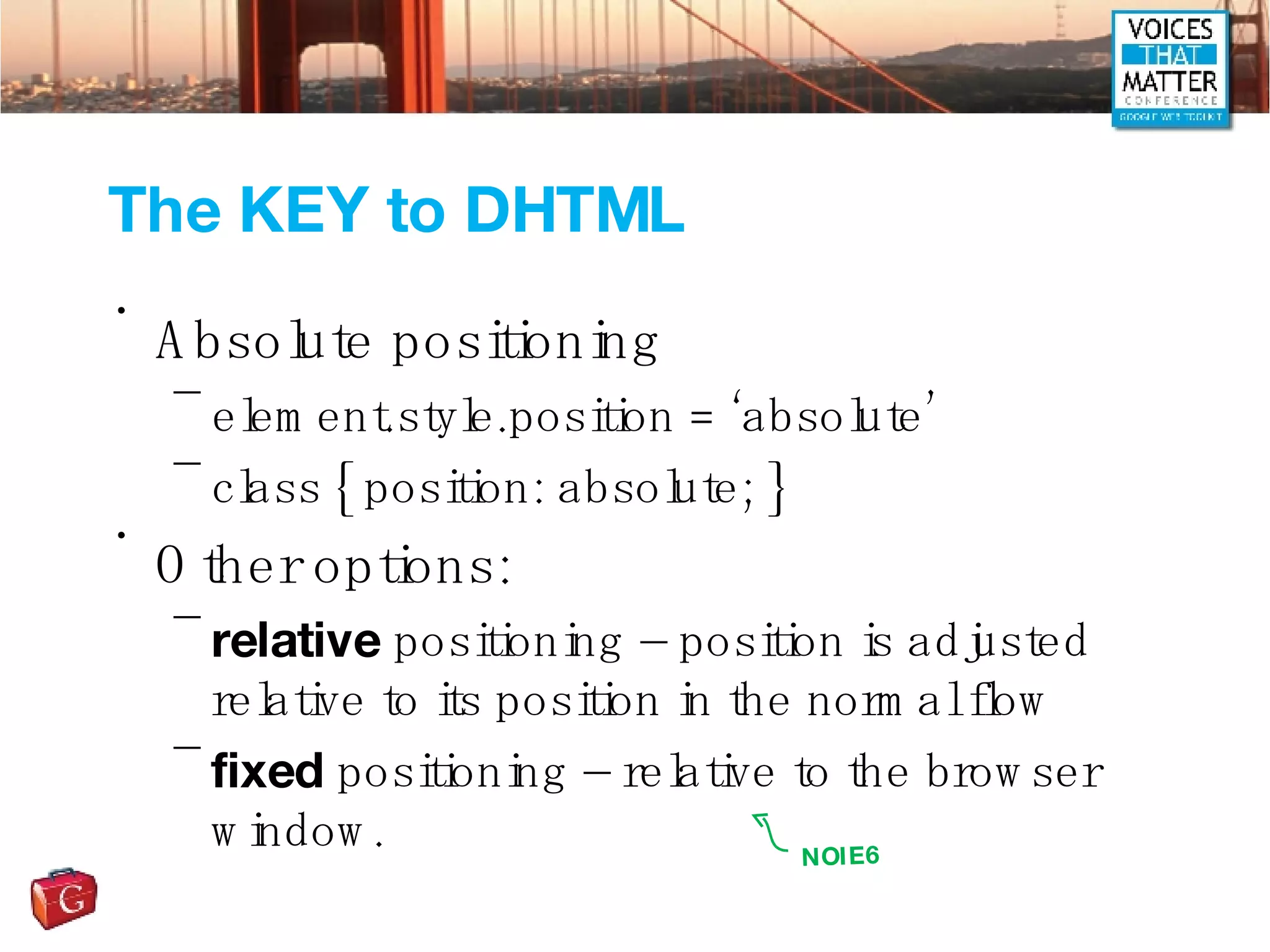
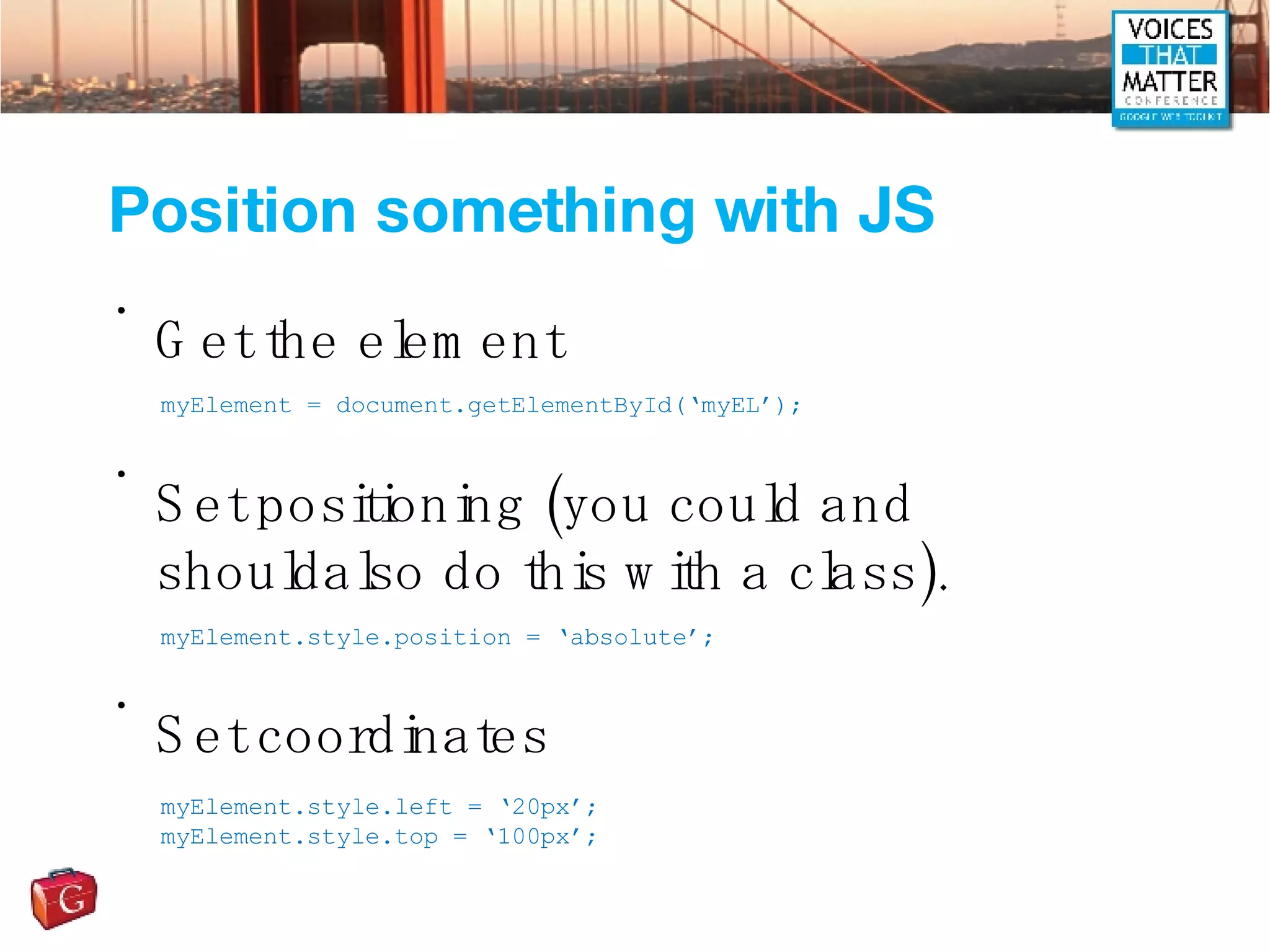
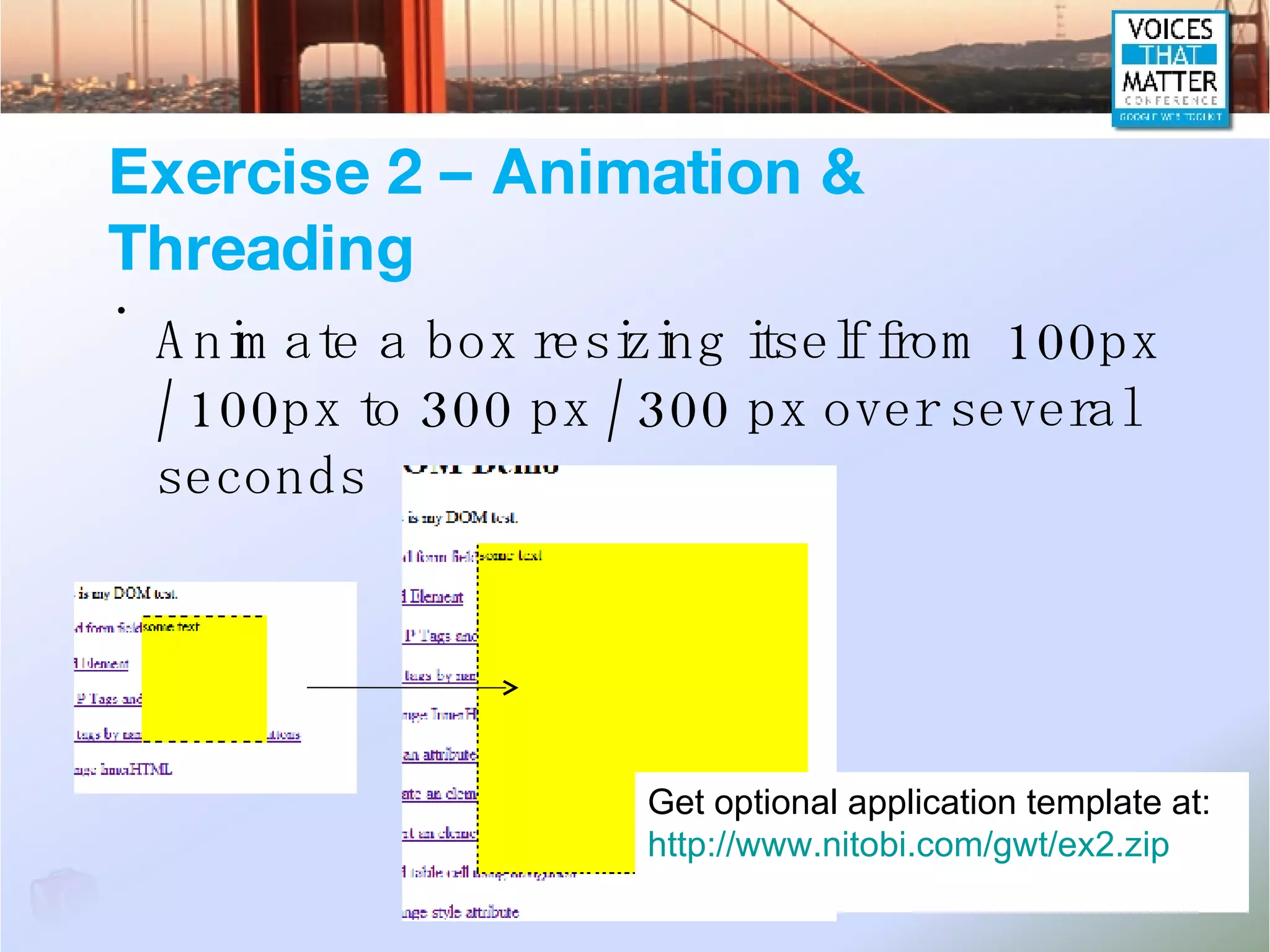
![Exercise 2 – Possible Solution AnimateDOMWithThread = function() { var myDiv = document.createElement('div'); myDiv.style.backgroundColor = "#FFFF00"; myDiv.style.width = "100px"; myDiv.style.height = "100px"; myDiv.innerHTML = "Some text"; var body = document.getElementsByTagName('body')[0]; body.appendChild(myDiv); window.myAnimObj = setTimeout(function() {animateBox(myDiv,100, 100)}, 20); } animateBox = function(myBox, w, h) { myBox.style.width = w + 'px'; myBox.style.height = h + 'px'; var neww = w+1; var newh = h+1; if ((neww <= 300) || (newh <= 300)) window.myAnimObj = setTimeout(function() {animateBox(myBox,neww,newh)}, 20); } Absolute positioning not required](https://image.slidesharecdn.com/ajax-and-javascript-bootcamp-1196879148400612-5/75/Ajax-and-JavaScript-Bootcamp-103-2048.jpg)

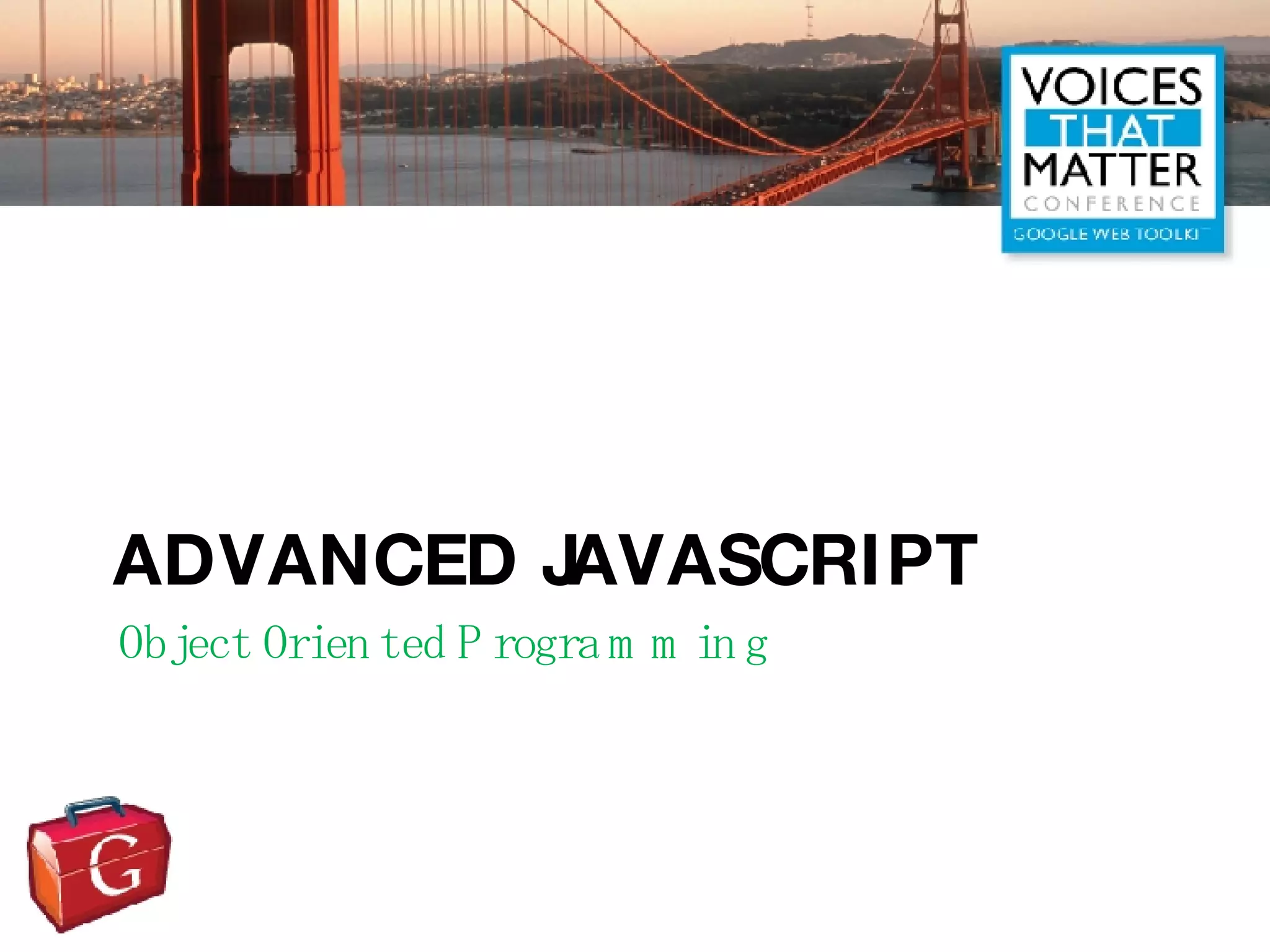
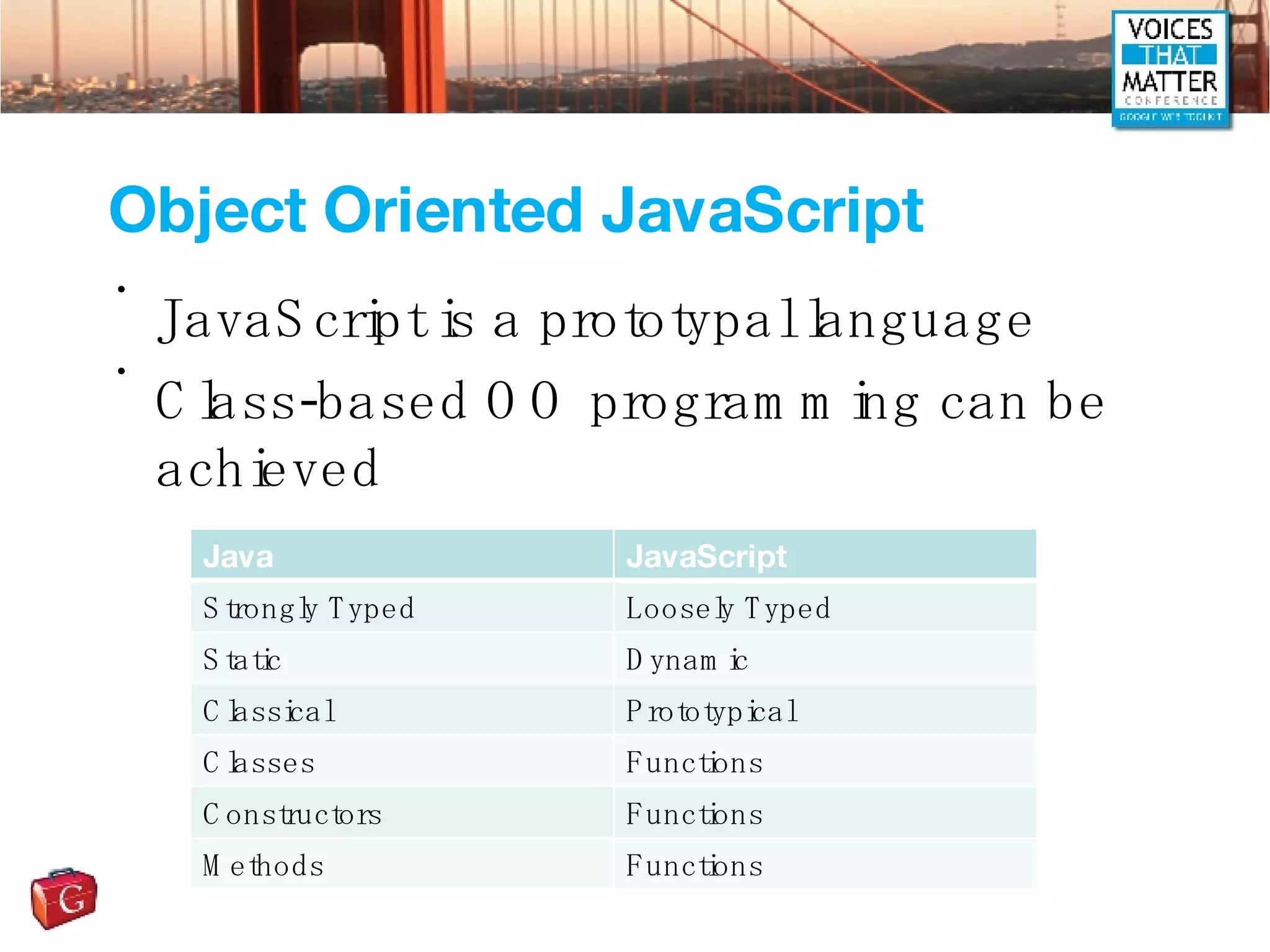
![Functions are Objects Too Important function methods: call(scope, arg1, arg2 …); apply(scope, [arg1, arg2 …]); caller Call and apply used to dynamically execute a function in arbitrary scope](https://image.slidesharecdn.com/ajax-and-javascript-bootcamp-1196879148400612-5/75/Ajax-and-JavaScript-Bootcamp-107-2048.jpg)
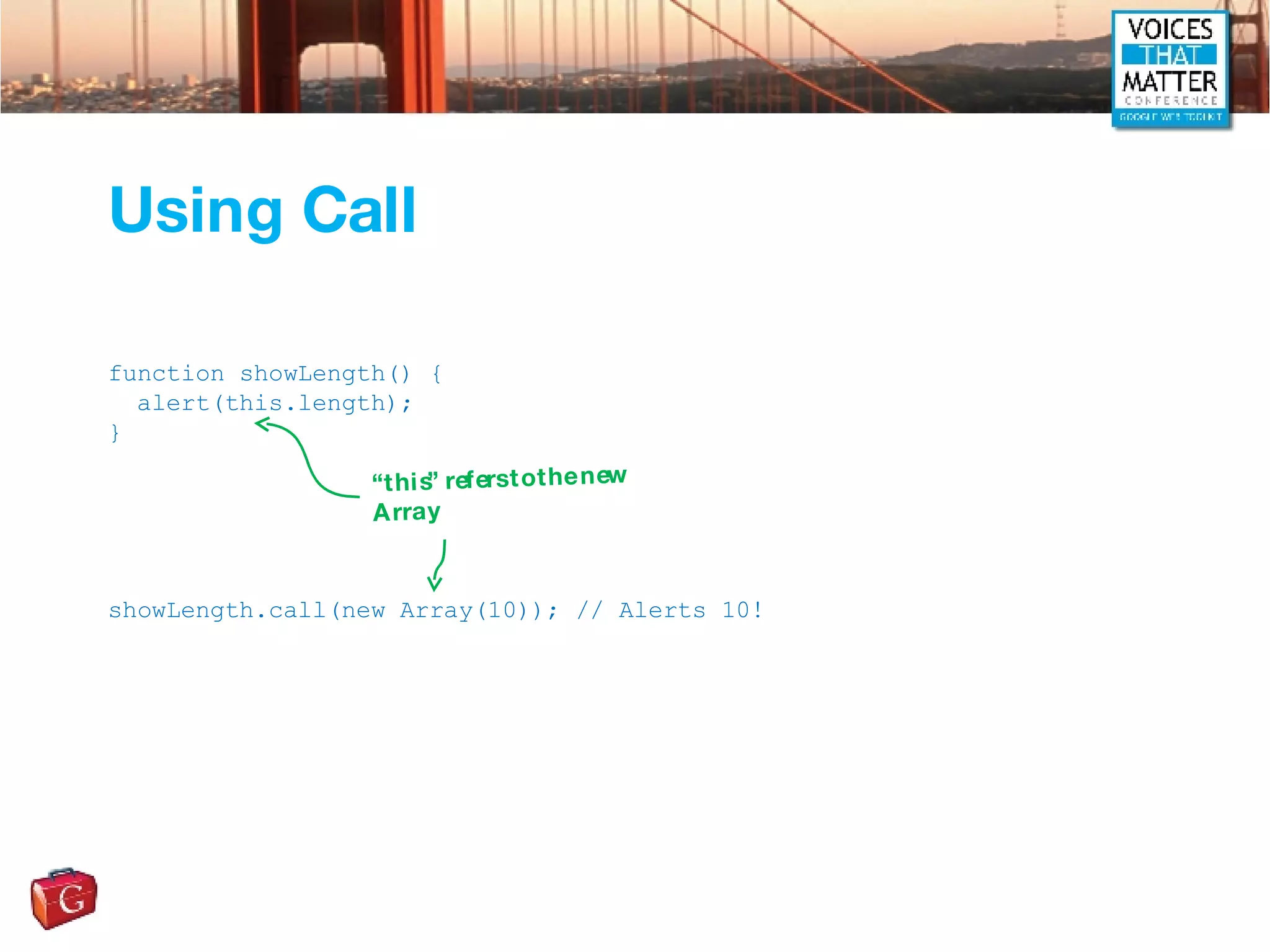
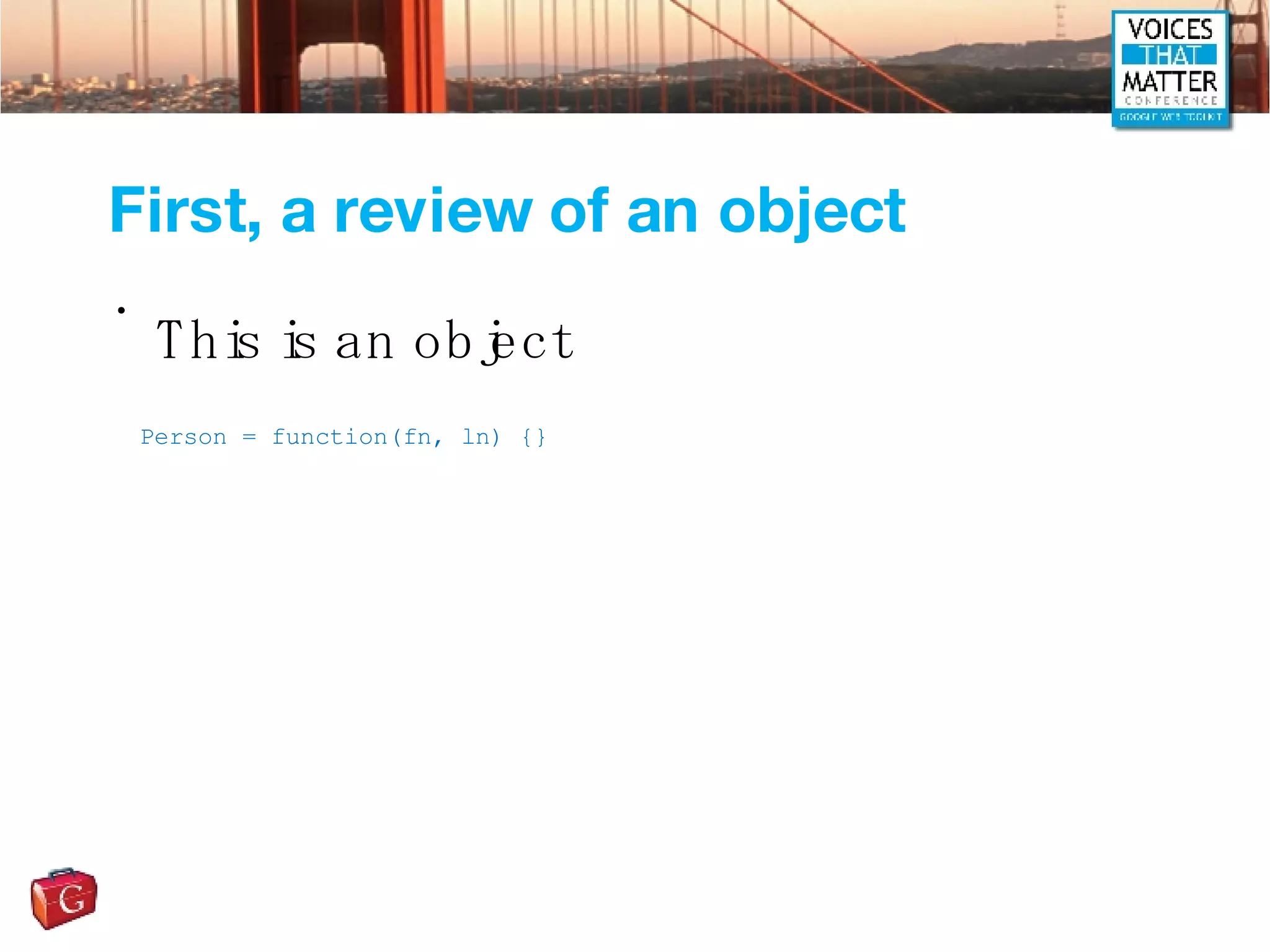
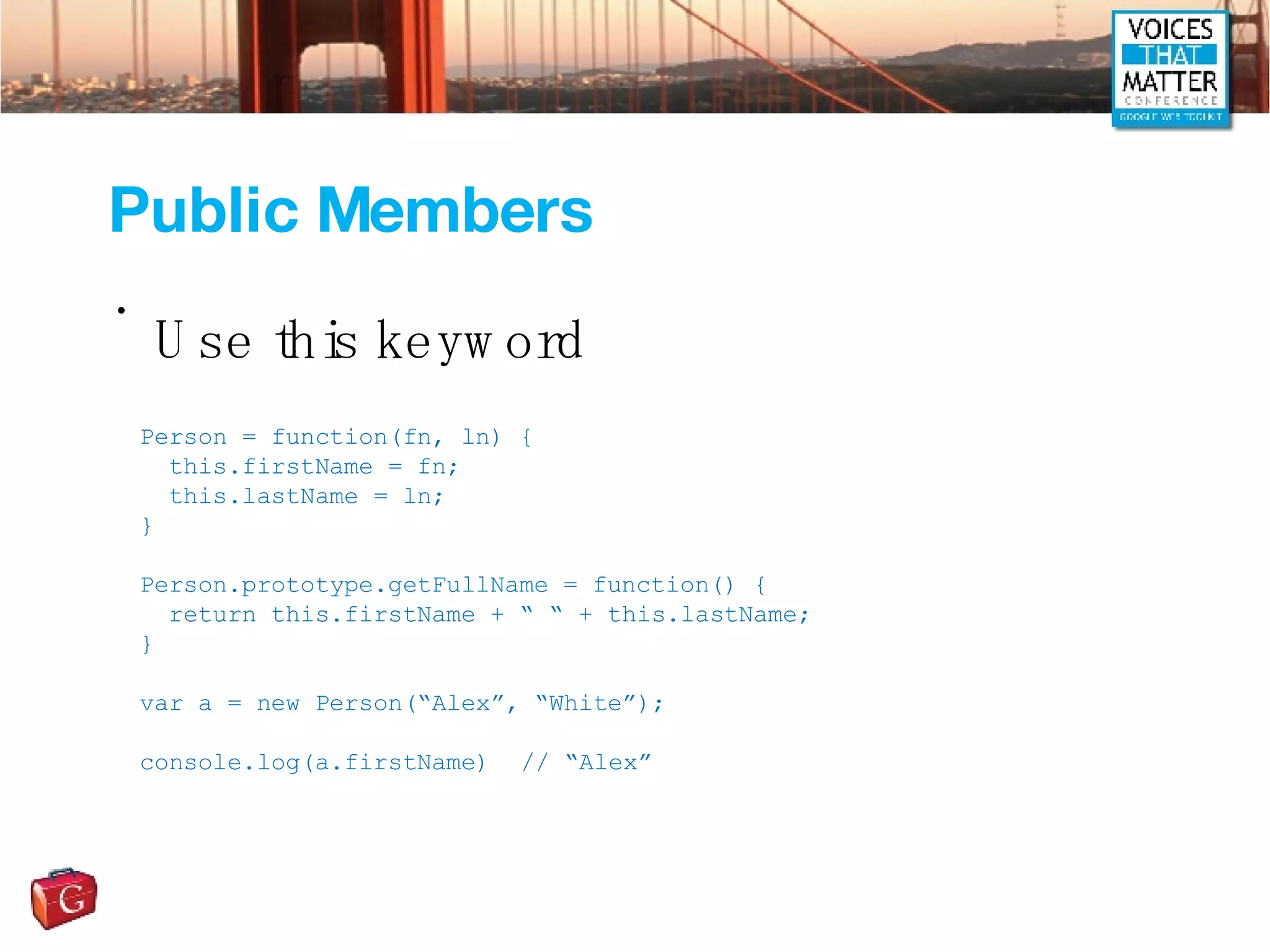
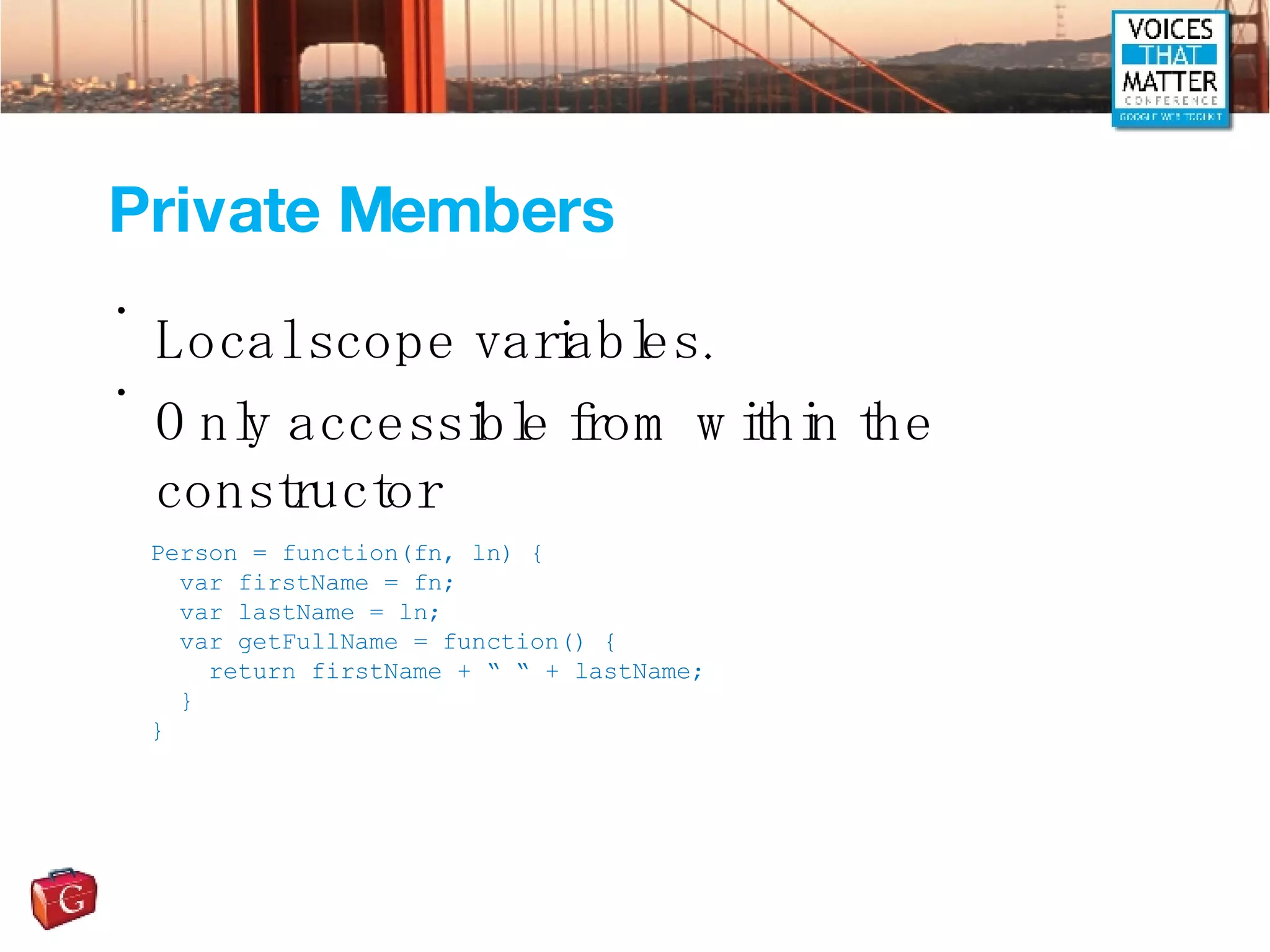
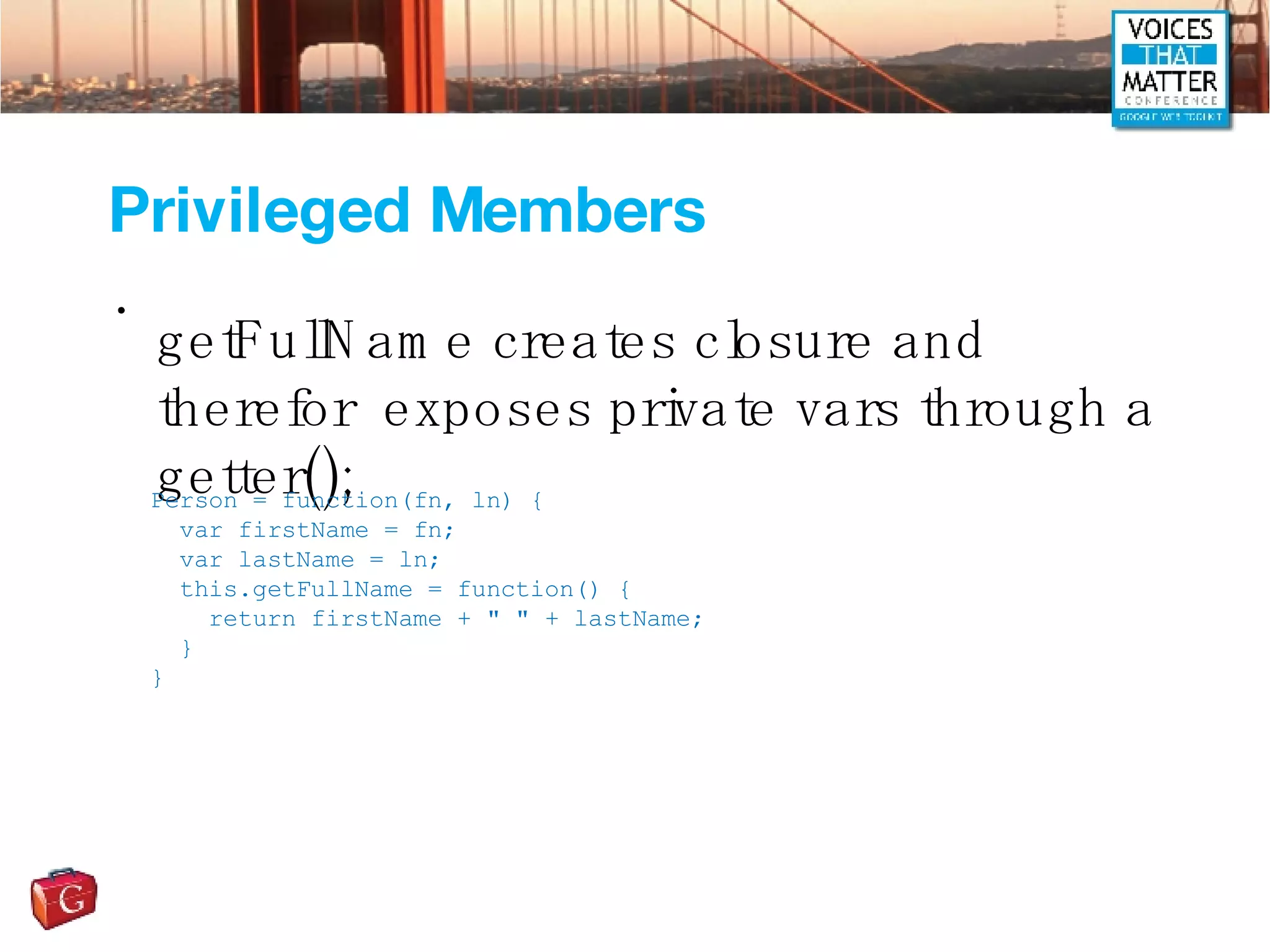
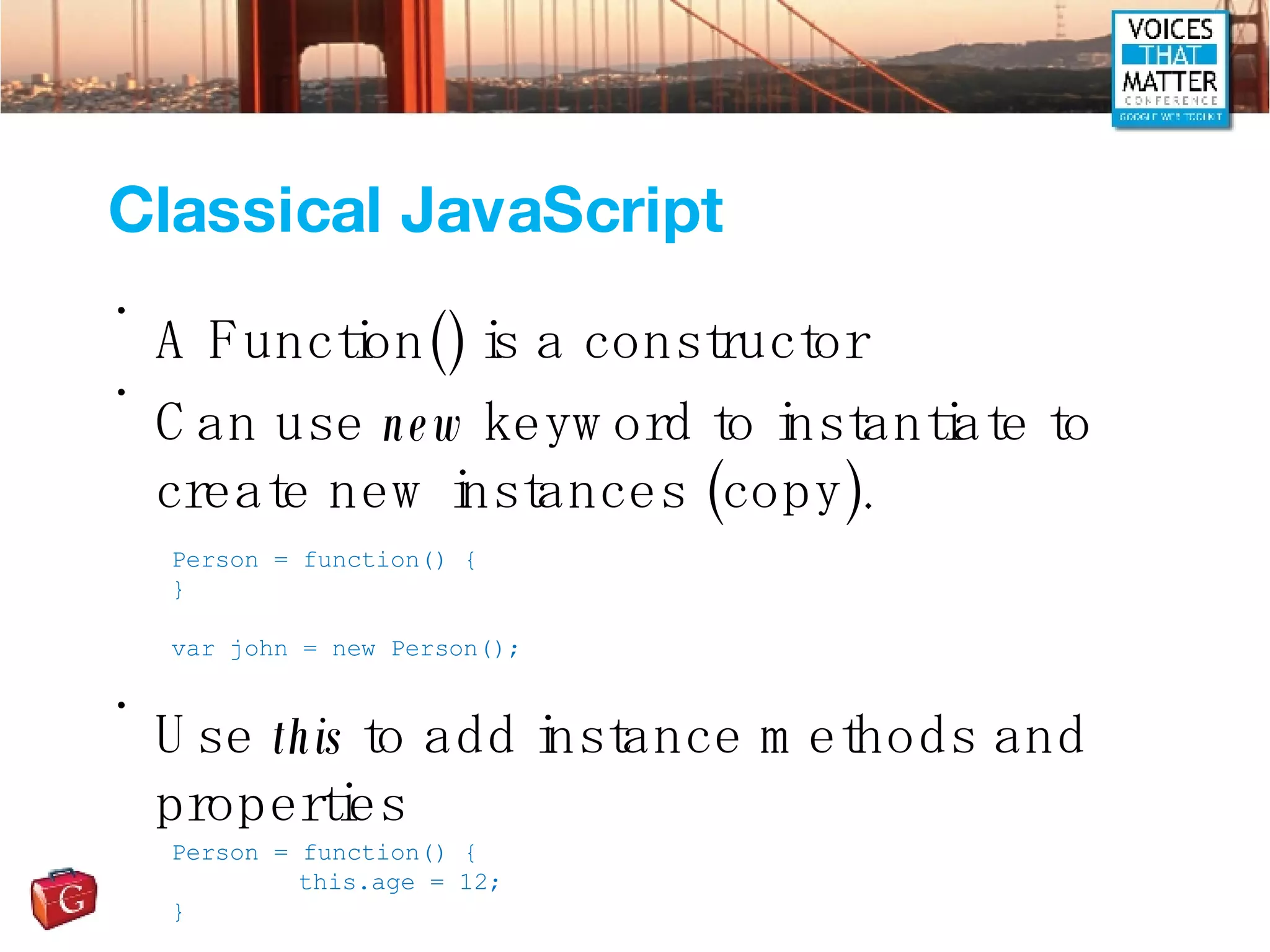
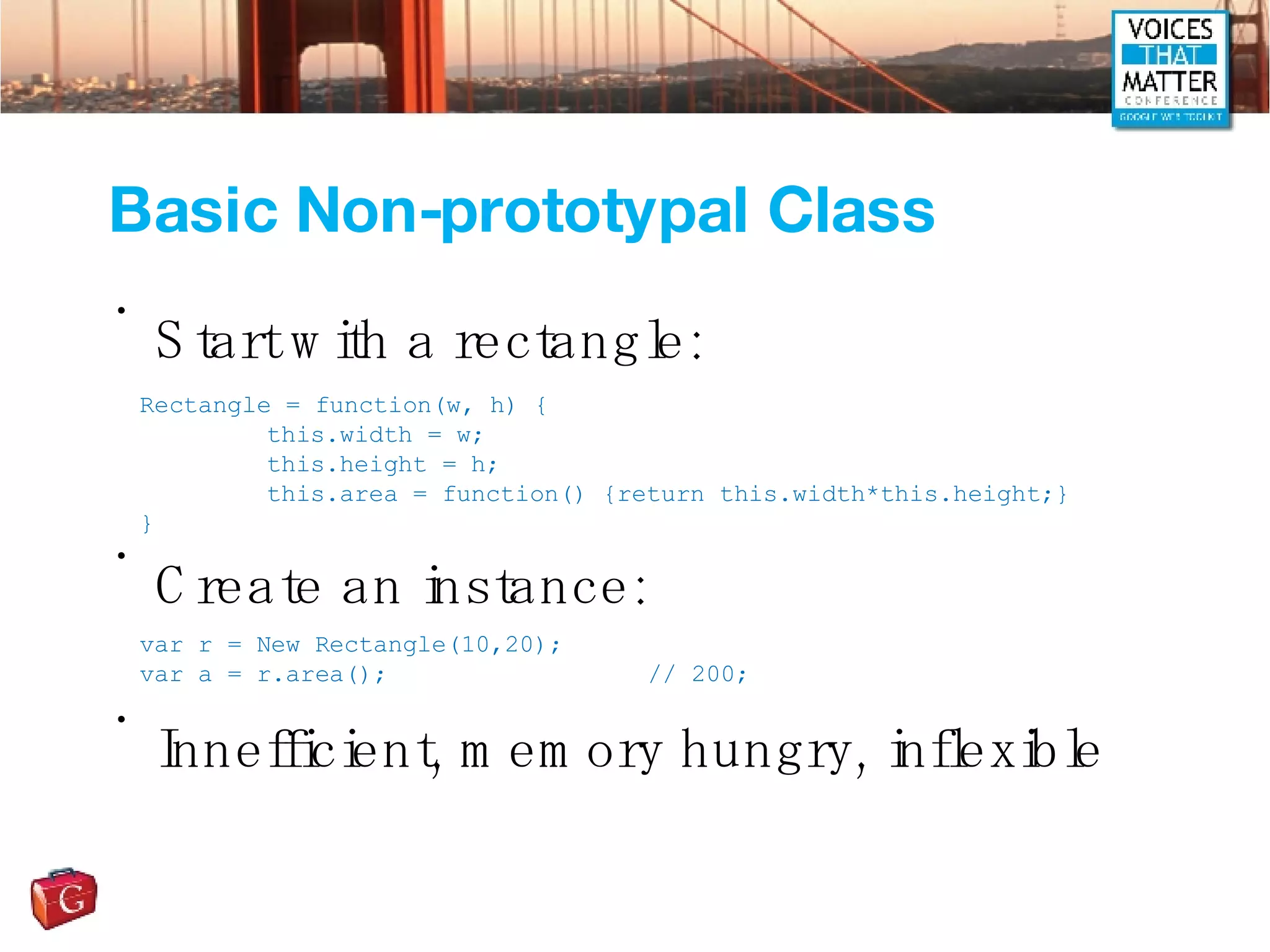
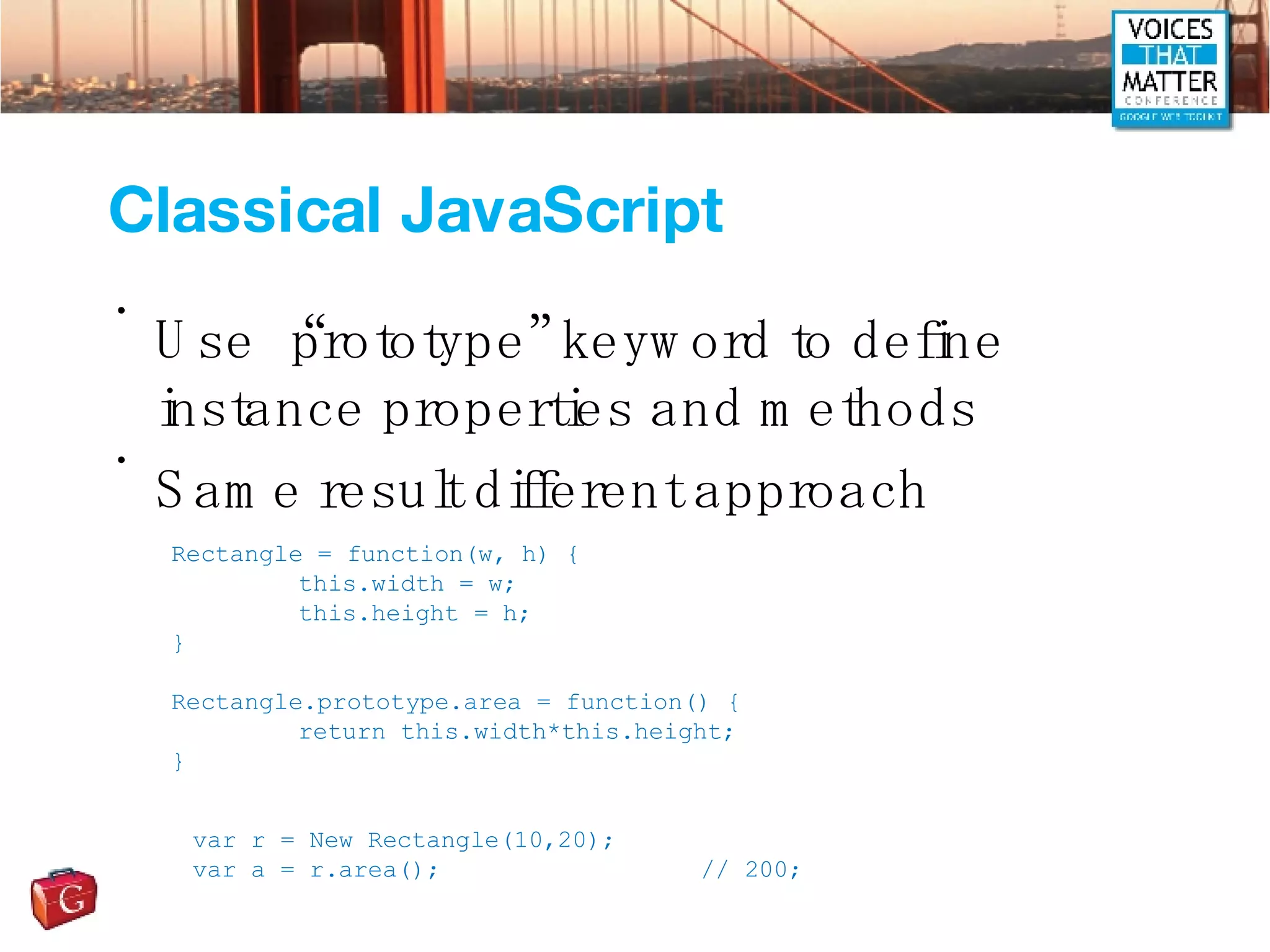
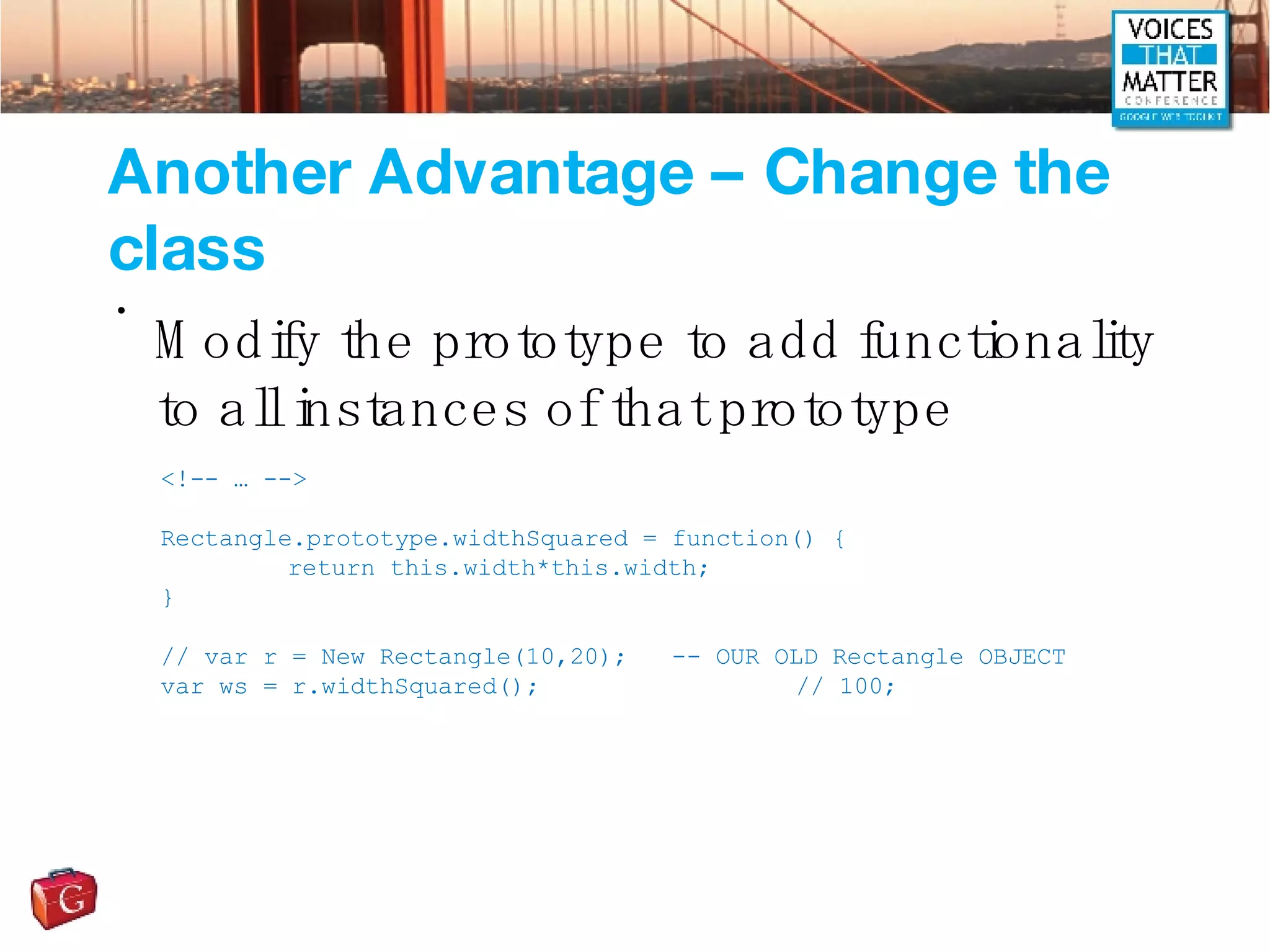
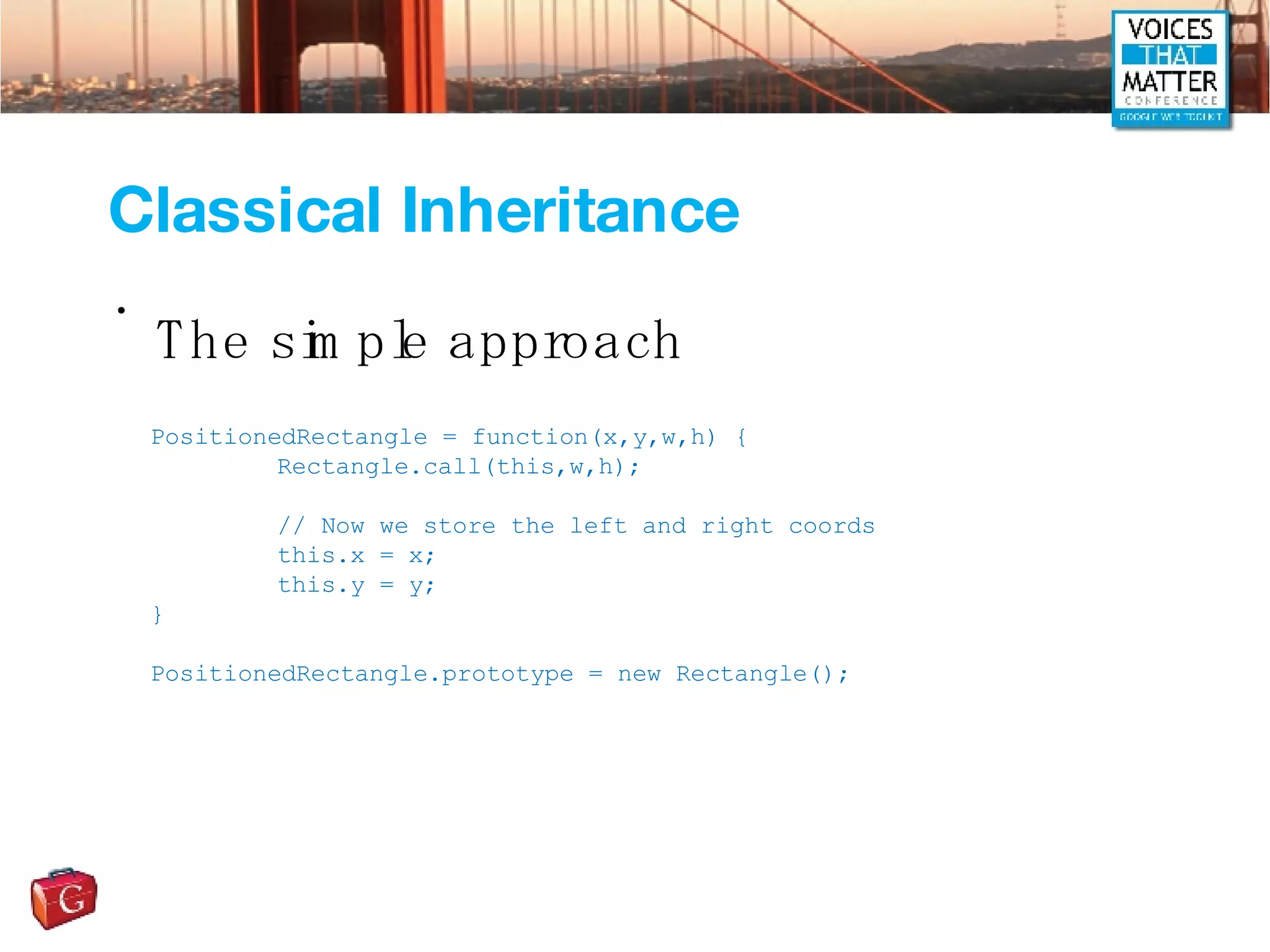
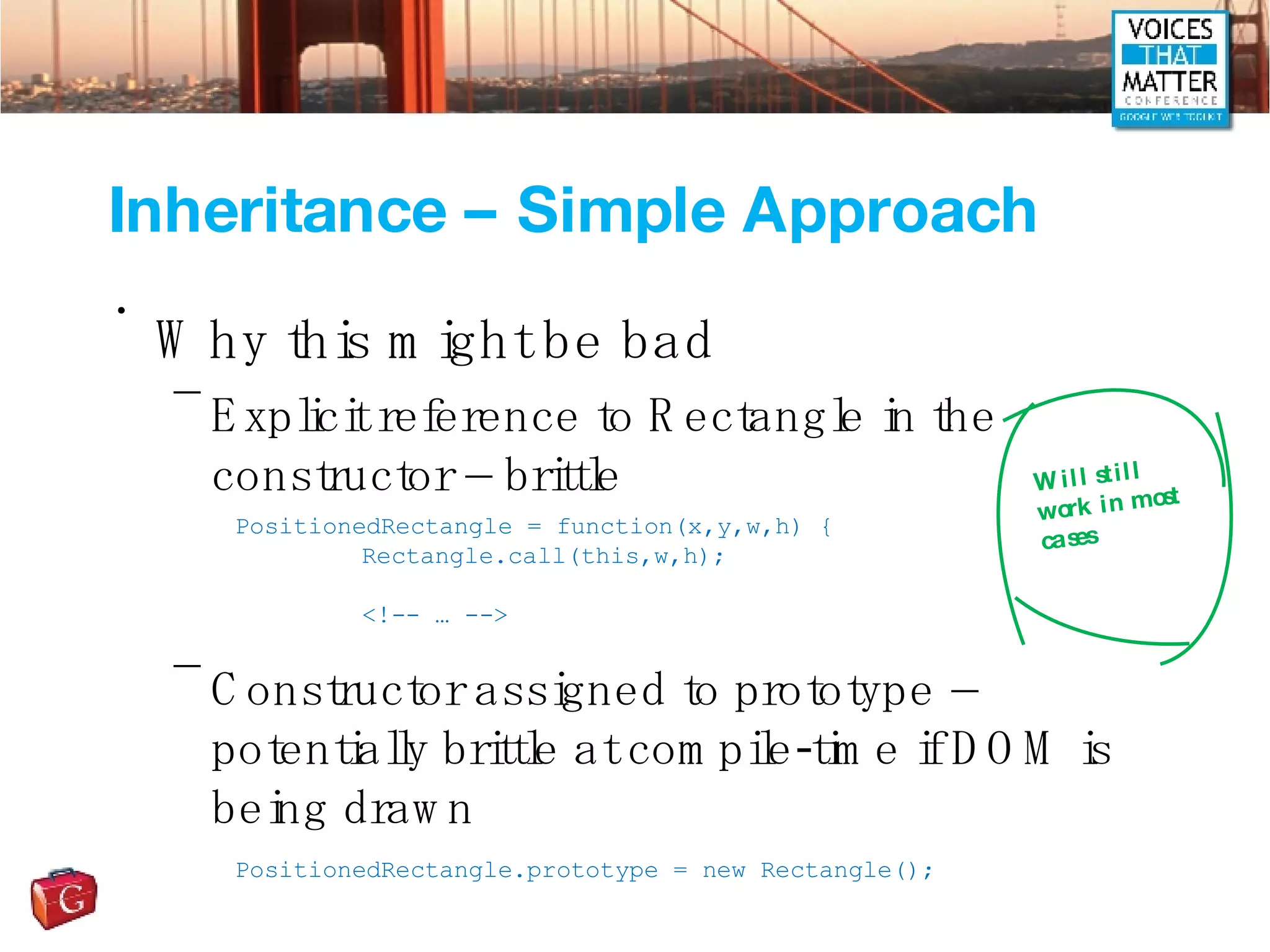
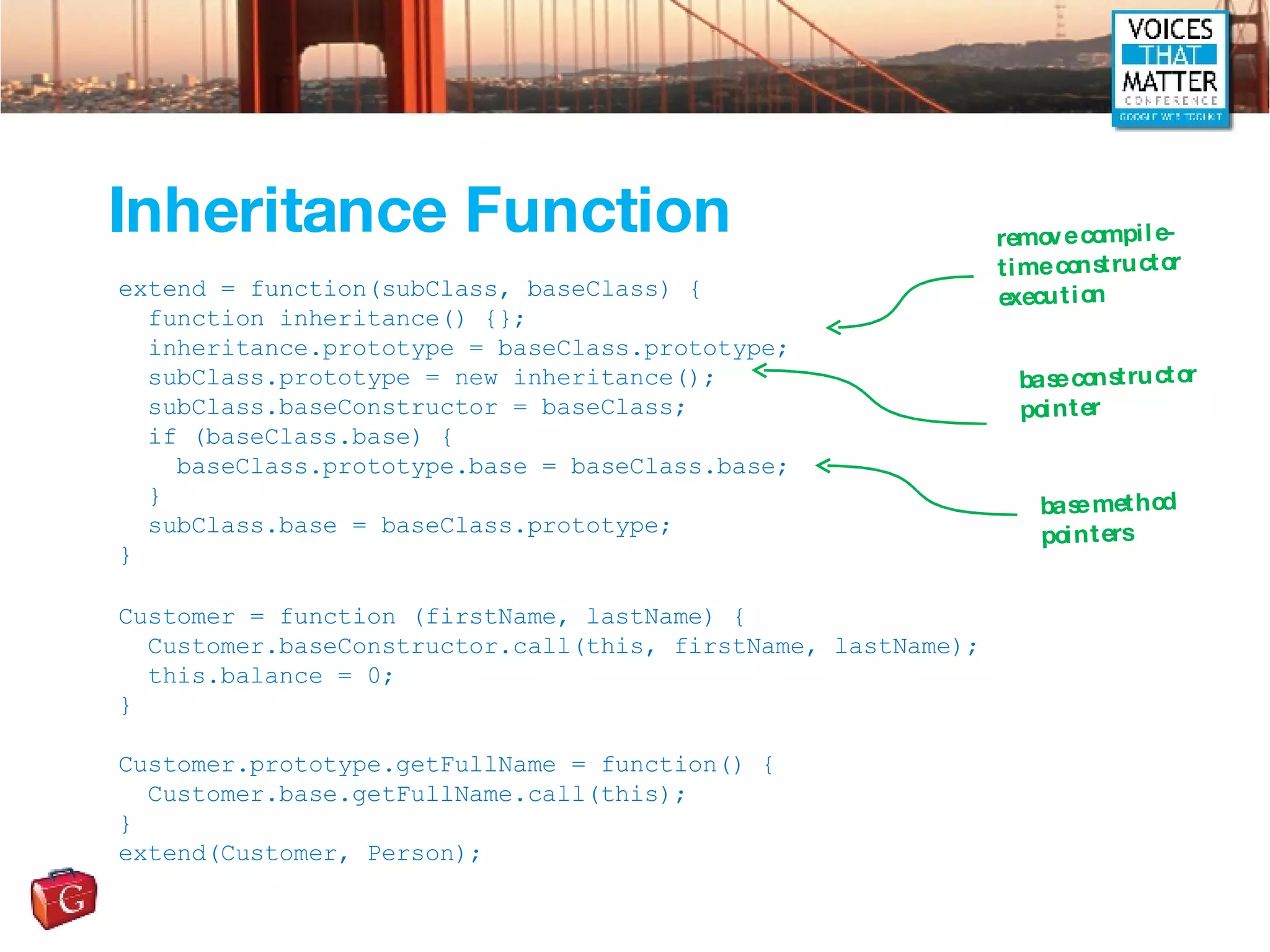
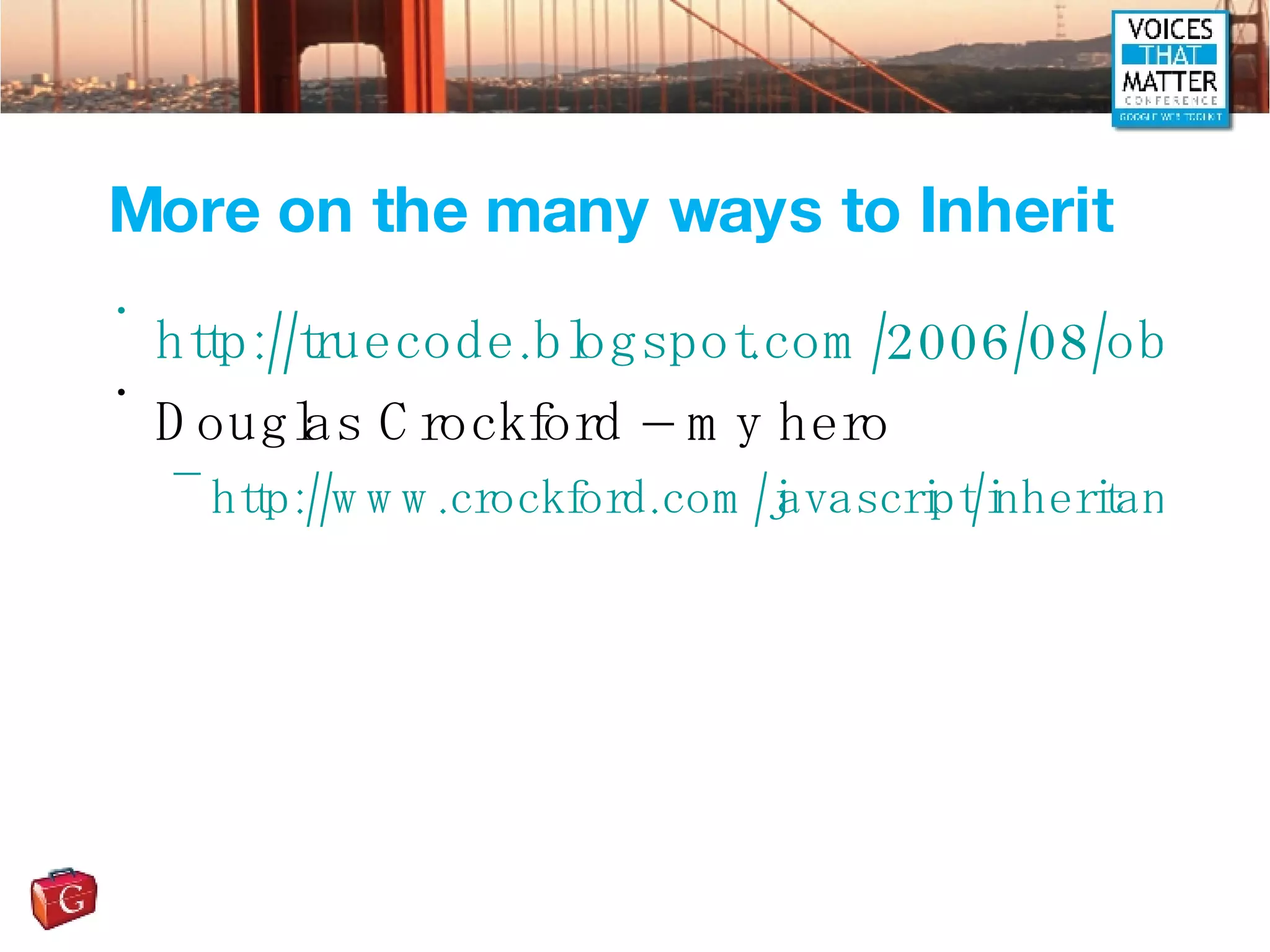
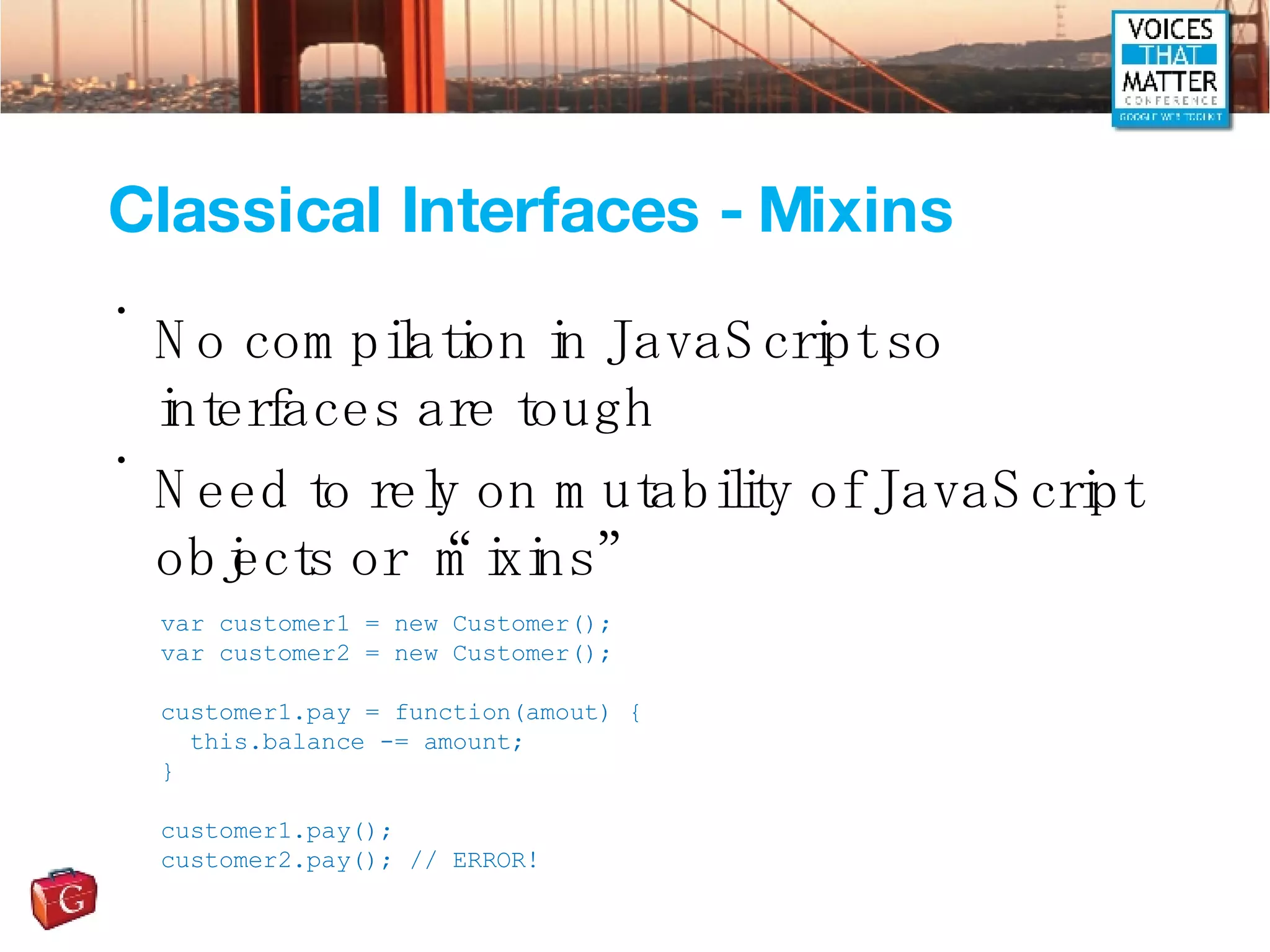
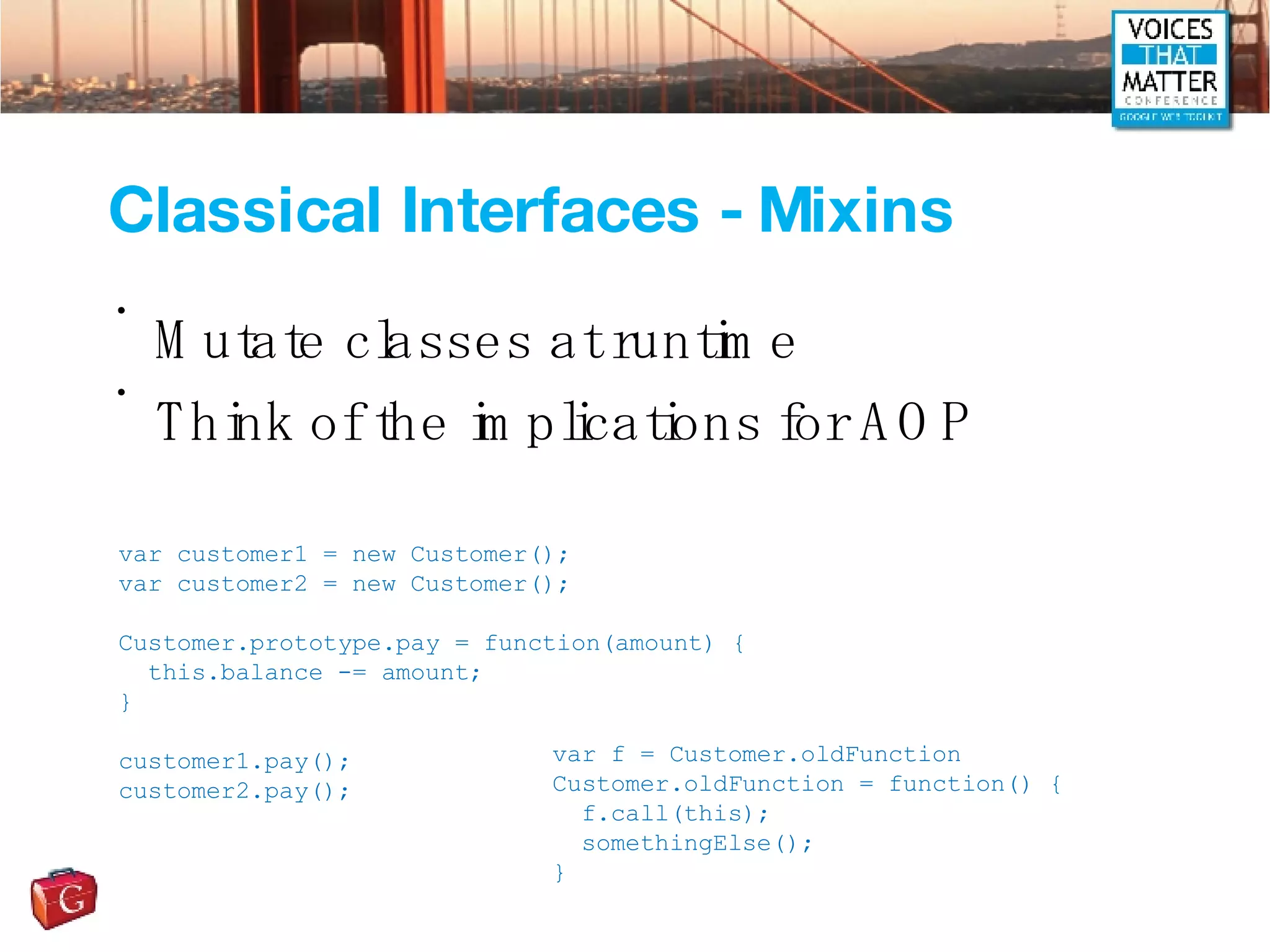
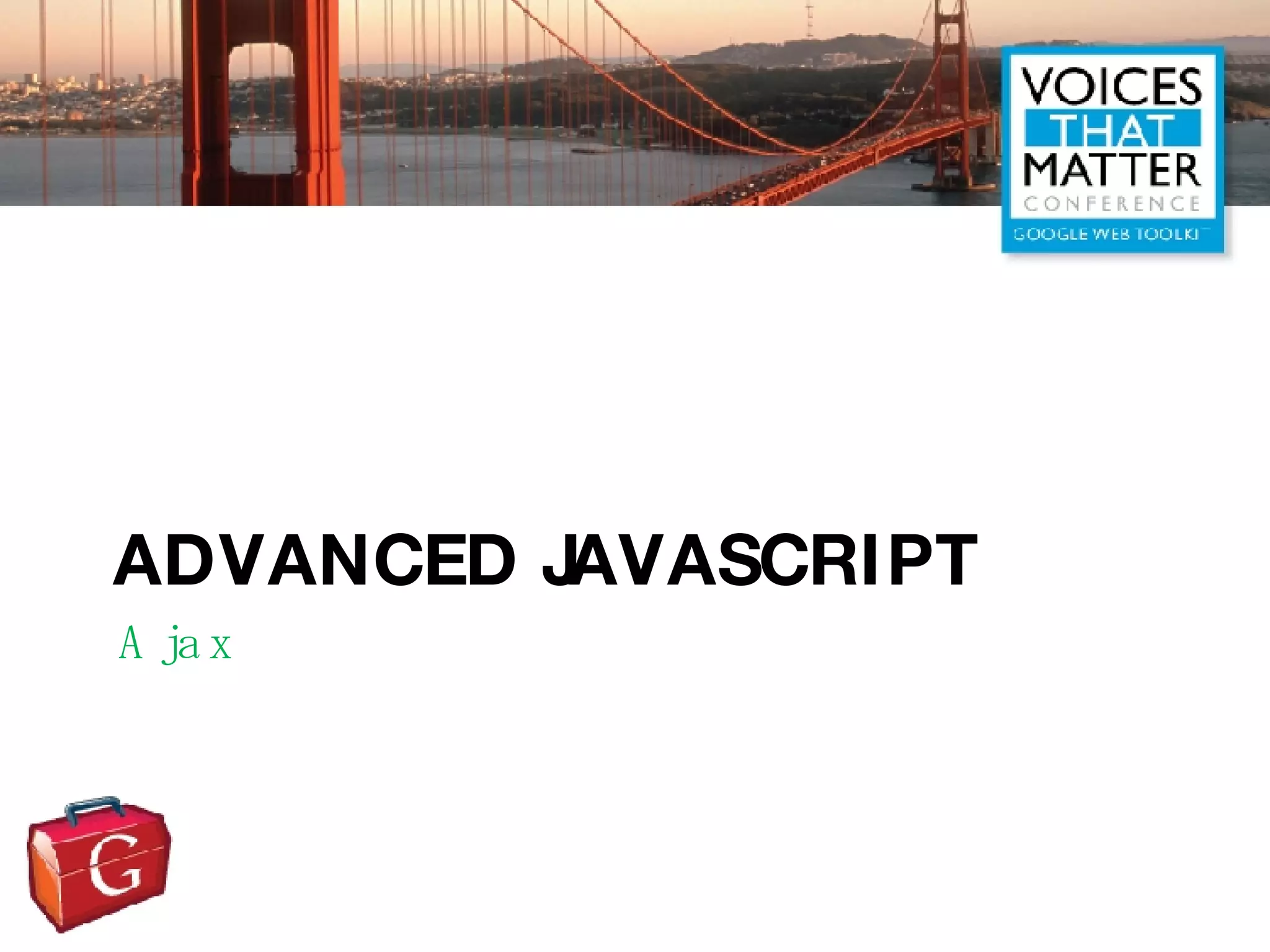
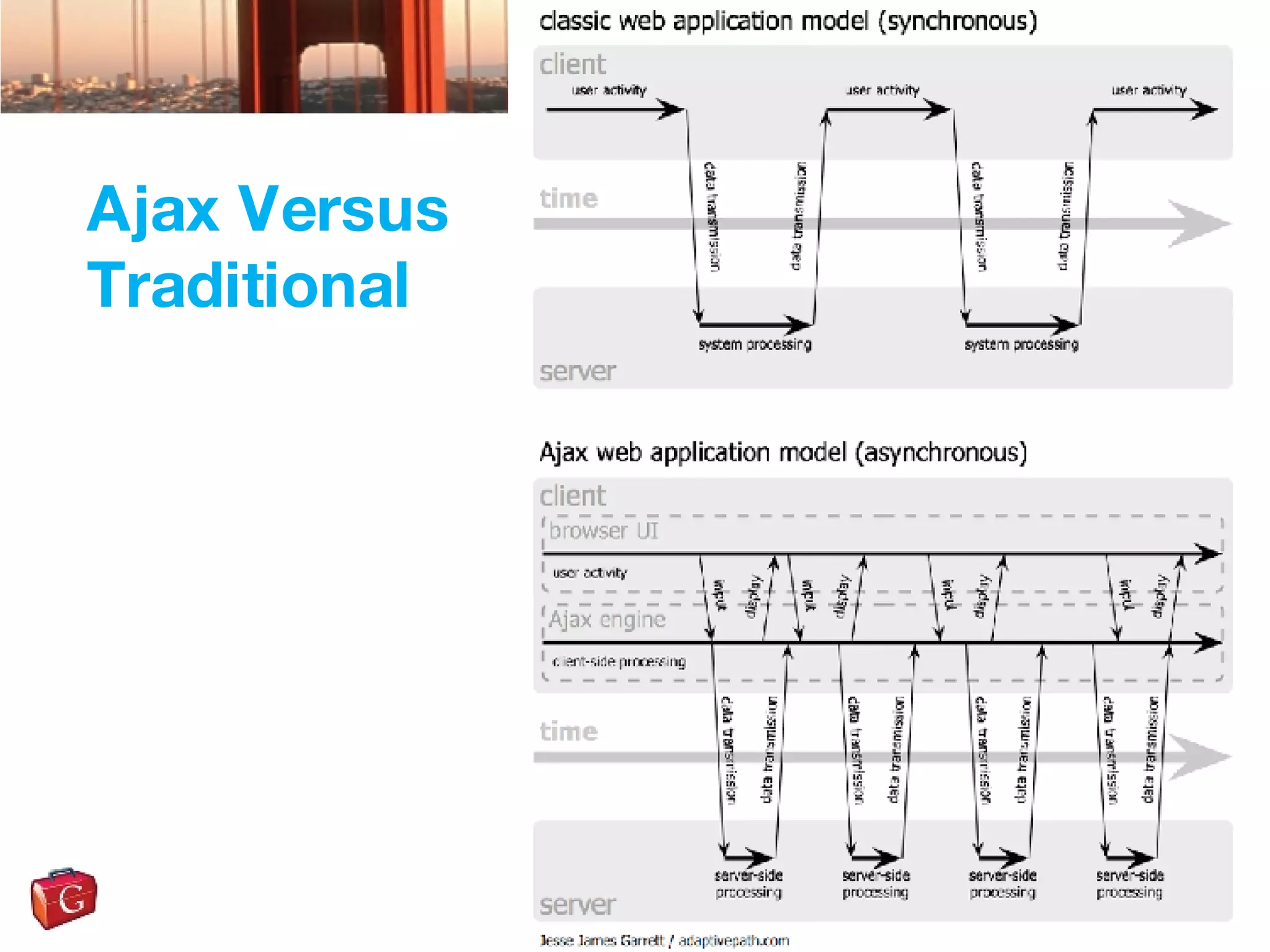
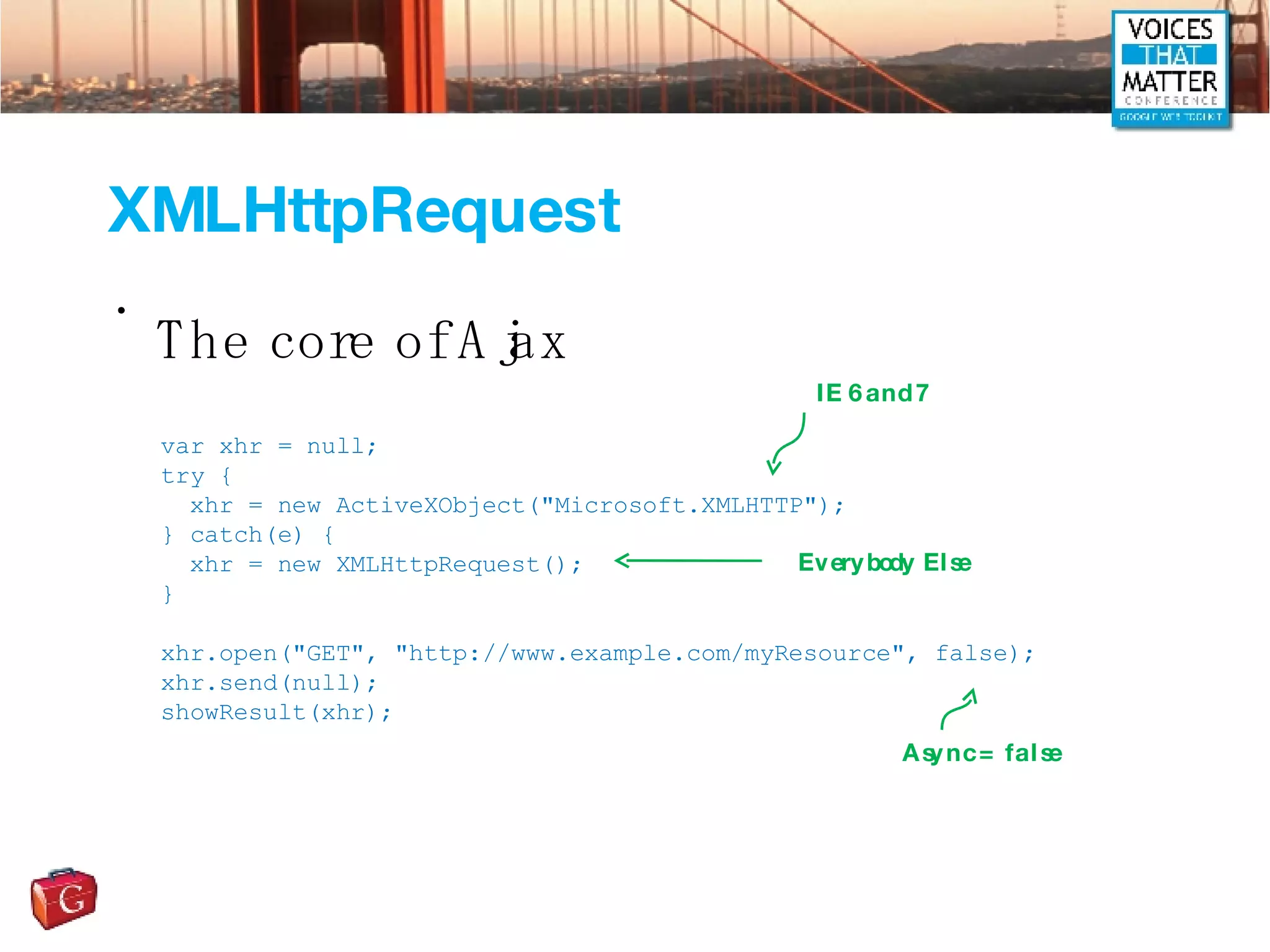
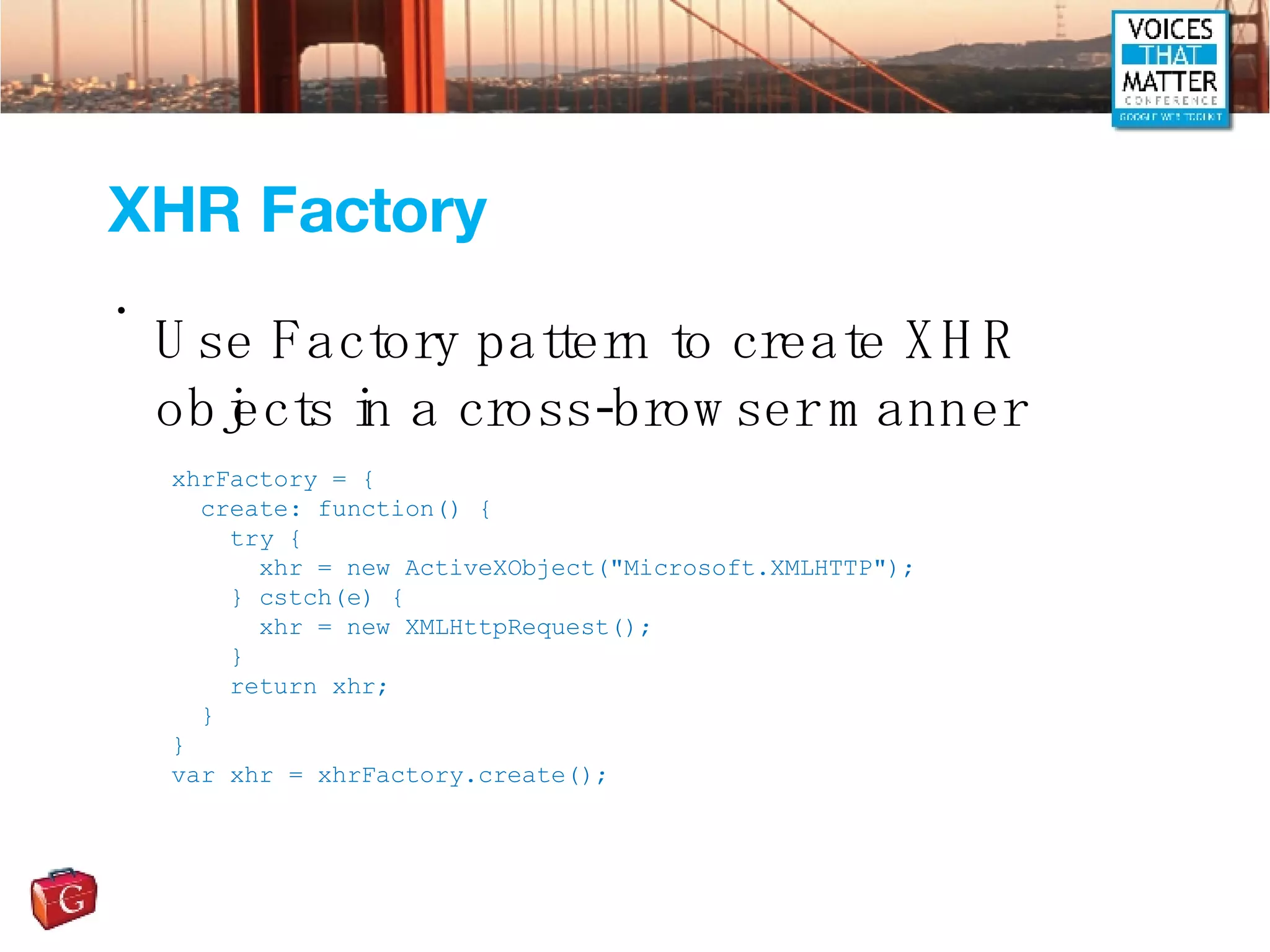
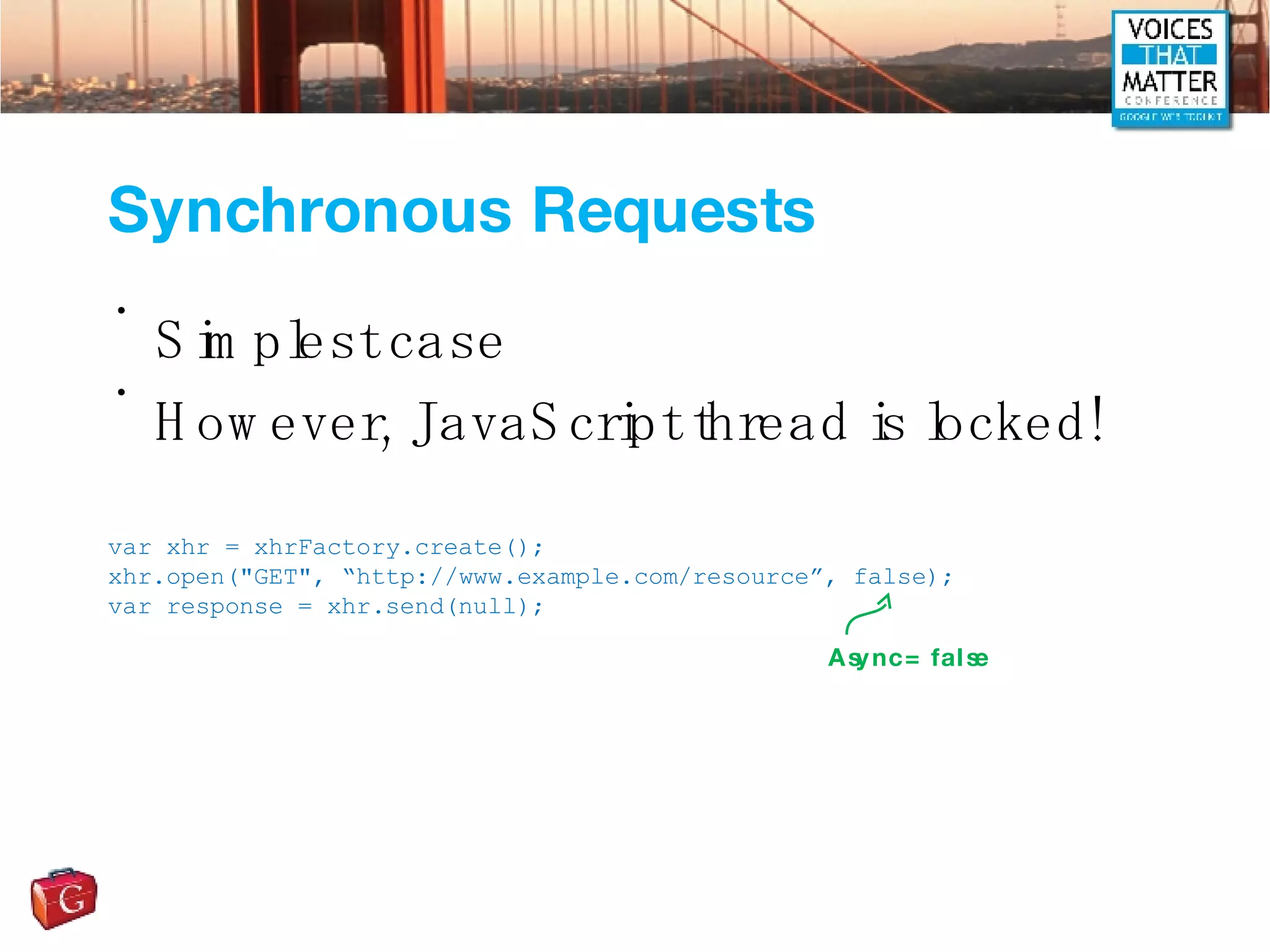
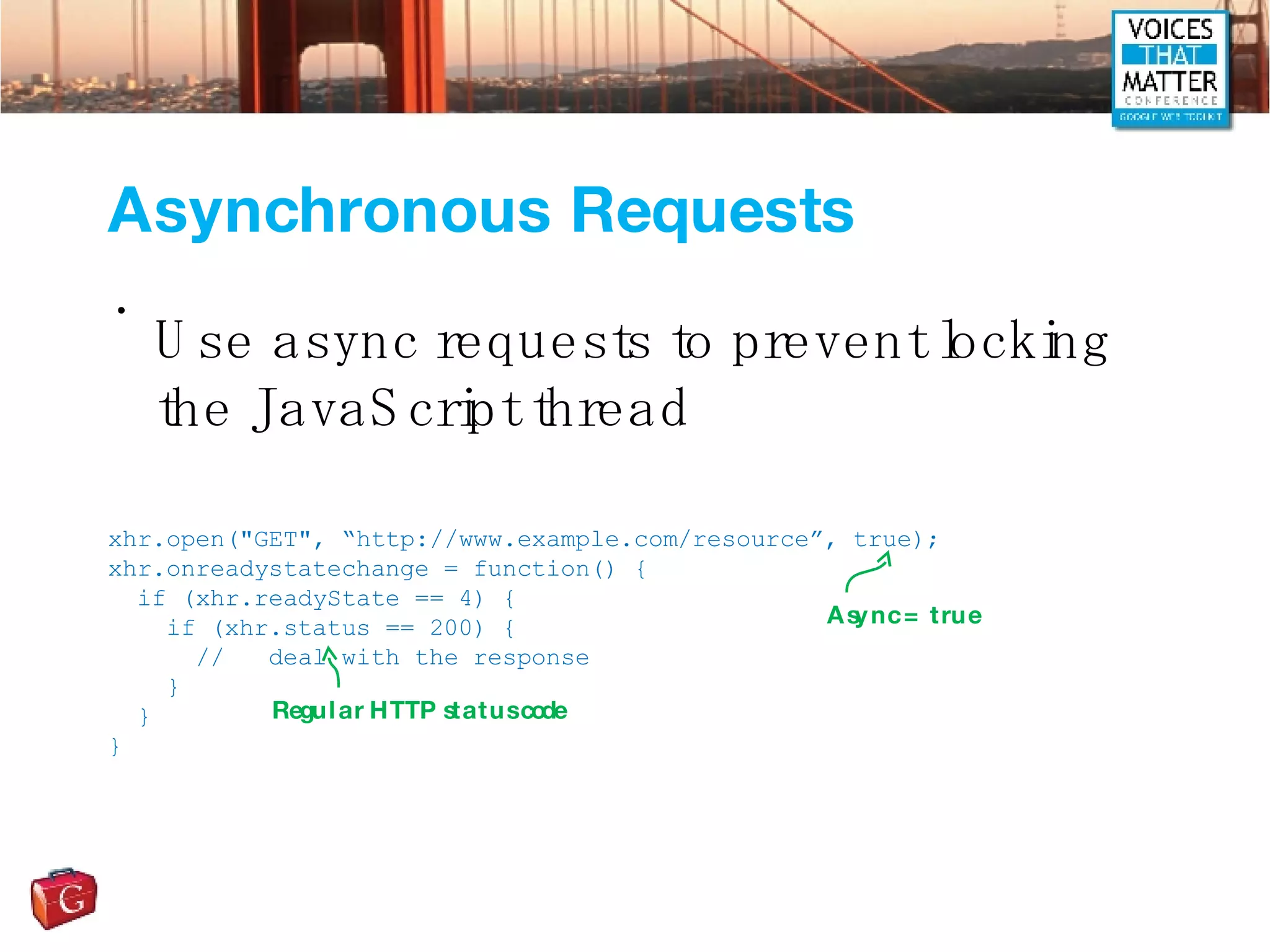
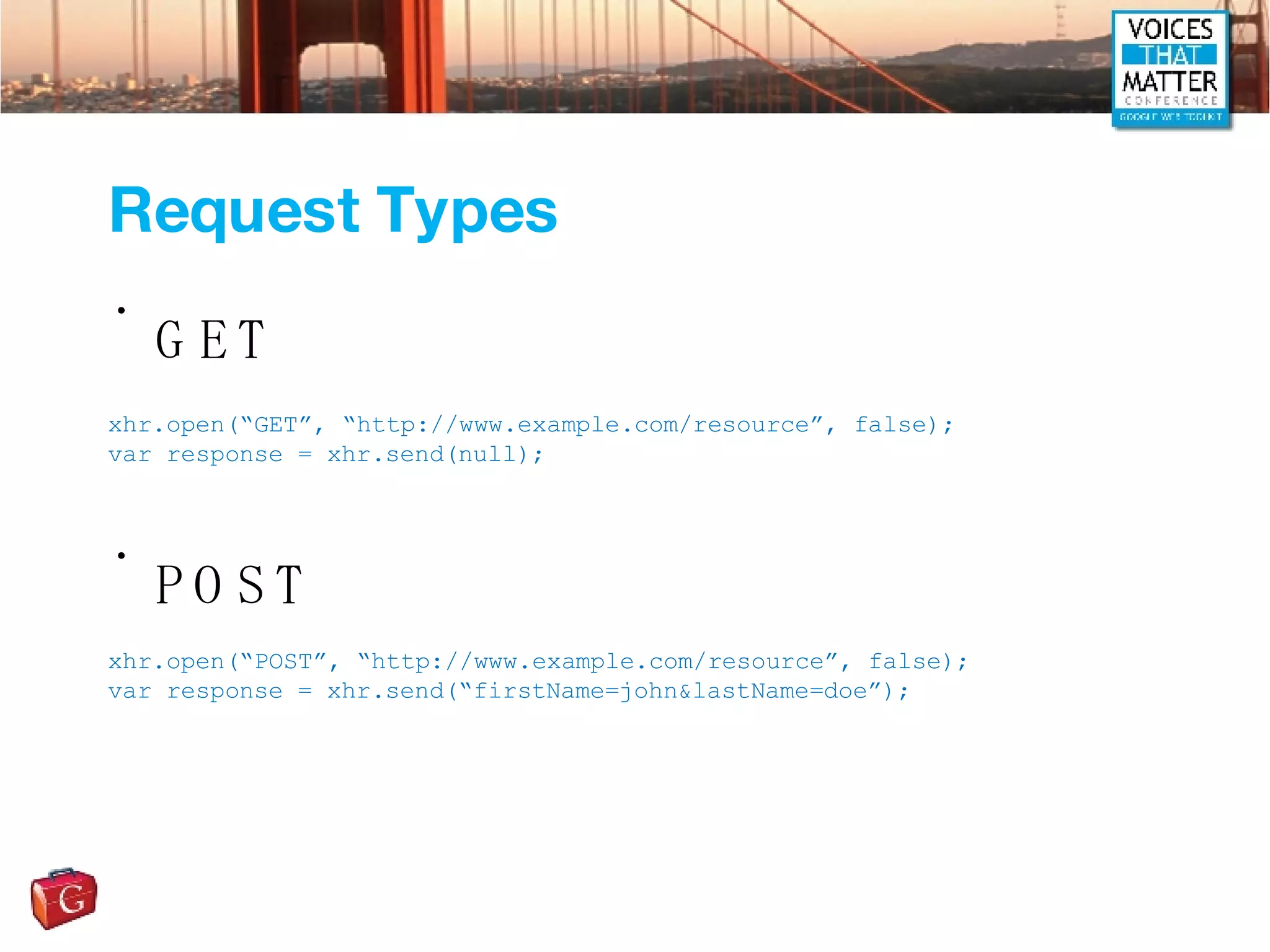
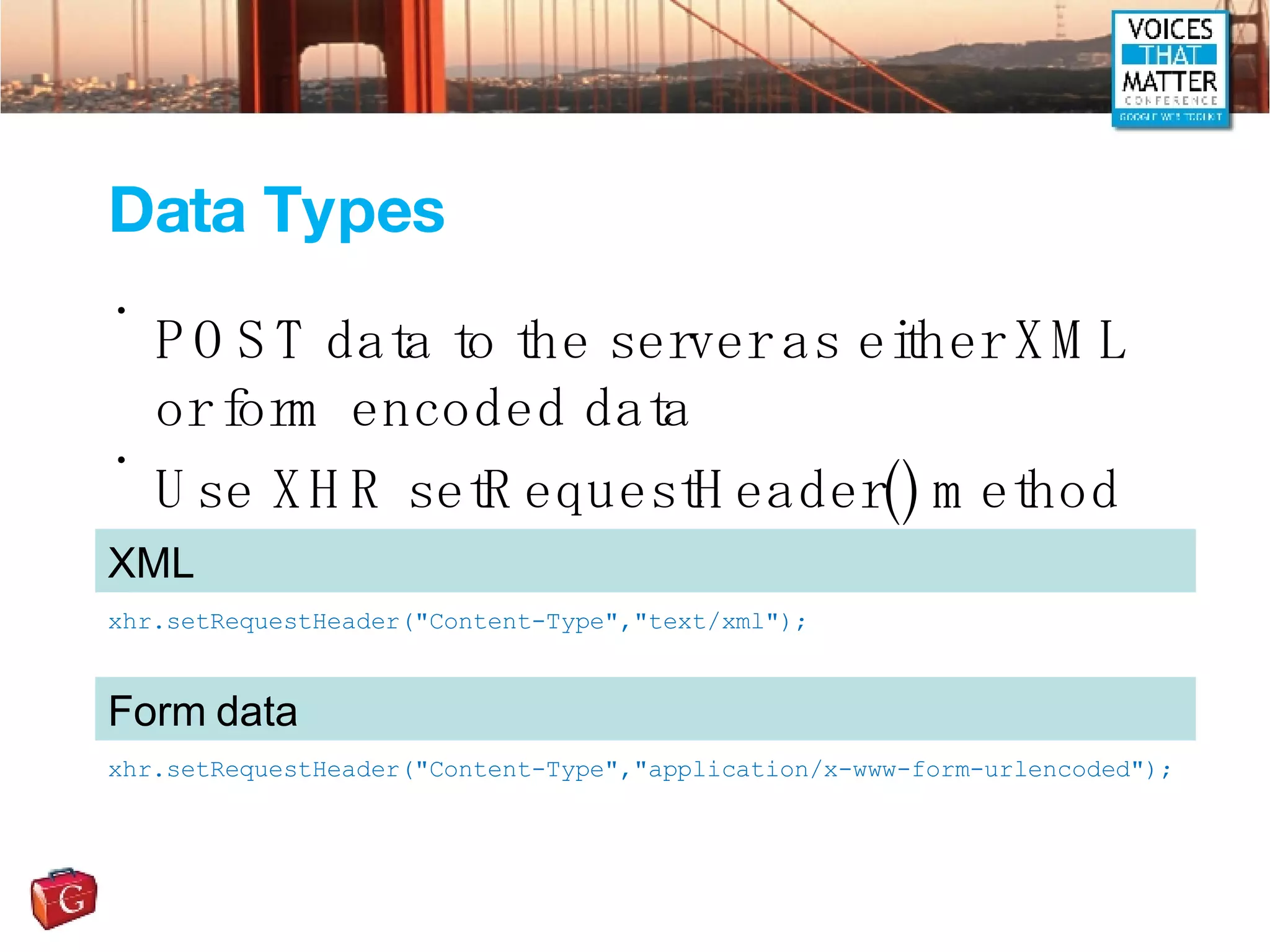
![Response Data We can expect the response from the server as XML, JSON, HTML or text xhr.open(“GET”, “http://www.example.com/resource”, false); var response = xhr.send(null); alert(response.responseXml); // Should show a [Document] for XML response alert(response.responseText); // Should show the XML, JSON, or HTML data Make sure you set the response type on the server too!](https://image.slidesharecdn.com/ajax-and-javascript-bootcamp-1196879148400612-5/75/Ajax-and-JavaScript-Bootcamp-131-2048.jpg)
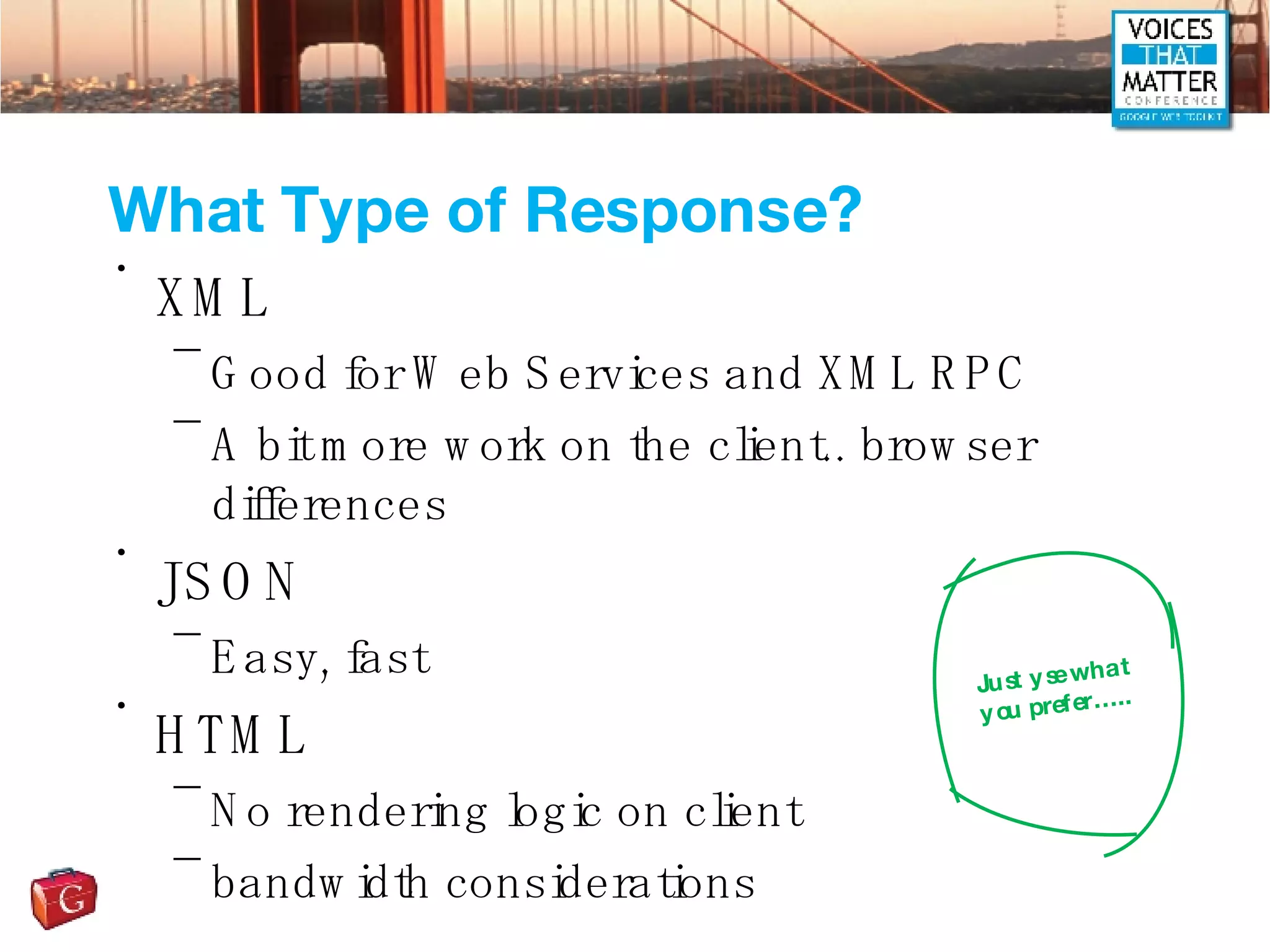
![XML Response Various ways of dealing with XML data XML DOM – most compatible XPath – fast and easy XSLT – not supported everywhere xhr.open(“GET”, “http://www.example.com/resource”, false); var response = xhr.send(null); var html = “”; var customers = response.responseXml.getElementsByTagName(“customer”); for (var i=0; i<customers.length; i++) { var customer = customers[i]; html += “<div>”+customer.childNodes[0].nodeValue+”</div>”; html += “<div>”+customer.childNodes[1].nodeValue+”</div>”; } alert(html);](https://image.slidesharecdn.com/ajax-and-javascript-bootcamp-1196879148400612-5/75/Ajax-and-JavaScript-Bootcamp-133-2048.jpg)
![JSON Response Need to instantiate the data into JavaScript objects xhr.open(“GET”, “http://www.example.com/resource”, false); var response = xhr.send(null); var html = “”; var customers = eval(“(“+response.responseText+”)”); // OR eval(“a = “ + response.responseText); for (var i=0; i<customers.length; i++) { var customer = customers[i]; html += “<div>”+customer.firstName+”</div>”; html += “<div>”+customer.lastName+”</div>”; } alert(html);](https://image.slidesharecdn.com/ajax-and-javascript-bootcamp-1196879148400612-5/75/Ajax-and-JavaScript-Bootcamp-134-2048.jpg)
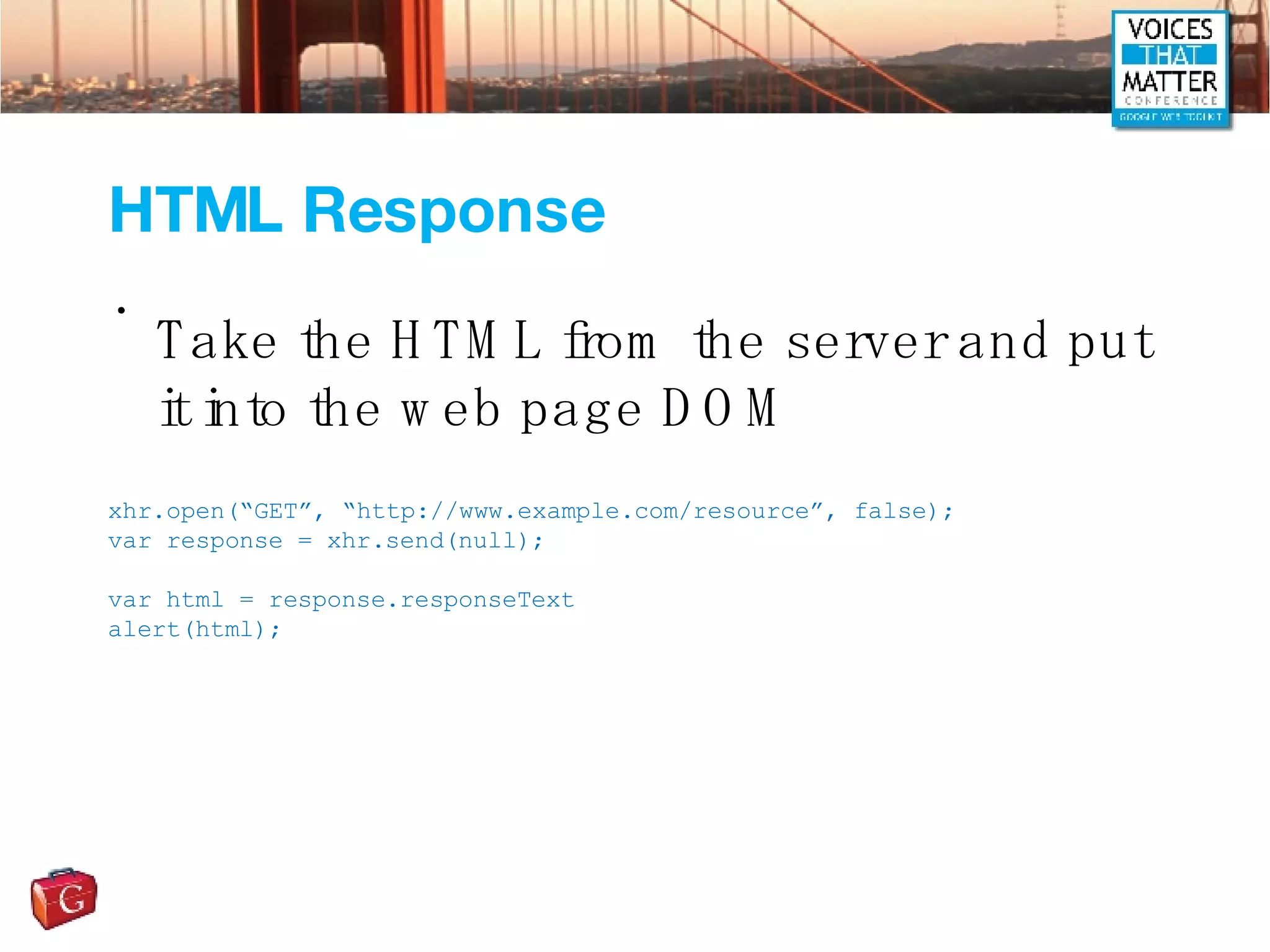
![Cross-Domain XHR Create <script> element dynamically Response from server includes JavaScript and calls a callback function Called JSONP or XMLP var customers = [{firstName:”John”,lastName:”Doe”}] myCallback(customers); var script = document.createElement(“script”); script.src = “http://www.example.com/resource?callback=myCallback”; document.getElementsByTagName(“head”)[0].appendChild(script); Dynamically generated function call](https://image.slidesharecdn.com/ajax-and-javascript-bootcamp-1196879148400612-5/75/Ajax-and-JavaScript-Bootcamp-136-2048.jpg)
![Cross-Domain JSONP Security There are serious security risks with JSON or XMLP Also serious risks with JSON in general Return JSON data in comments to prevent non XHR access <!-- [{firstName:”John”,lastName:”Doe”}] -->](https://image.slidesharecdn.com/ajax-and-javascript-bootcamp-1196879148400612-5/75/Ajax-and-JavaScript-Bootcamp-137-2048.jpg)

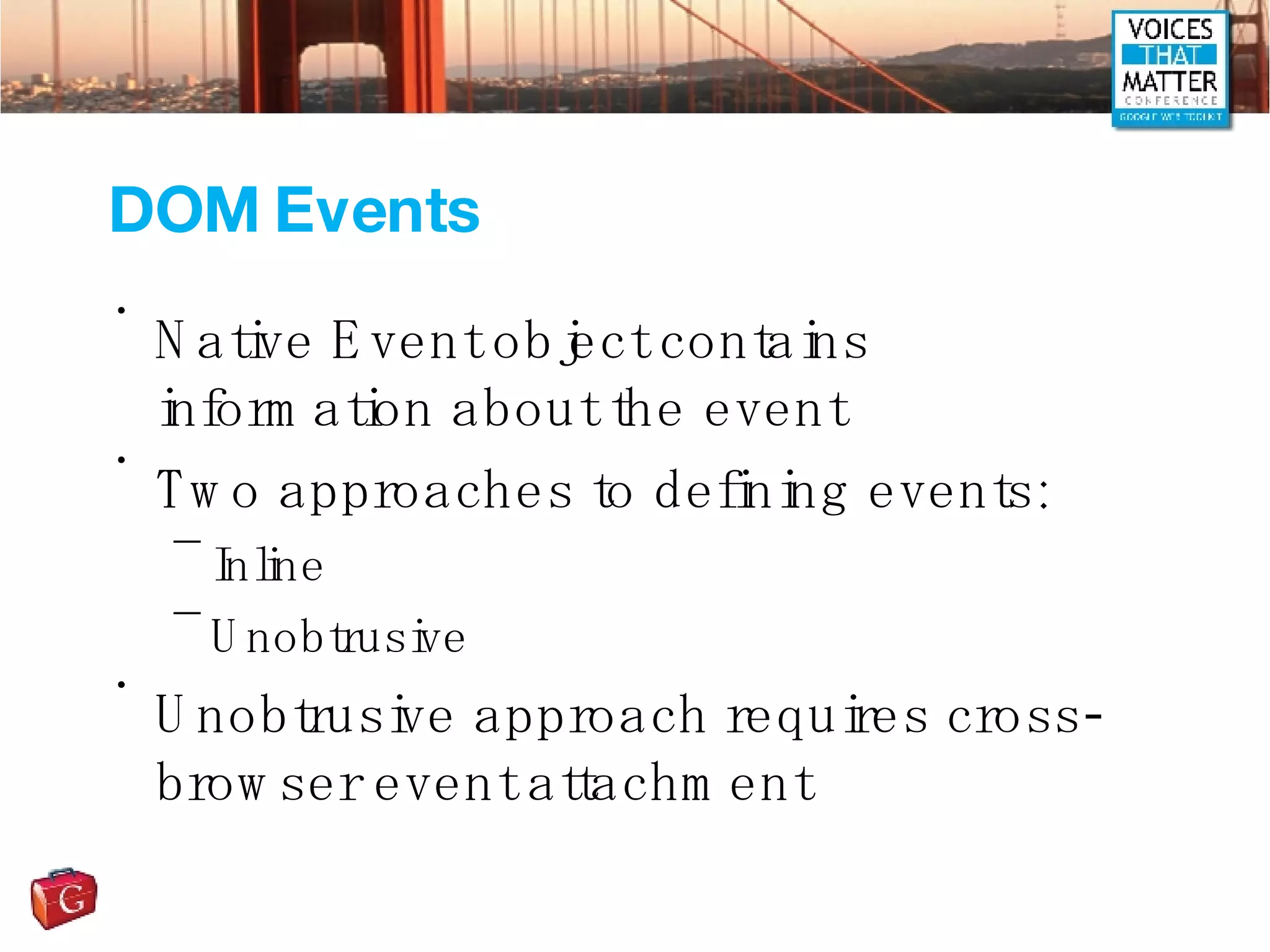
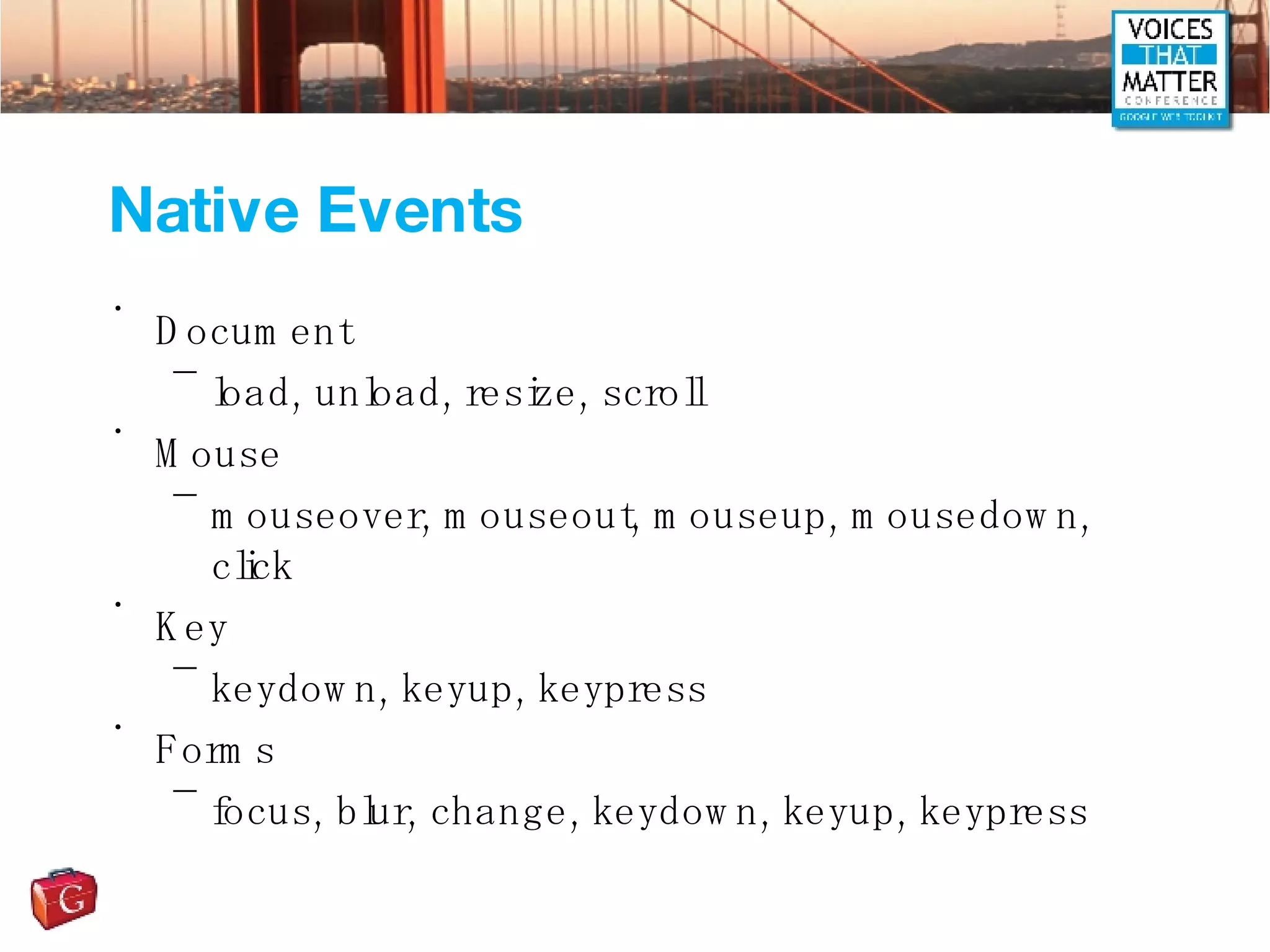
![onload Event Need the page JavaScript to execute as soon as possible onload waits for all images etc to load if (document.addEventListener) document.addEventListener('DOMContentLoaded', init, false); <!--[if IE]><script defer src="ie_onload.js"></script><![endif]--> window.onload = init; Firefox Internet Explorer The rest](https://image.slidesharecdn.com/ajax-and-javascript-bootcamp-1196879148400612-5/75/Ajax-and-JavaScript-Bootcamp-141-2048.jpg)
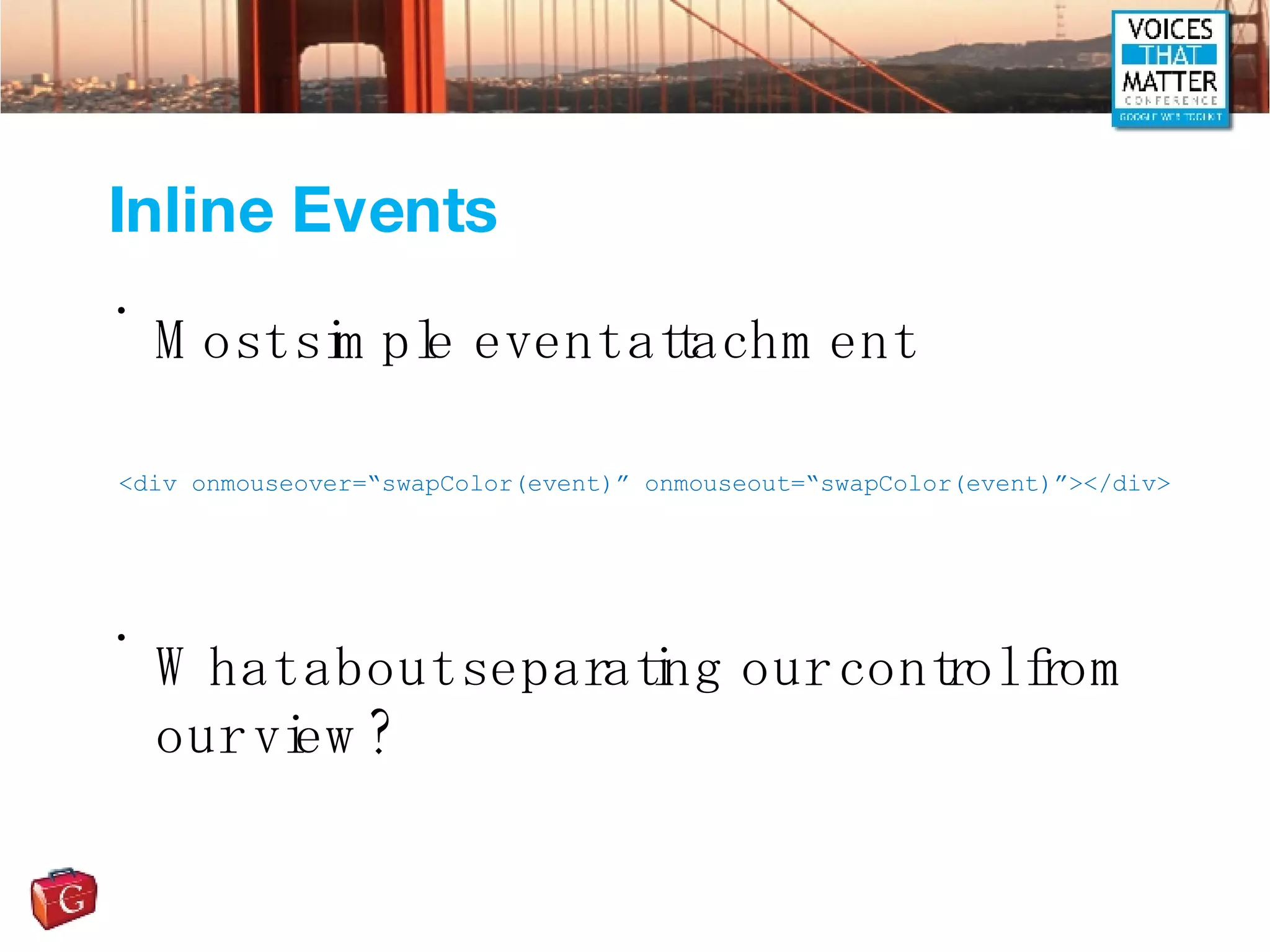
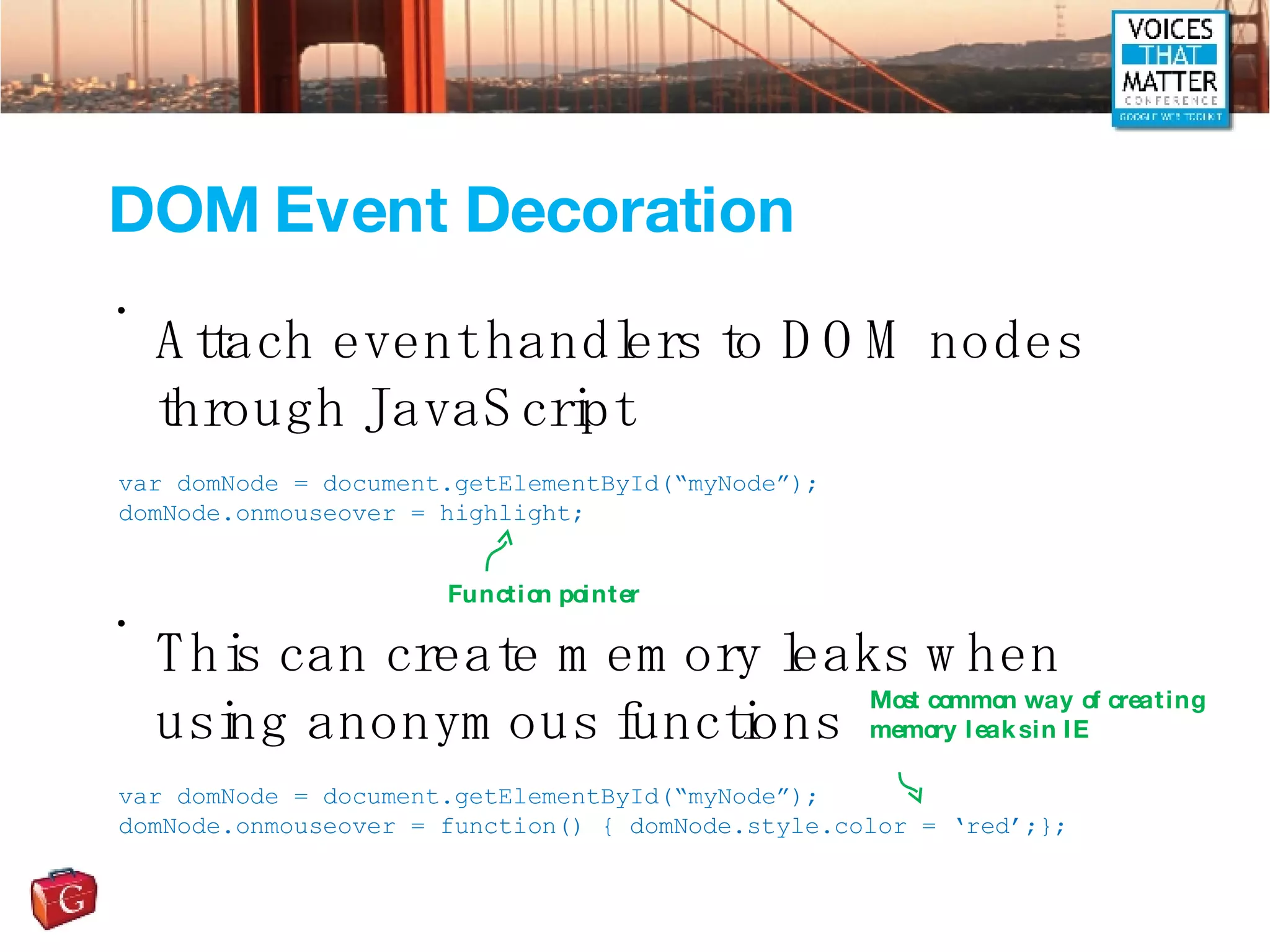
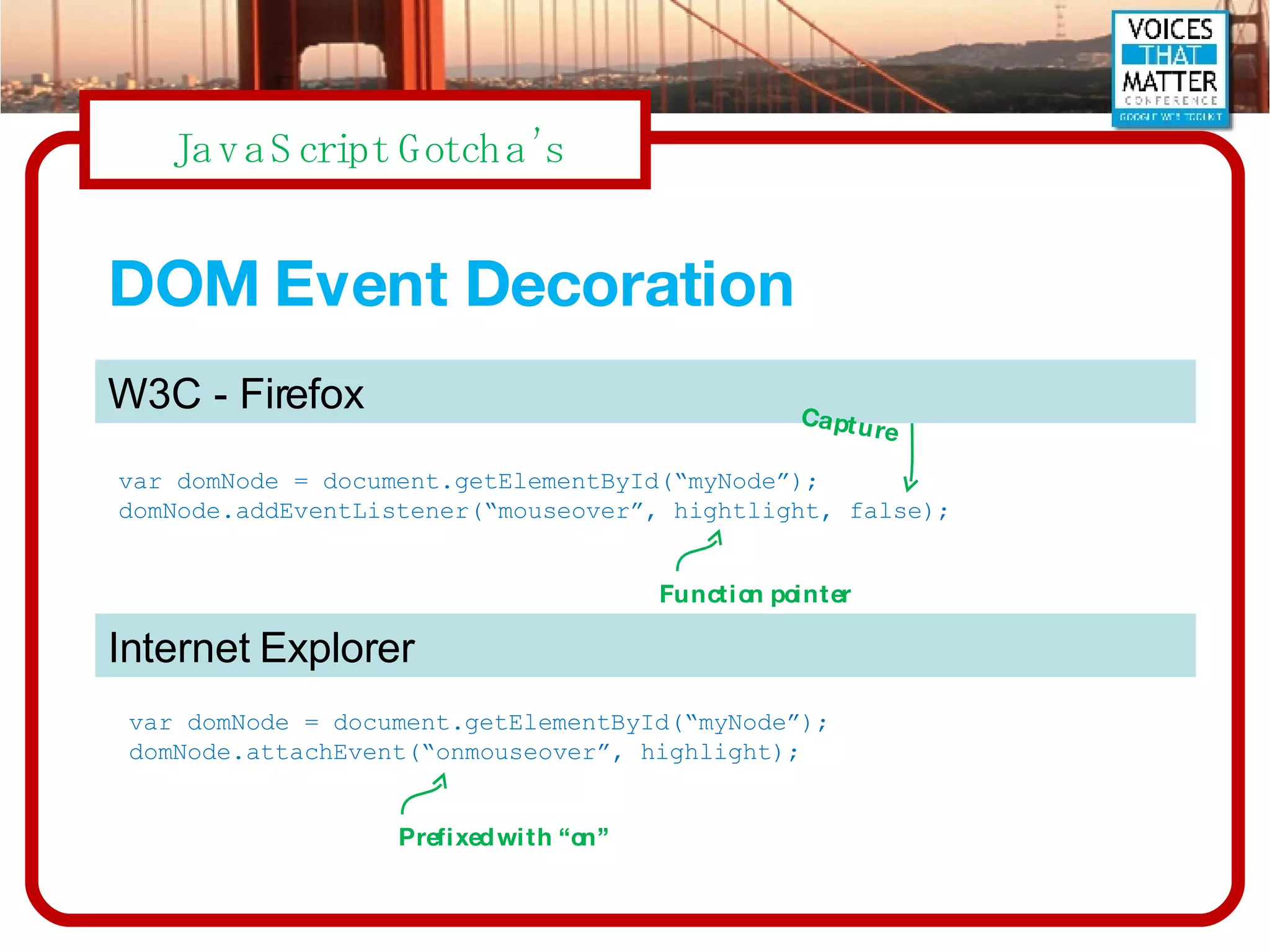
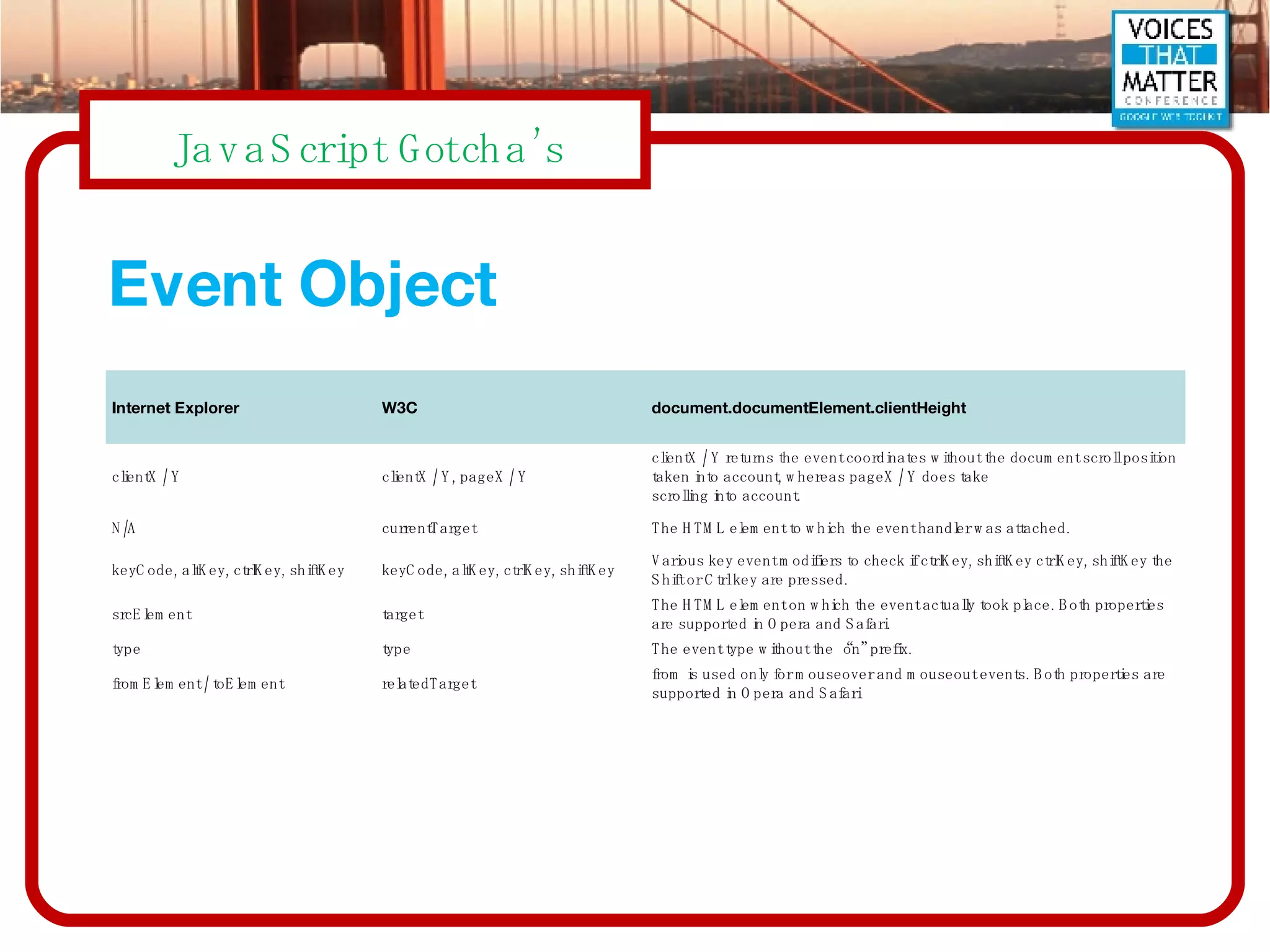
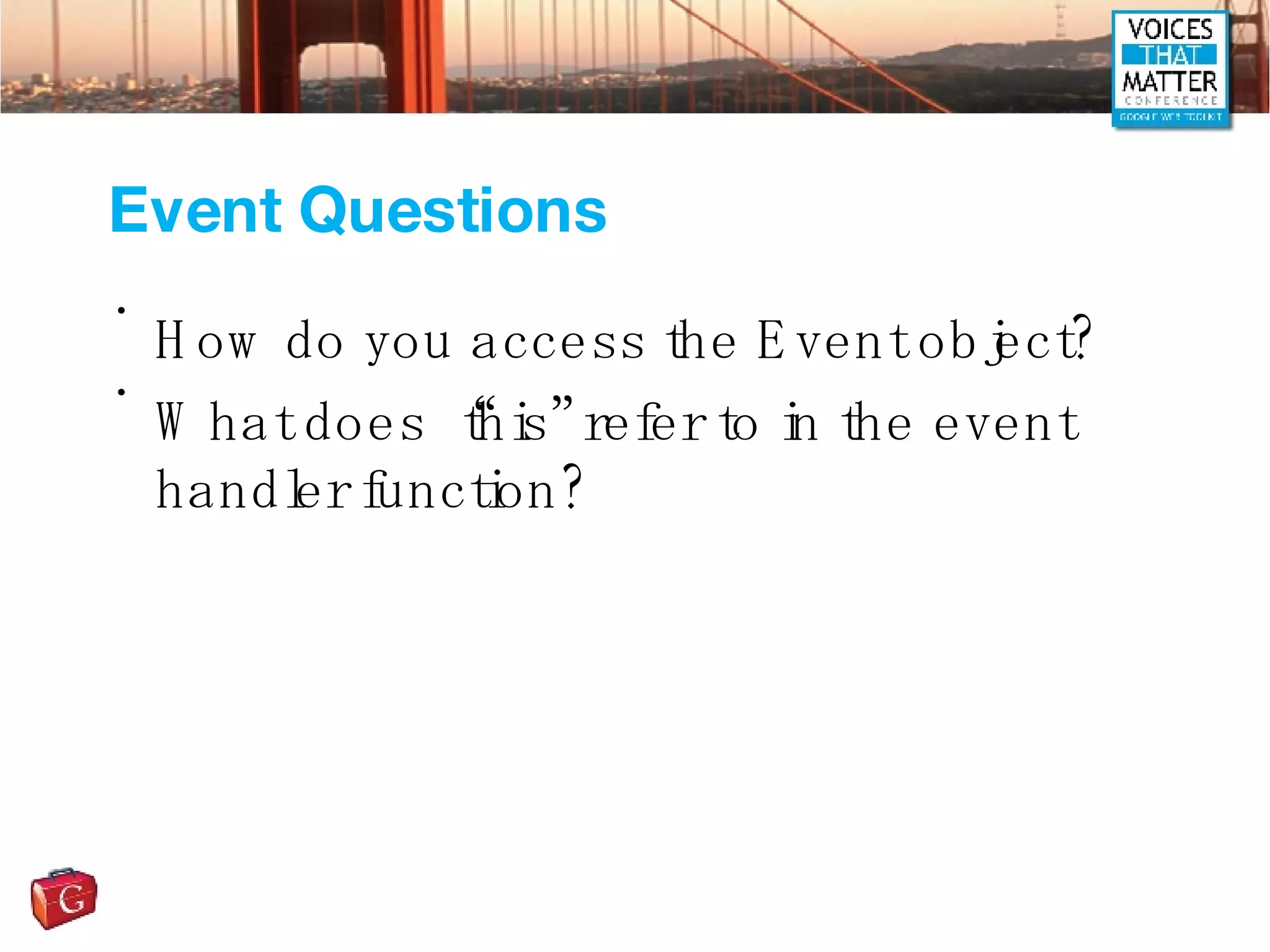
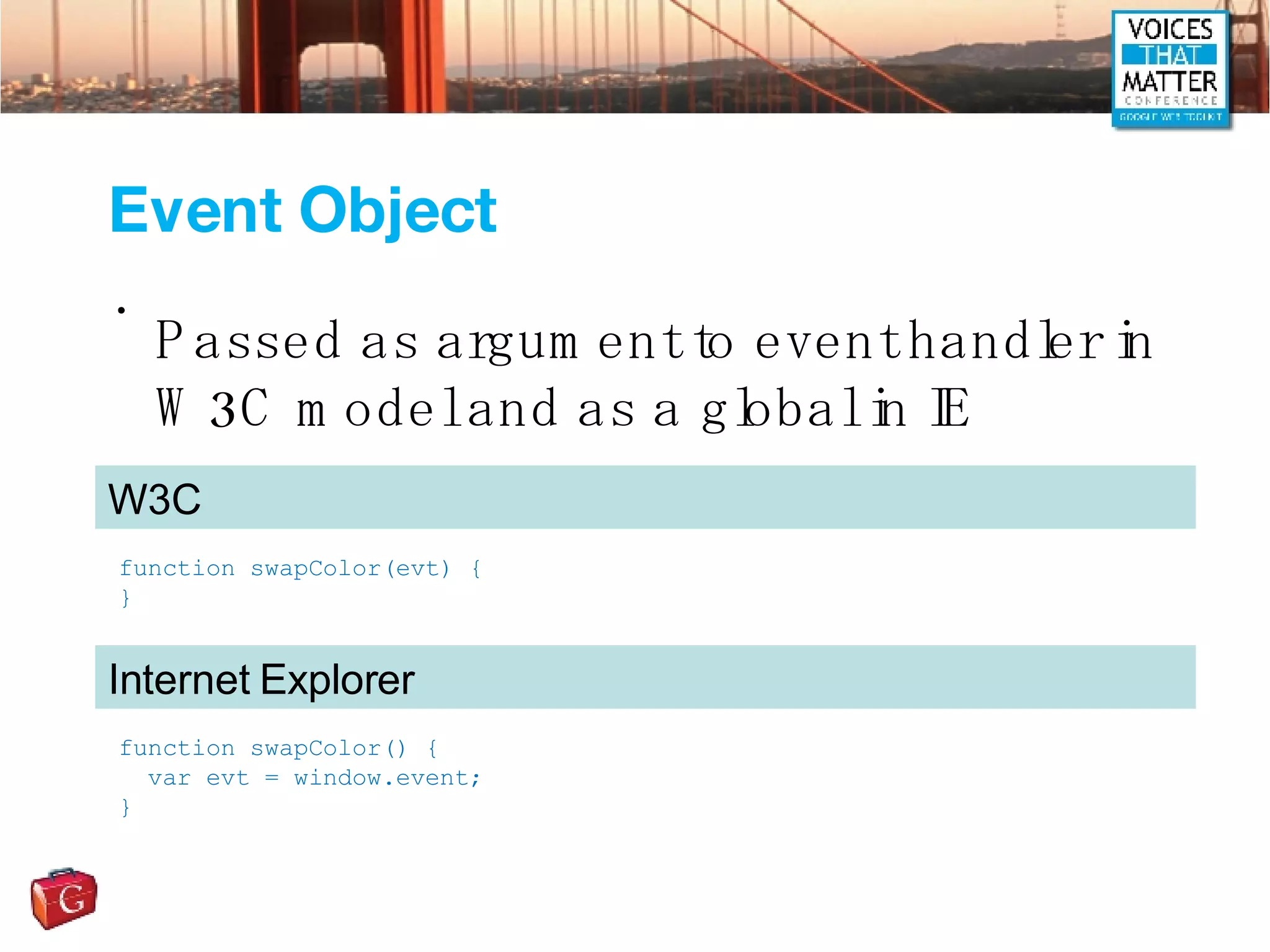
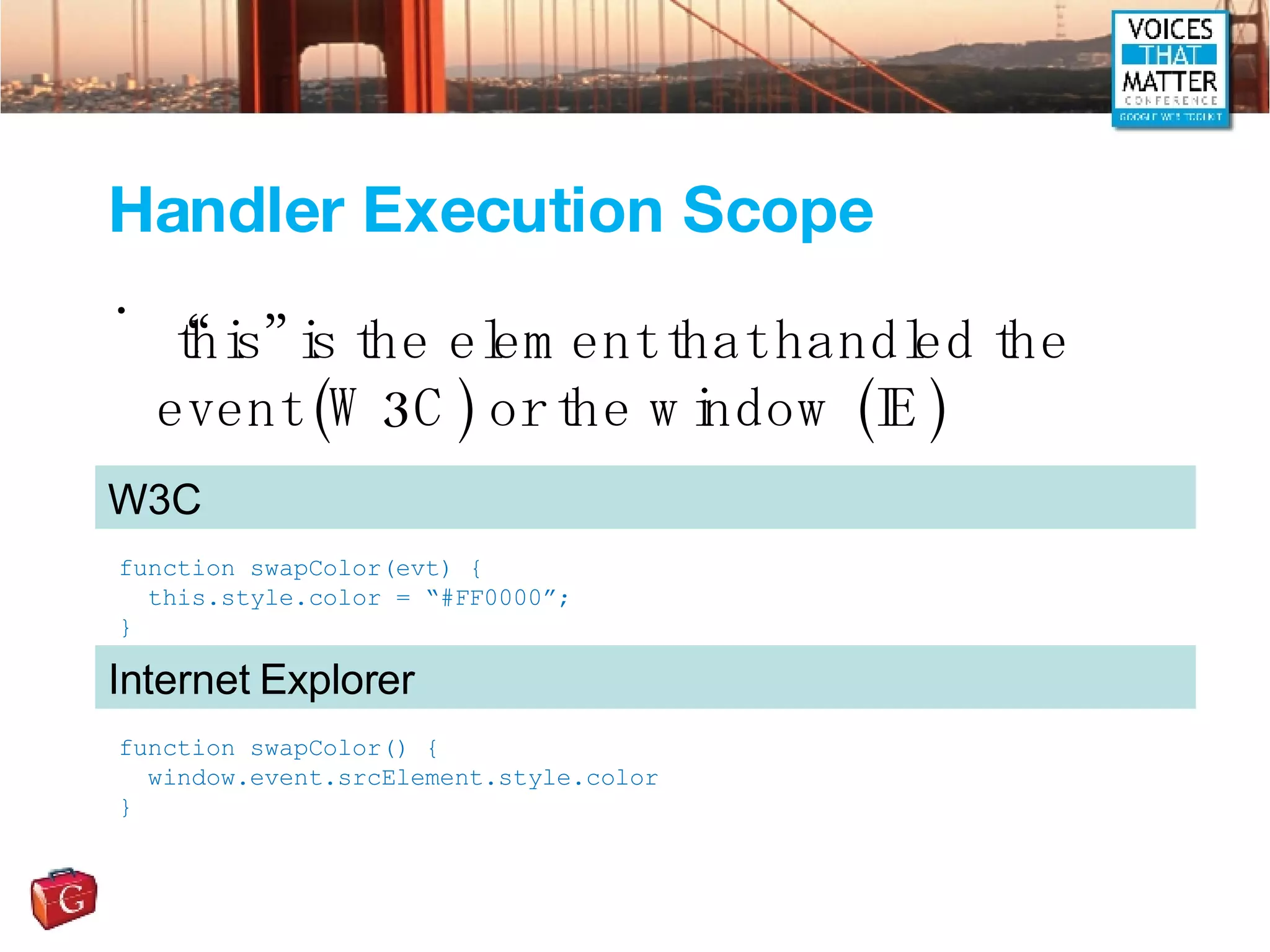
![Cross-Browser Event Façade Make Internet Explorer look like W3C eventManager = {}; // Singleton object eventManager.attachEvent = function(elem, type, handler, capture) { // Browser checking for IE vs W3C compliant browser if (elem.attachEvent) { // Create two expando properties with function references elem[‘evt_' + type] = function() { handler.call(elem); }; // Attach one of our expando function references to the event elem.attachEvent('on'+type, elem[‘evt_' + type]); // Set the capture if it was specified if (capture) elem.setCapture(true); } else if (elem.addEventListener) { elem.addEventListener(type, handler, capture); } } IE W3C Sets scope of “this” Event type “mouseover”, etc Detects IE](https://image.slidesharecdn.com/ajax-and-javascript-bootcamp-1196879148400612-5/75/Ajax-and-JavaScript-Bootcamp-149-2048.jpg)
